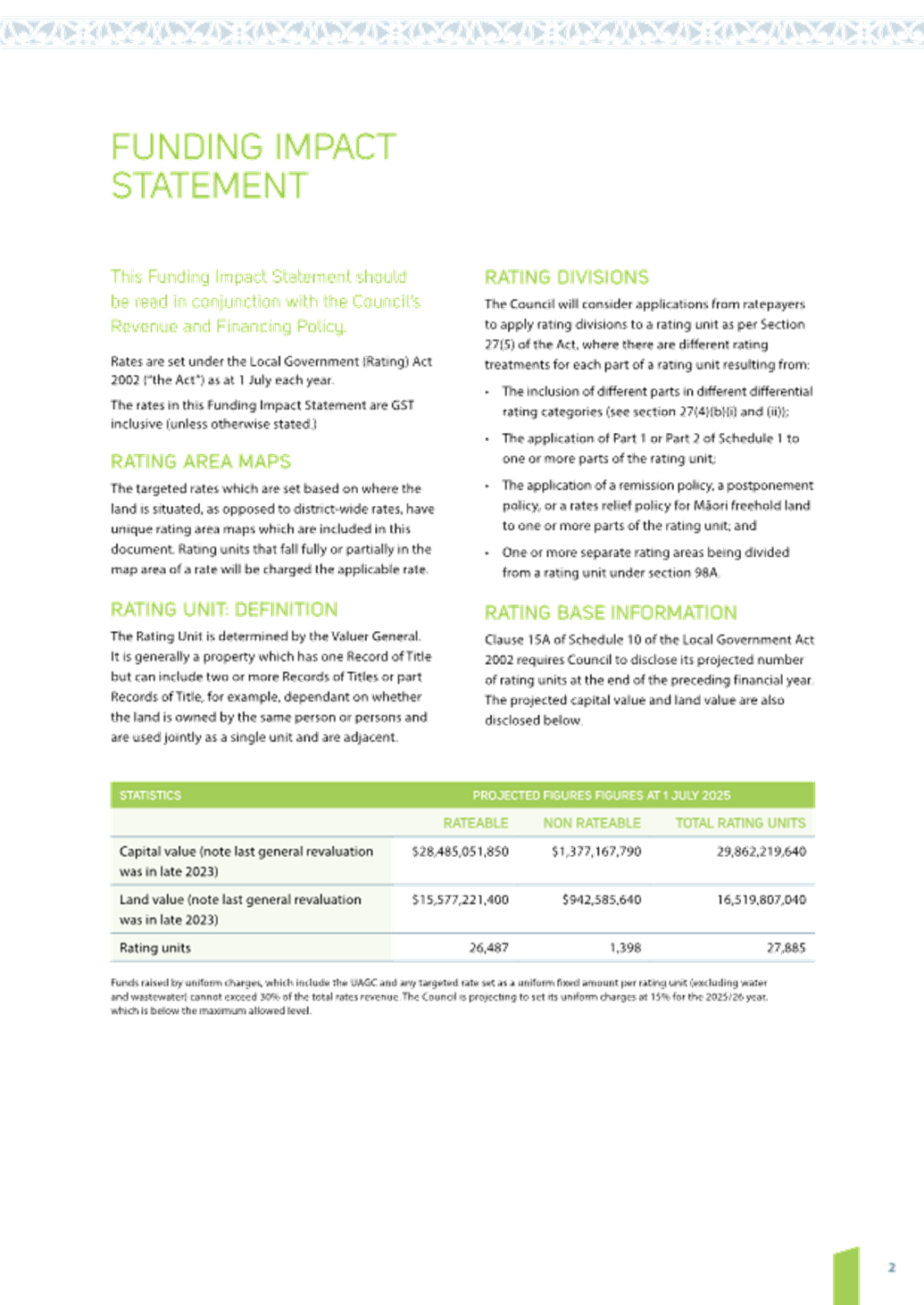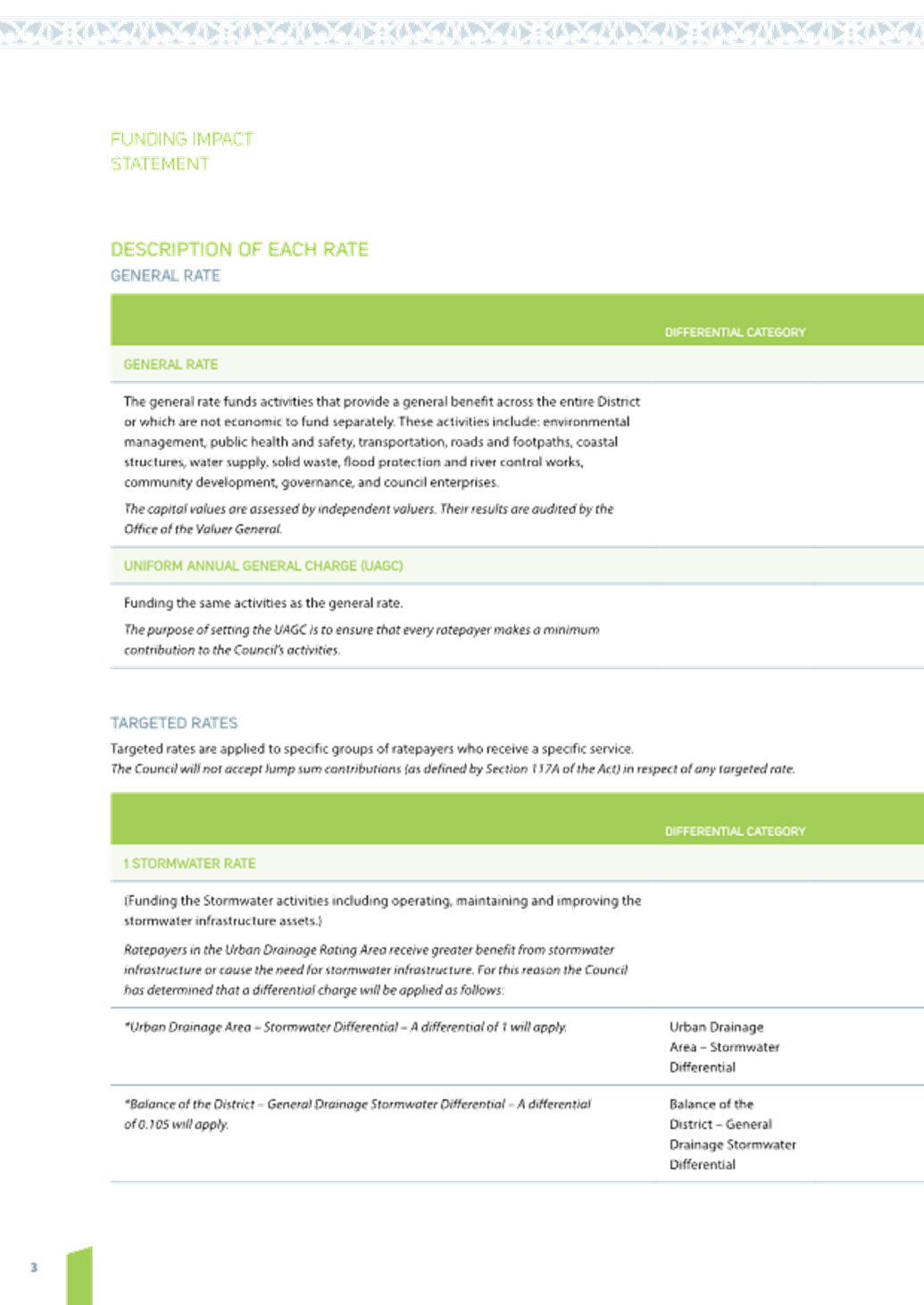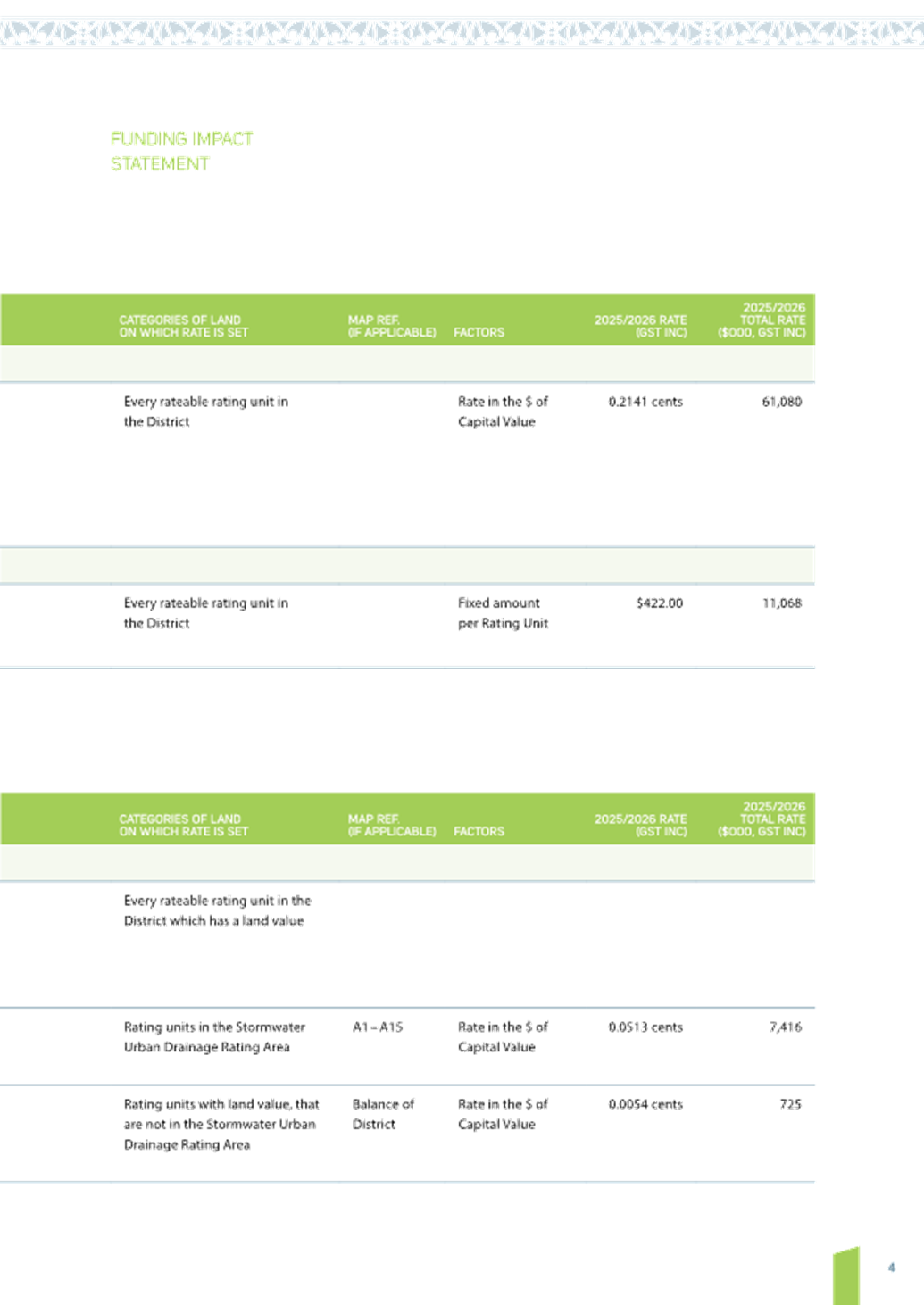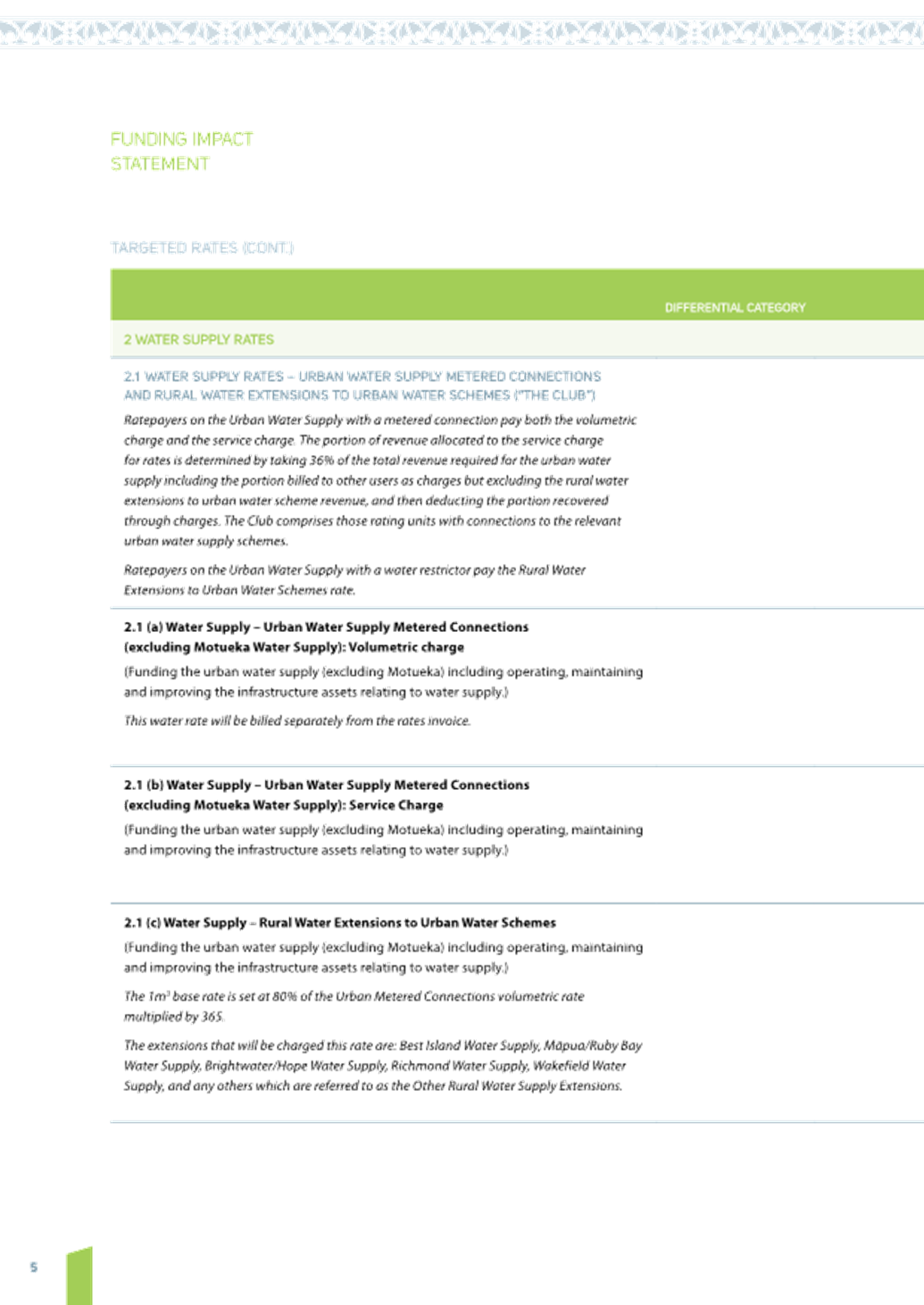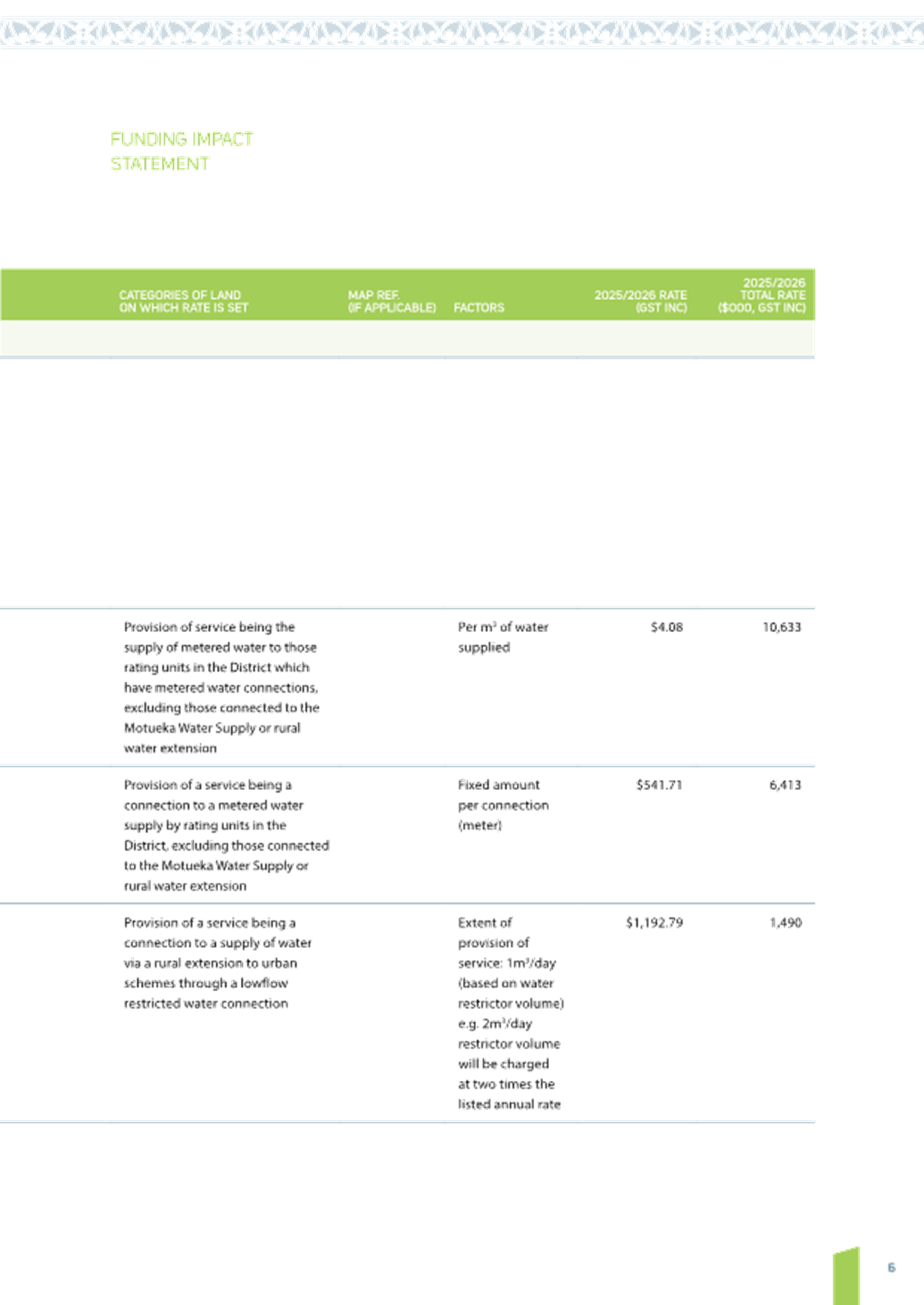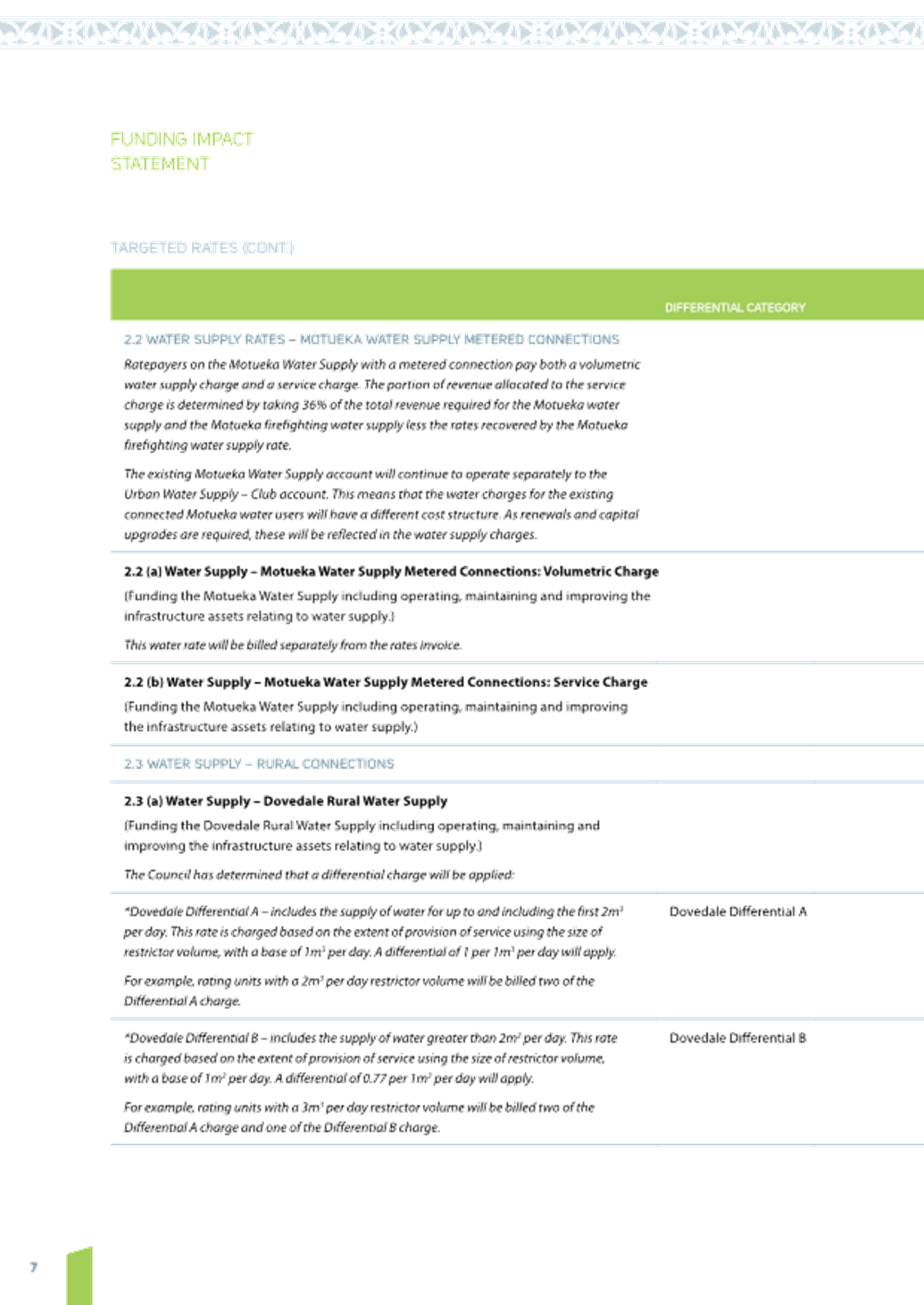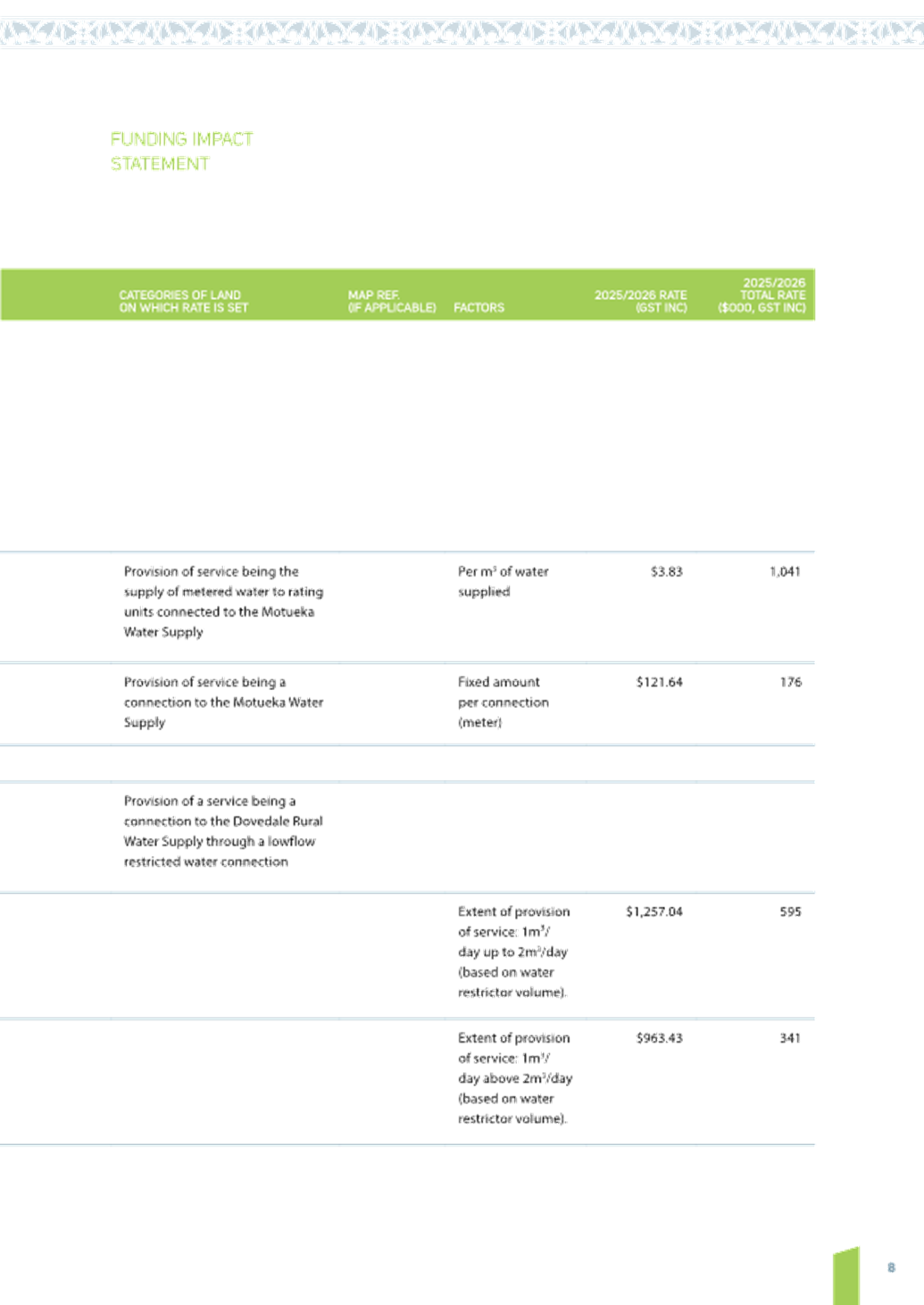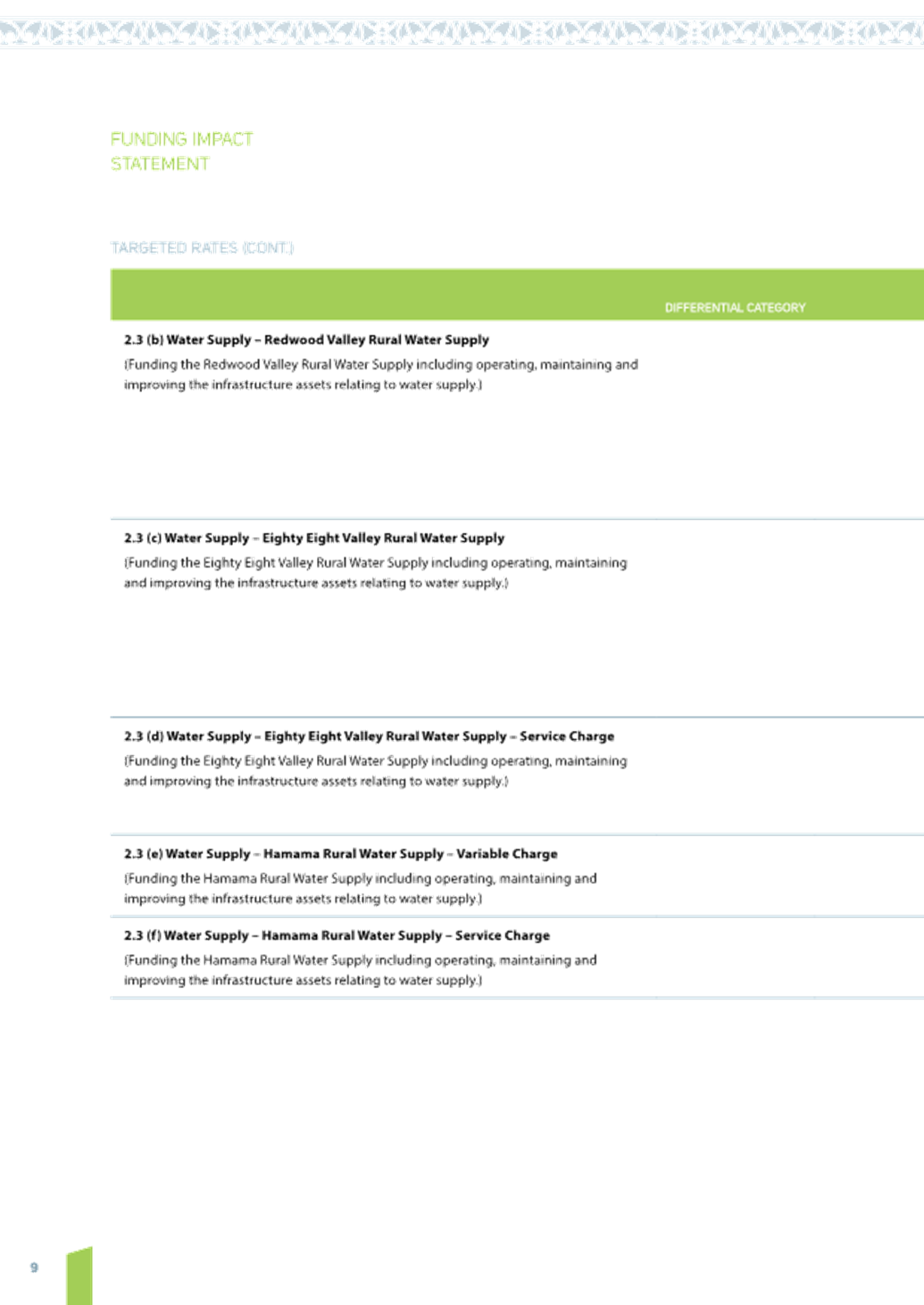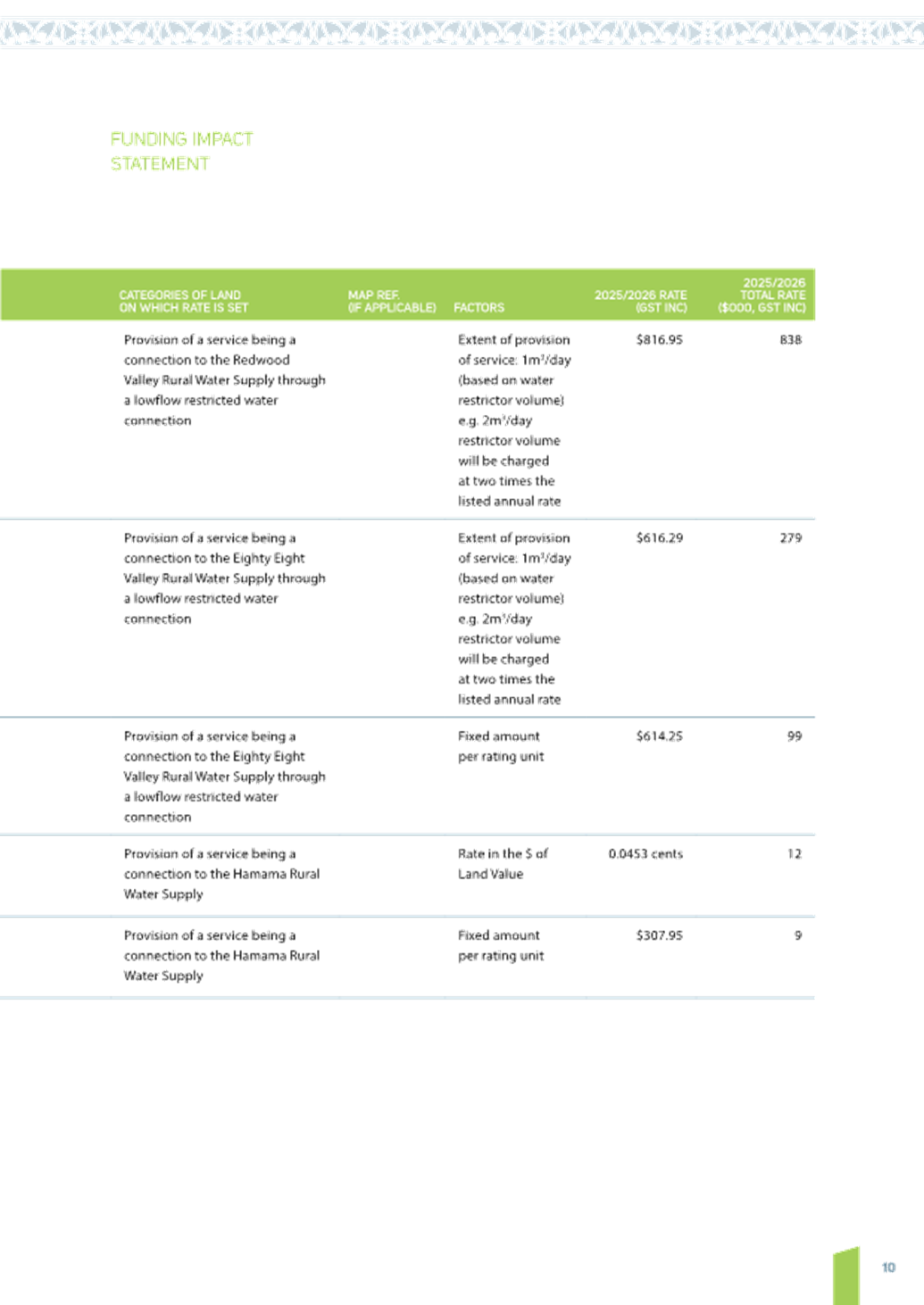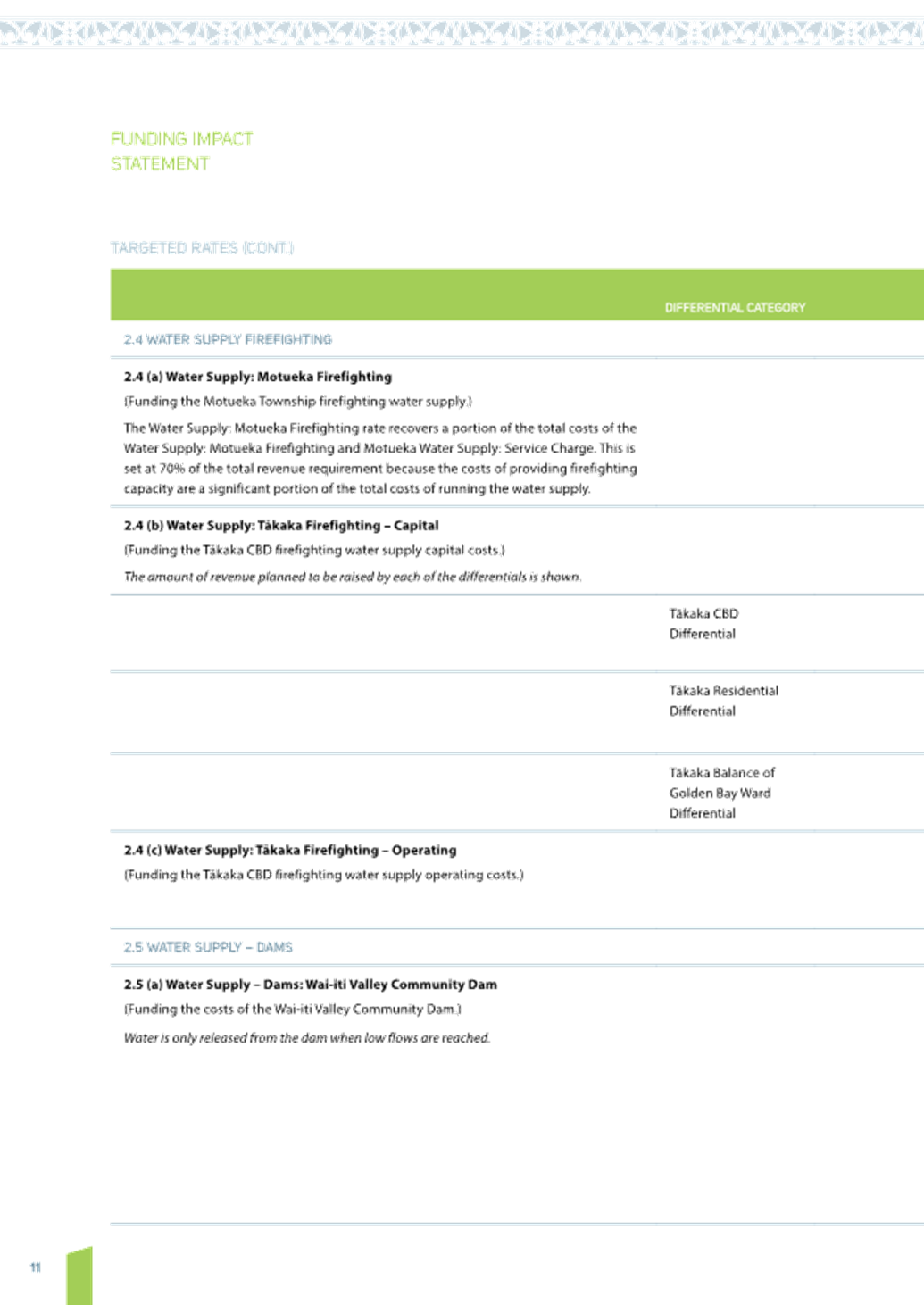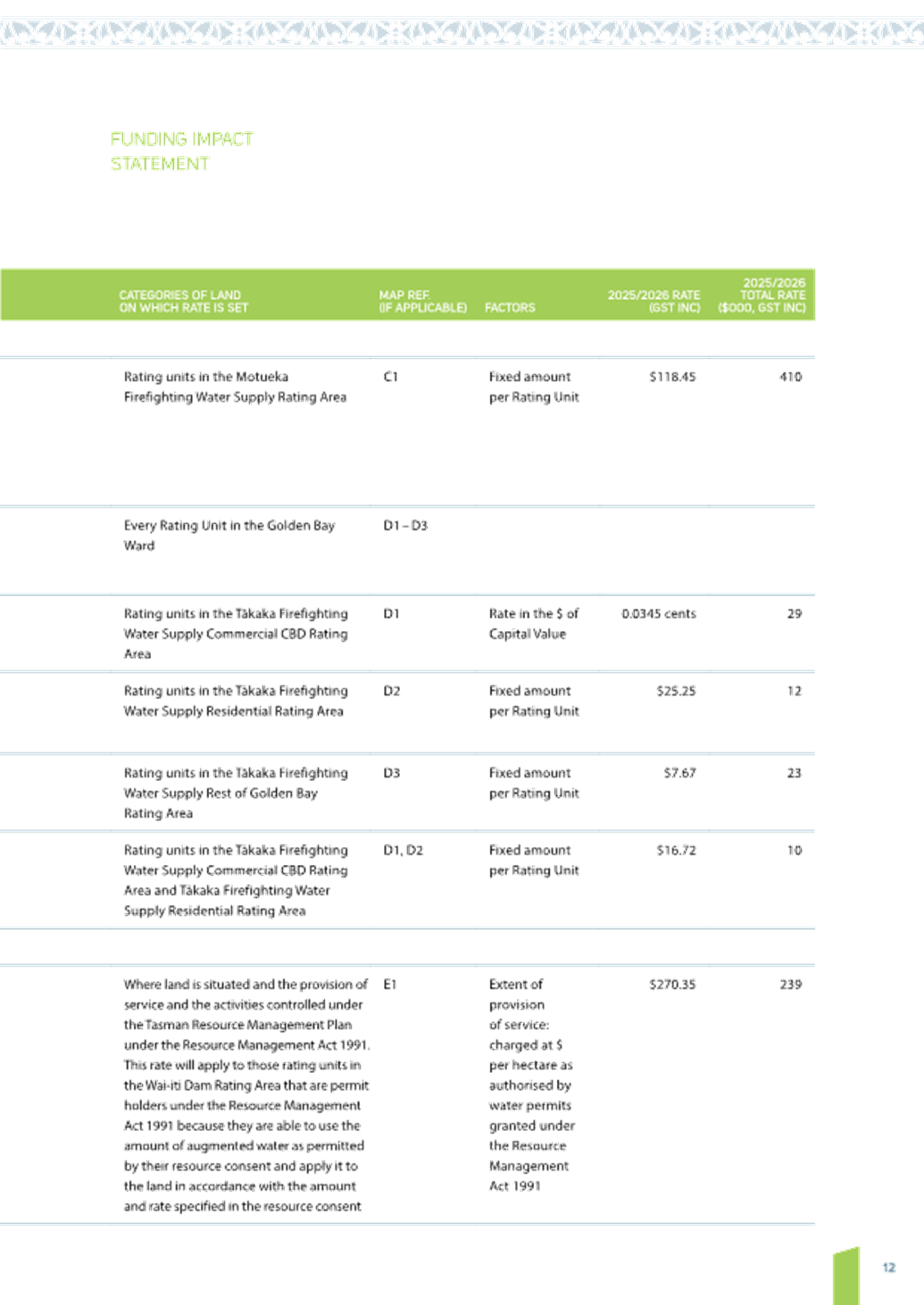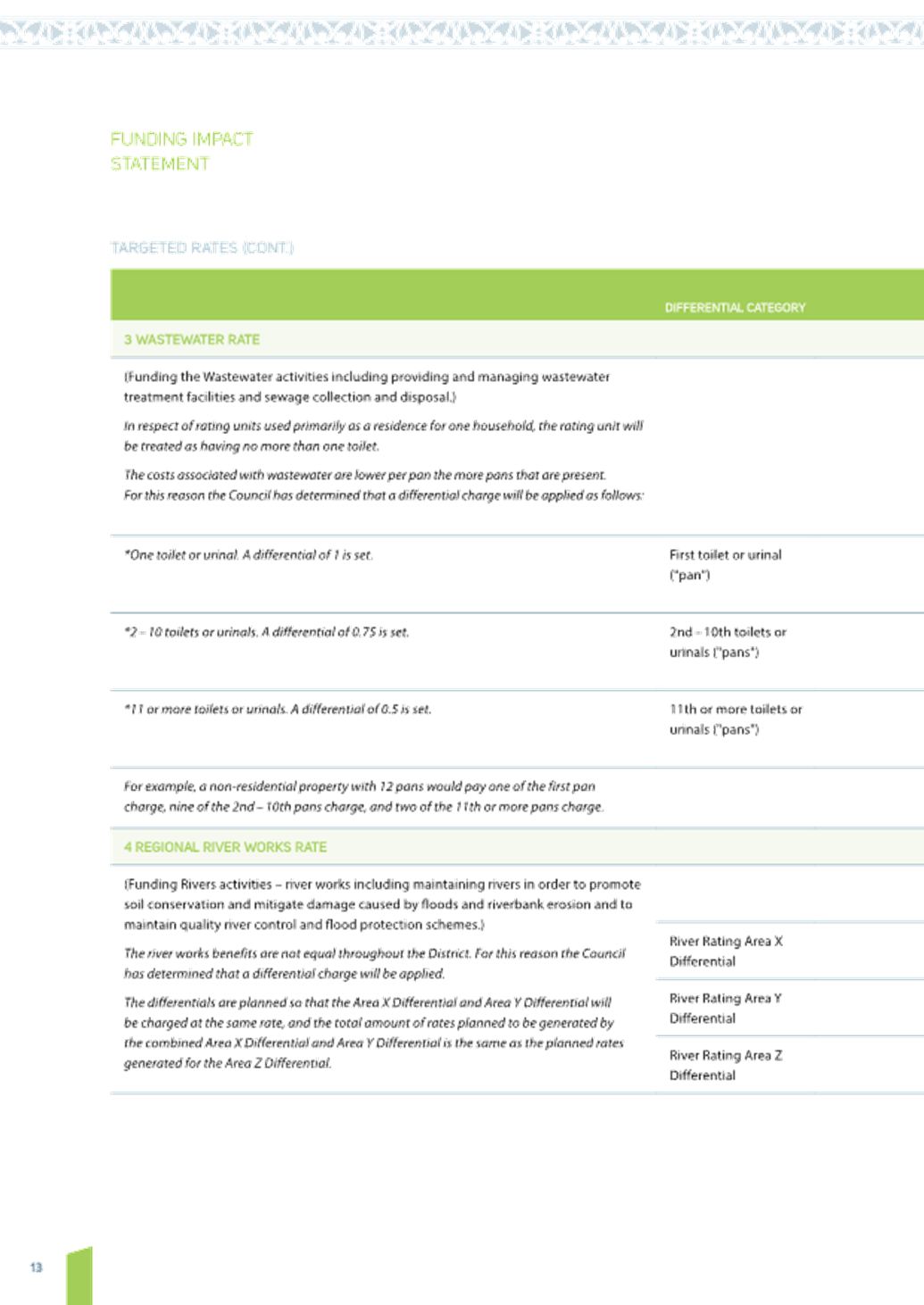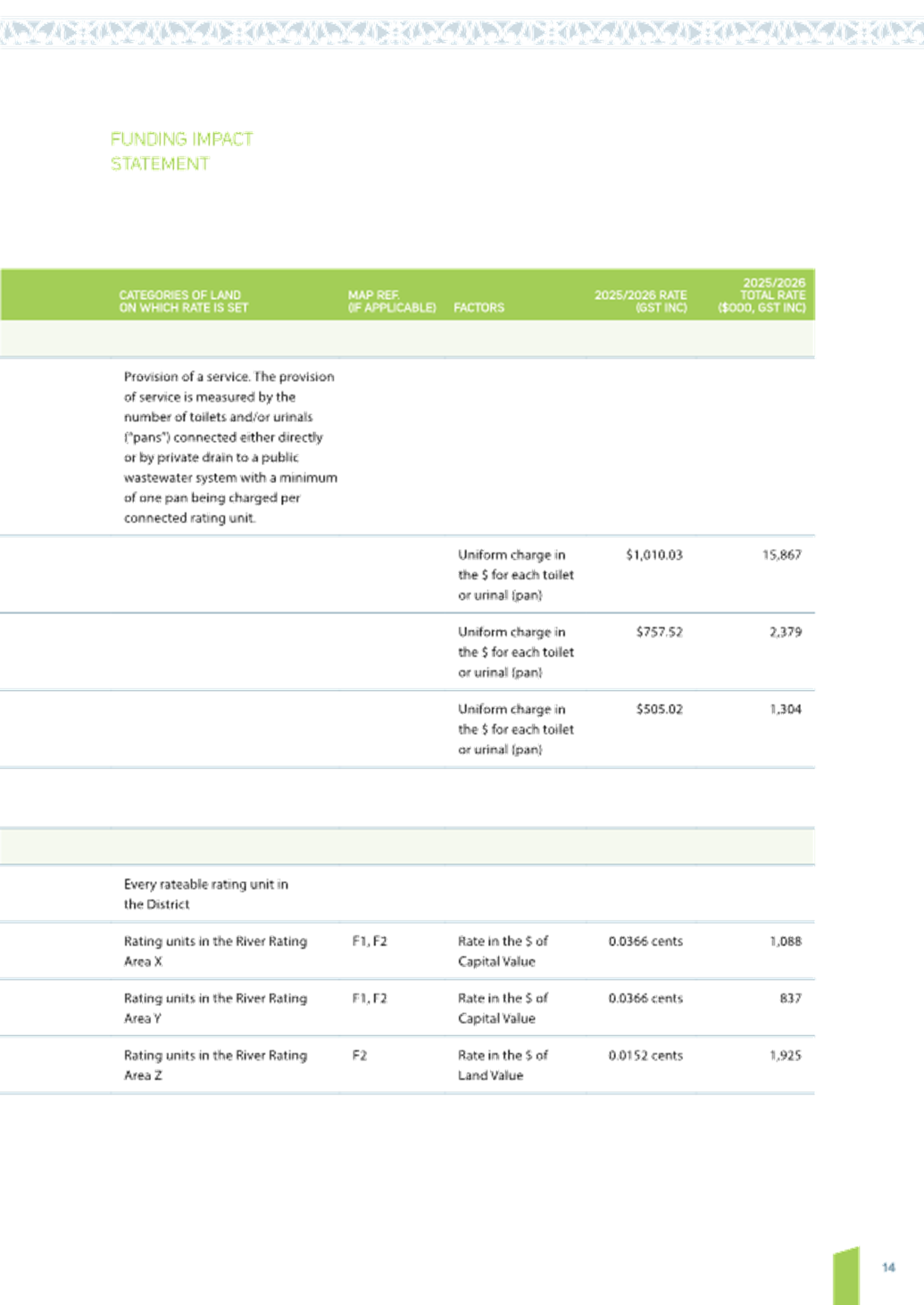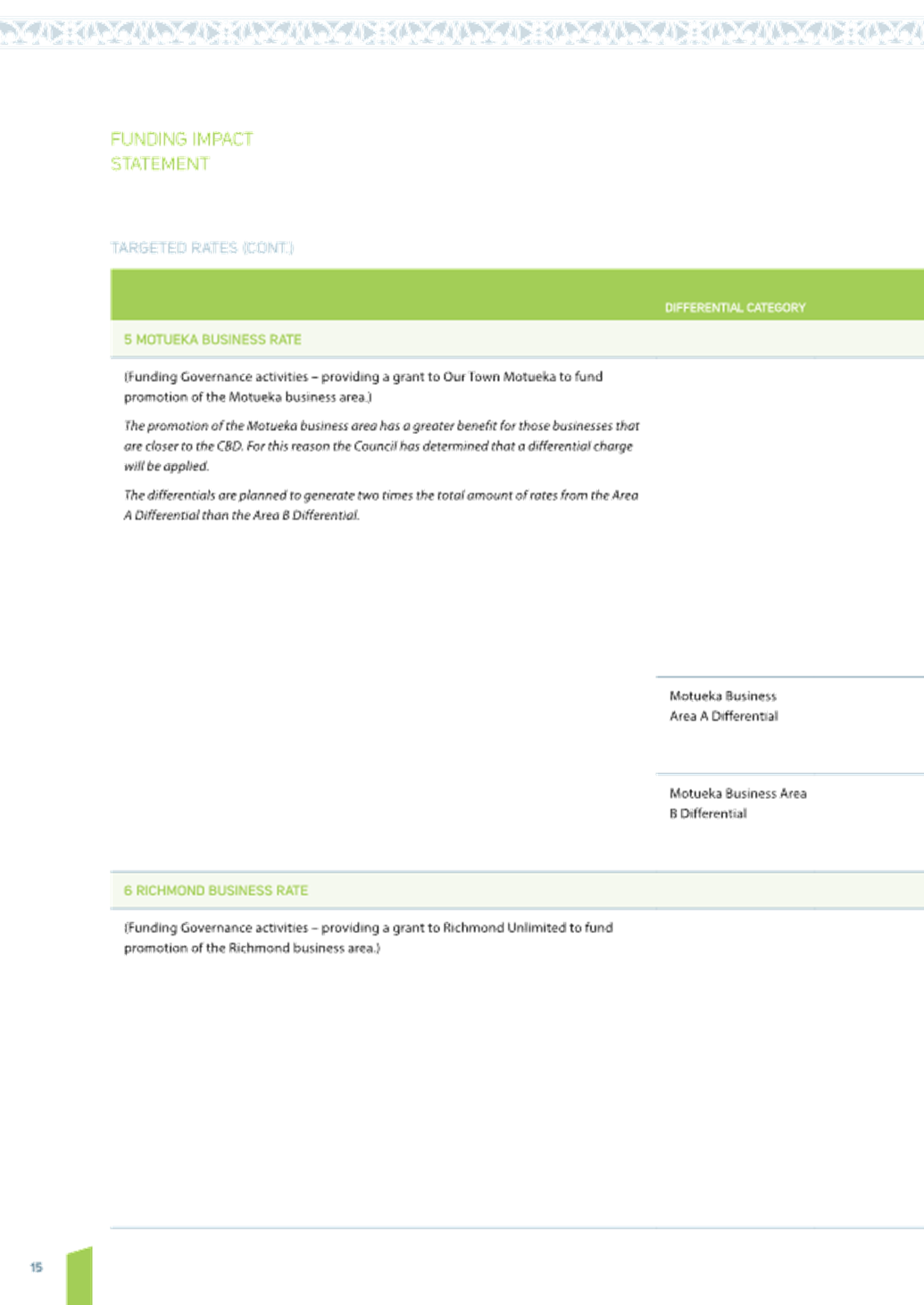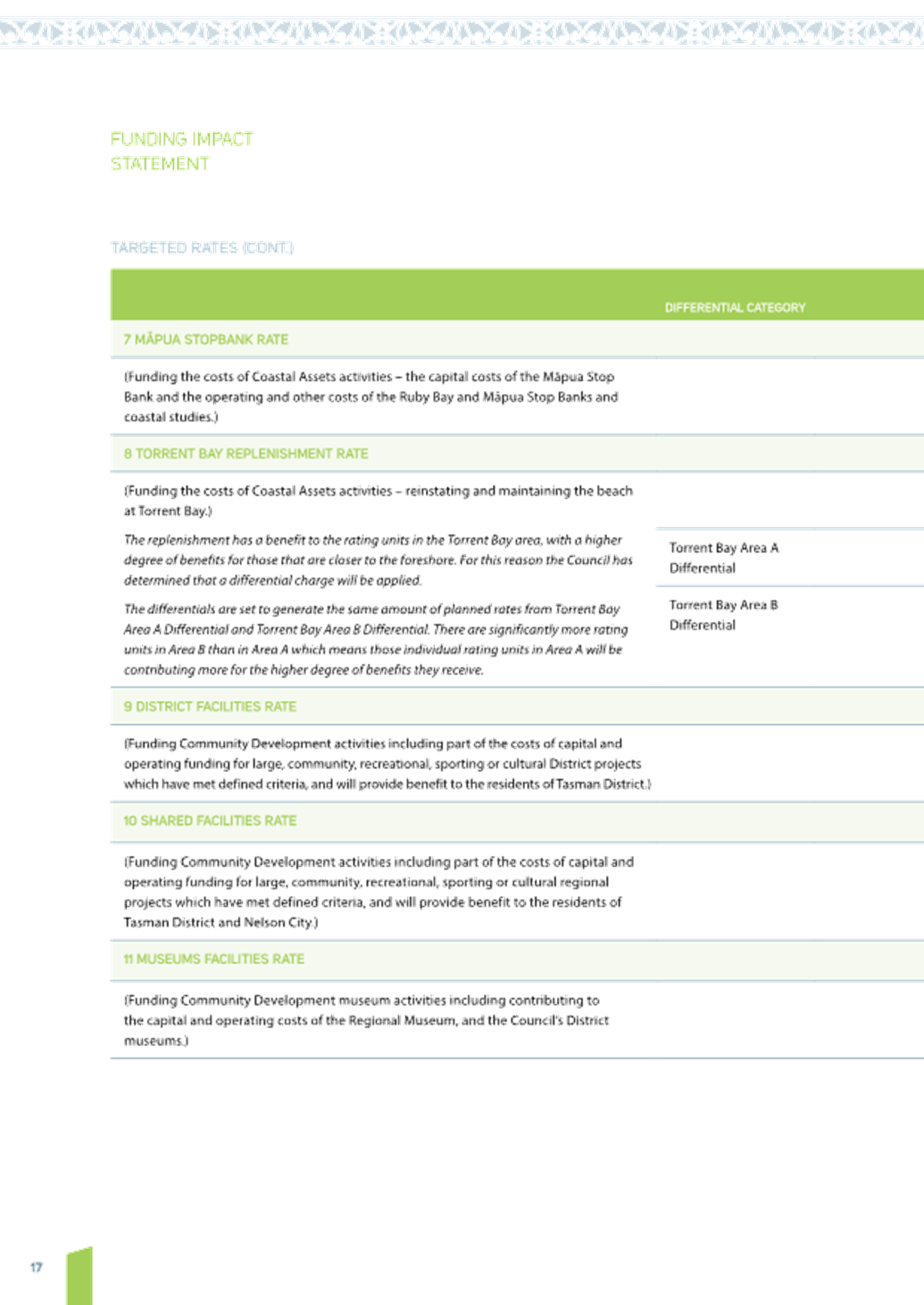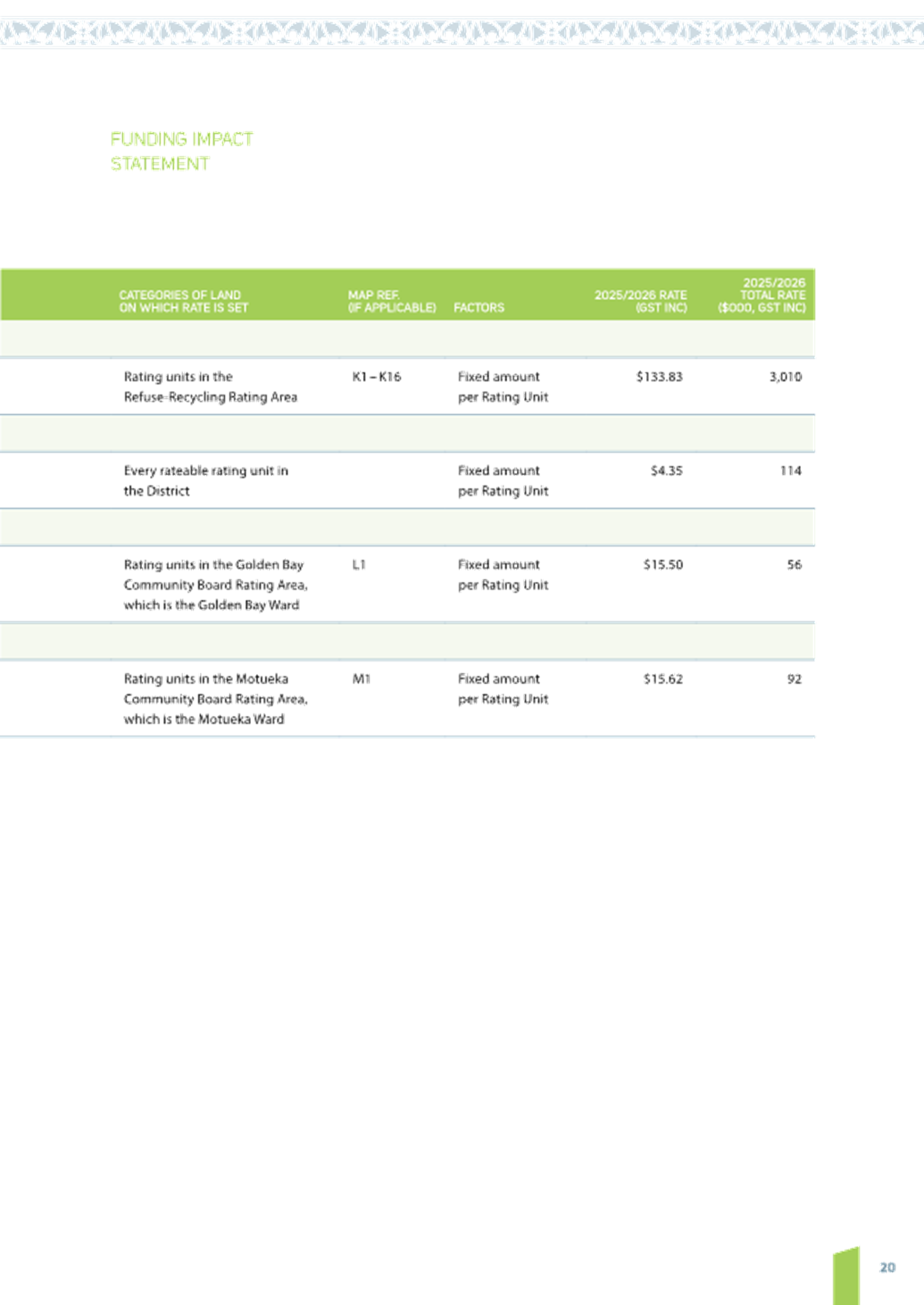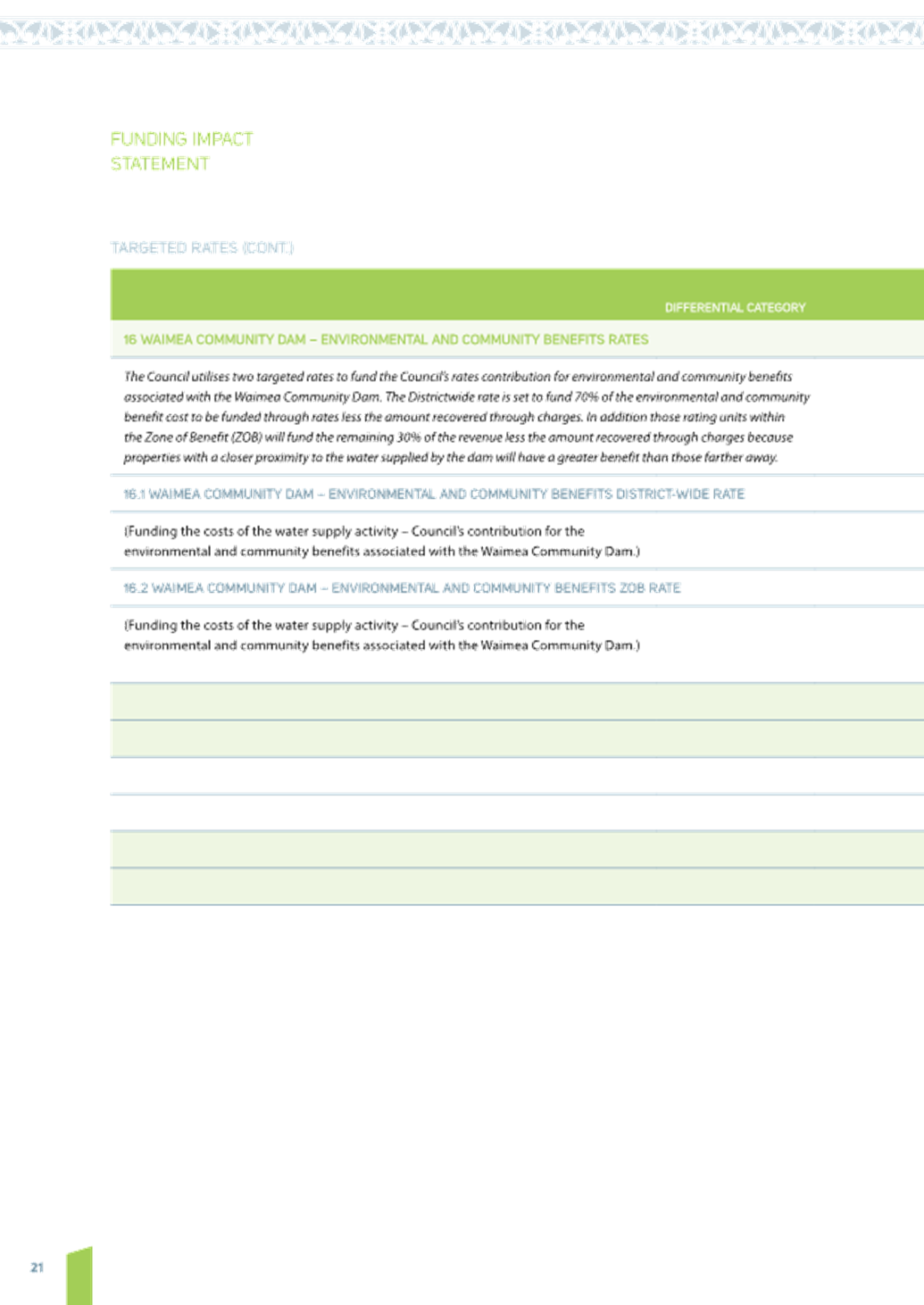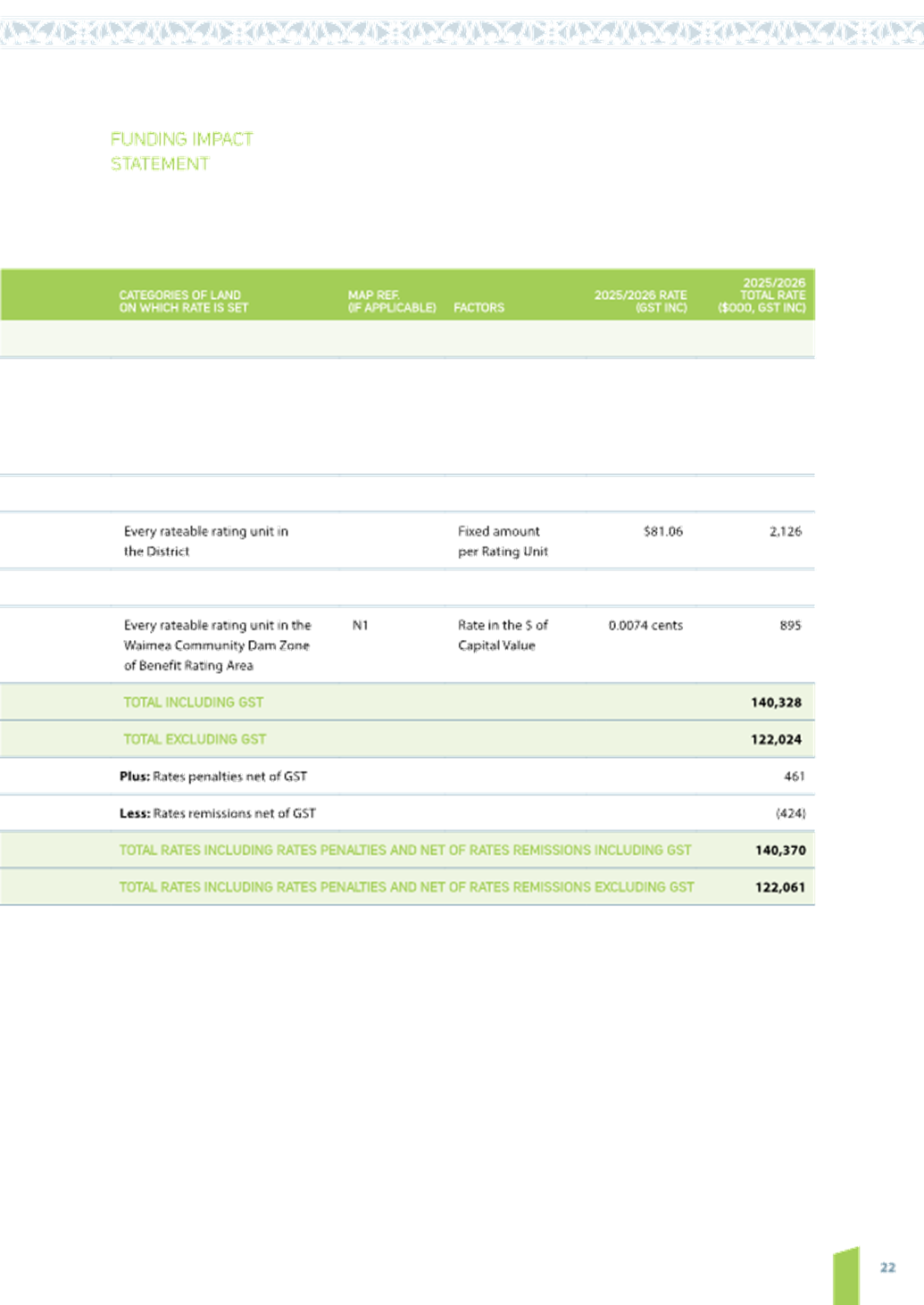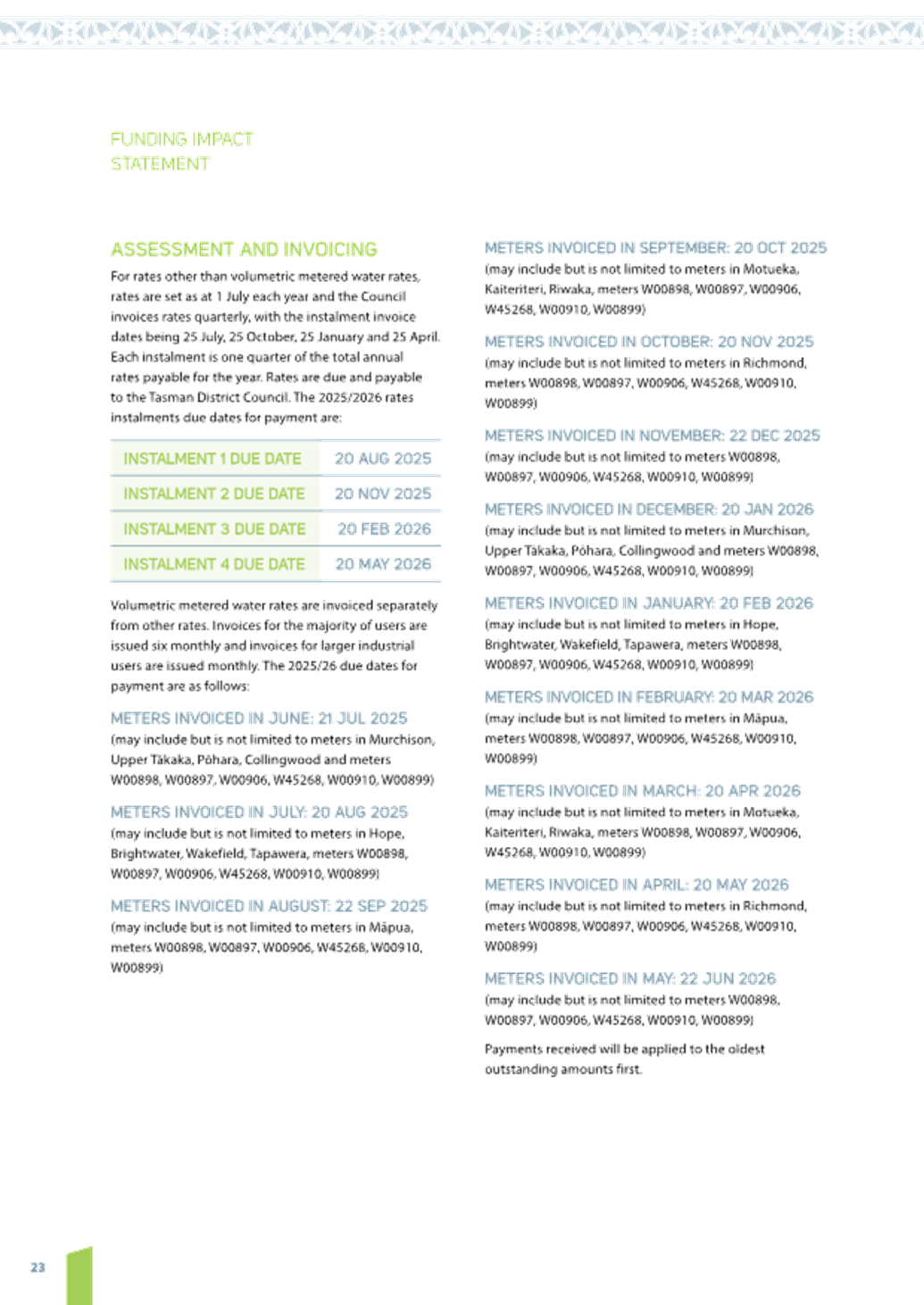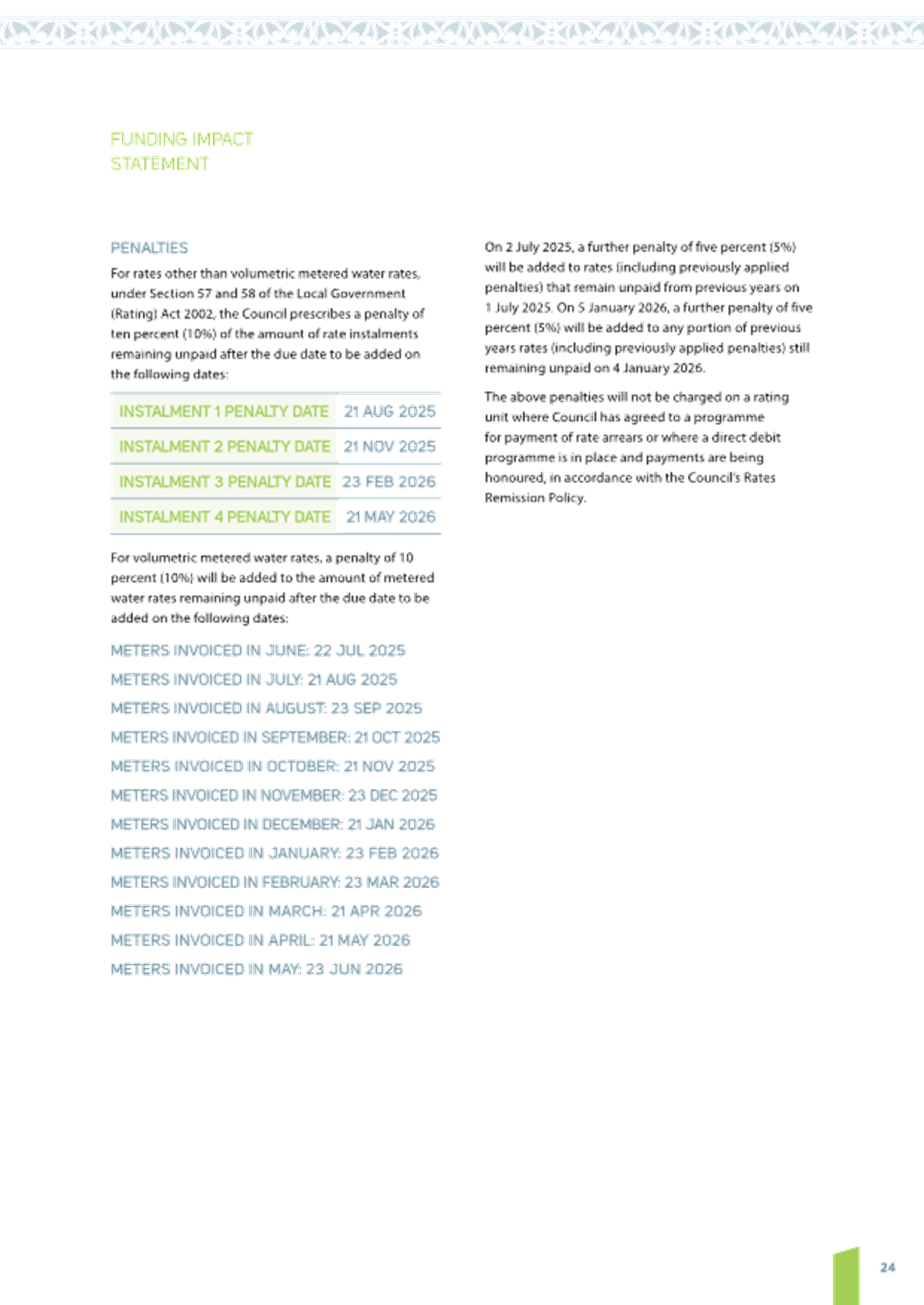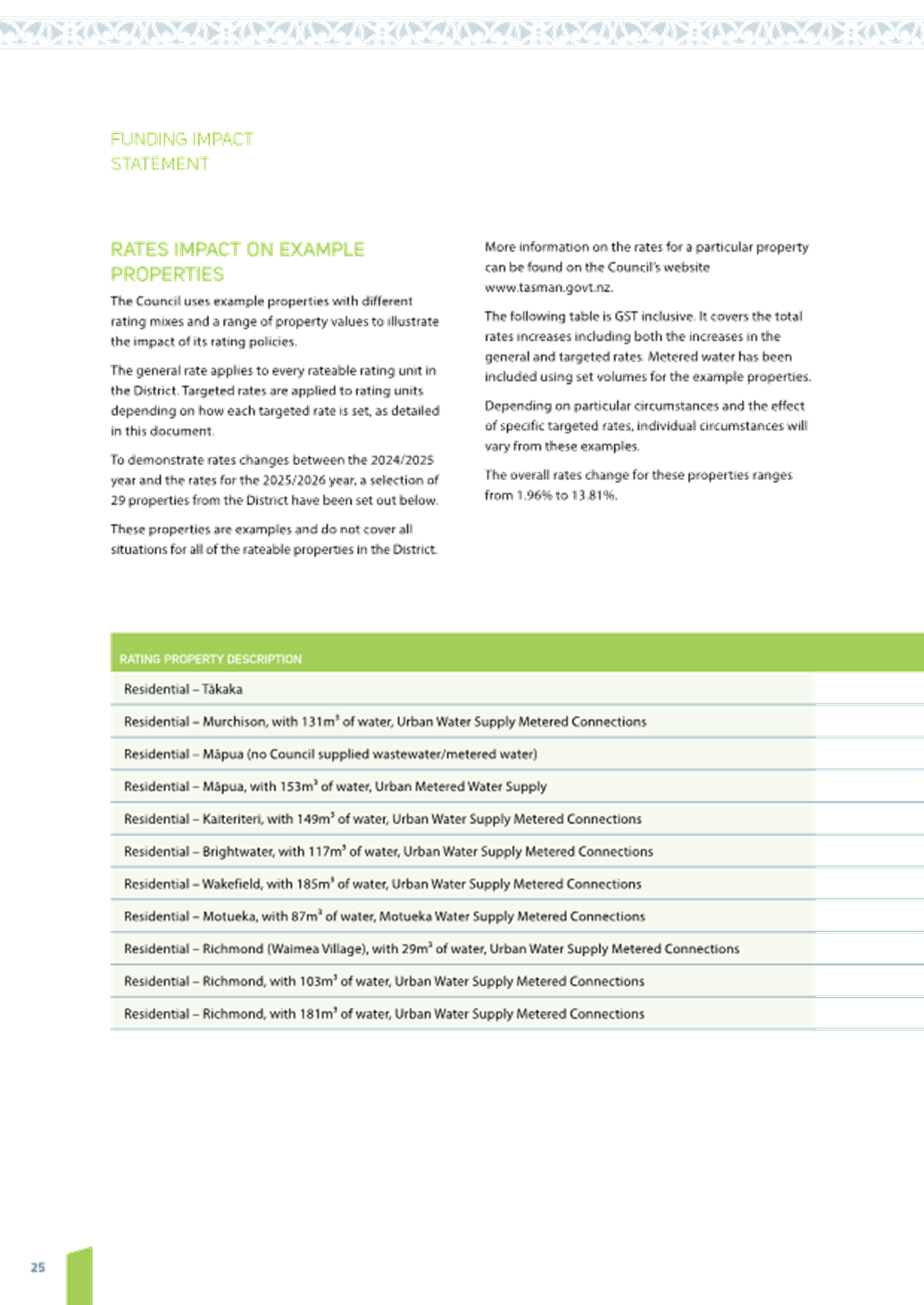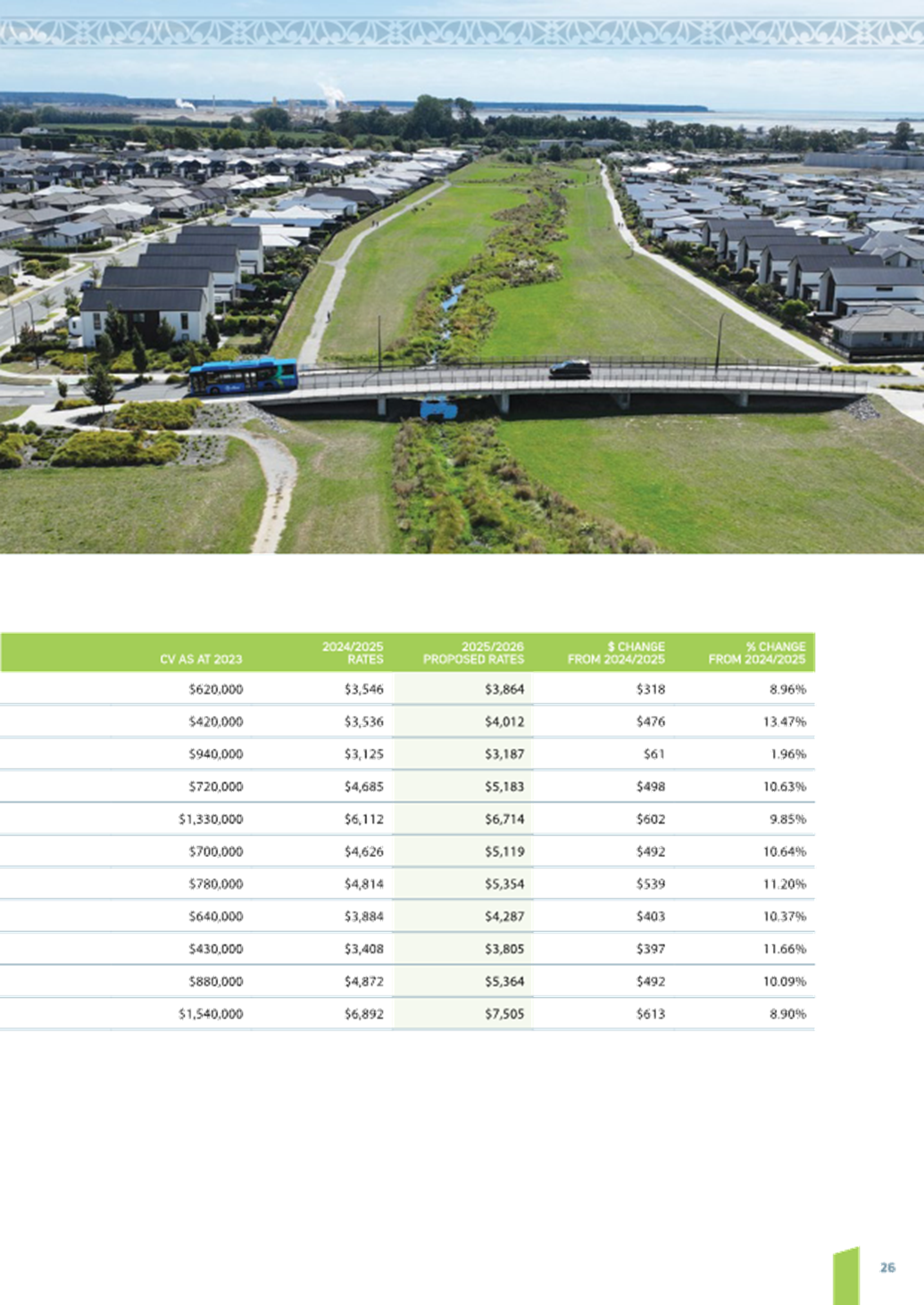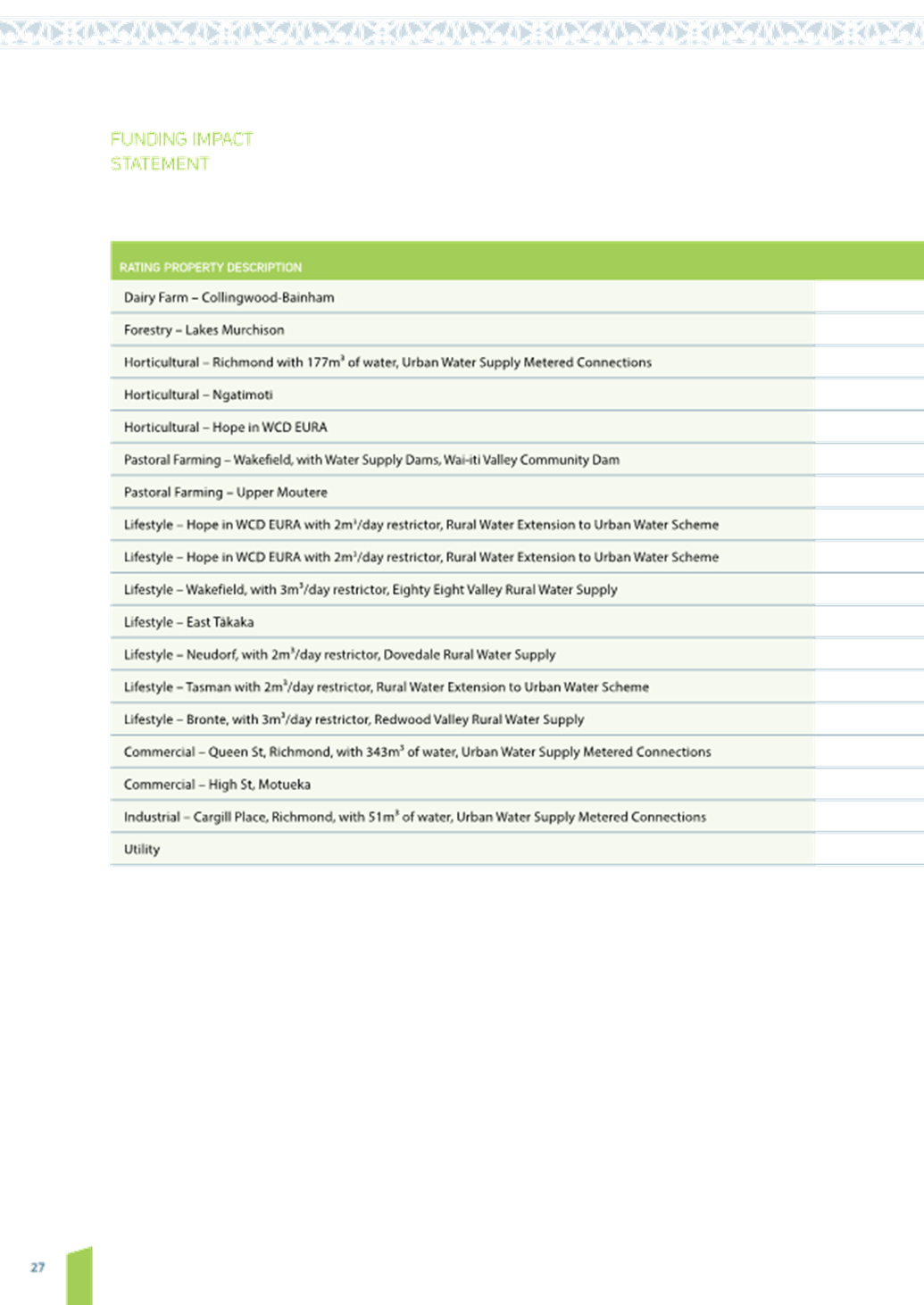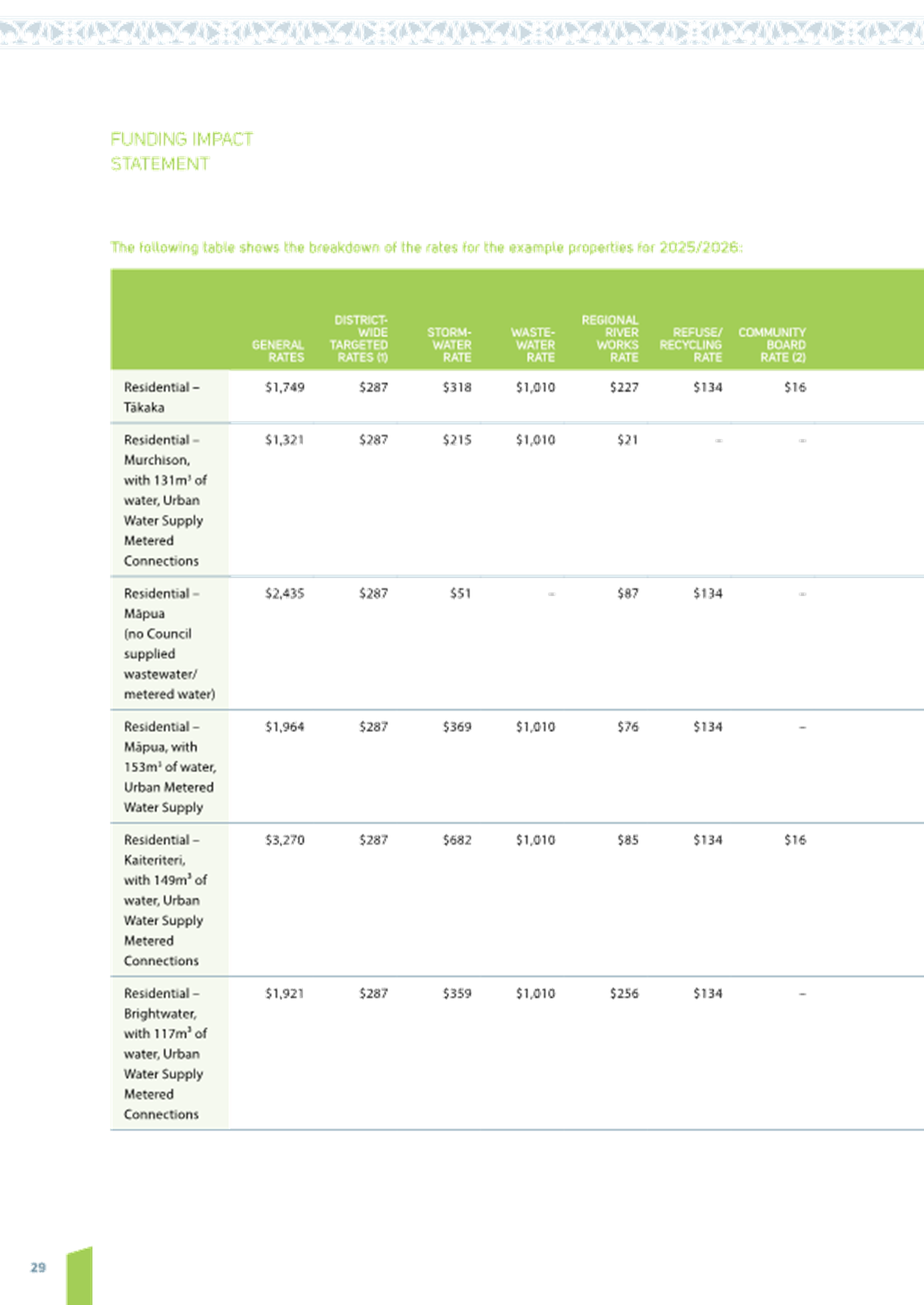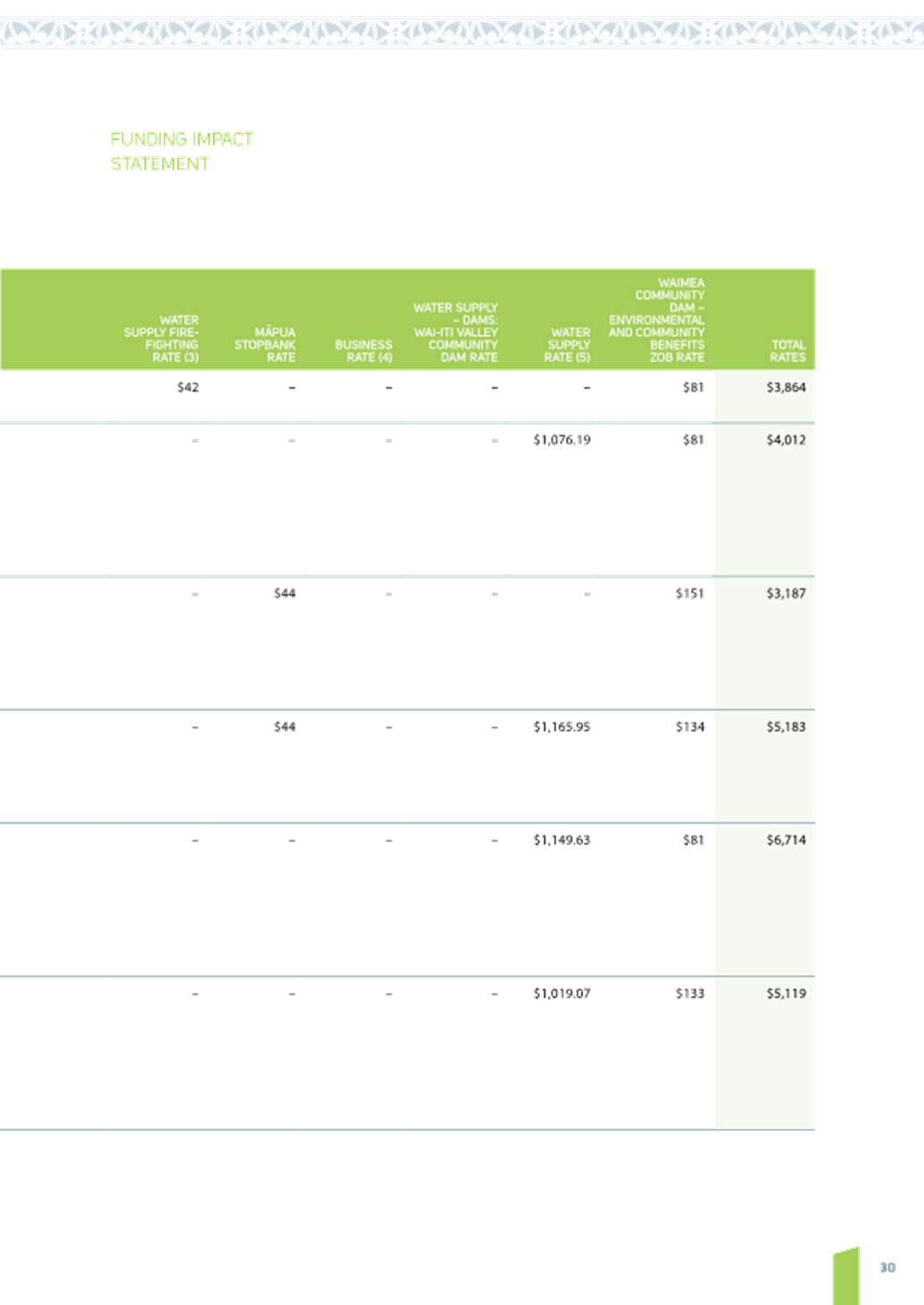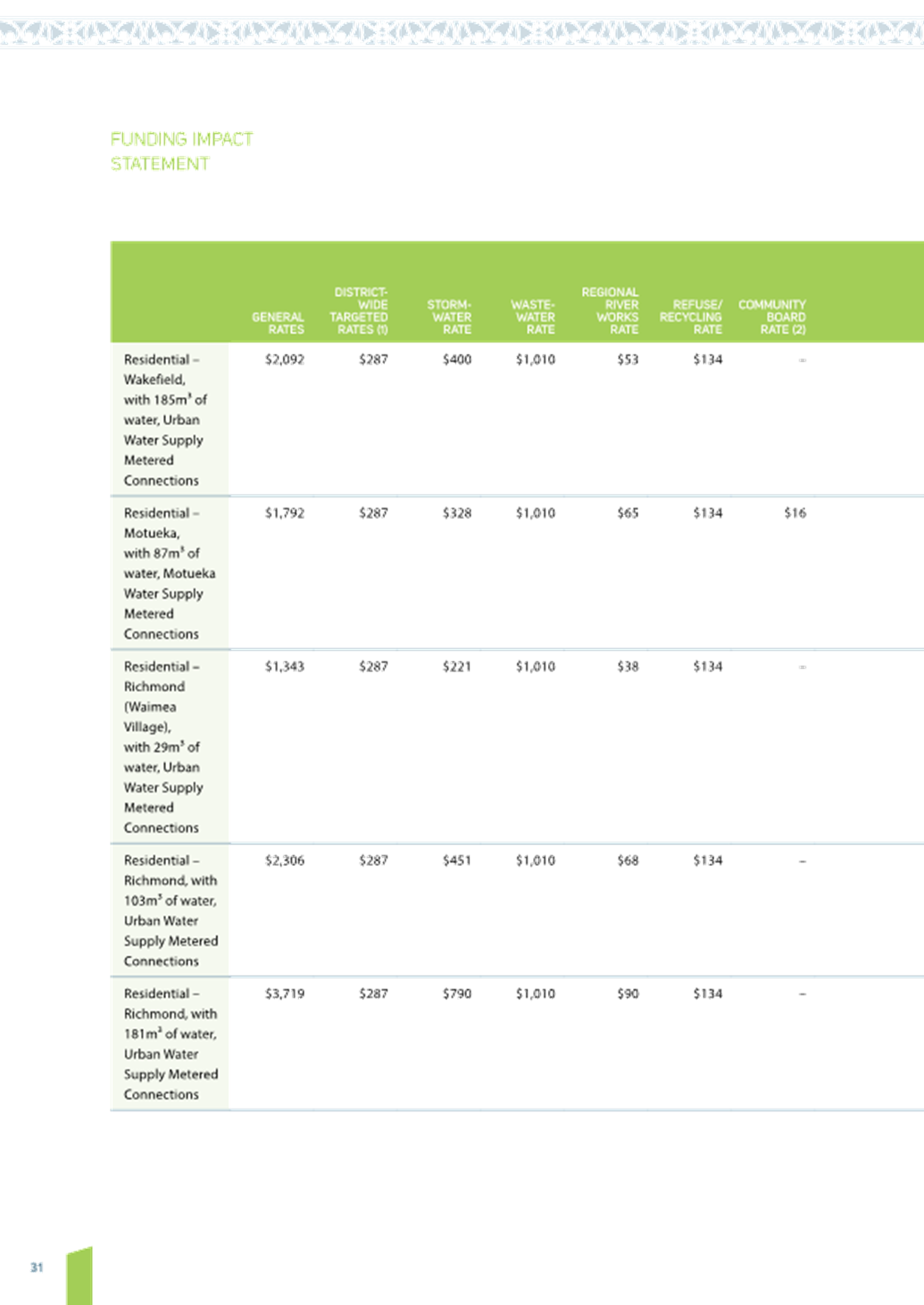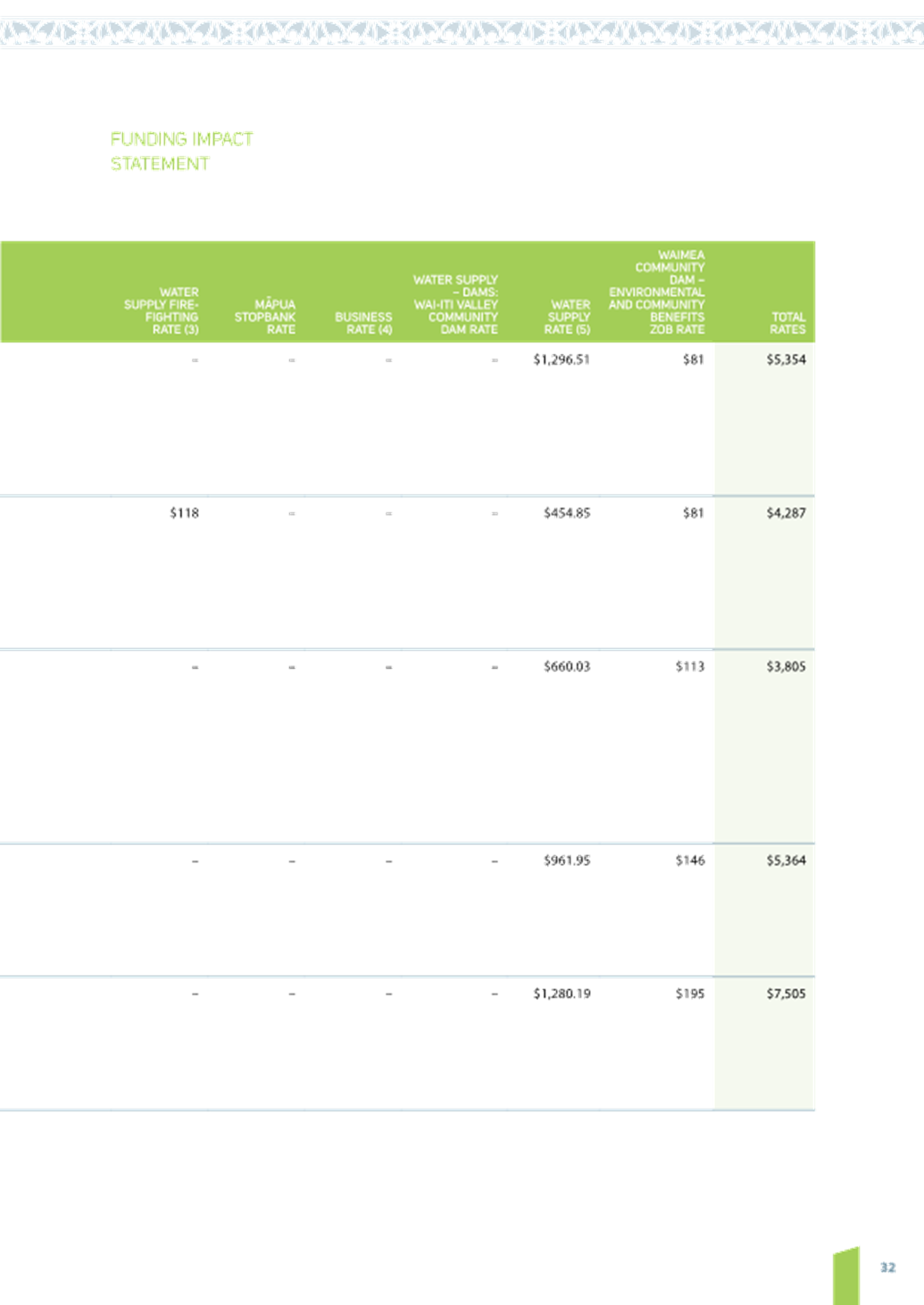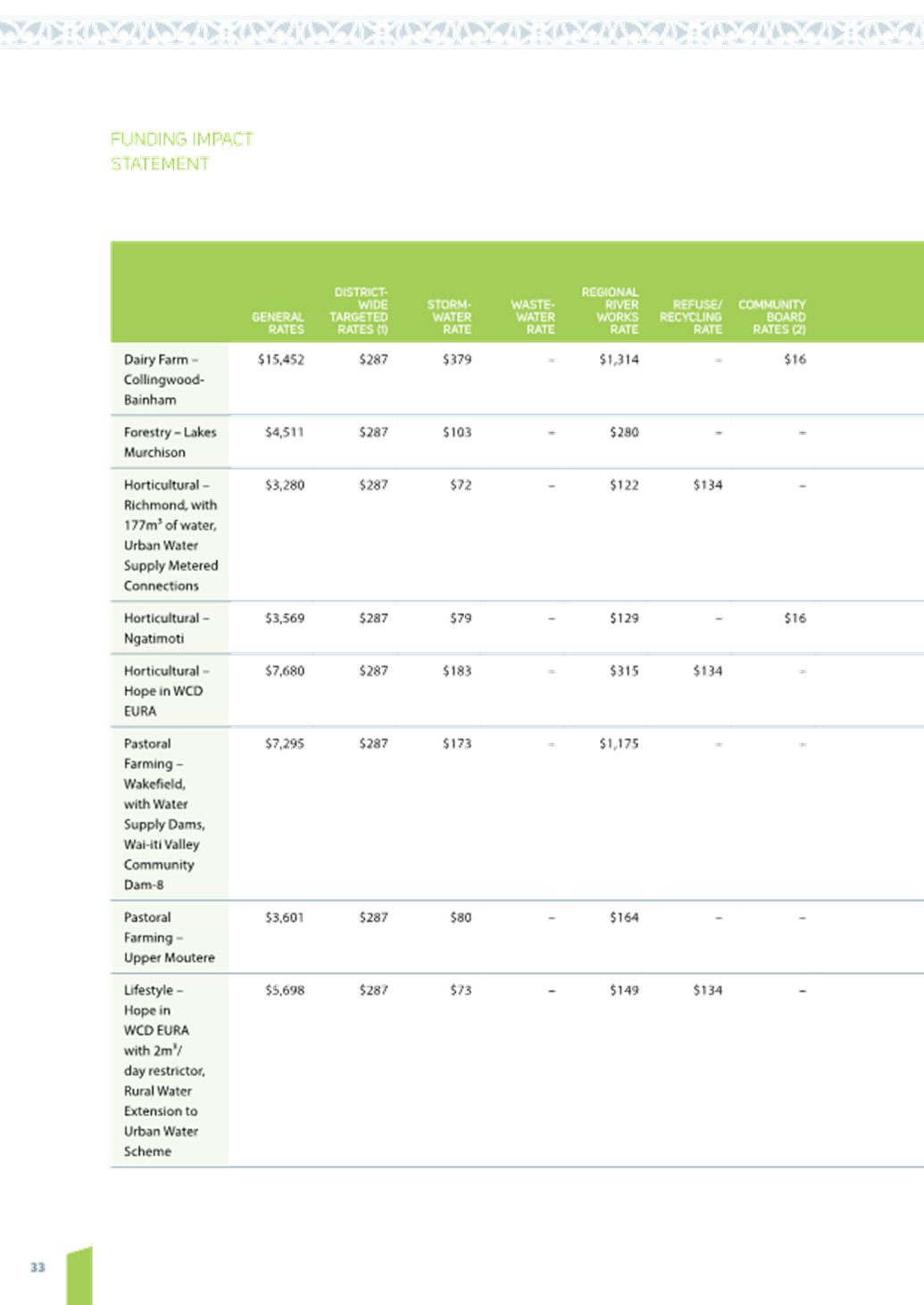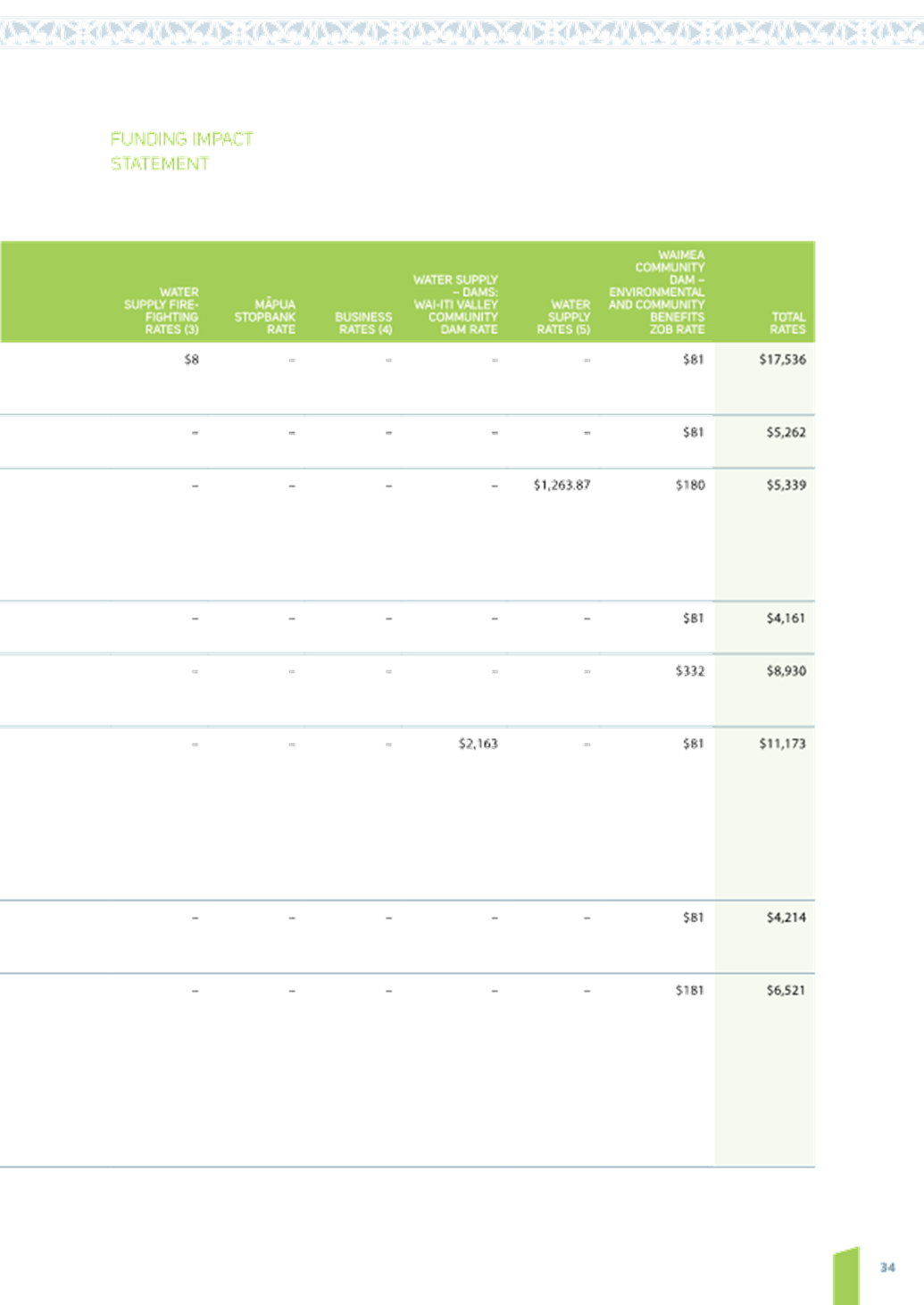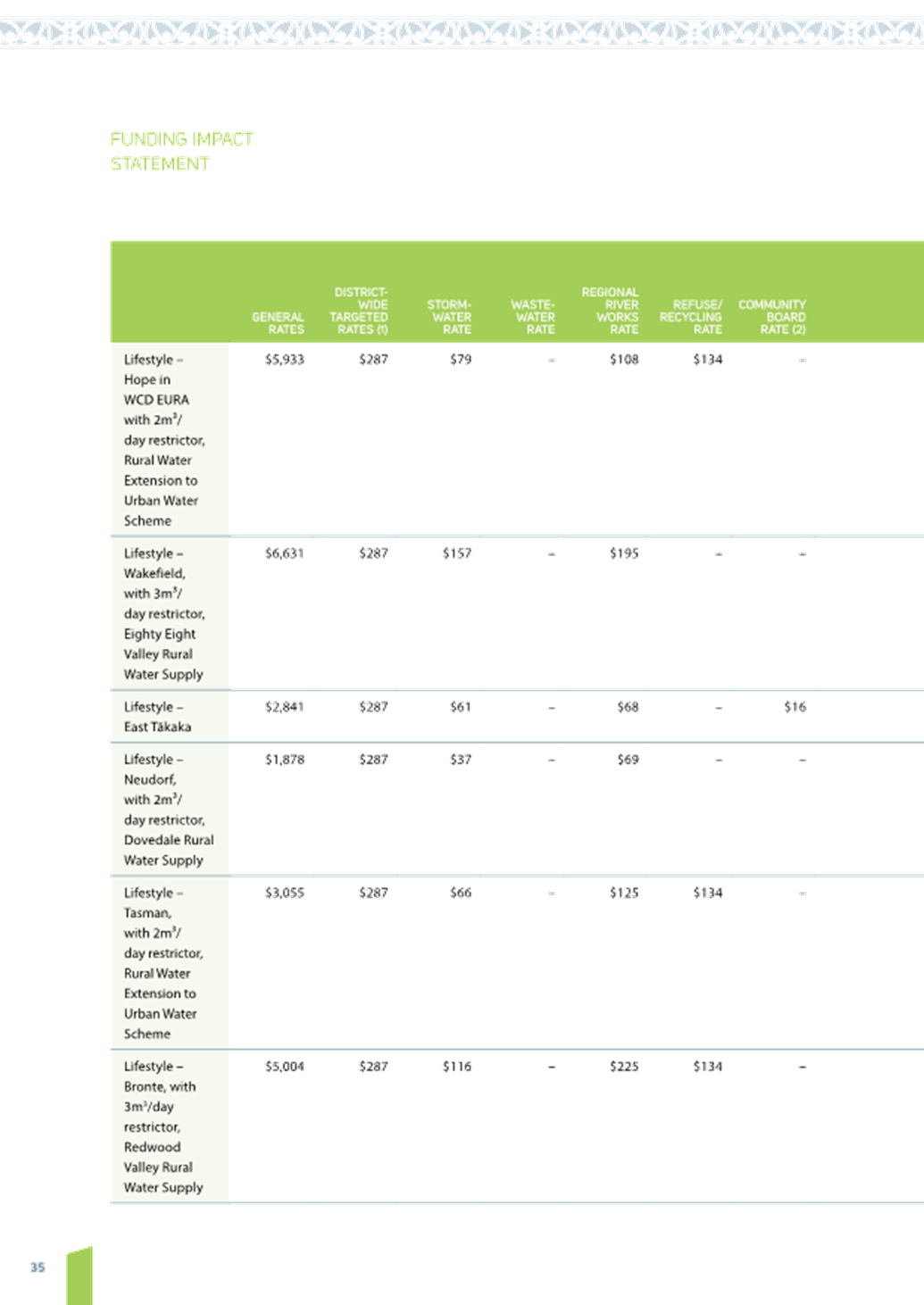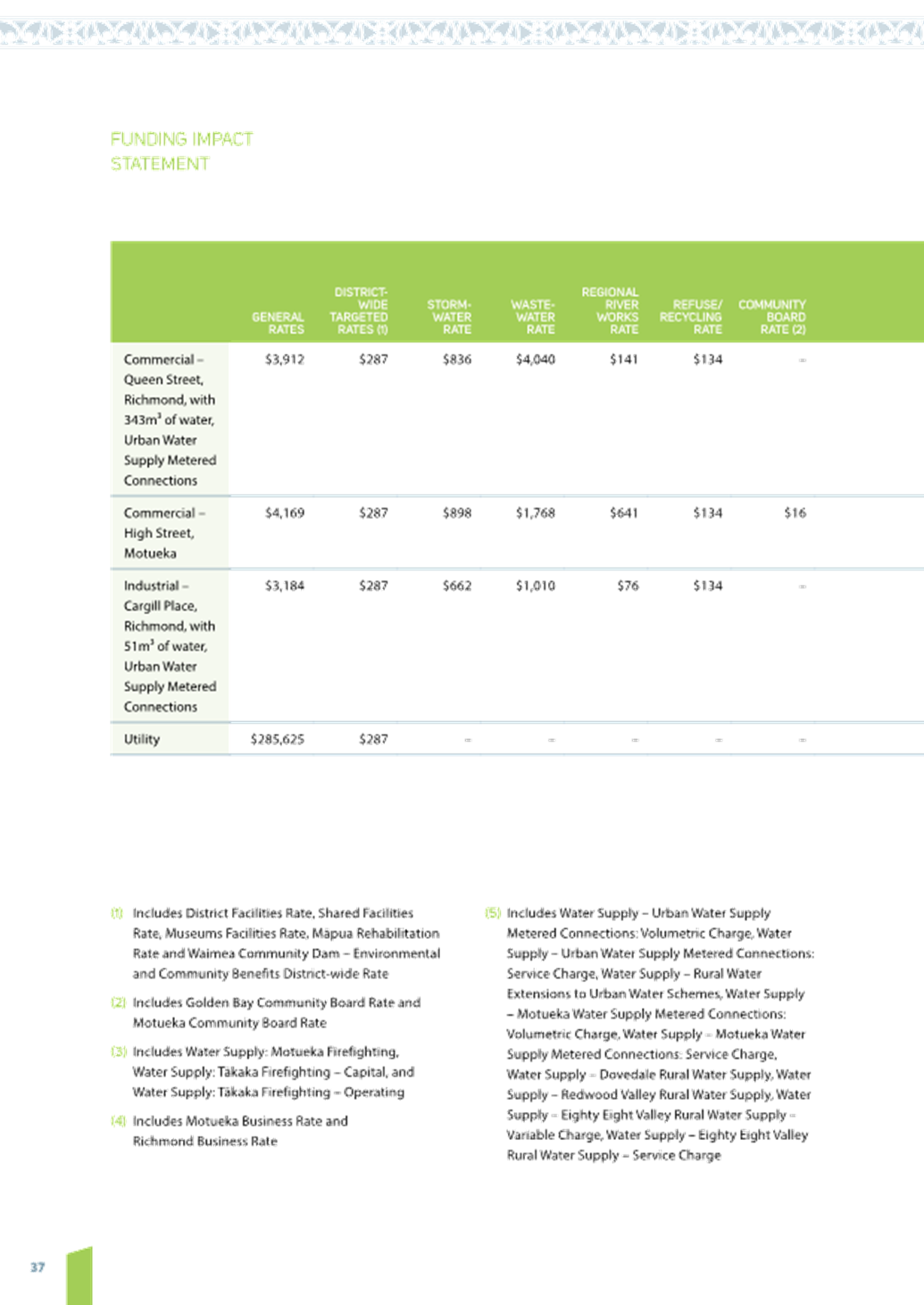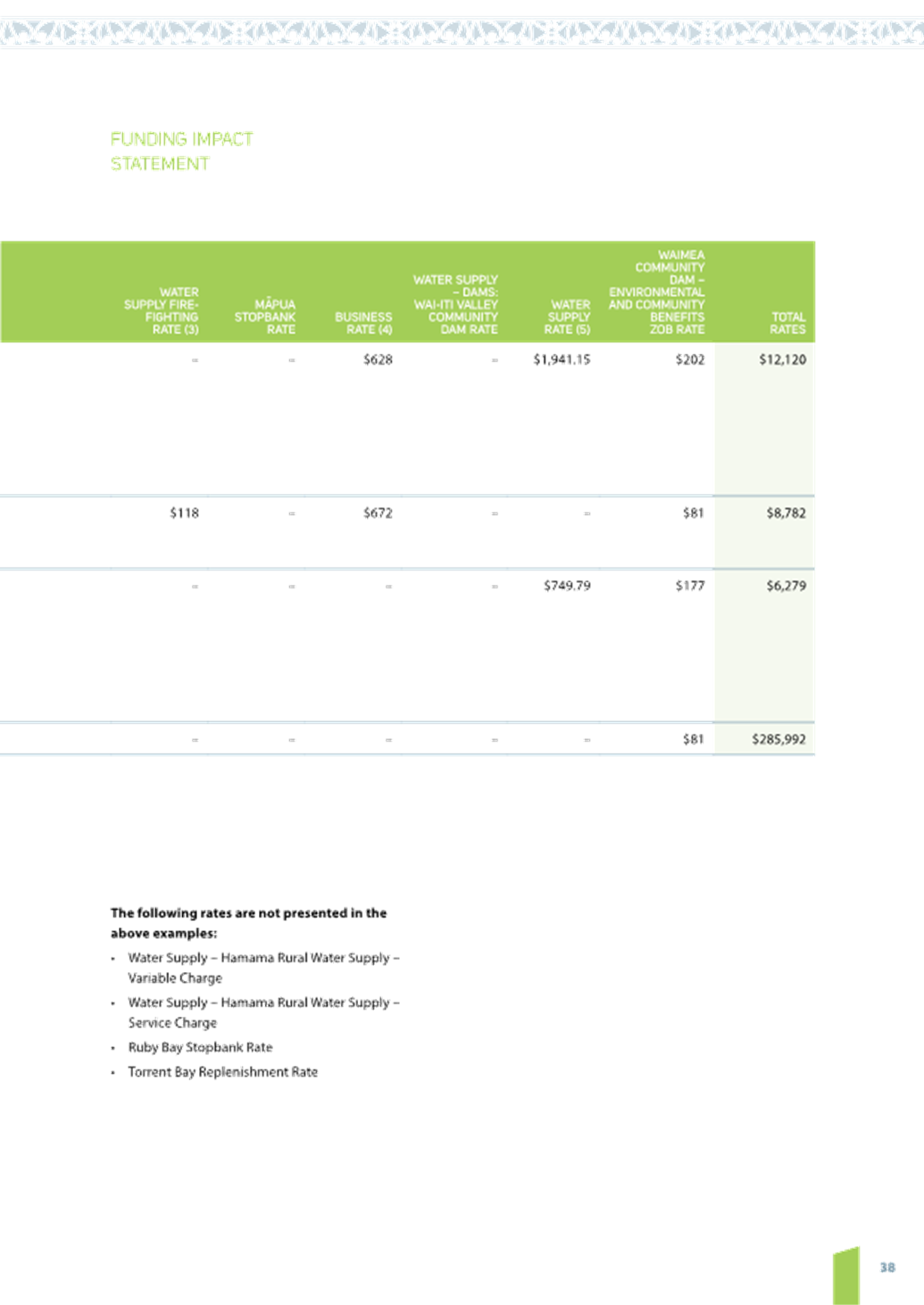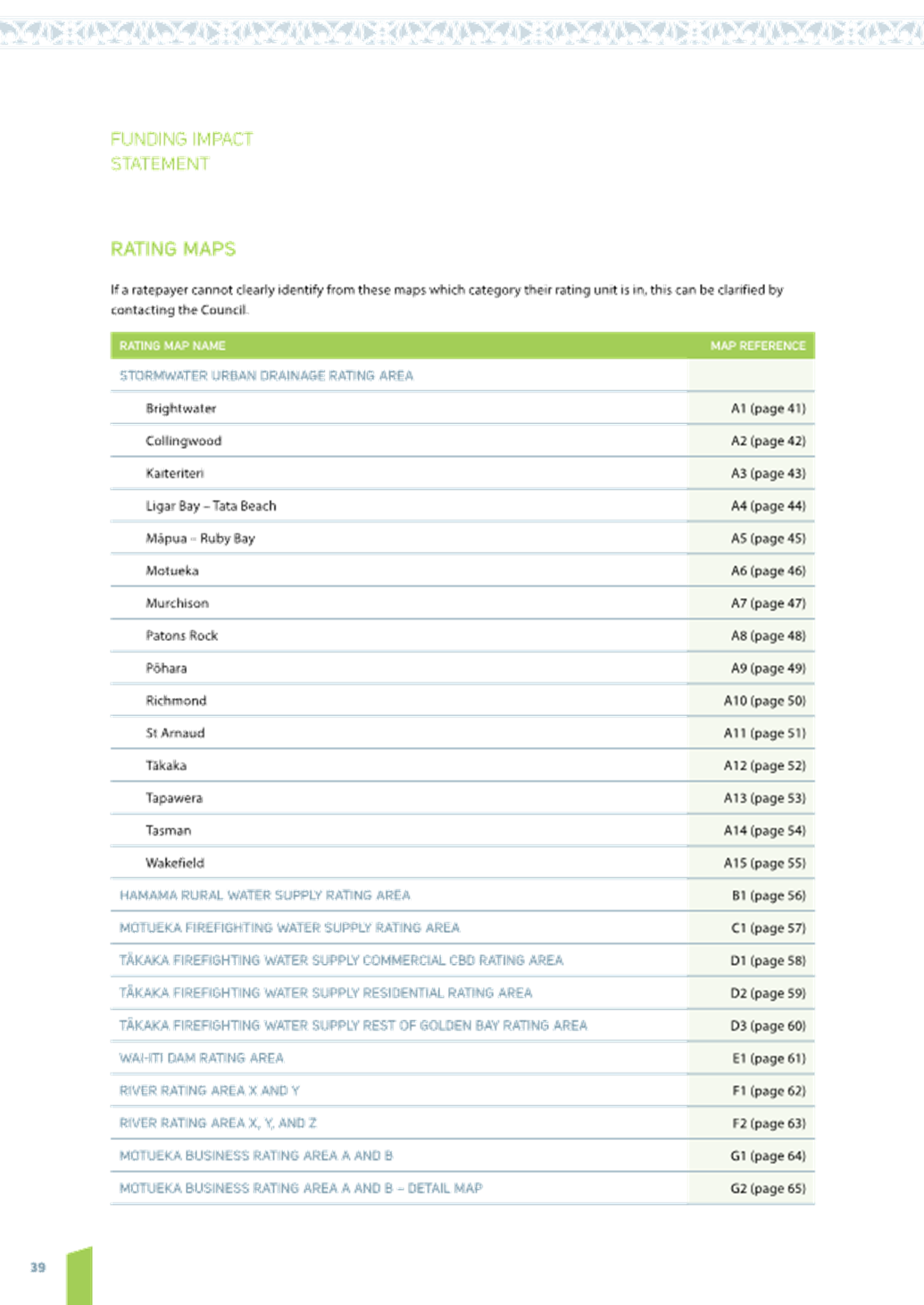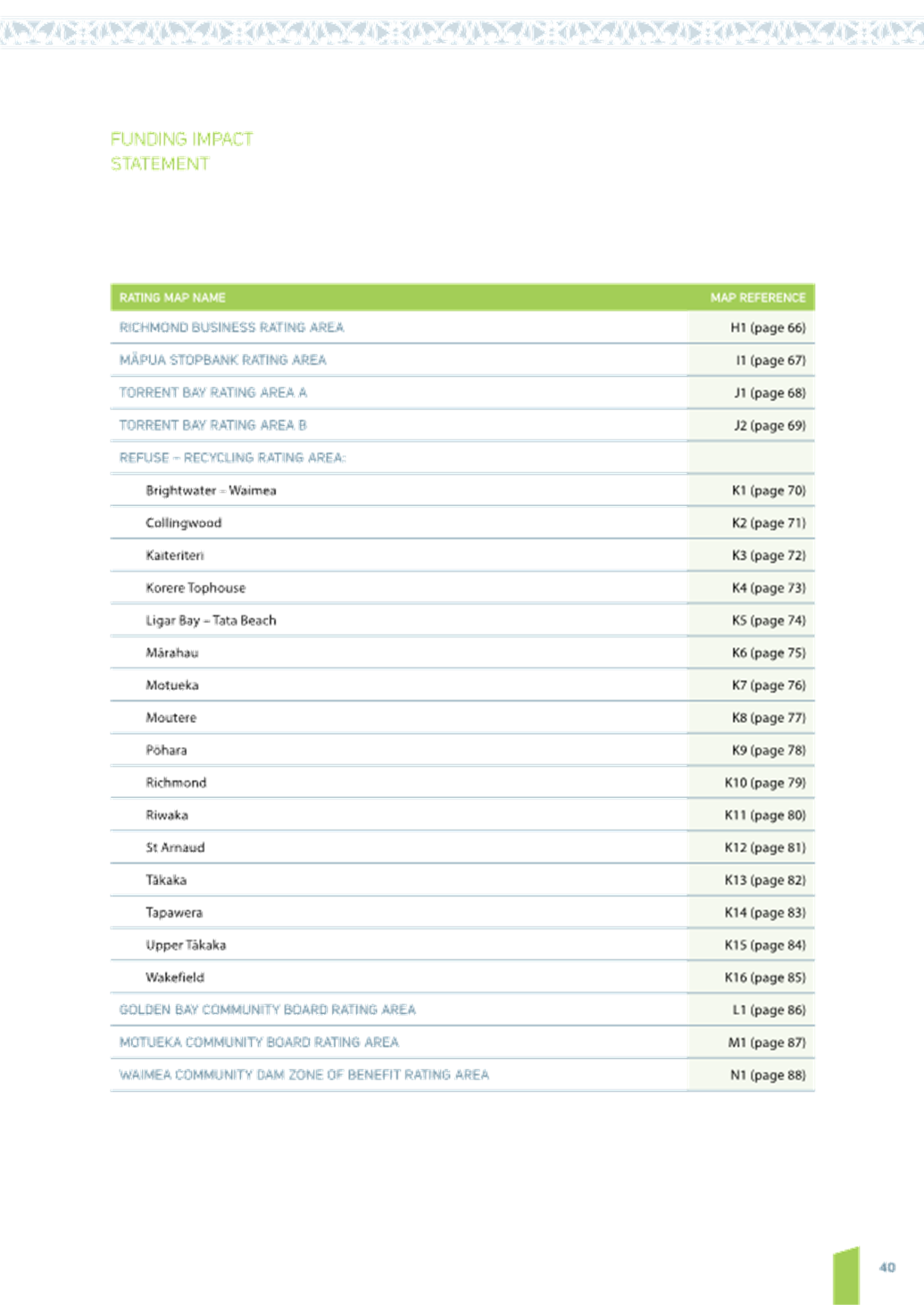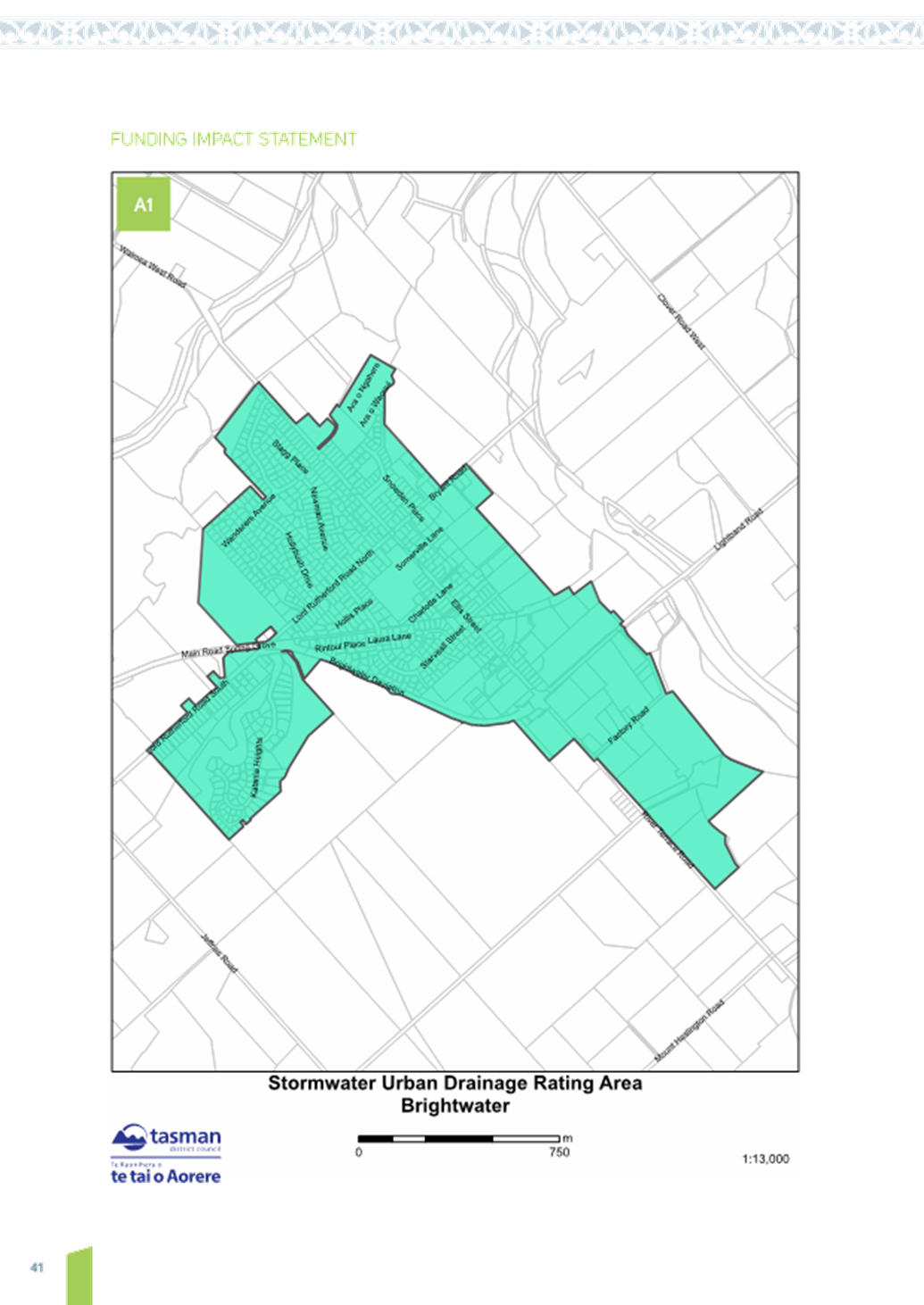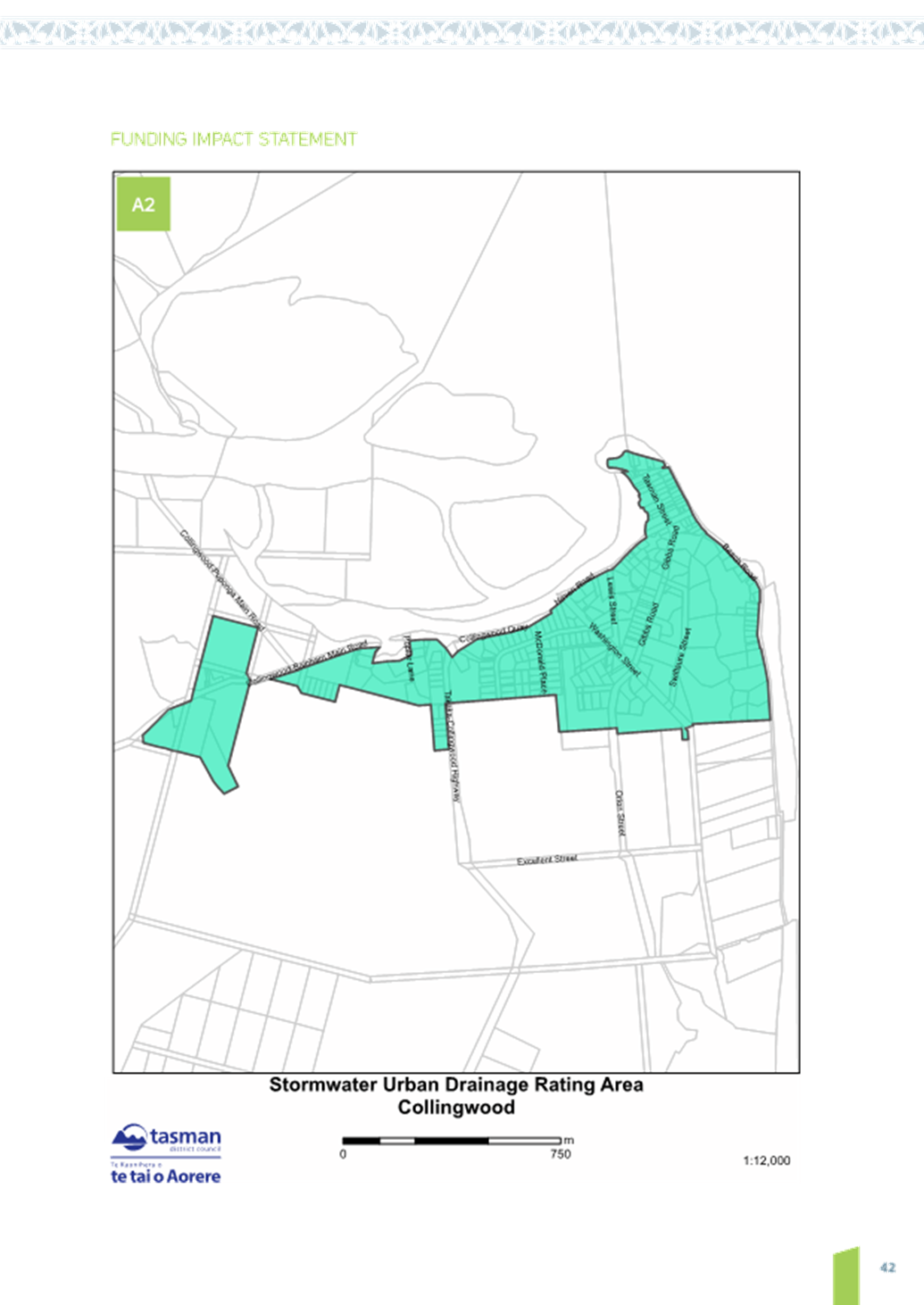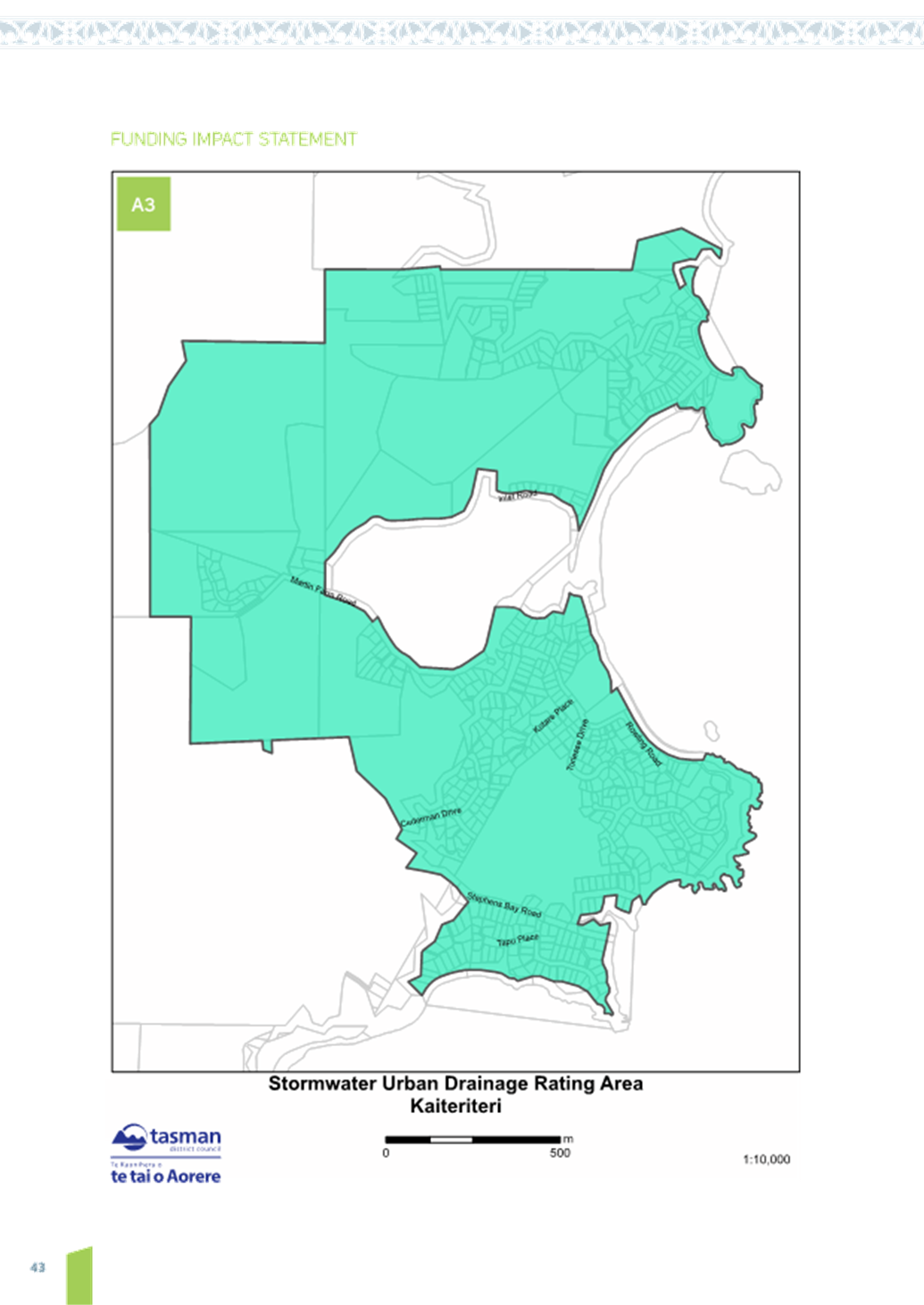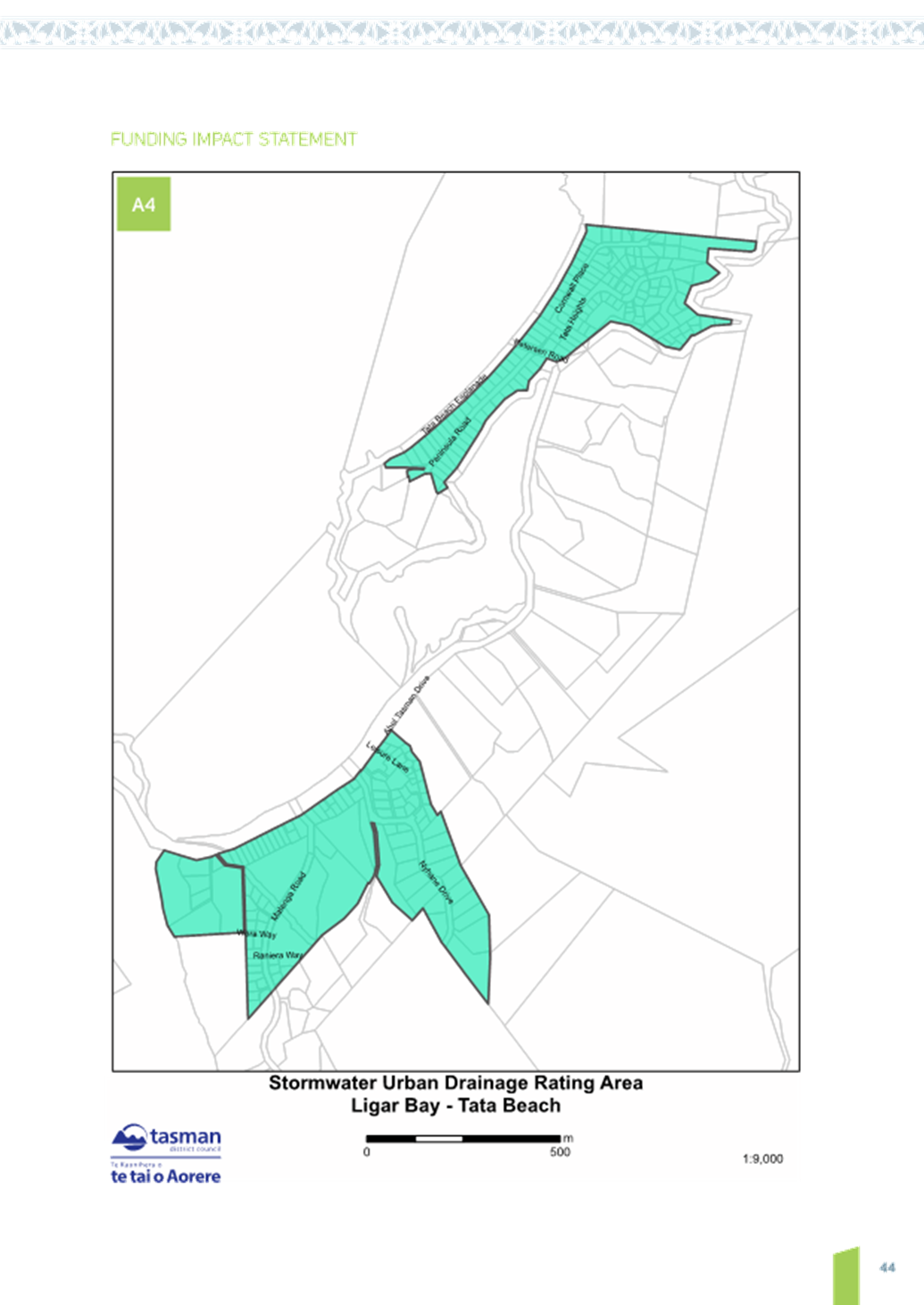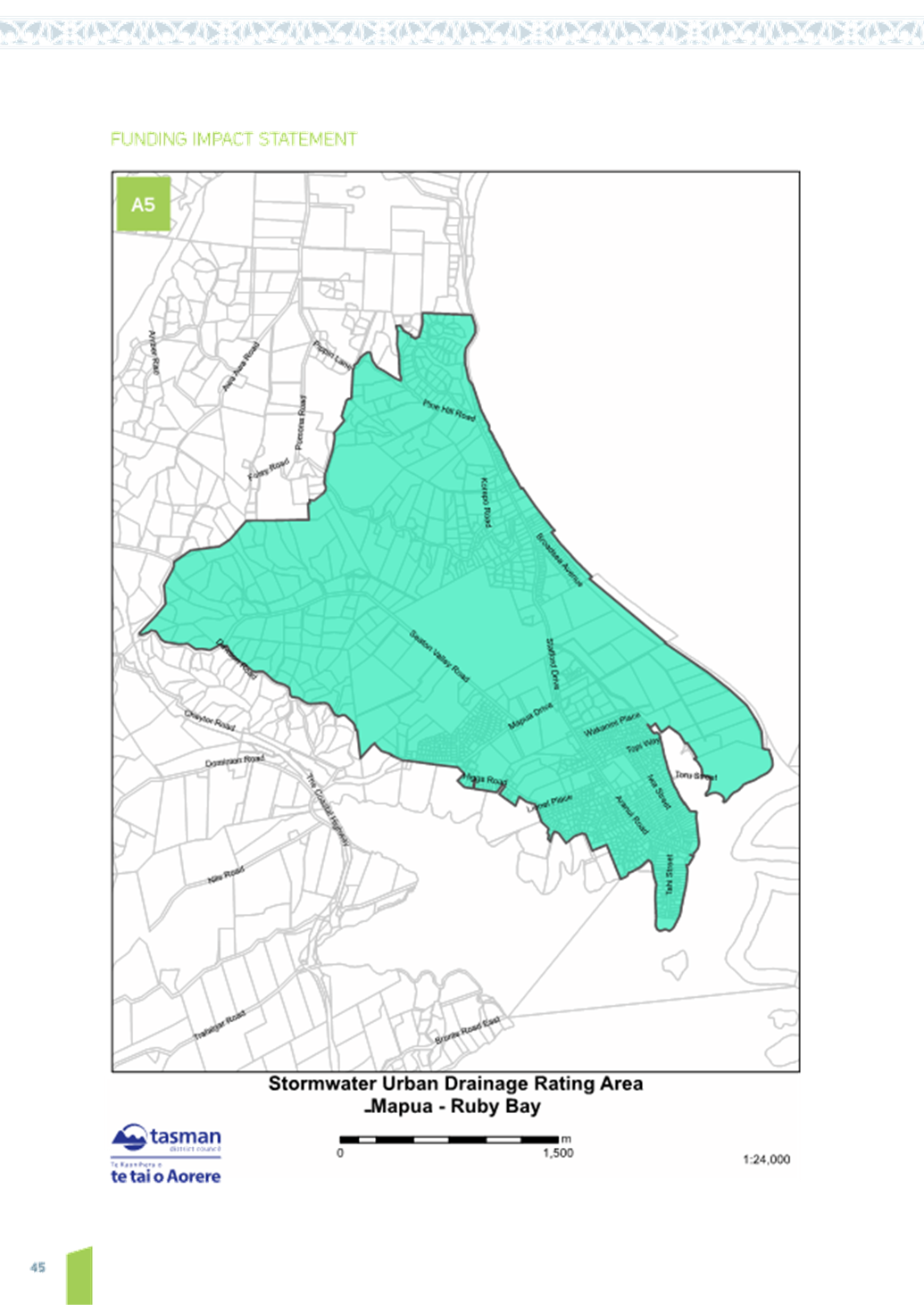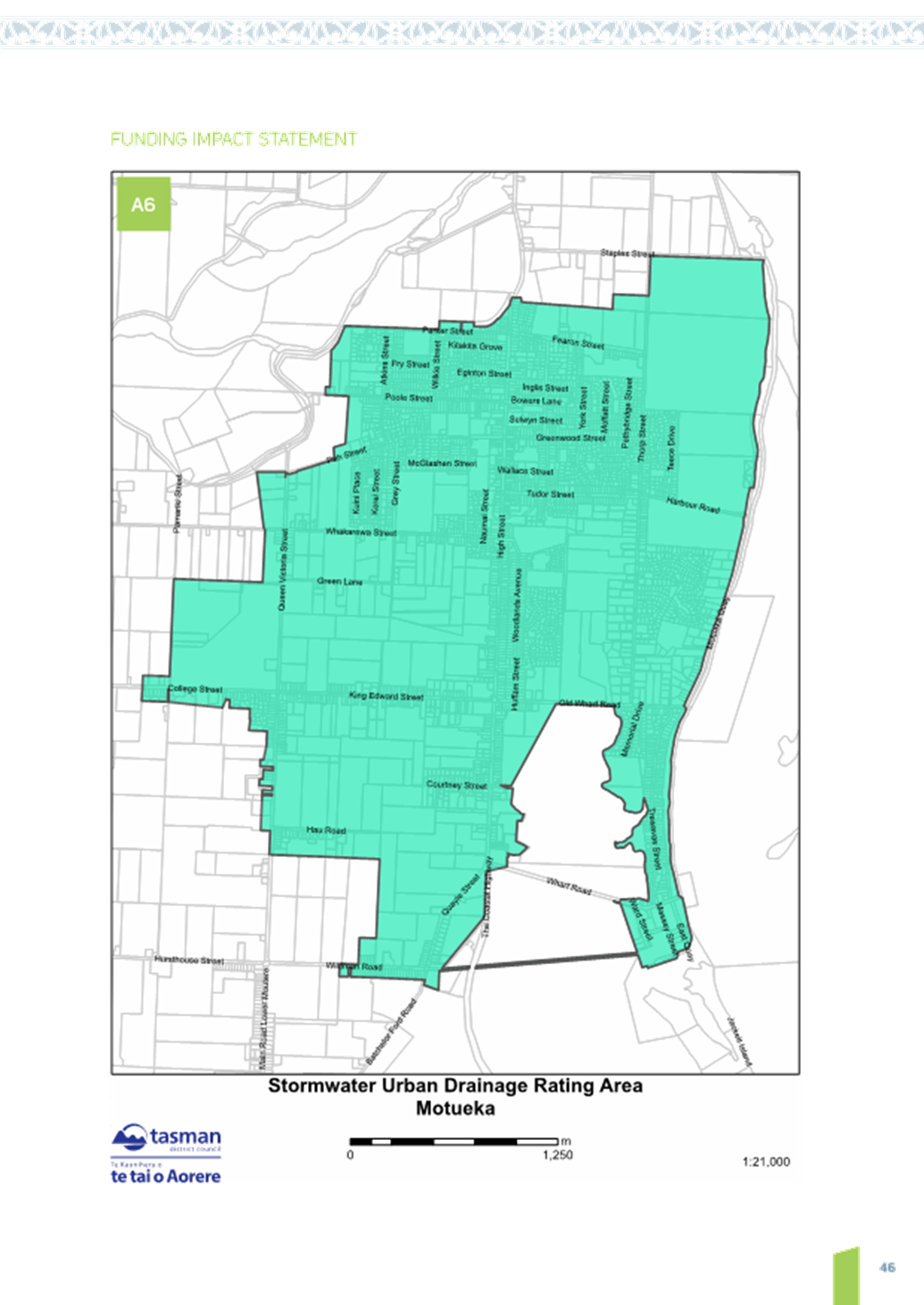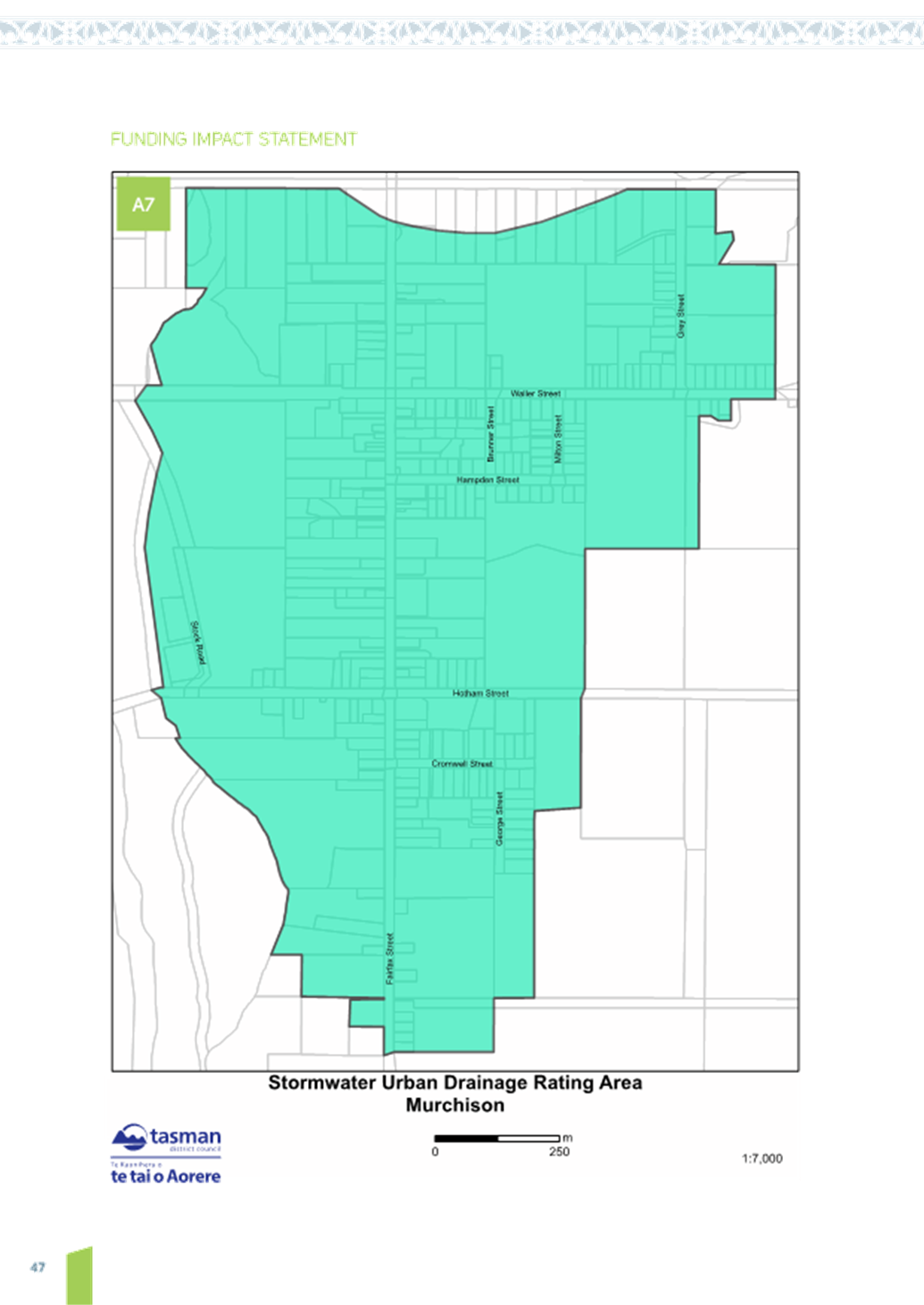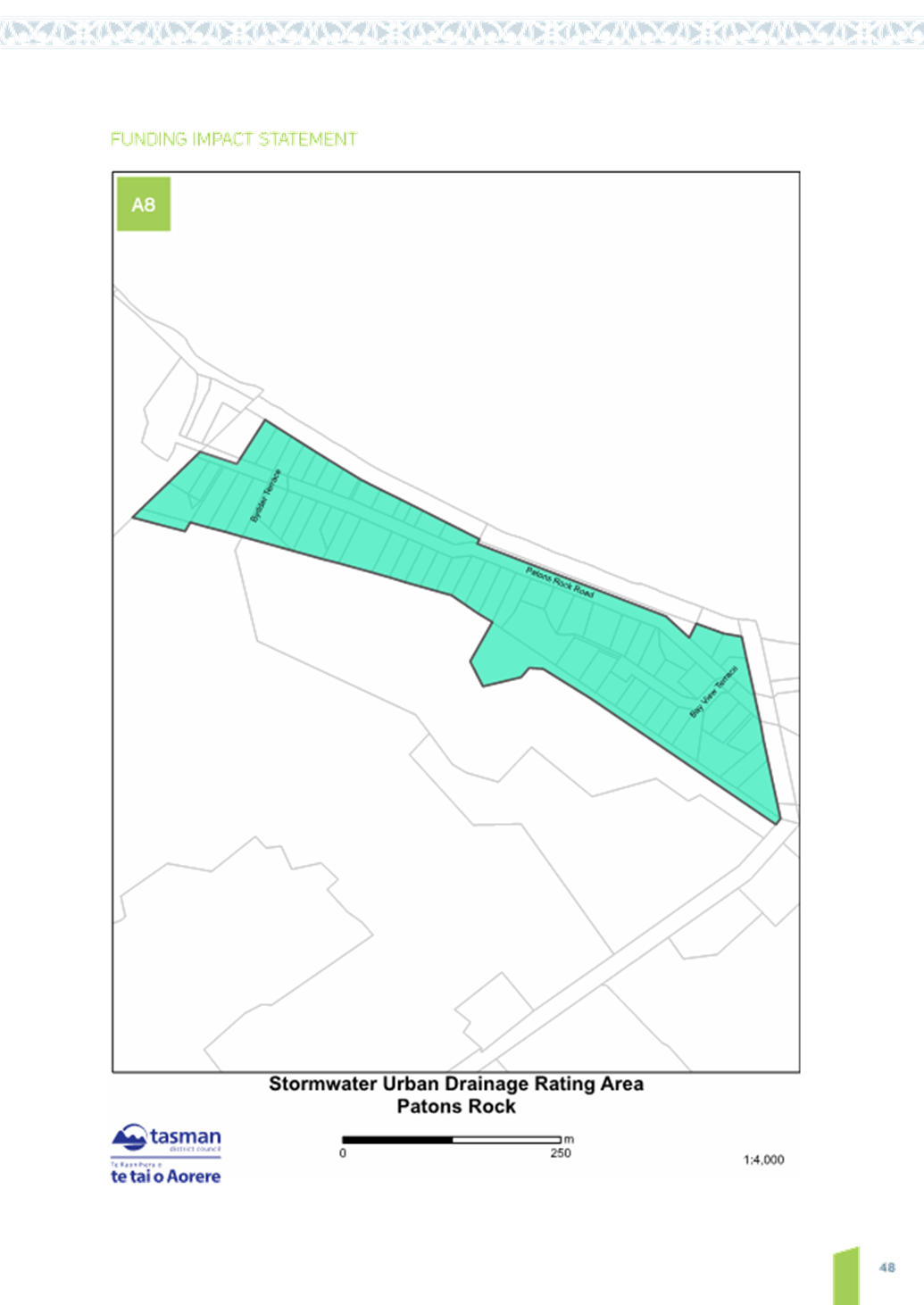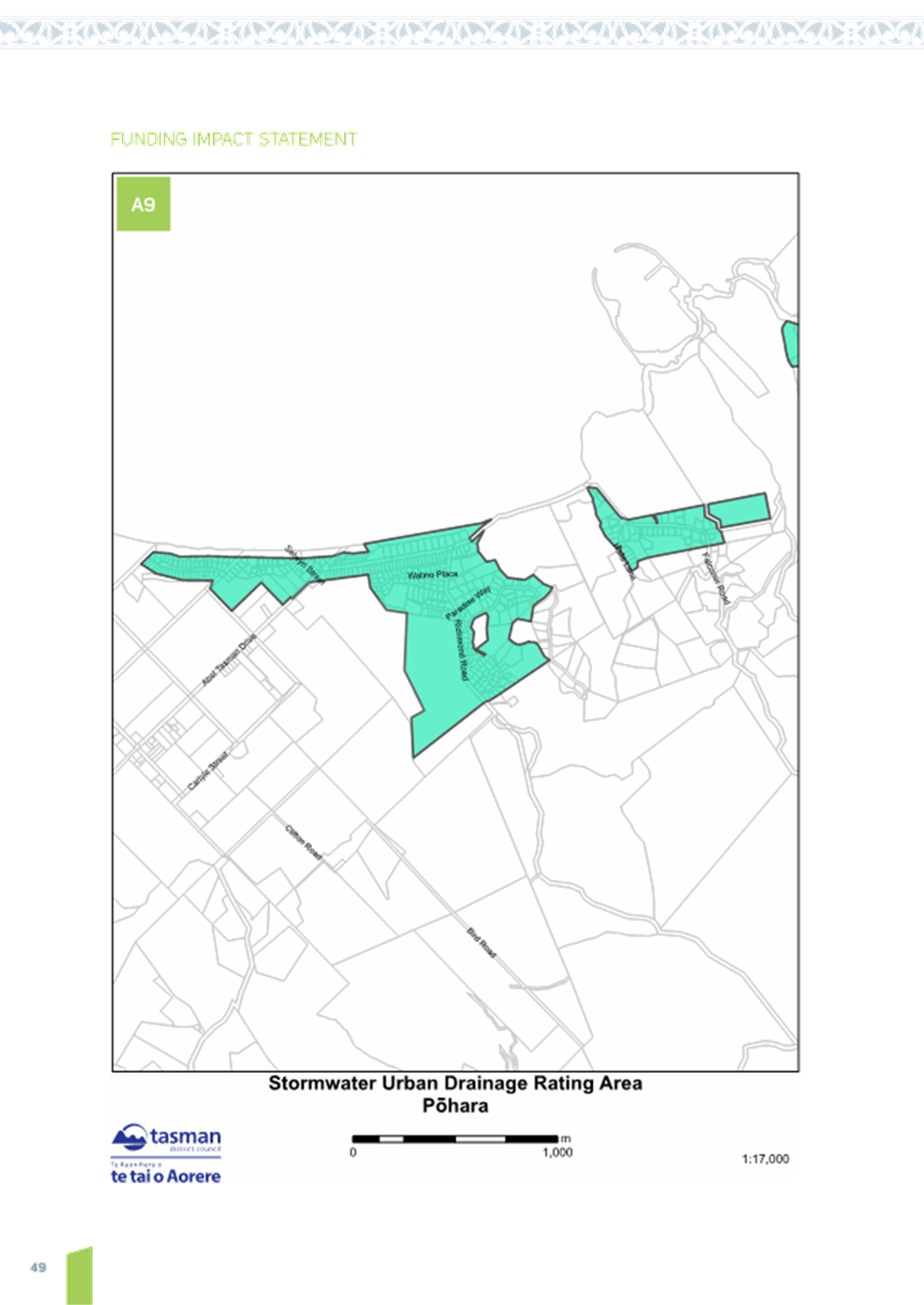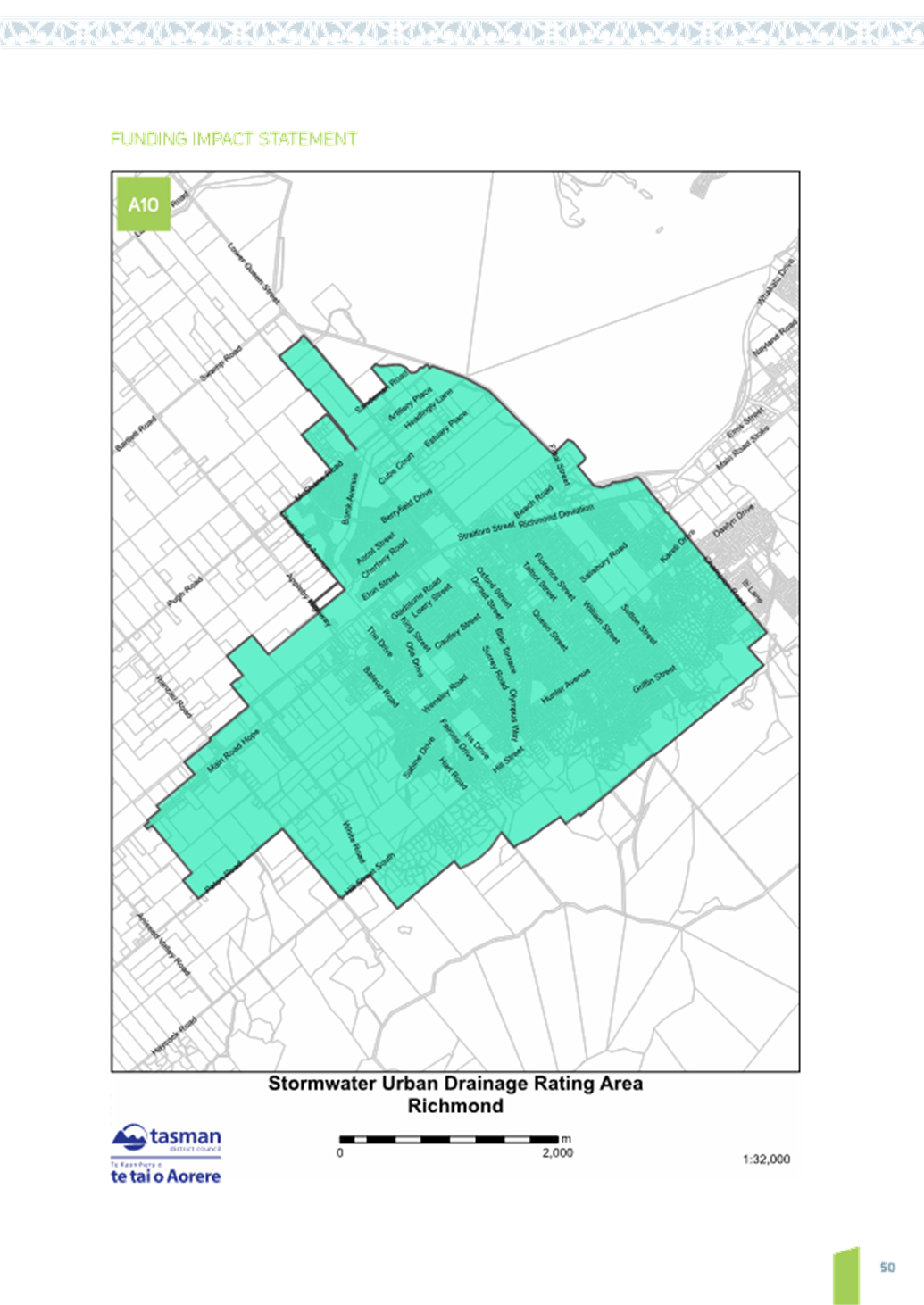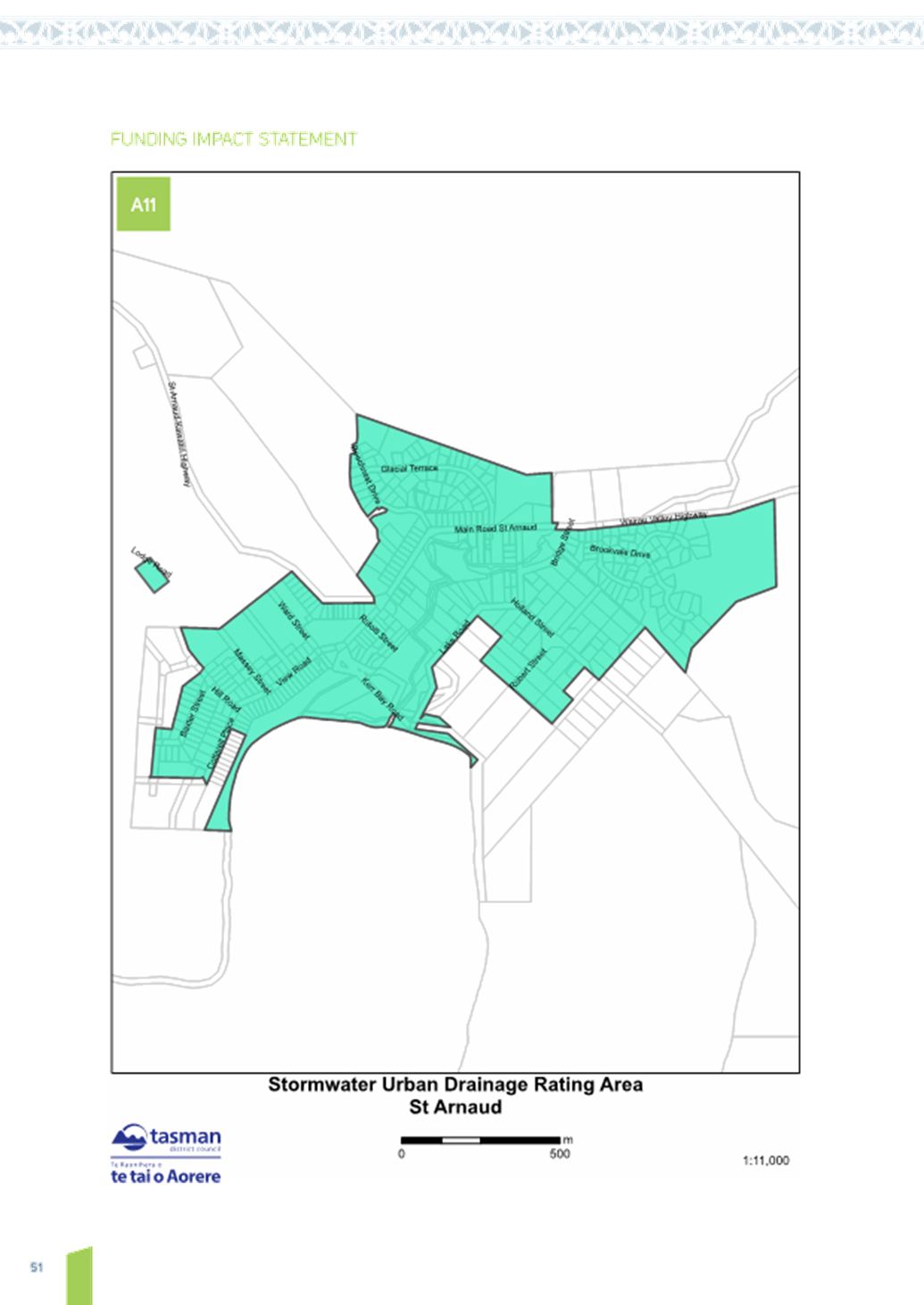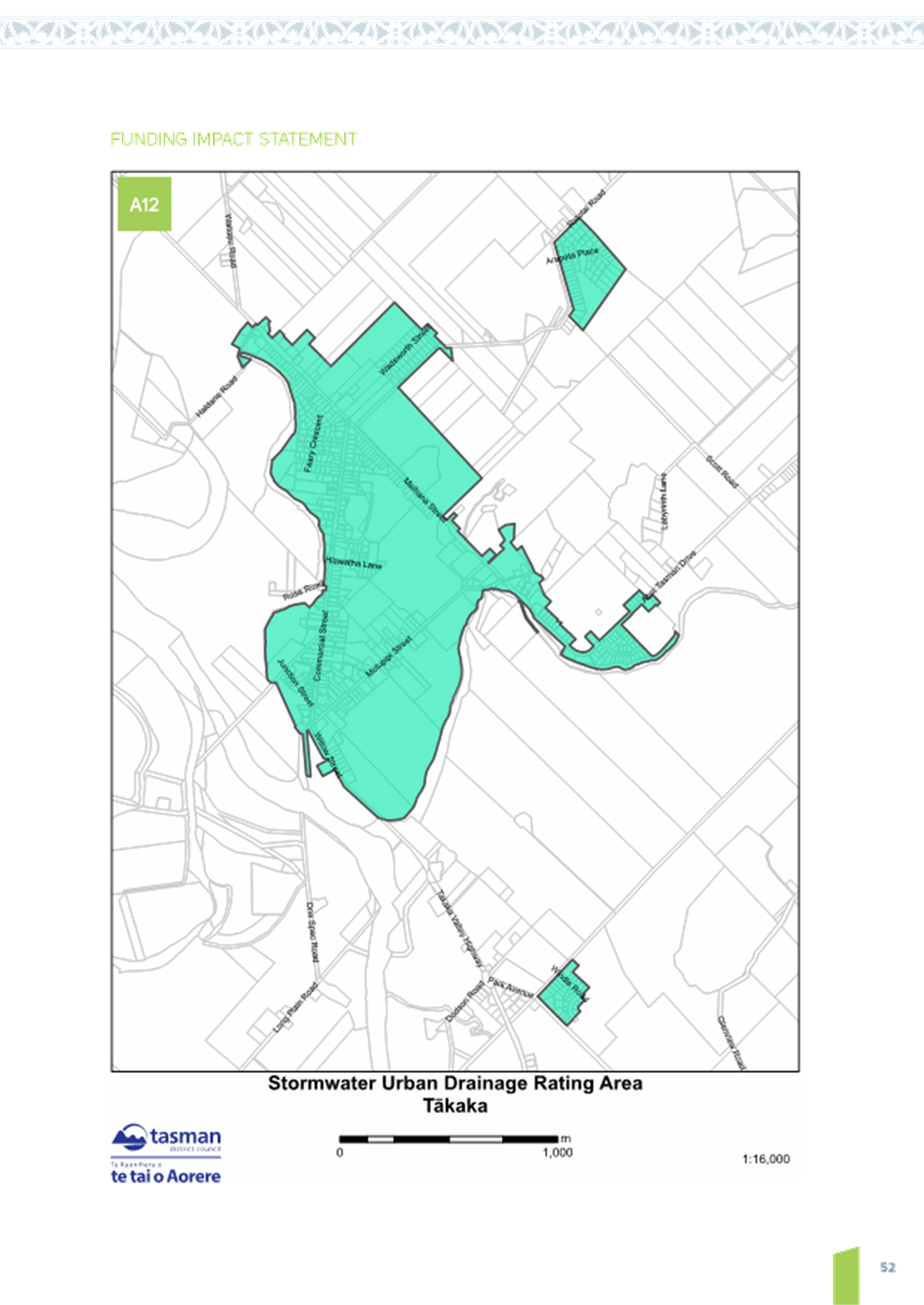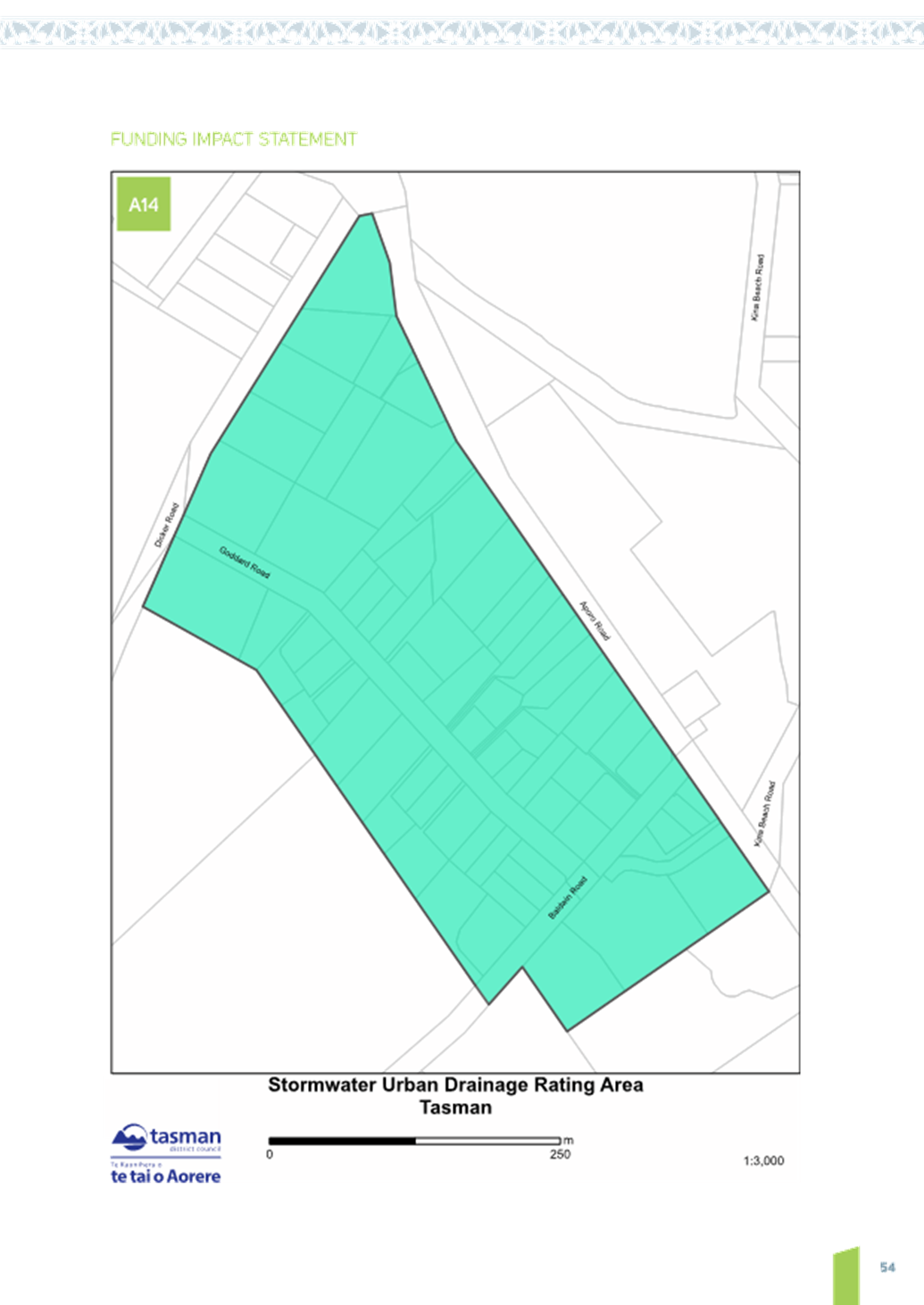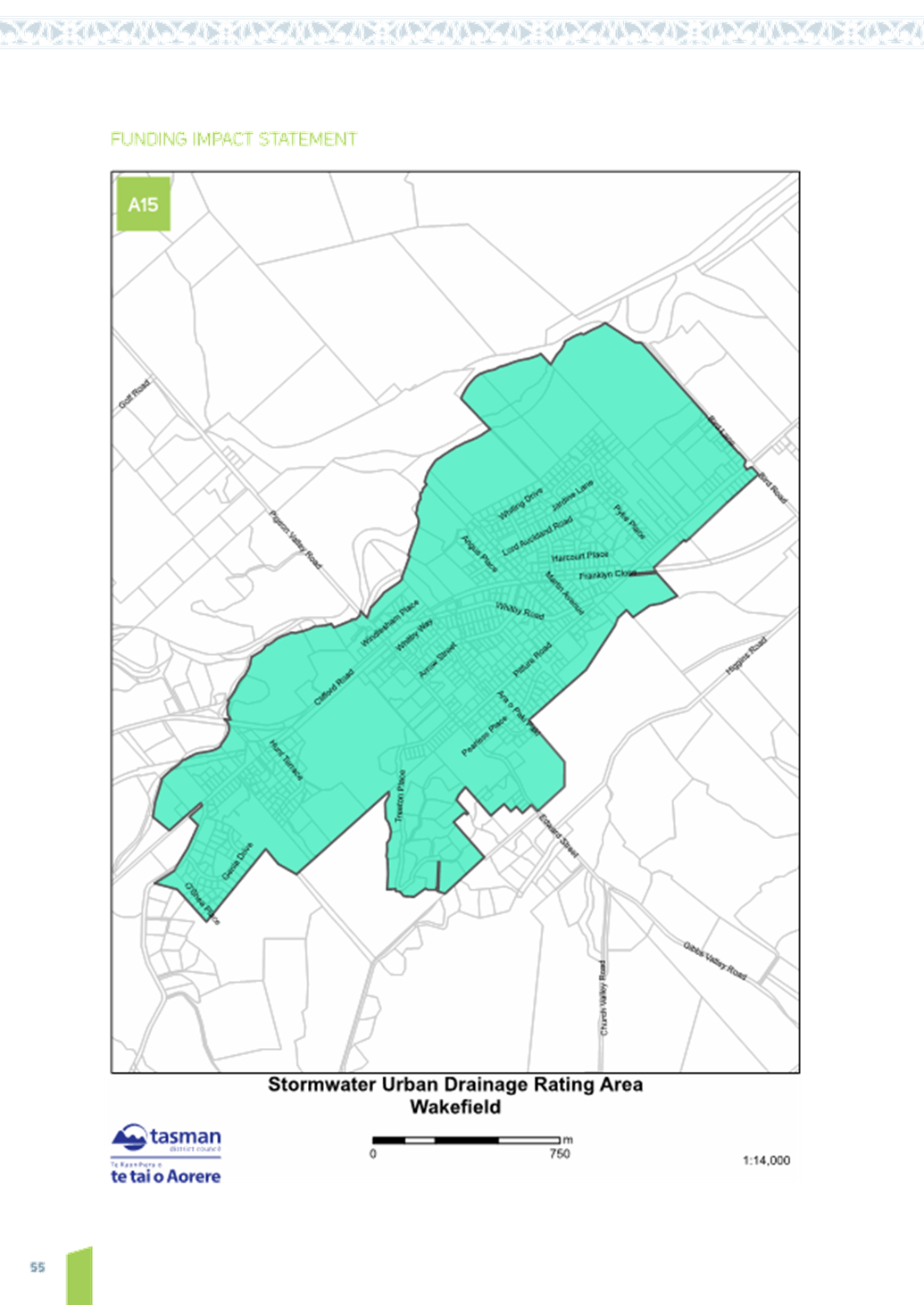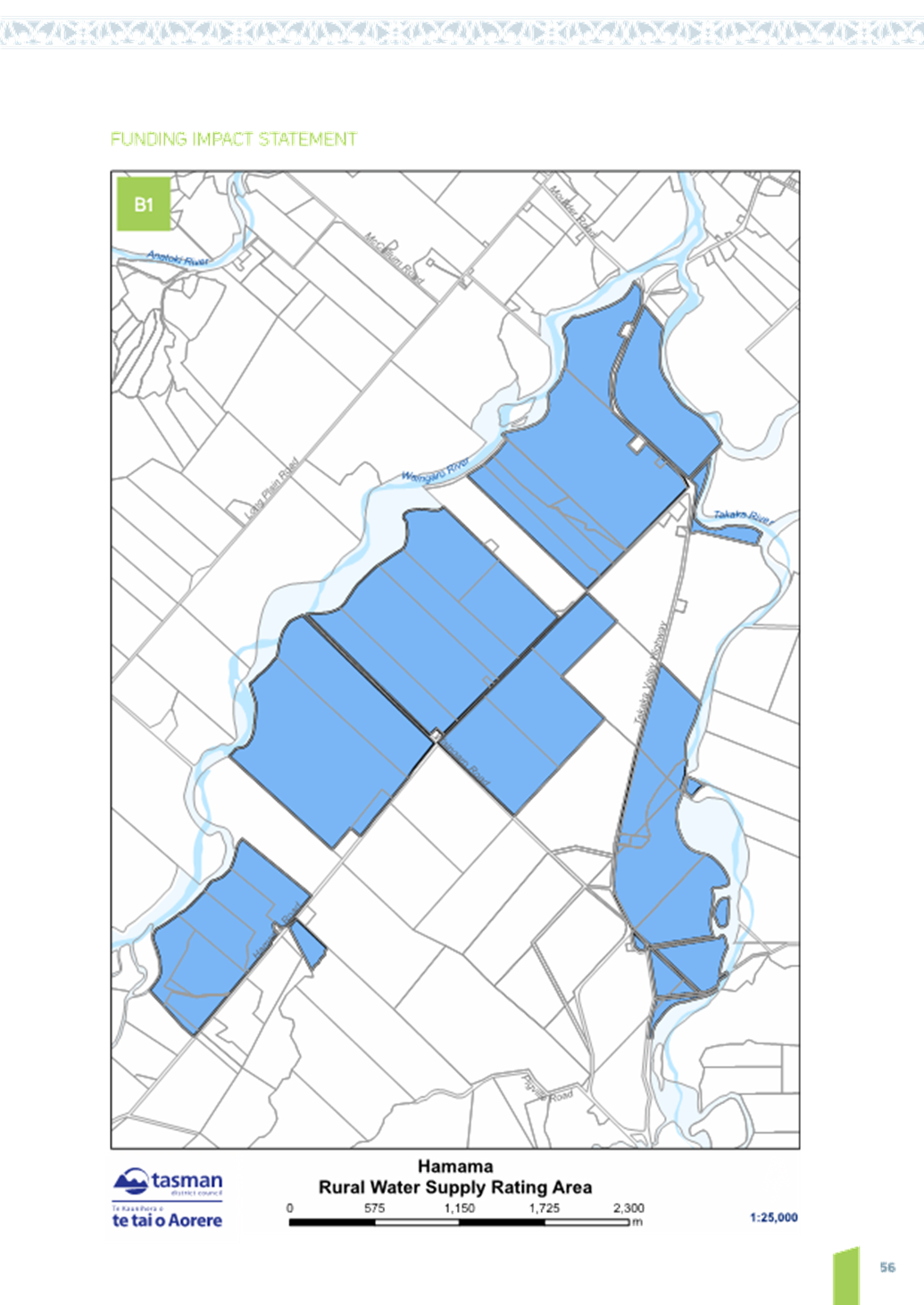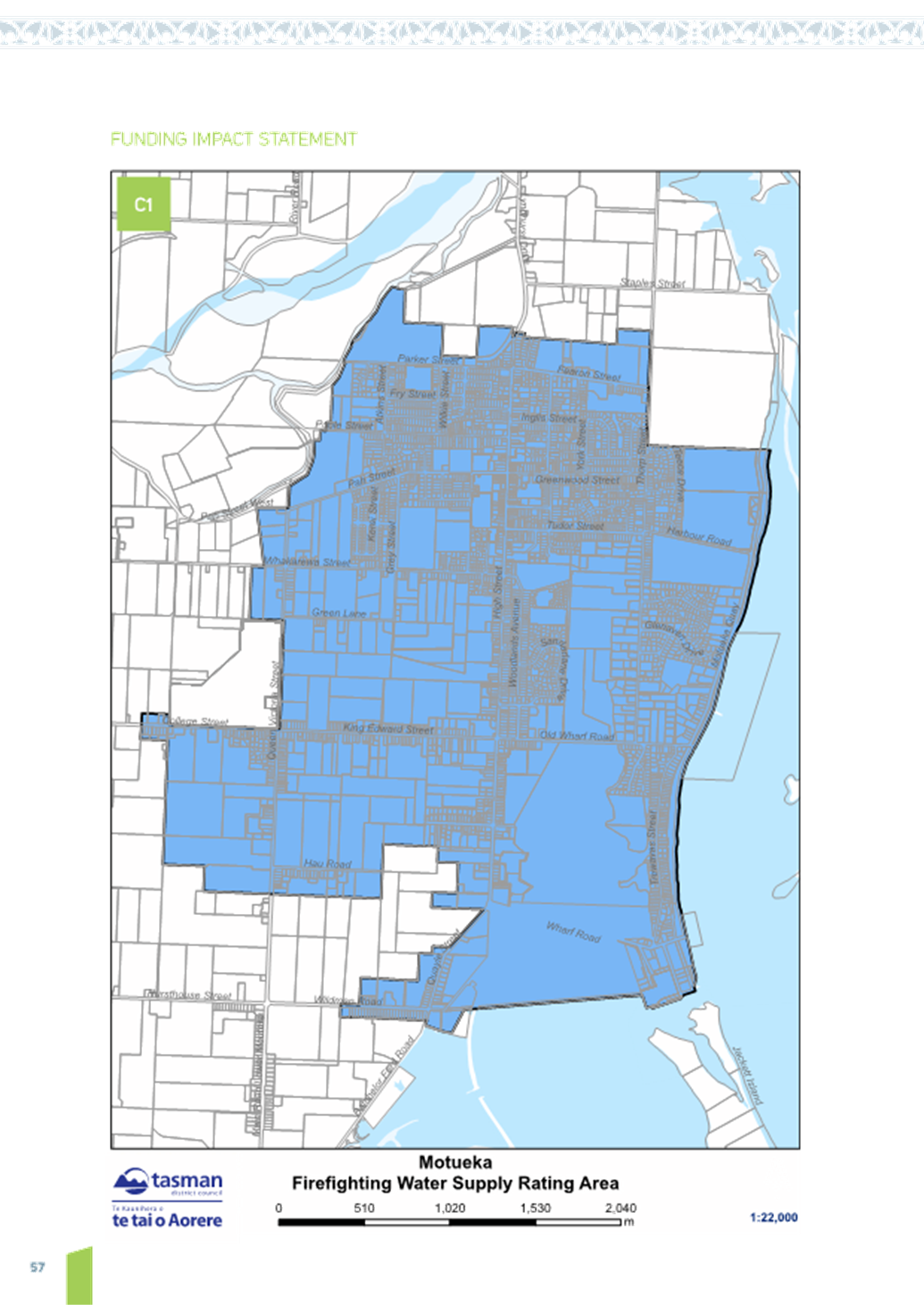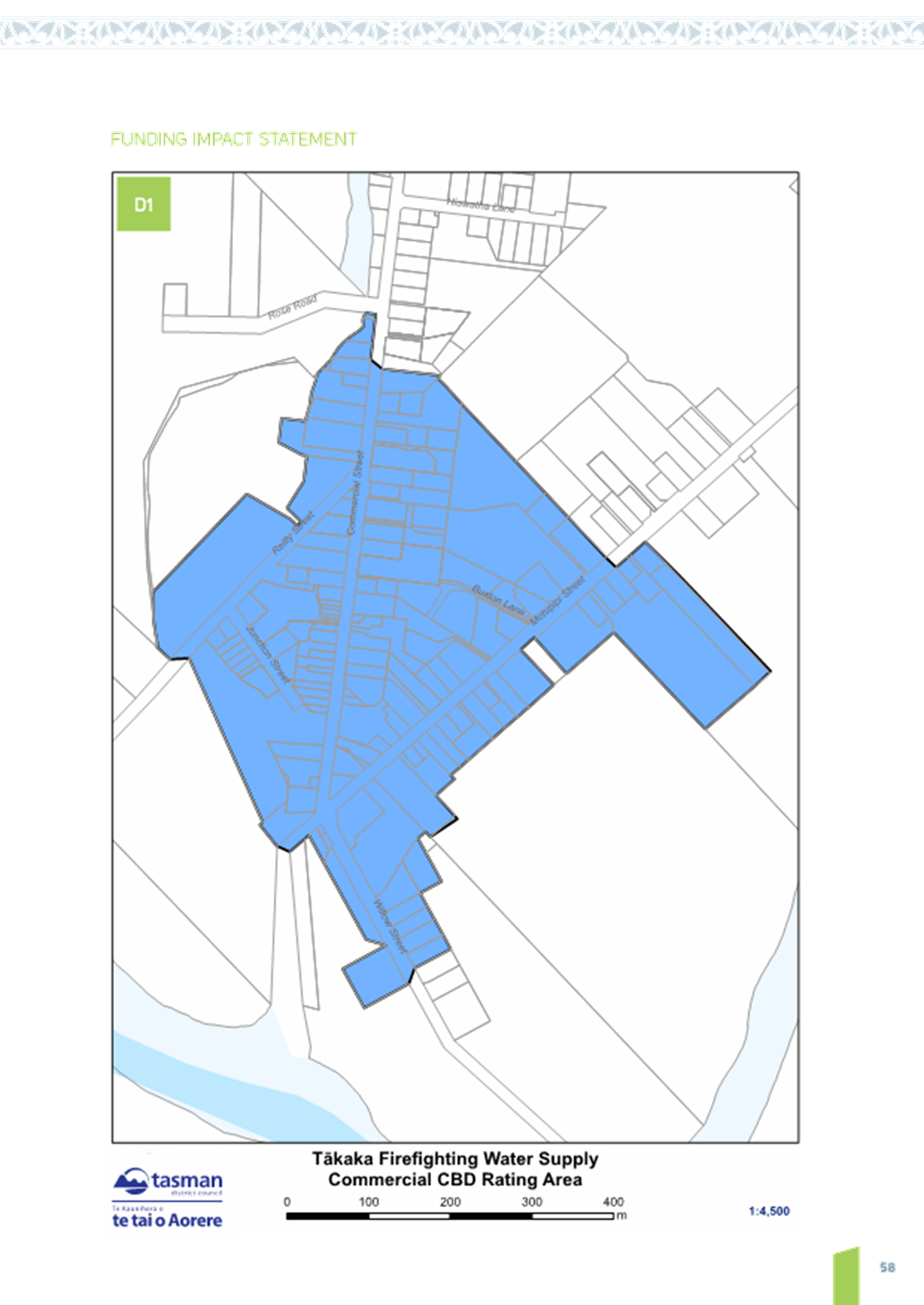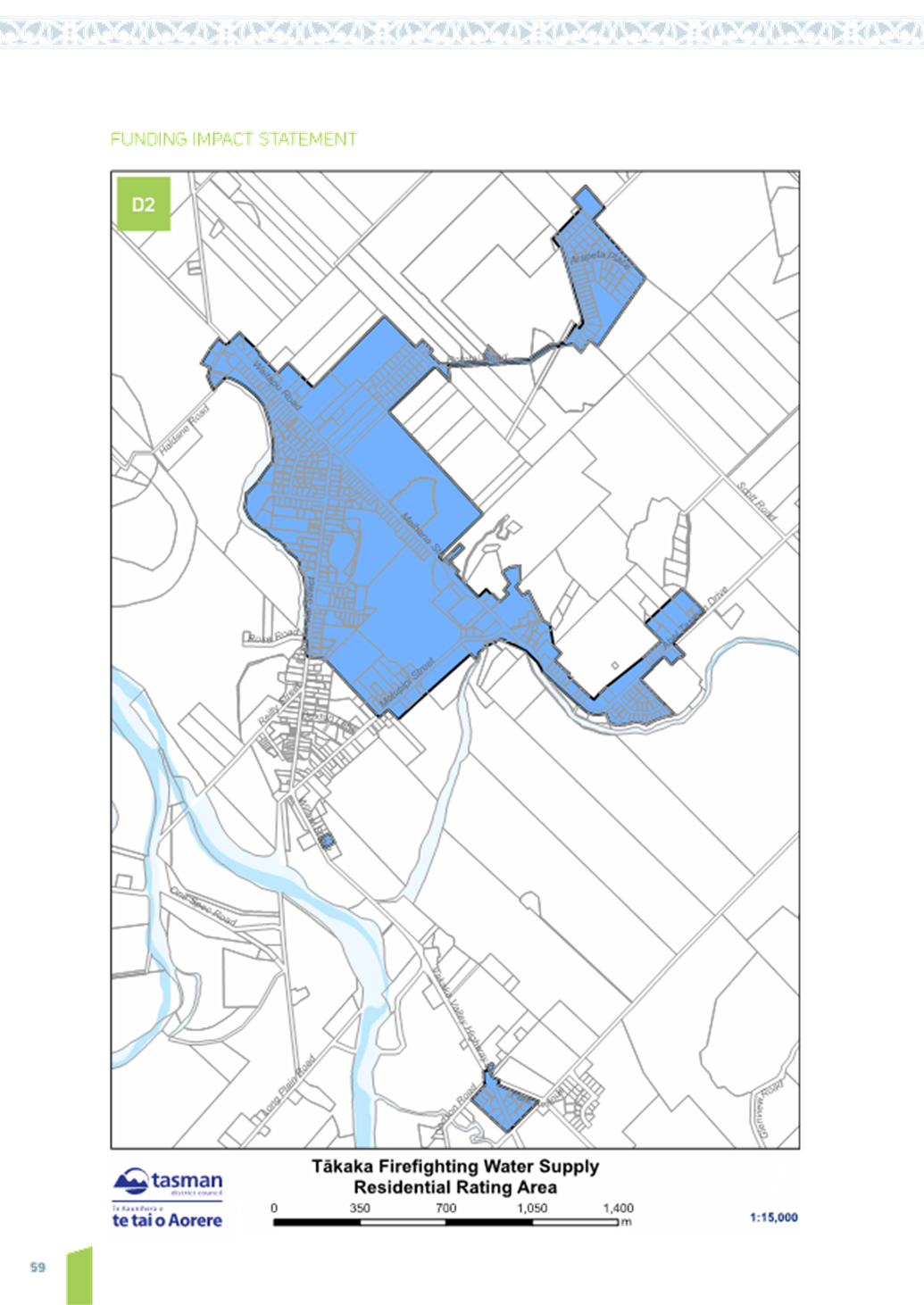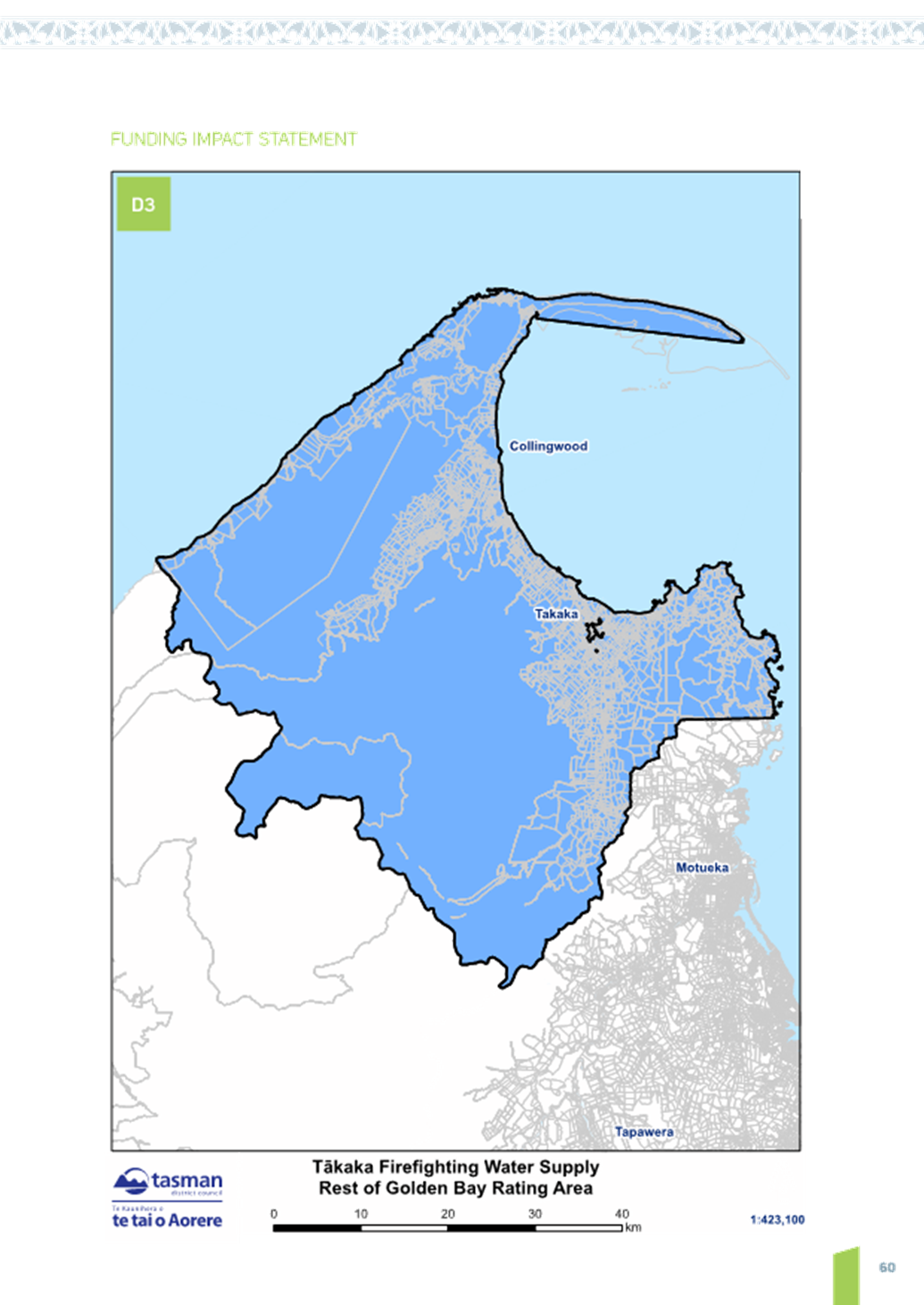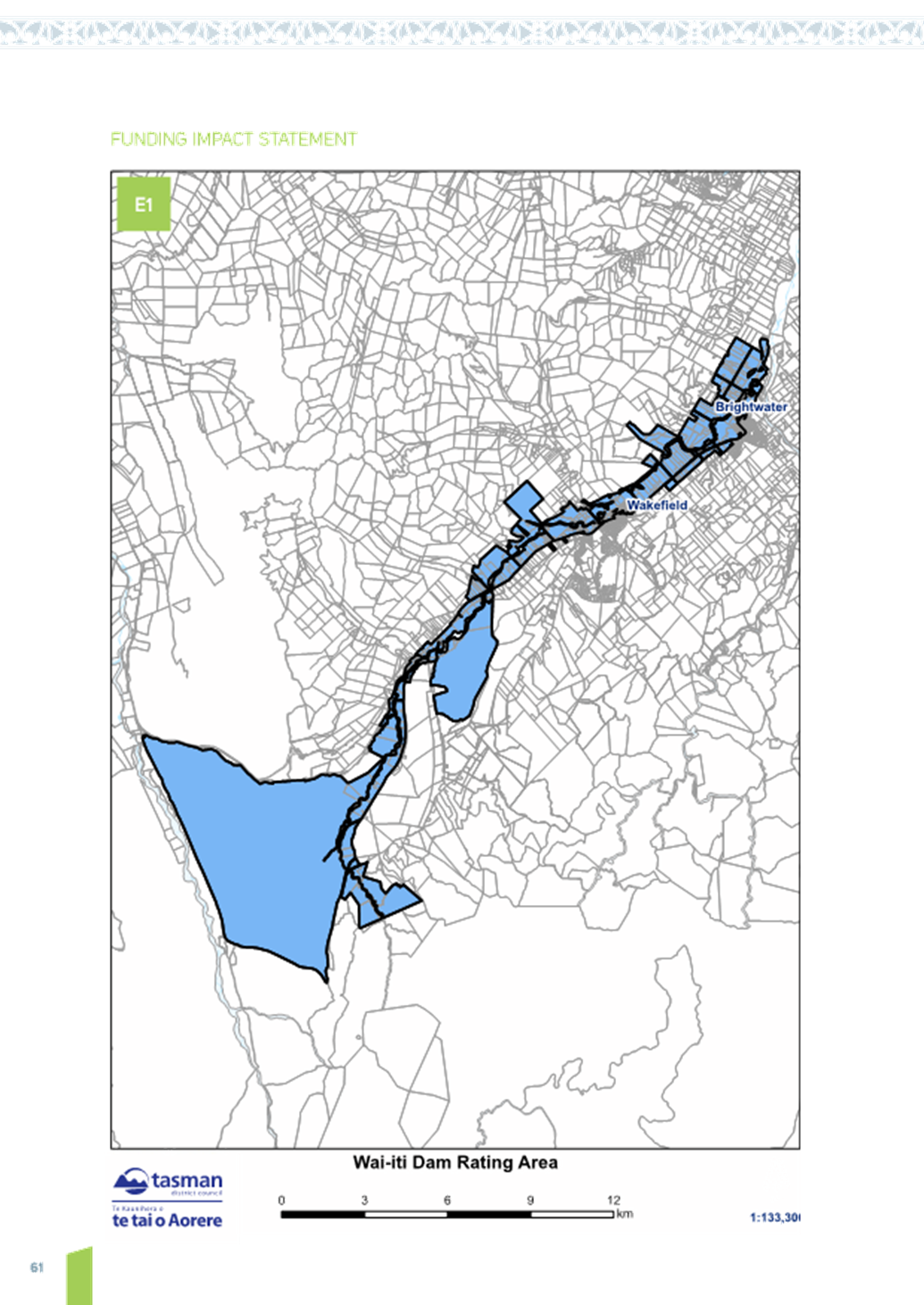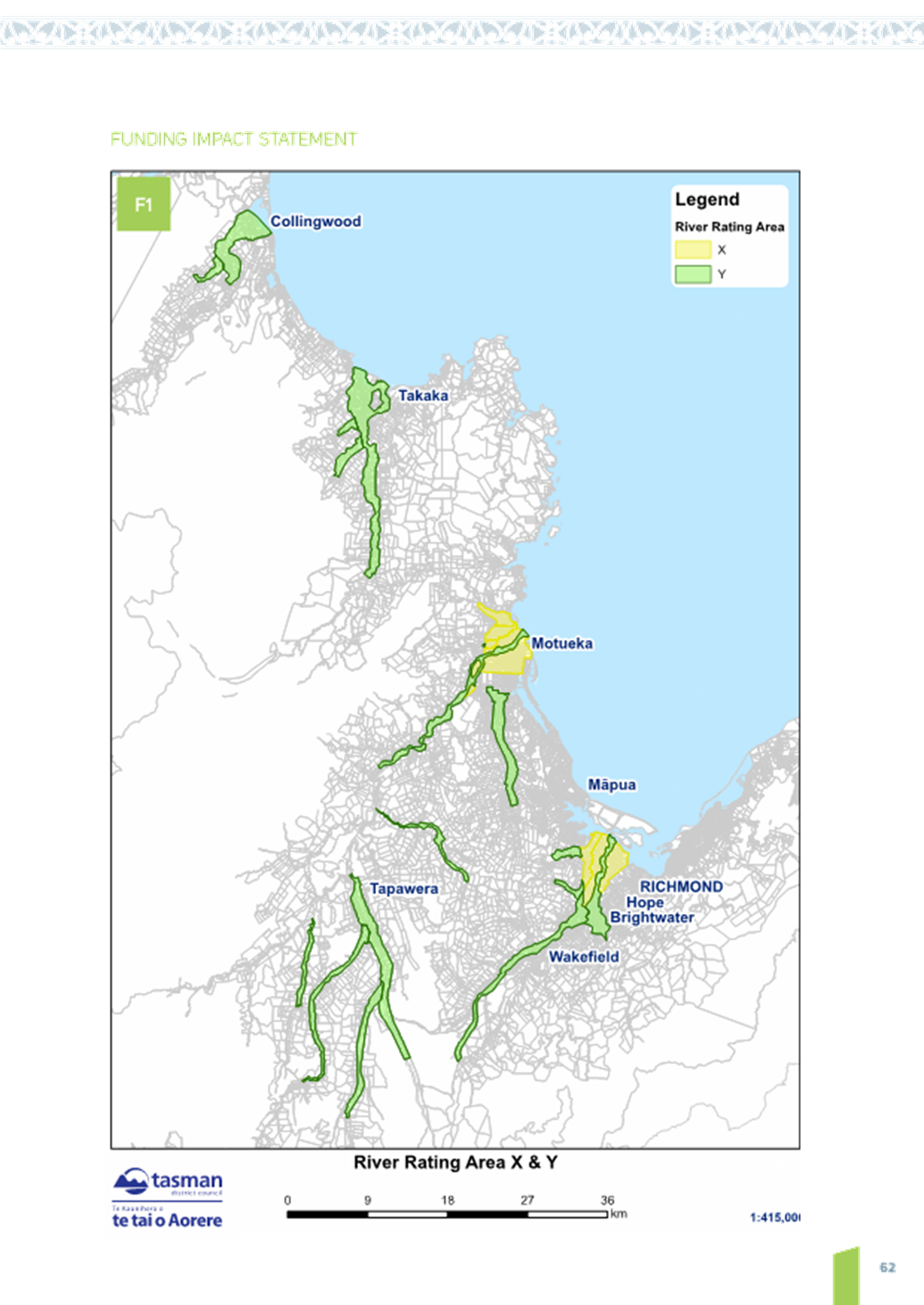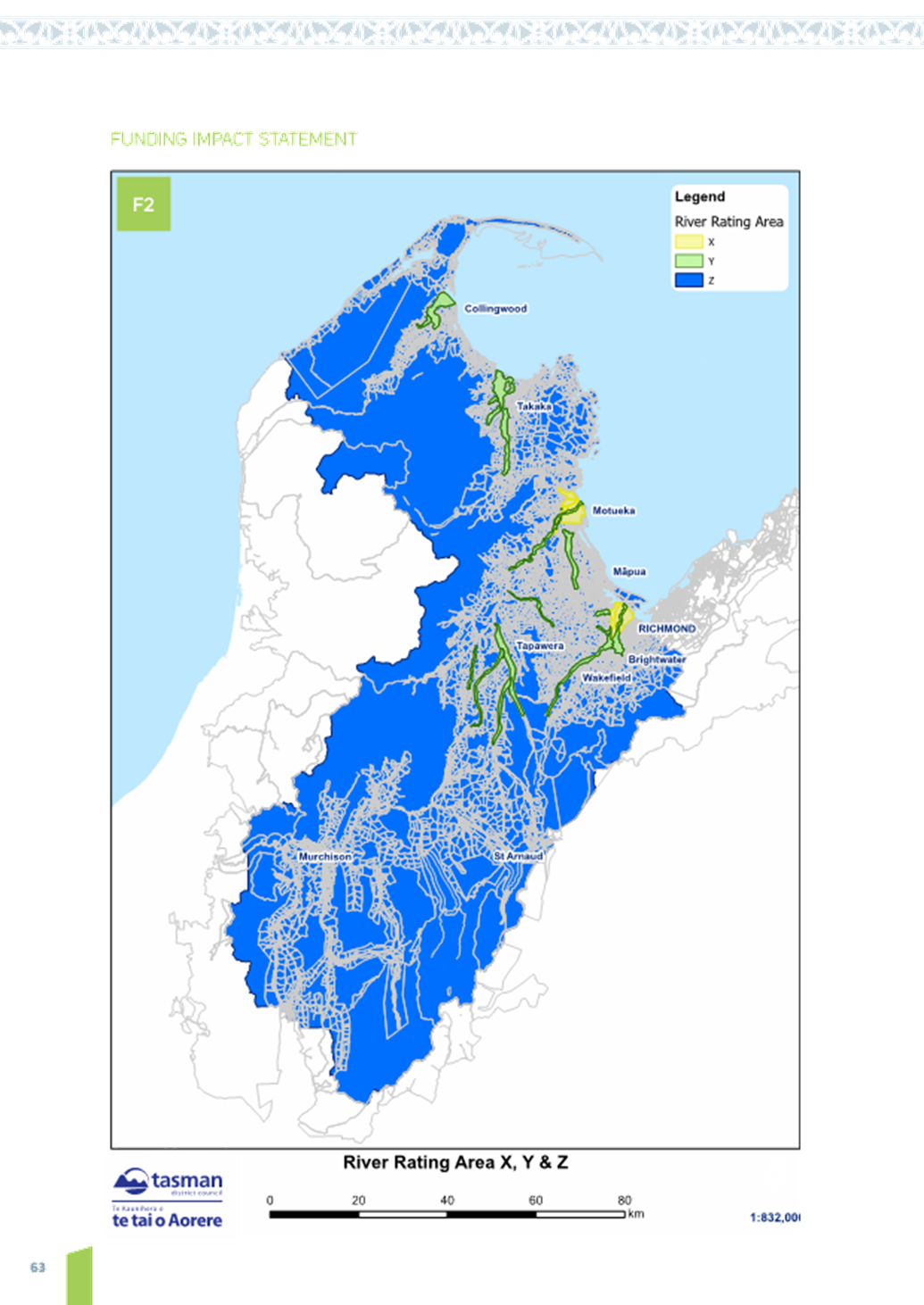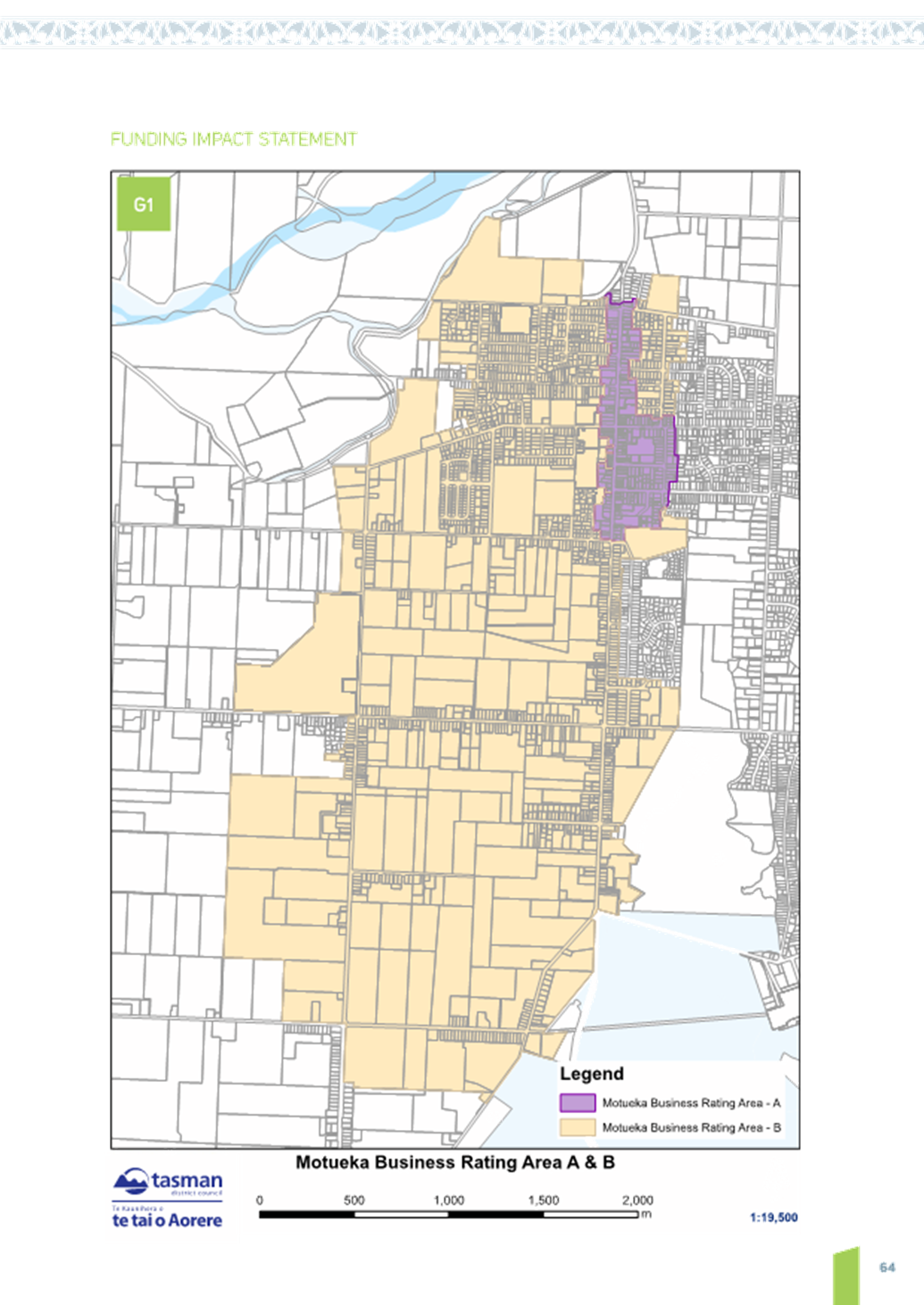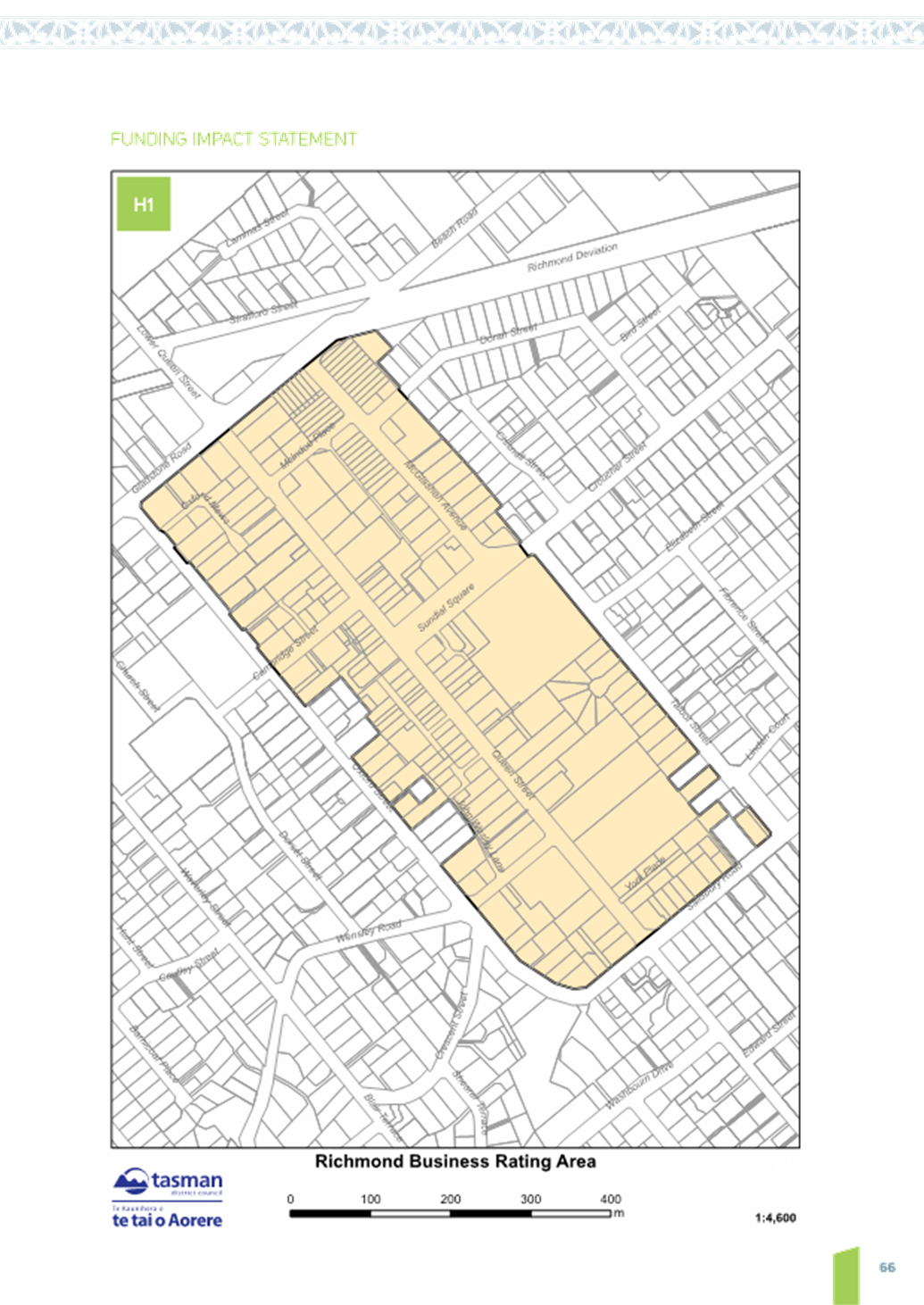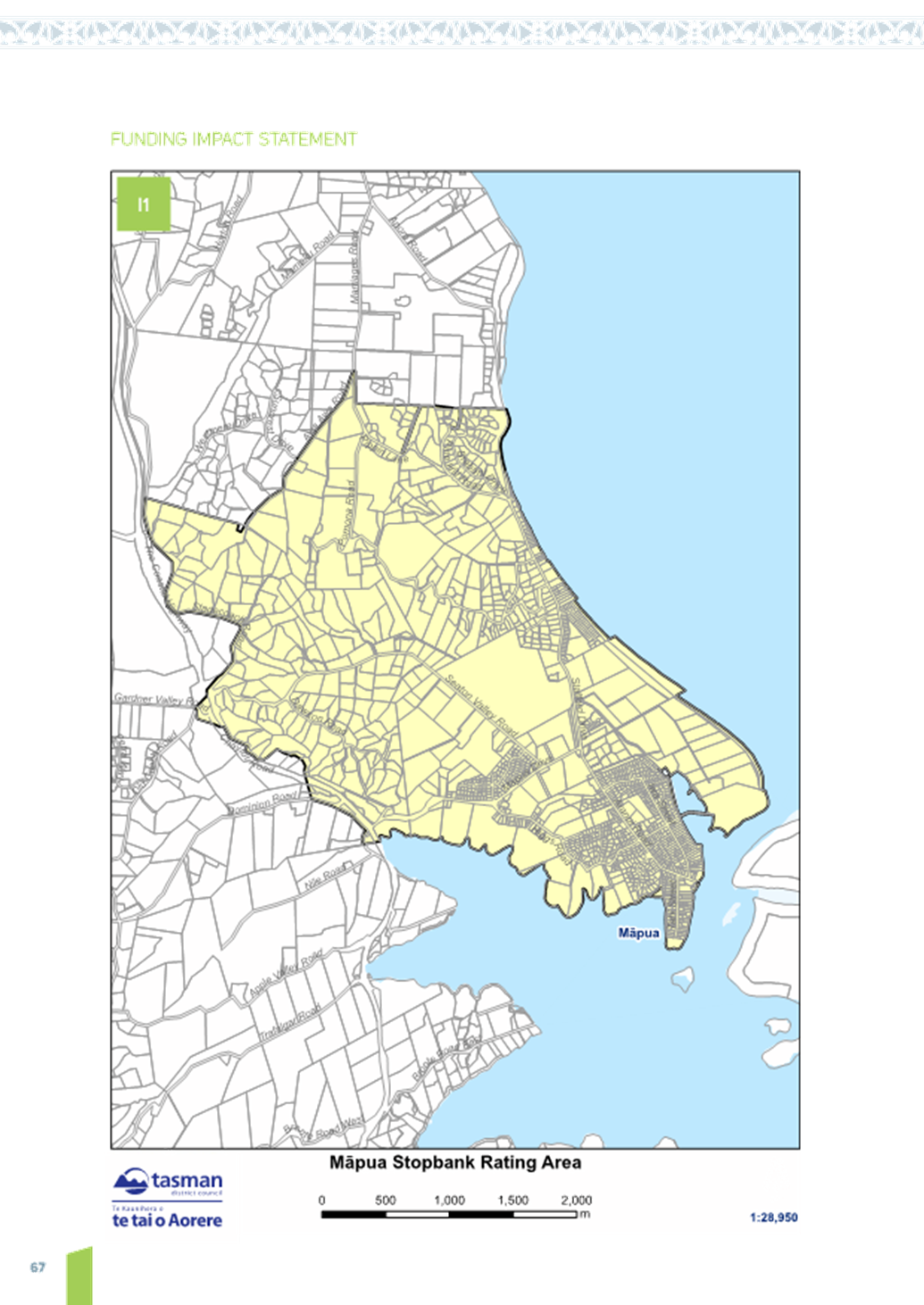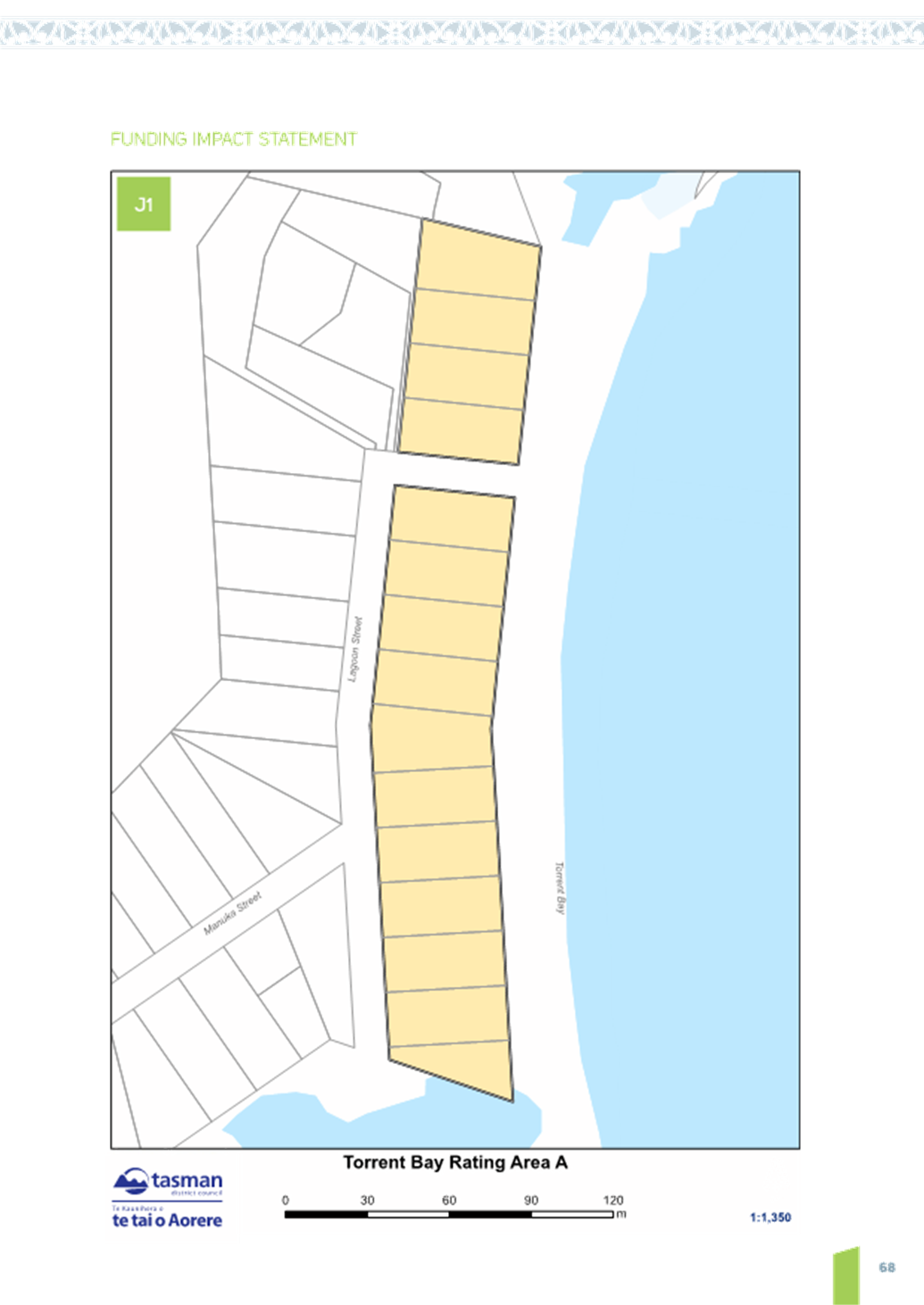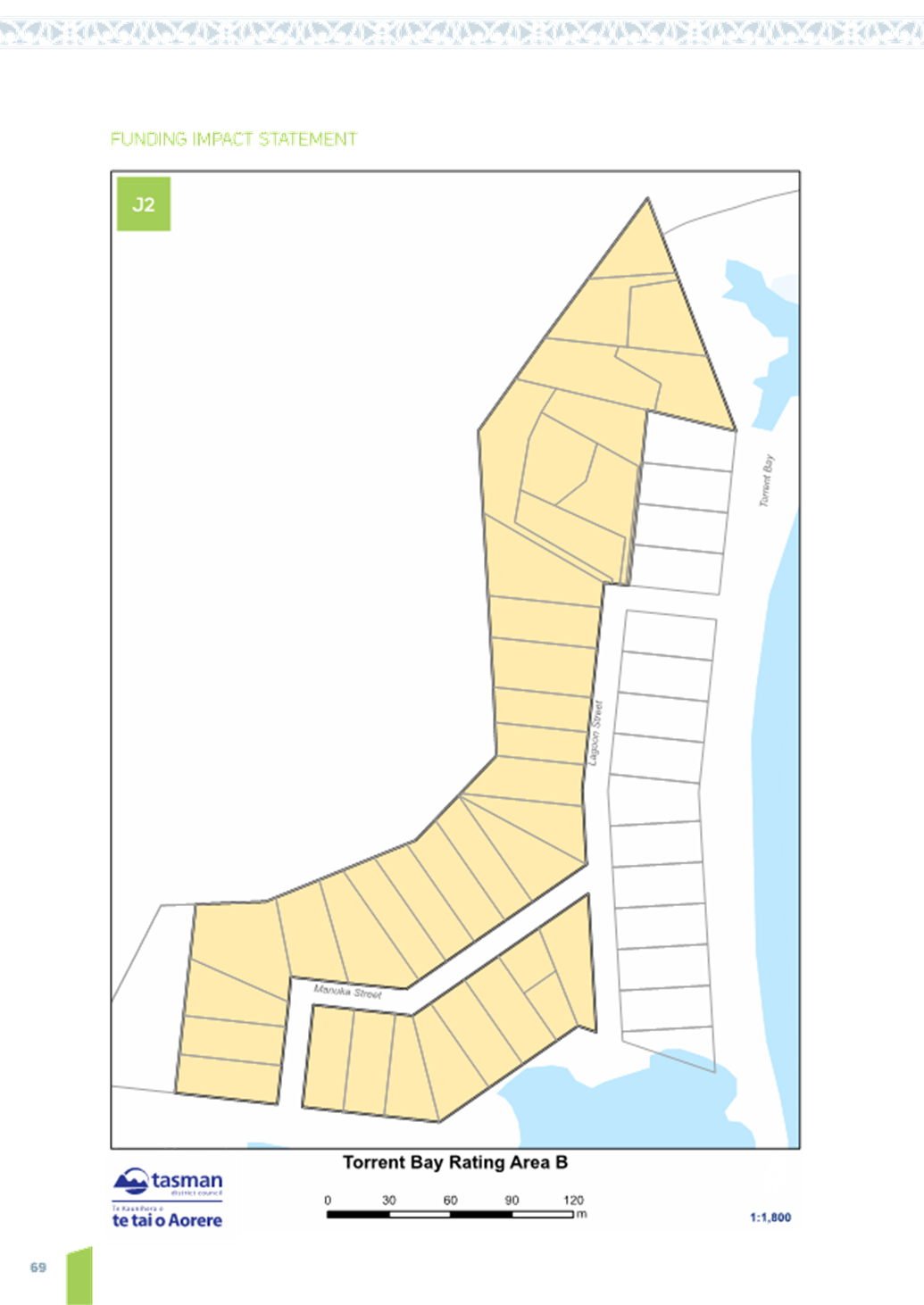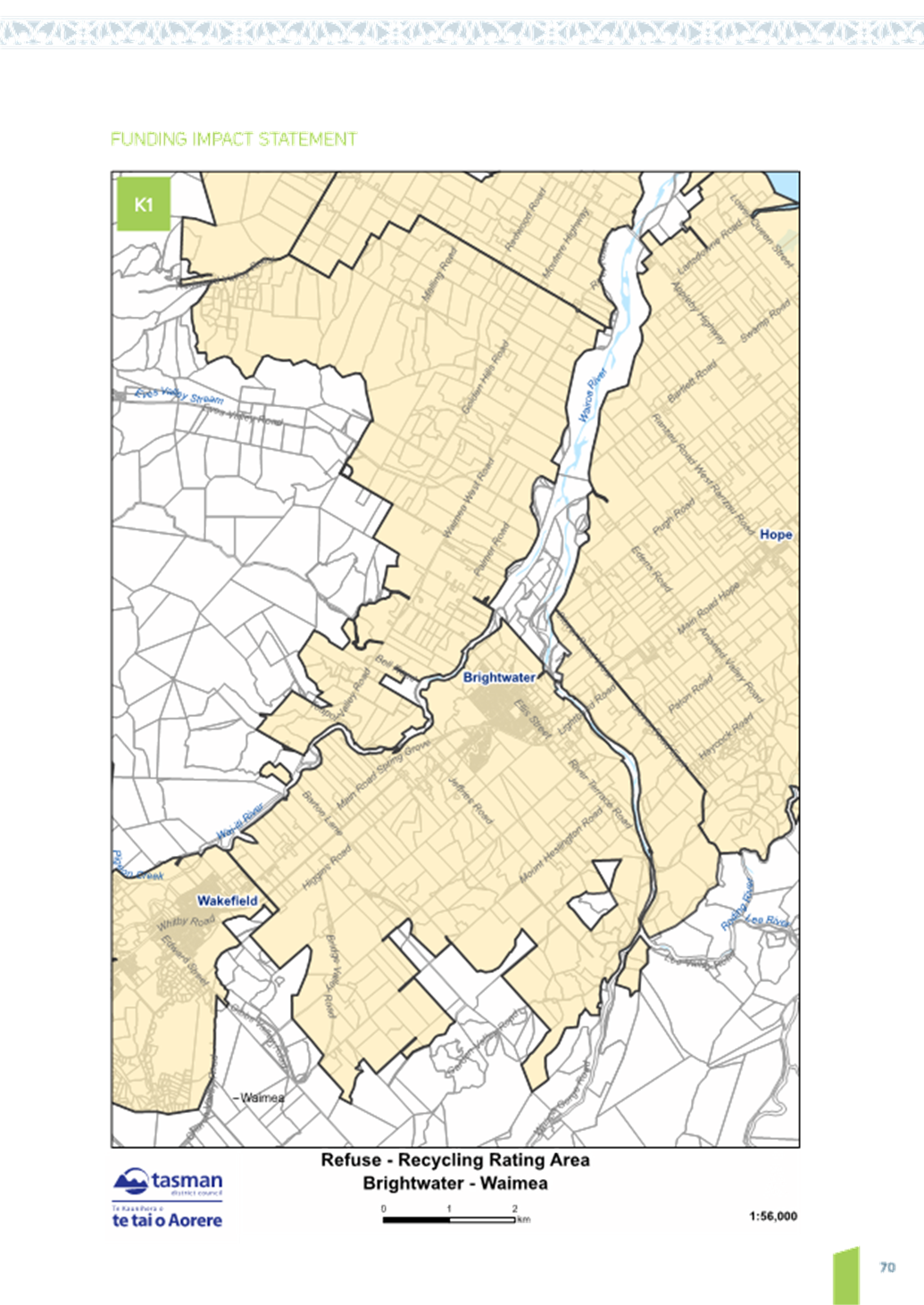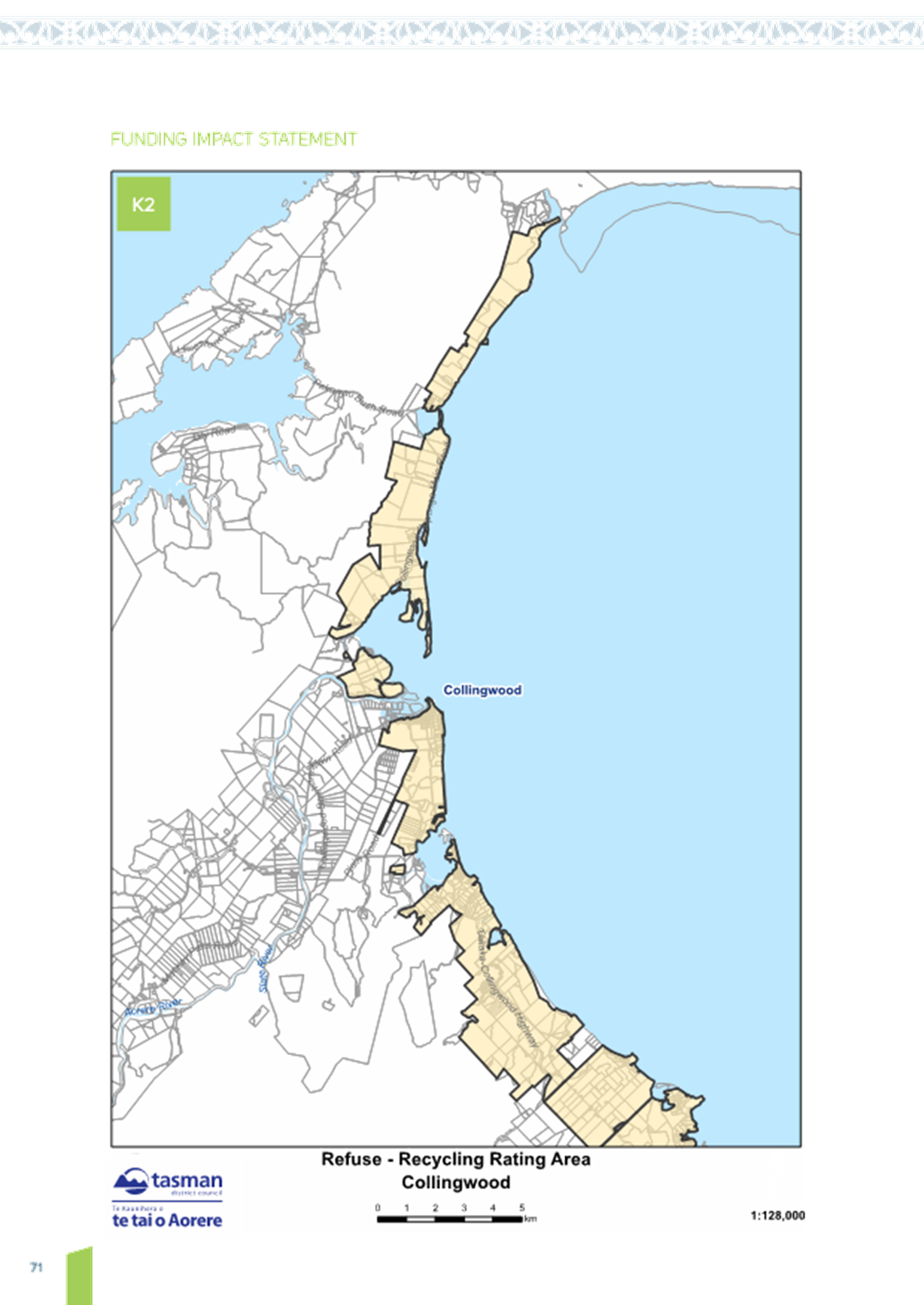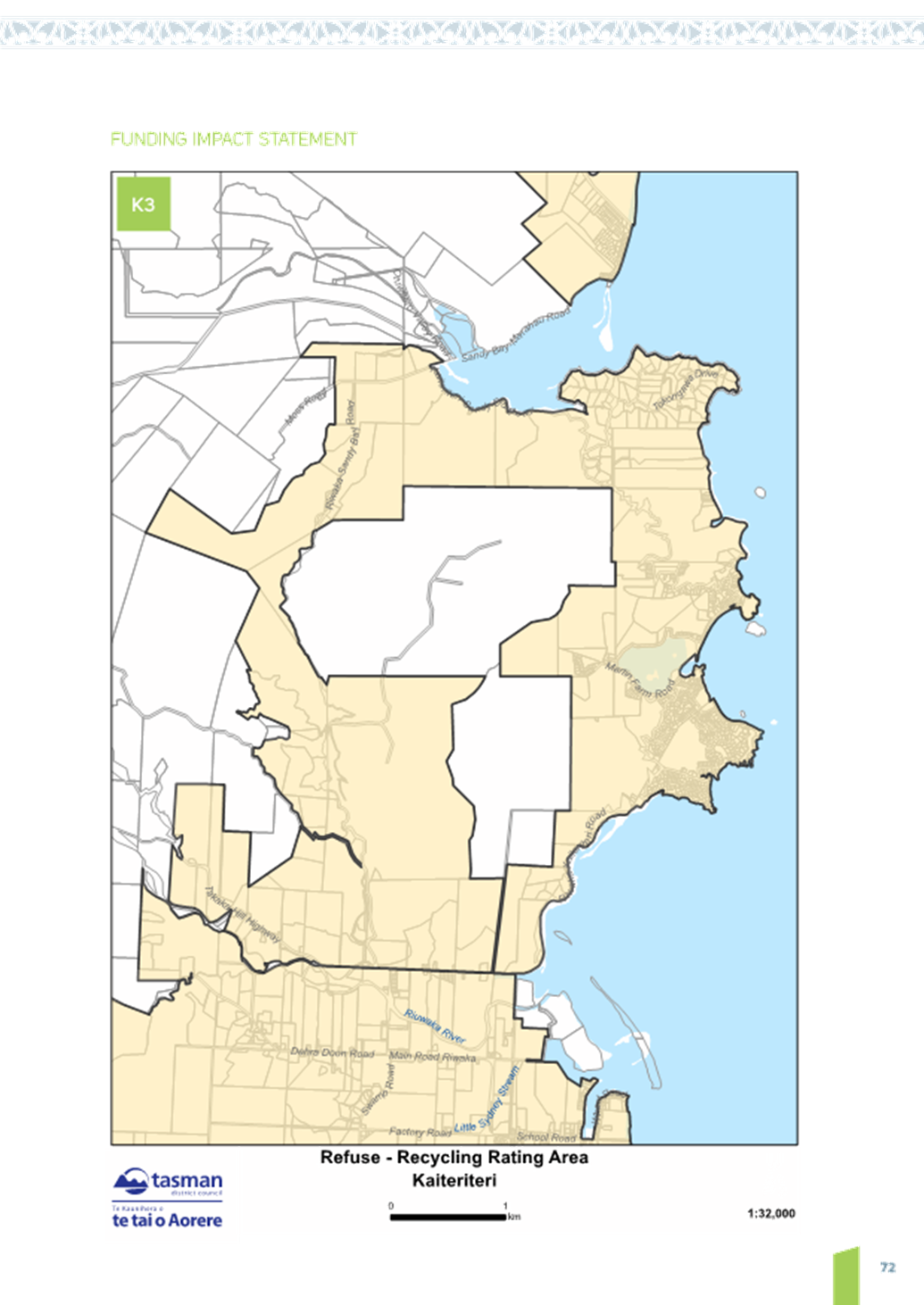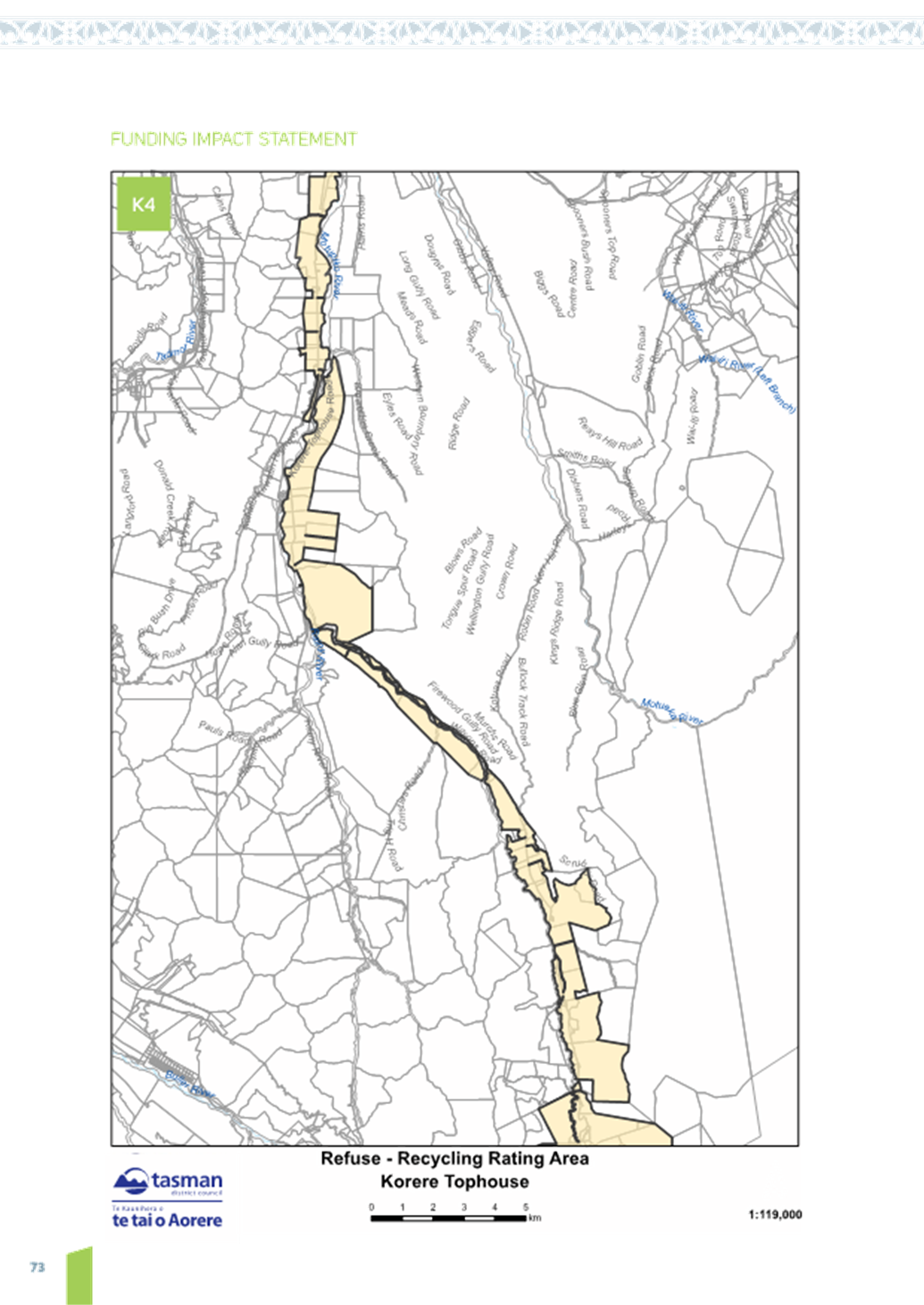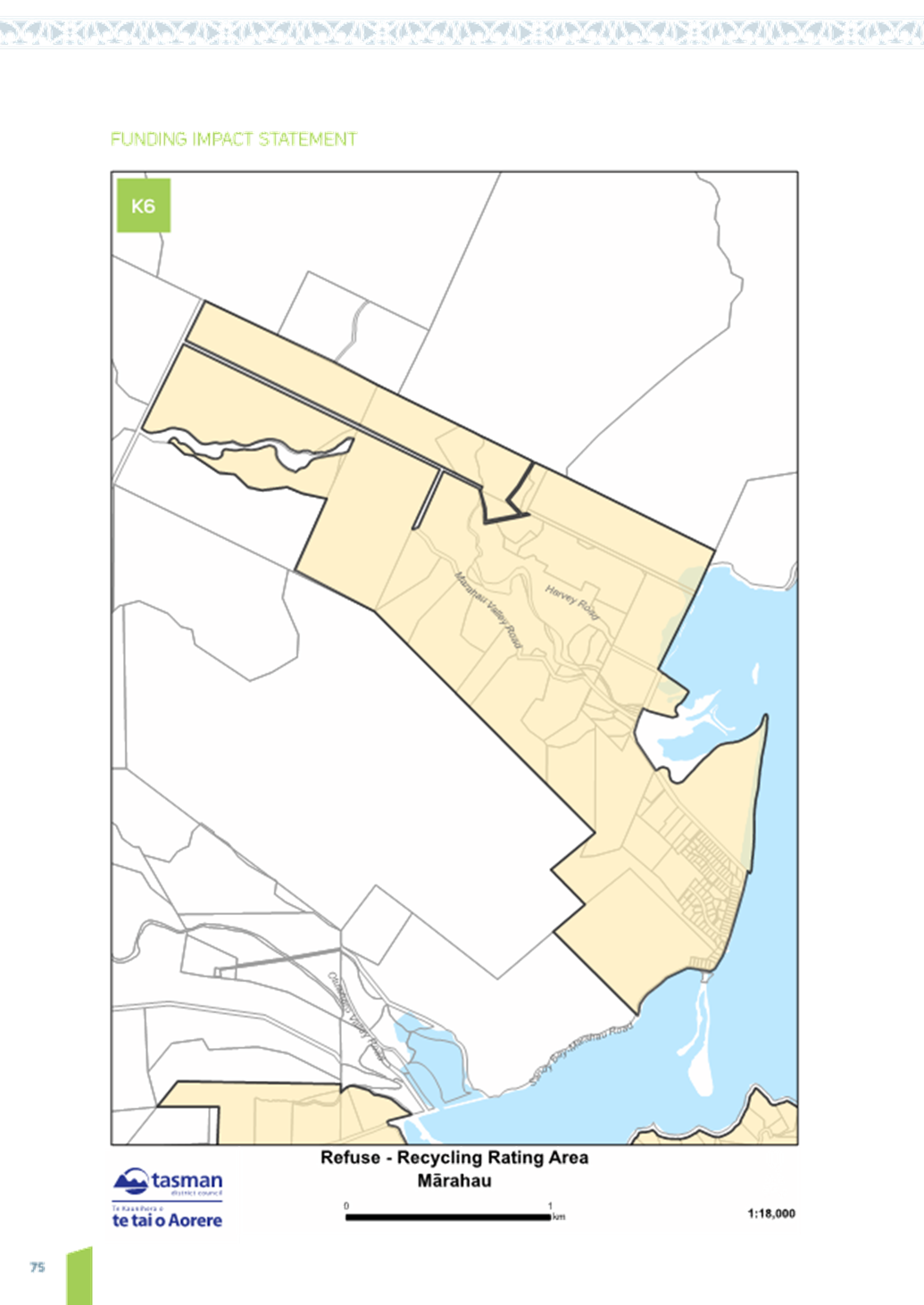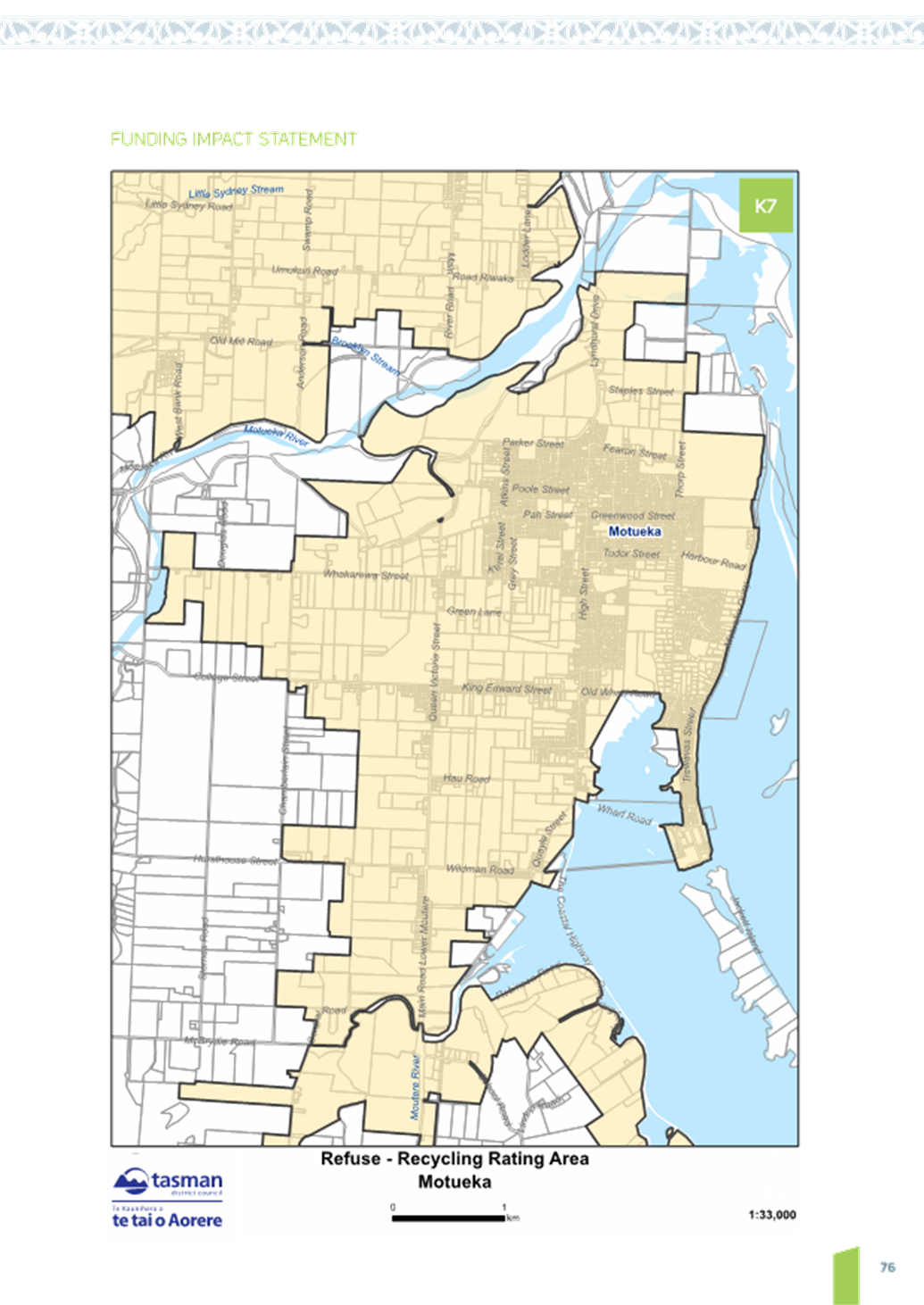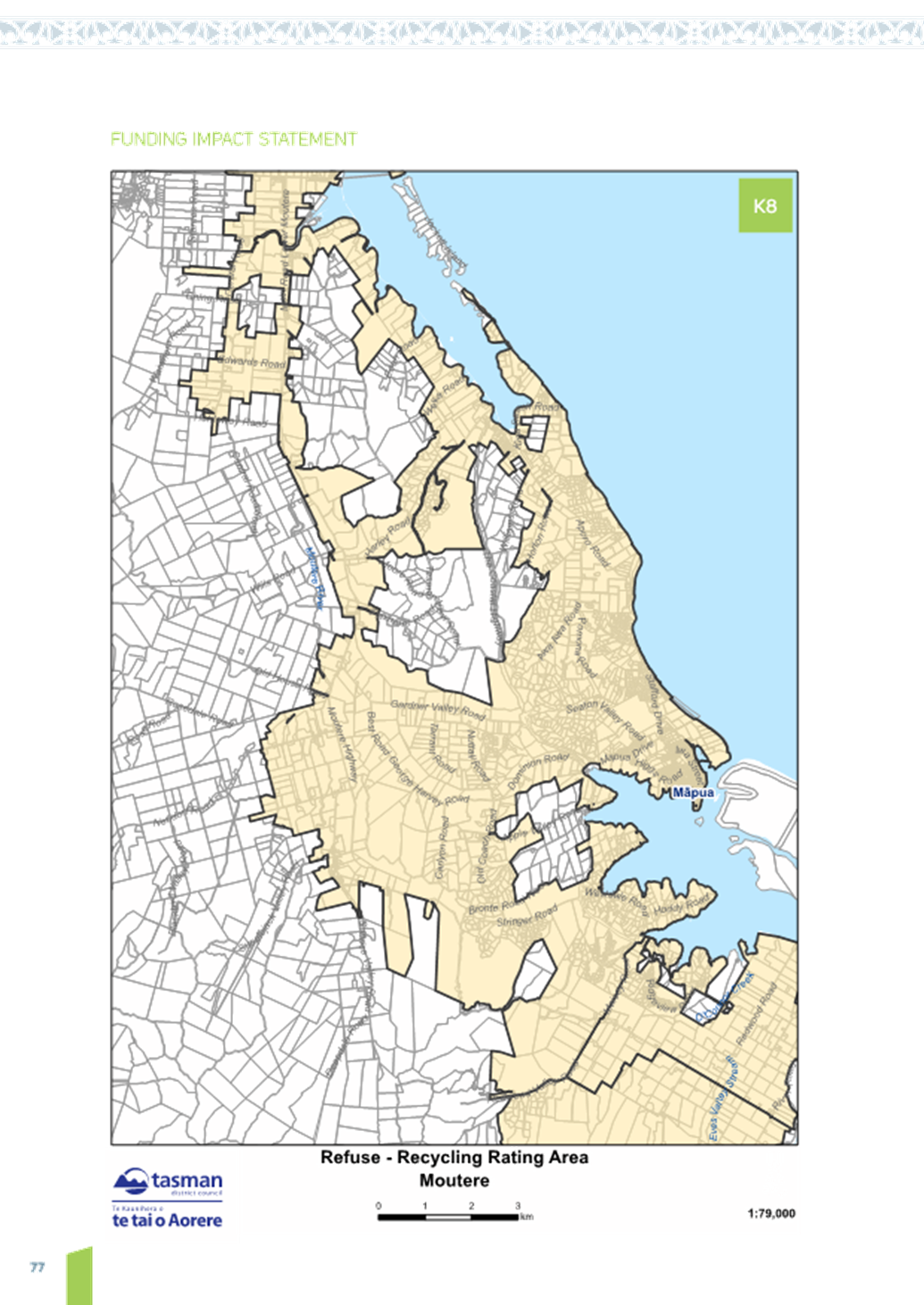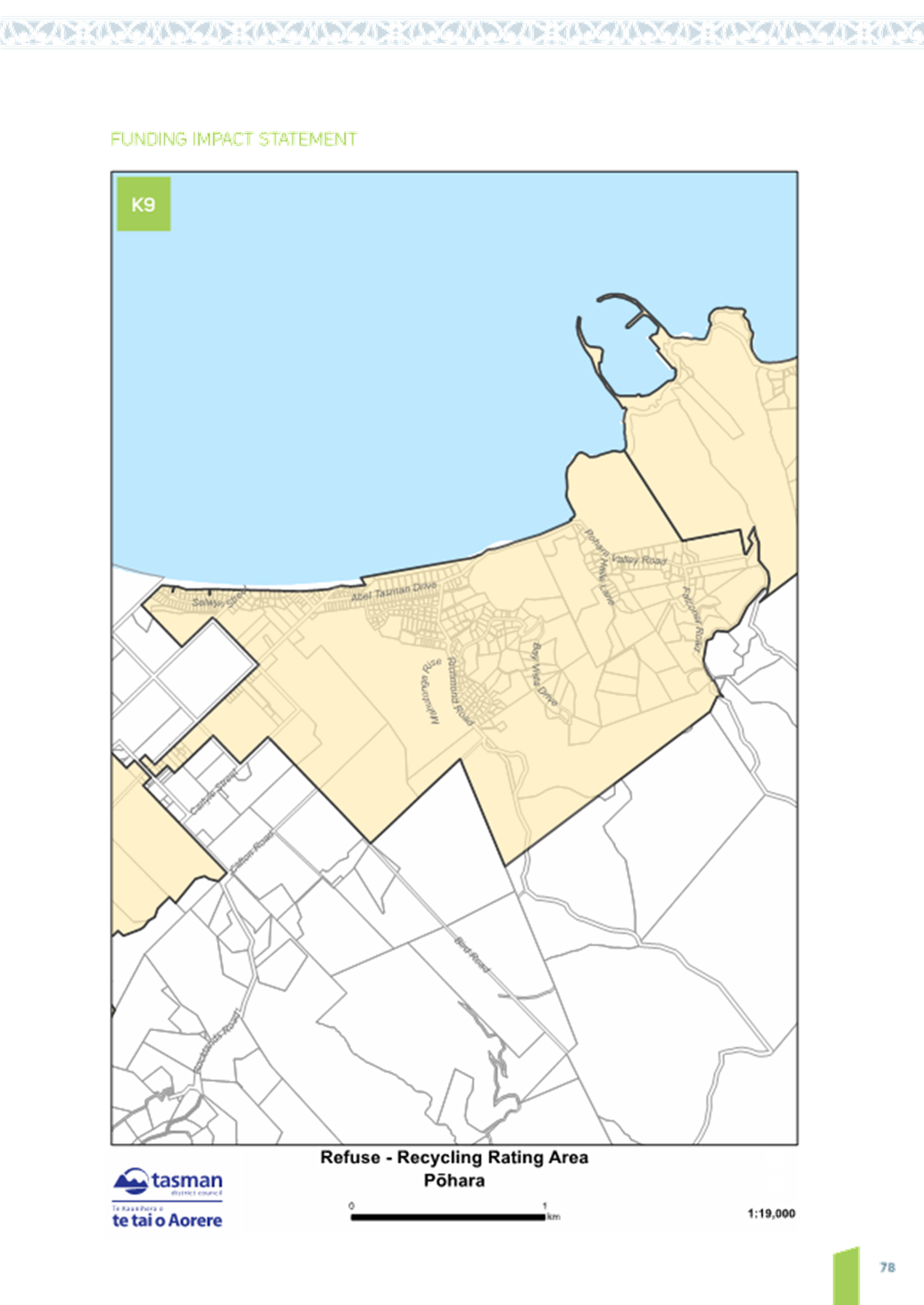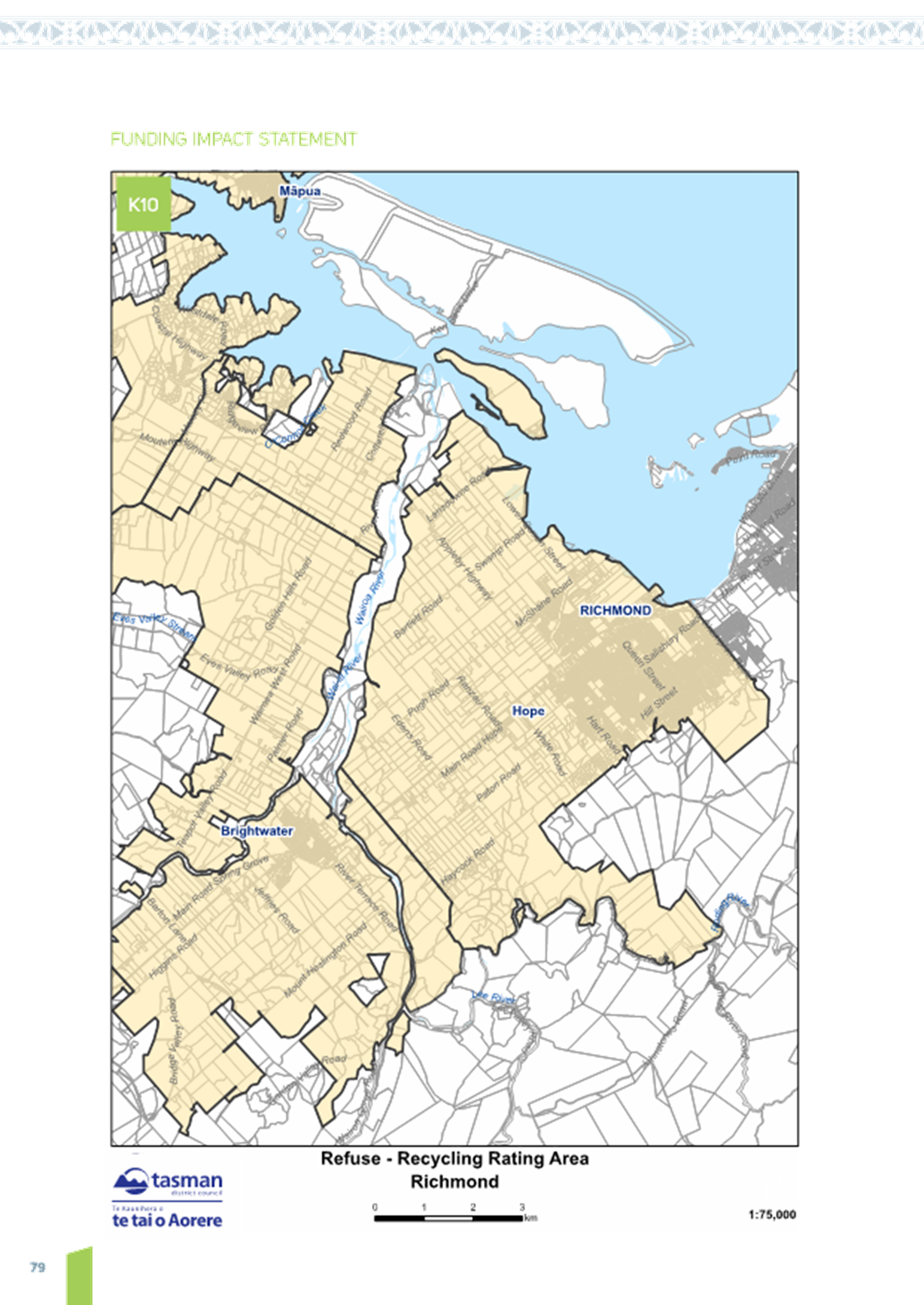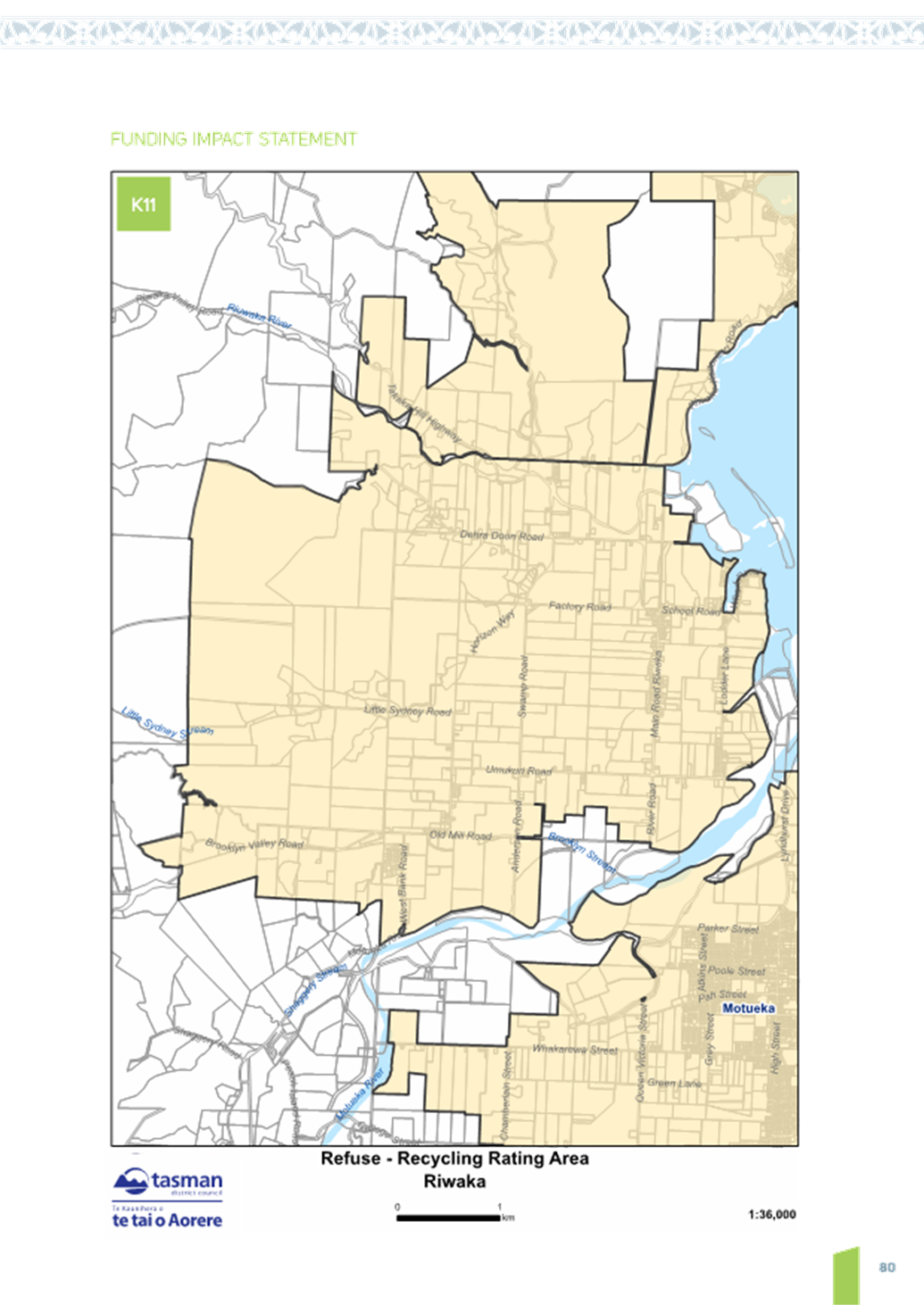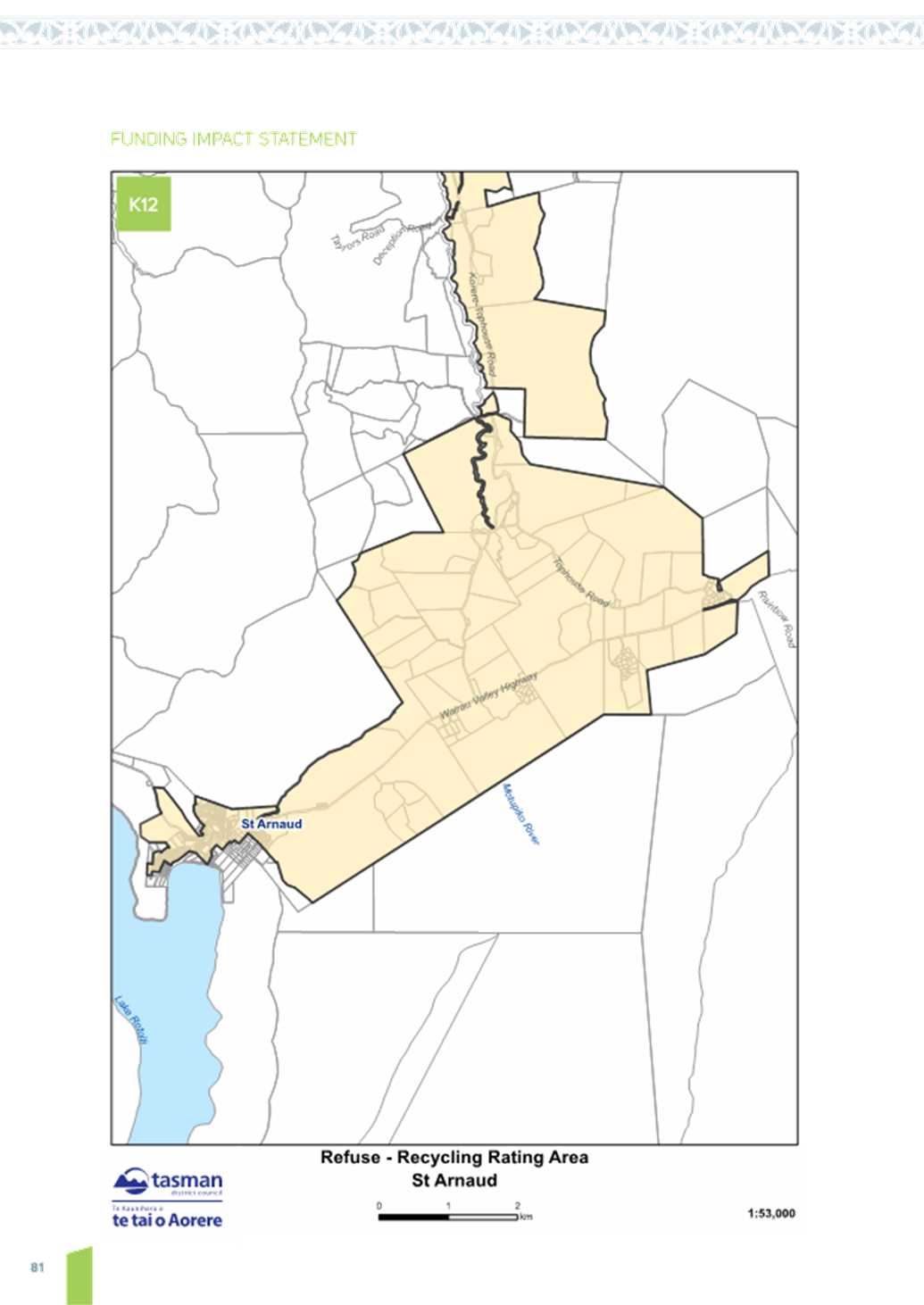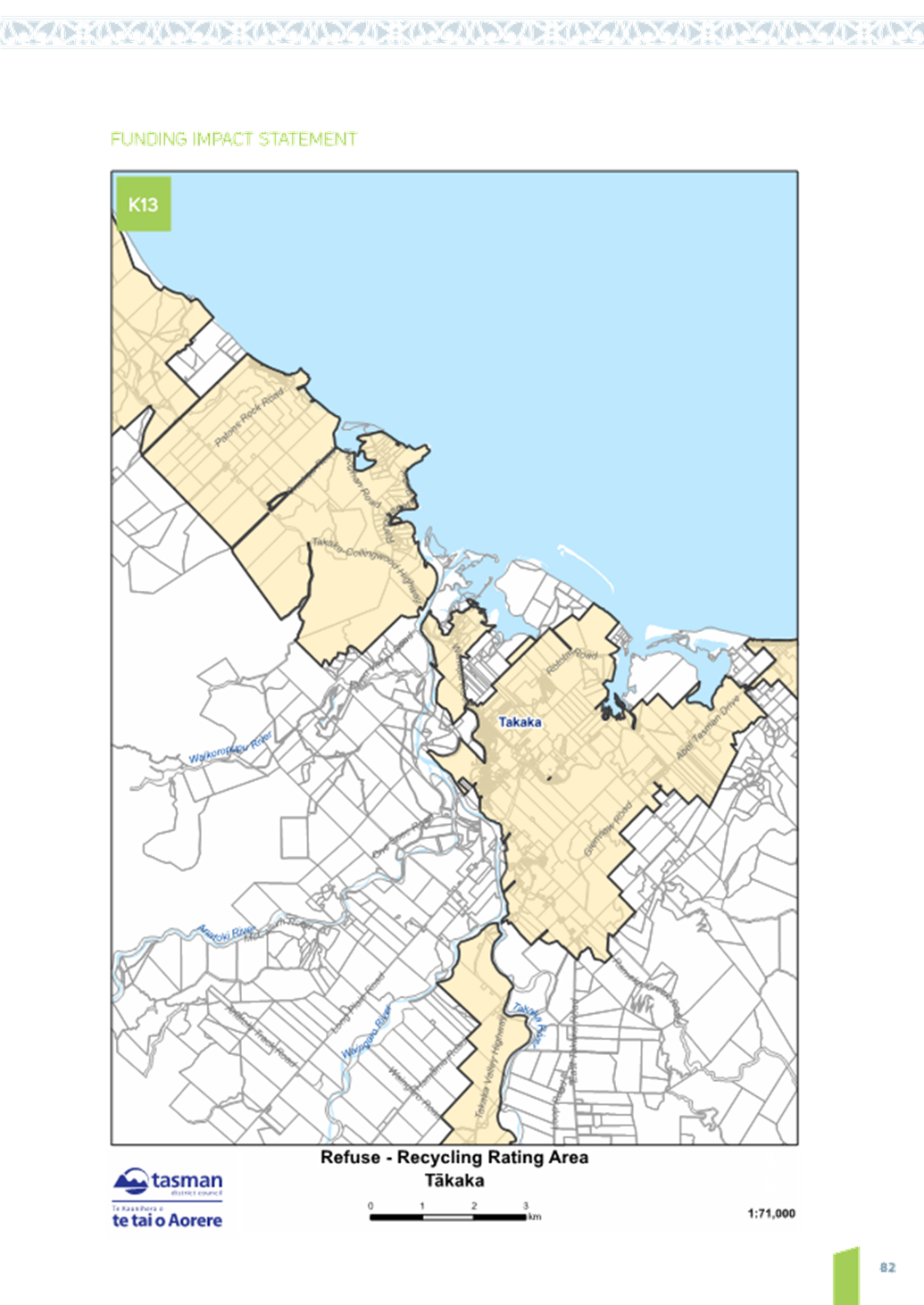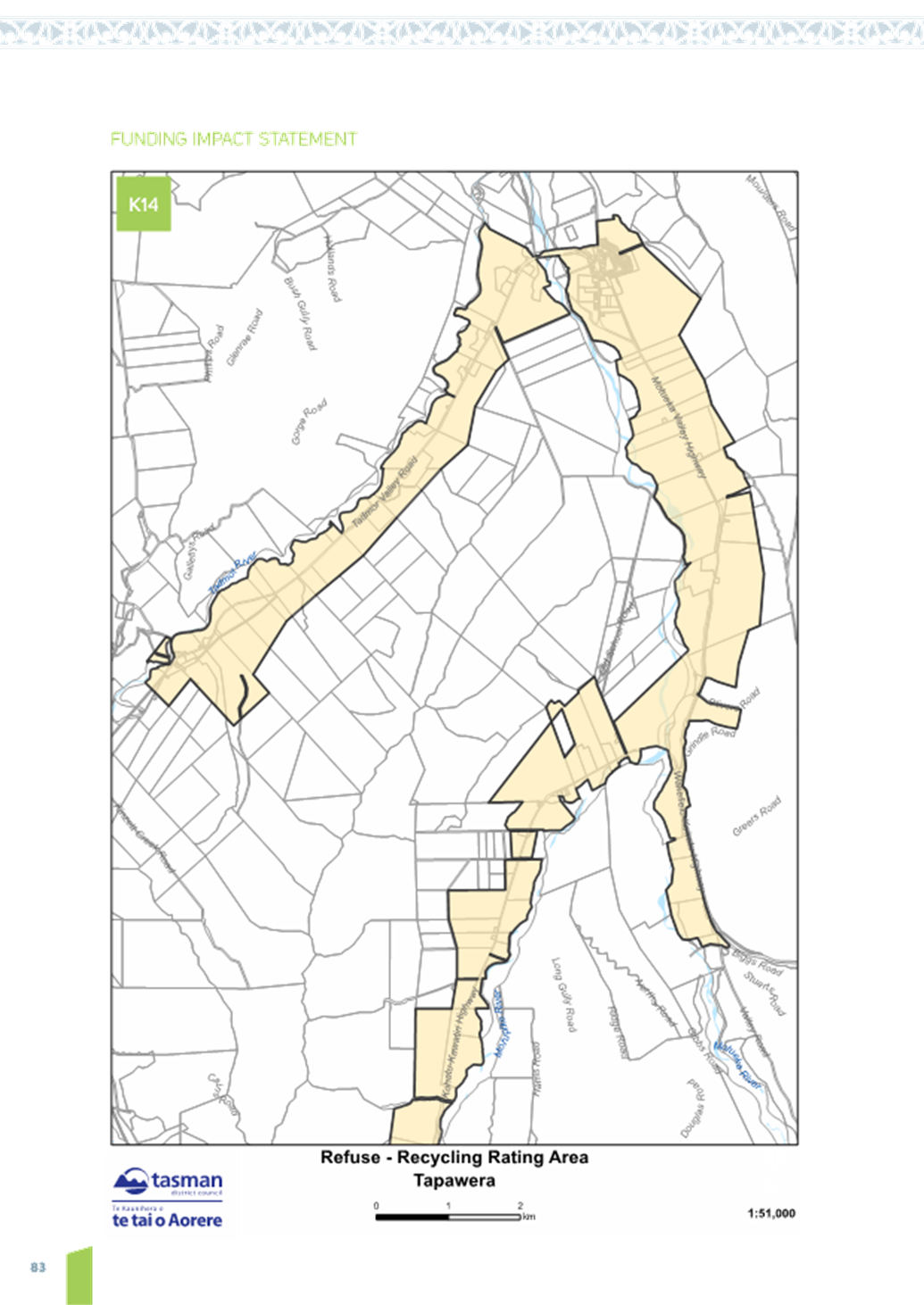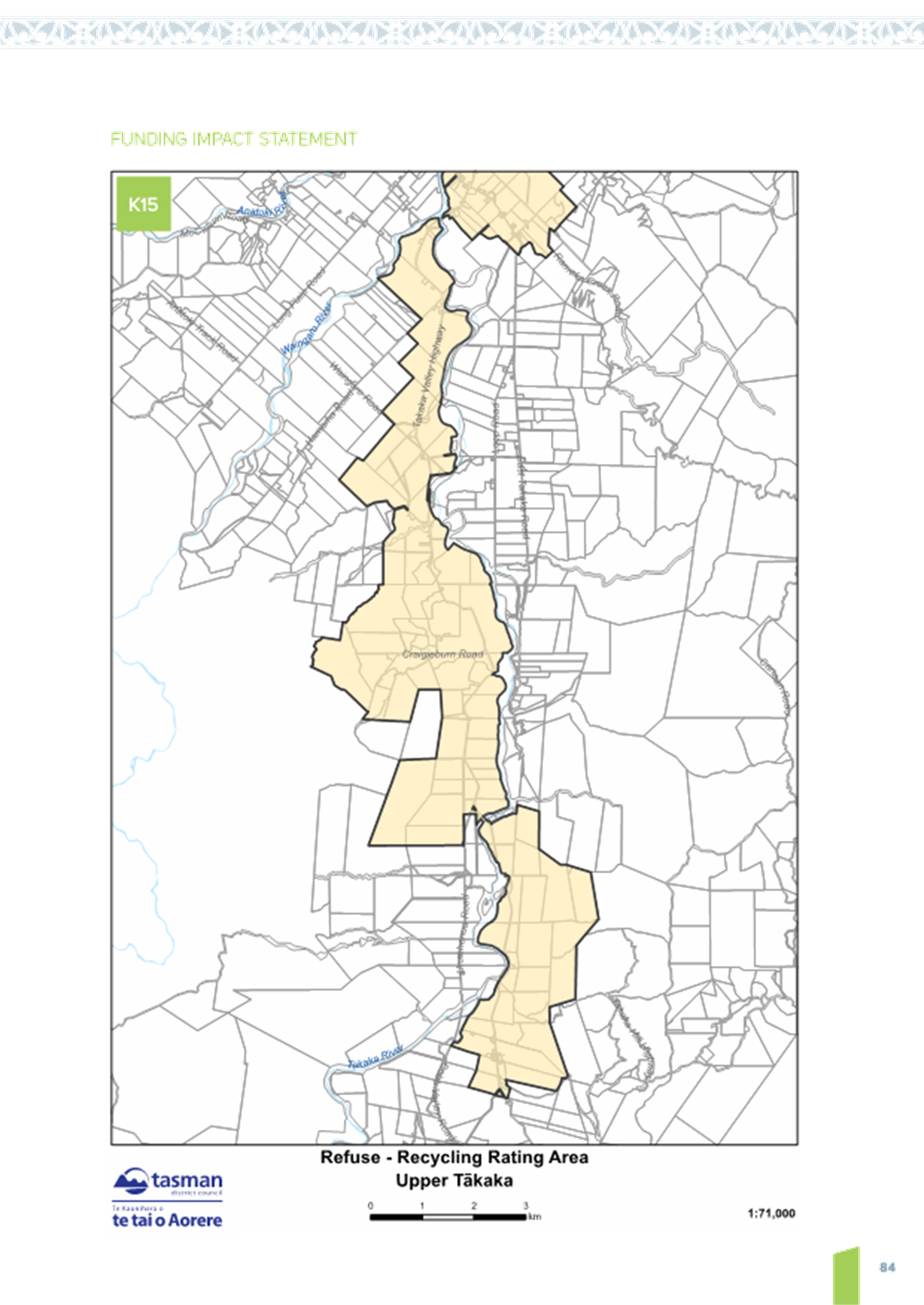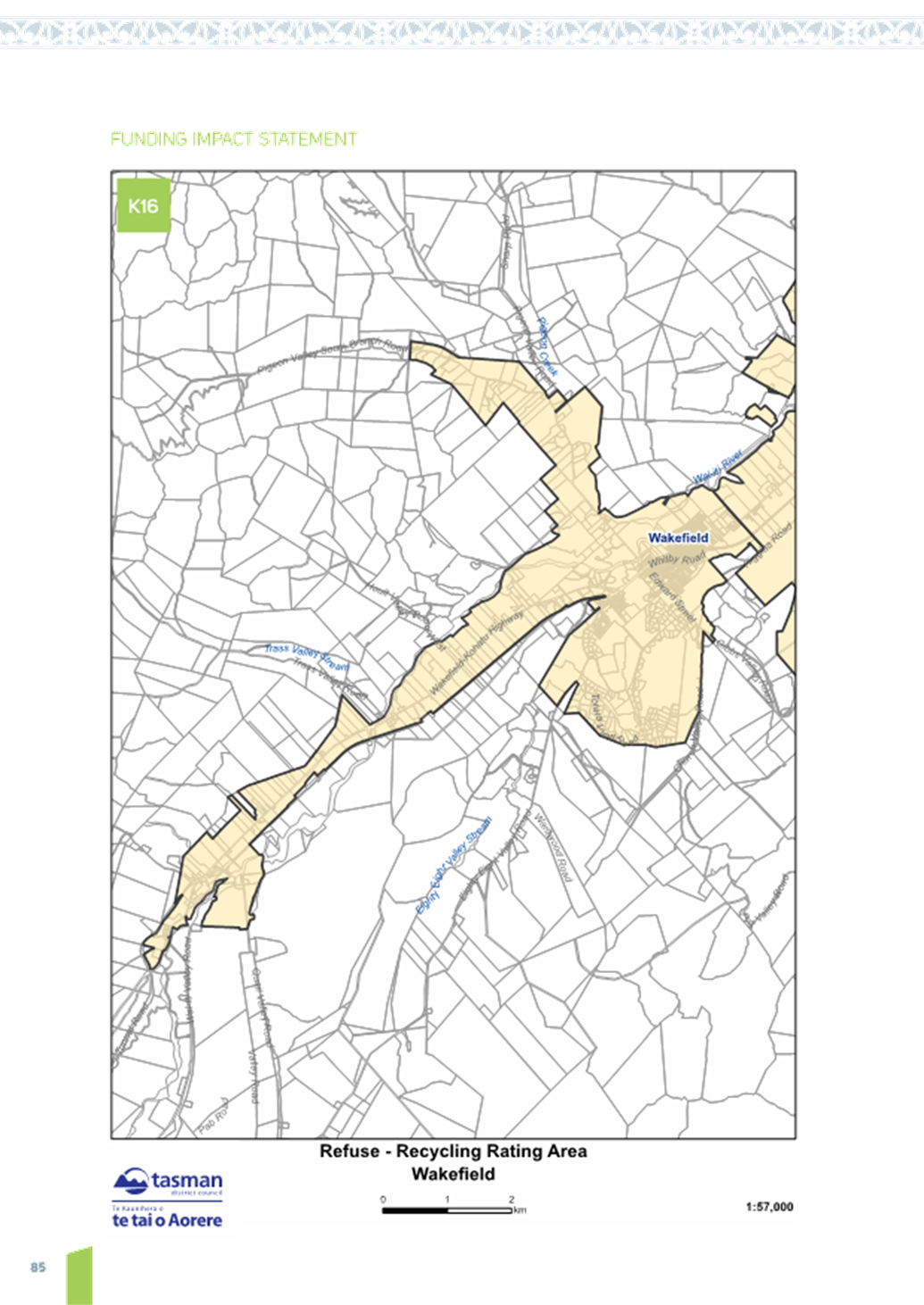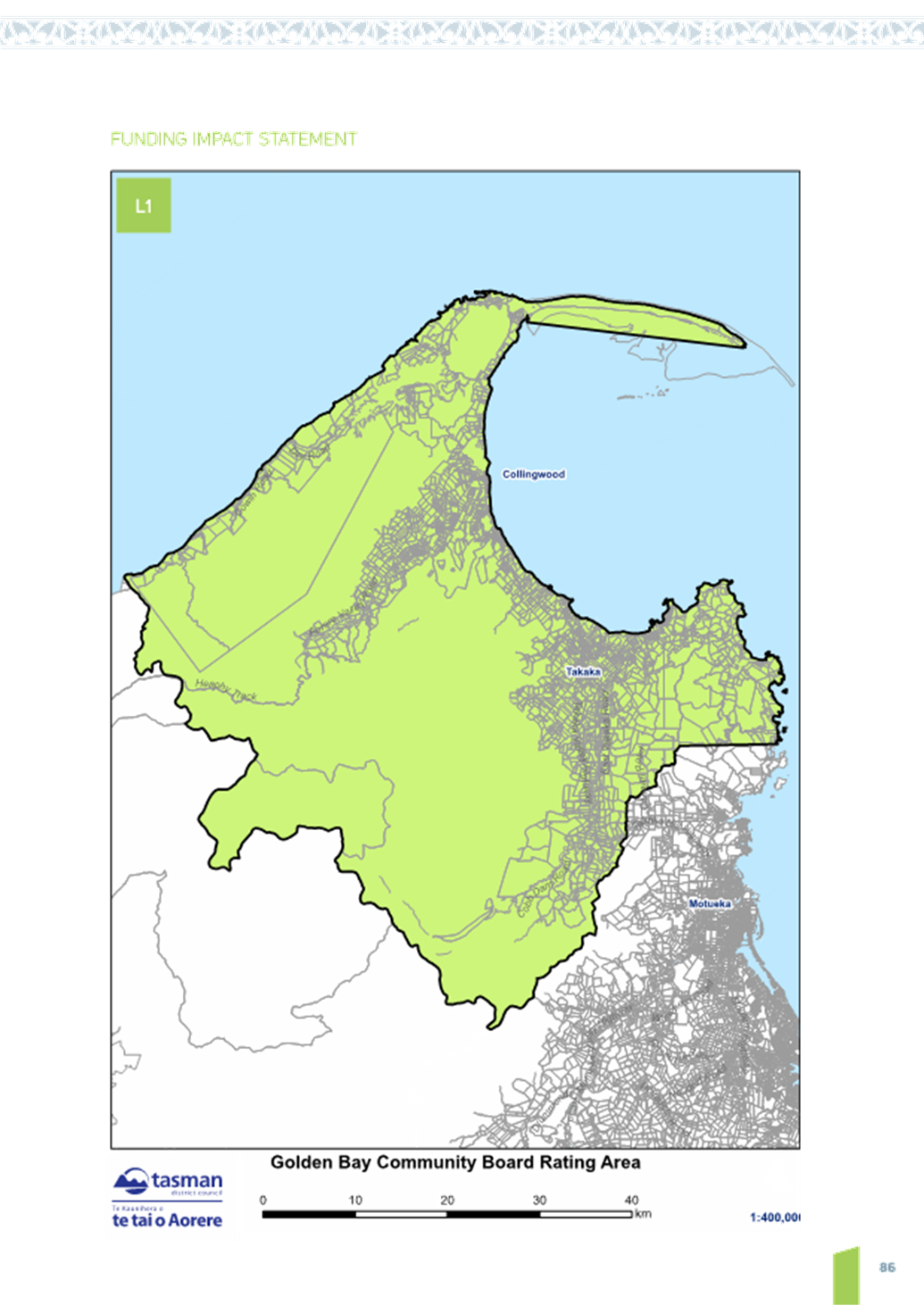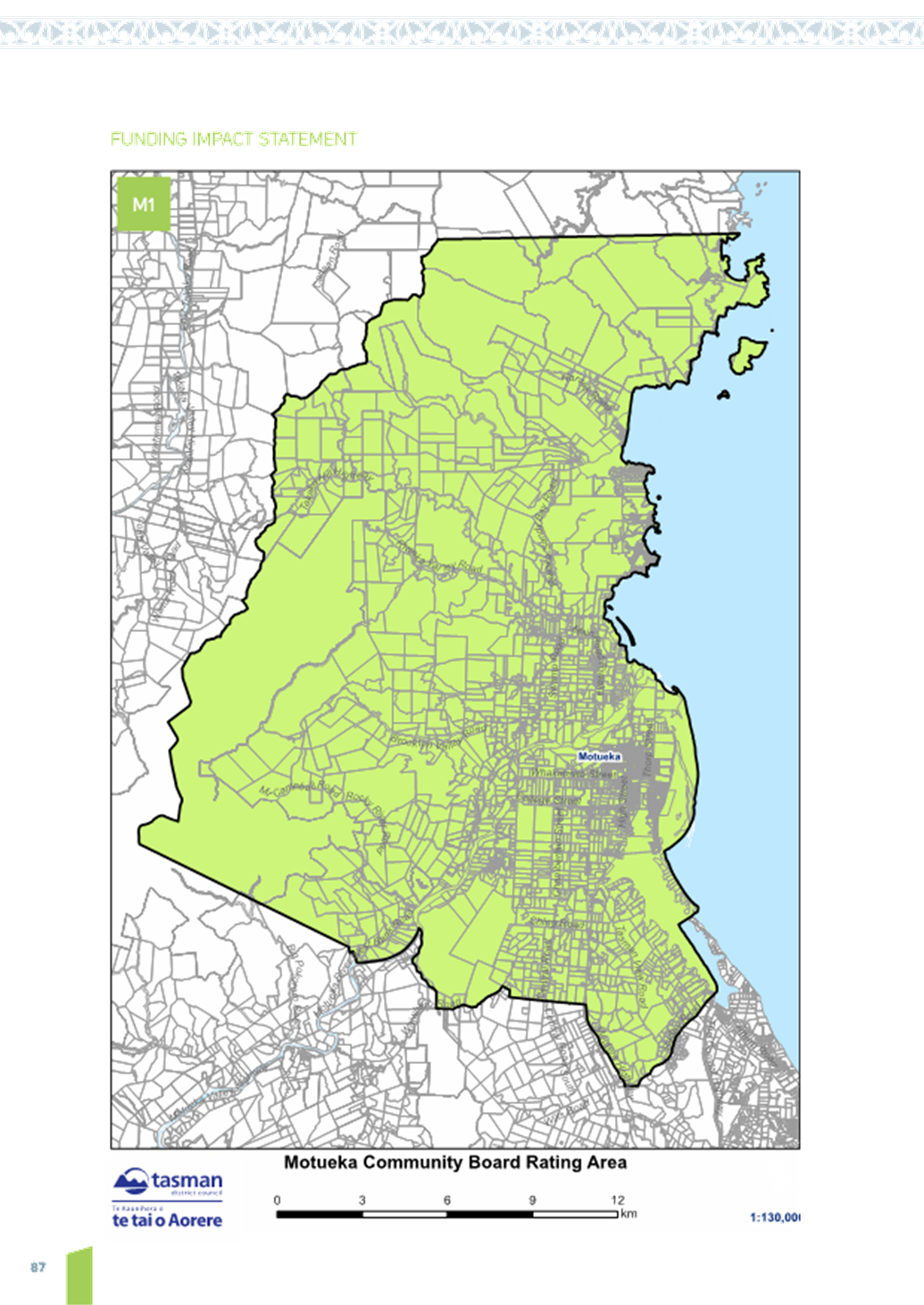Notice
is given that an ordinary meeting of the Tasman District Council will be held
on:
|
Date:
Time:
Meeting
Room:
Venue:
Zoom
conference link:
Meeting ID:
Meeting Passcode:
|
Thursday 8 May 2025
9.30am
Tasman Council Chamber
189 Queen Street, Richmond
https://us02web.zoom.us/j/86304018904?
863 0401 8904
042580
|
|
Tasman
District Council
Kaunihera
Katoa
AGENDA
|
MEMBERSHIP
|
Mayor
|
Mayor T King
|
|
|
Deputy Mayor
|
Deputy Mayor S Bryant
|
|
|
Councillors
|
Councillor C Butler
|
Councillor M Kininmonth
|
|
|
Councillor G Daikee
|
Councillor C Mackenzie
|
|
|
Councillor B Dowler
|
Councillor K Maling
|
|
|
Councillor J Ellis
|
Councillor B Maru
|
|
|
Councillor M Greening
|
Councillor D Shallcrass
|
|
|
Councillor C Hill
|
Councillor T Walker
|
(Quorum 7 members)
|
|
|
Contact Telephone: 03 543 8400
Email: Robyn.Scherer@tasman.govt.nz
Website: www.tasman.govt.nz
|
Tasman District
Council
Agenda – 08 May 2025
AGENDA
1 Opening, Welcome, KARAKIA
2 Apologies
and Leave of Absence
|
Recommendation
That apologies be accepted.
|
3 Public
Forum
3.1 Presentation of Petition - Murchison Community
Members - Concerns regarding the closure of toilets at Wakefield.............................................................. 5
4 Declarations
of Interest
5 LATE
ITEMS
6 Confirmation
of minutes
|
That the
minutes of the Tasman District Council meeting held on Thursday, 27 March
2025, be confirmed as a true and correct record of the meeting.
|
|
That the
minutes of the Tasman District Council meeting held on Thursday, 17 April
2025, be confirmed as a true and correct record of the meeting.
|
|
That the
minutes of the Tasman District Council meeting held on Wednesday, 30 April
2025, be confirmed as a true and correct record of the meeting.
|
|
That the
confidential minutes of the Tasman District Council meeting held on Thursday,
27 March 2025, be confirmed as a true and correct record of the meeting.
|
|
That the confidential
minutes of the Tasman District Council meeting held on Thursday, 17 April
2025, be confirmed as a true and correct record of the meeting.
|
7 Reports
7.1 Revocation of Community Infrastructure Consideration
of Operational Cost Savings 2024/2025 decision of 27 March 2025 Council meeting................................................................... 11
7.2 Quarterly Financial Report - to 31 March 2025..... 15
7.3 2024/25 Forecast Overspend................................ 26
7.4 Hamama Water Supply - Approval for Renewal
Expenditure............................................................ 35
7.5 Chlorination Exemption for Upper Tākaka
Water Supply..................................................................... 41
7.6 Wakatū Non-Vesting Option.................................. 47
7.7 Tapawera Community Hub Location..................... 54
7.8 Lower Queen Street Bridge Upgrade - Temporary
Bypass Considerations.......................................... 67
7.9 Amendments to Delegations Register................... 91
7.10 Section 17A Service Delivery Review - Community Facilities................................................................ 122
7.11 2025 Tasman District Council Election - Order of Candidate
Names
on Voting Documents and Electoral System for 2028 Election........................................................ 149
7.12 Local Government Act 2002 - Section 17A Review Policy.................................................................... 154
7.13 Local Government Funding Agency Nominating Councils................................................................ 166
7.14 Chief Executive's Update..................................... 219
7.15 Mayoral Update Report........................................ 224
7.16 Annual Plan 2025/2026 Consultation Document Report................................................................... 227
8 Confidential
Session
Nil
9 CLOSING
KARAKIA
Tasman District
Council
Agenda – 08 May 2025
3 Public
Forum
3.1
Presentation of Petition
- Murchison Community Members - Concerns regarding the closure of toilets at
Wakefield
|
Report
To:
|
Tasman
District Council
|
|
Meeting
Date:
|
8
May 2025
|
|
Report
Author:
|
Elaine
Stephenson, Governance Manager
|
|
Report
Authorisers:
|
|
|
Report
Number:
|
RCN25-05-1
|
1. Public
Forum / Te Matapaki Tūmatanui
Deputy Mayor Stuart Bryant will present a
petition on behalf of Murchison community members supporting the retention of
the old toilet block, on the left entering Wakefield from the South.
The petition, consisting of 59 signatures,
together with supporting information, is attached as Attachment 1.
|
1.⇩
|
Murchison
Community petition regarding Wakefield toilets
|
6
|
Tasman District
Council
Agenda – 08 May 2025





Tasman District Council Agenda – 08 May 2025
7 Reports
7.1
Revocation of Community
Infrastructure Consideration of Operational Cost Savings 2024/2025 decision of
27 March 2025 Council meeting
Decision Required
|
Report
To:
|
Tasman
District Council
|
|
Meeting
Date:
|
8
May 2025
|
|
Report
Author:
|
Leonie
Rae, Chief Executive Officer
|
|
Report
Number:
|
RCN25-05-2
|
1. Purpose
of the Report / Te Take mō te Pūrongo
1.1 To
revoke part of the previous decision made at the 27 March 2025 Tasman District
Council meeting - Community Infrastructure Consideration of Operational Cost
Savings 2024/2025 [CN25-03-16].
2. Summary
/ Te Tuhinga Whakarāpoto
2.1 A
late report was presented to the 27 March 2025 Council meeting proposing
Community Infrastructure operational cost savings to reduce forecasted
over-expenditure in the maintenance budget. The late item agenda for that
report can be found here.
2.2 The
minutes of the 27 March Council meeting record the
decision as:
7.7 Consideration of Operational Cost
Savings 2024/2025
CN25-03-16
That the
Tasman District Council
1.
receives the Report on Community Infrastructure
Consideration of Operational Cost Savings 2024/2025, RCN25-03-12; and
2.
notes that for the Waters and Wastewater activity the frequency of routine
monitoring will only be reduced where compliance with water regulations is not
compromised; and
3.
notes that reducing routine maintenance in the Waters and Wastes activity may
realise circa $10,000 savings in 2024/25; and
4.
notes that there is little opportunity to reduce levels of service in the Waste
Management and Minimisation activity without incurring additional costs next
year and that increasing gate charges is not recommended; and
5.
approves the following levels of service reductions in Reserves and Facilities
activity for the remainder of the 2024/2025 year:
5.1
the removal of Rubbish Bins from Reserves, potentially saving $229,000 per
annum; and
5.2
reducing the cleaning frequency of 14 public toilets saving $75,000 per annum;
and
5.3
the temporary closure of three public toilets and the discretion to temporarily
close more on a seasonal basis if identified as low use, saving $12,000 per
annum; and
5.4
reducing annual bedding displays (planting) in formal gardens saving $84,000
per annum; and
5.5
reducing conservation shrub maintenance saving $159,000 per annum; and
6.
approves reducing the levels of service within the Transportation activity for
the remainder of the 2024/2025 year as follows:
6.1
reduce the frequency of street sweeping across all urban areas potentially
saving $30,000; and
6.2
pause rural roadside mowing except for safety/critical sightlines potentially
saving $90,000; and
6.3
reduce the urban landscape mowing potentially saving $2,500.
2.3 The
rationale for the resolutions is contained in that report (CN25-03-16).
2.4 Following
discussions with staff and elected officials the recommendation is that the
Council rescinds part of the previous decision of the Council, being
resolutions 5.1 to 5.5.
3. Recommendation/s
/ Ngā Tūtohunga
That the Tasman
District Council
1. receives
the Revocation of Community Infrastructure Consideration of Operational Cost
Savings 2024/2025 decision of 27 March 2025 Council meeting report,
RCN25-05-2; and
2. revokes the following part of the previous decision
(CN25-03-16), made at the 27 March 2025 Council meeting regarding Community
Infrastructure Consideration of Operational Cost Savings 2024/2025:
That the Tasman District
Council
…
5. approves
the following levels of service reductions in Reserves and Facilities activity
for the remainder of the 2024/2025 year:
5.1 the
removal of Rubbish Bins from Reserves, potentially saving $229,000 per annum;
and
5.2 reducing
the cleaning frequency of 14 public toilets saving $75,000 per annum; and
5.3 the
temporary closure of three public toilets and the discretion to temporarily
close more on a seasonal basis if identified as low use, saving $12,000 per
annum; and
5.4 reducing
annual bedding displays (planting) in formal gardens saving $84,000 per annum;
and
5.5 reducing
conservation shrub maintenance saving $159,000 per annum; and
…
3. notes that the Reserves and Facilities activity will
absorb these costs and continue to make operational decisions to reduce ongoing
costs.
4.1 Following discussions with elected officials and staff, it
has been decided to revoke resolution 5.1 to 5.5 from the late report 7.7
presented at the Council meeting on 27 March 2025, titled “Consideration
of Operational Cost Savings 2024/2025”.
4.2 The
rationale is considered that the wording of this part of the resolution was not
clear enough to ensure that the elected members had a clear understanding of
the effect of this decision. This is partly because the cost savings were on a
‘per annum’ basis as opposed to being an indication of actual
costs.
4.3 This
confusion has been echoed by parts of the community.
4.4 Further
work has also been undertaken which indicates that the expected savings for the
current financial year are not as significant as indicated in the previous
report.
5. Financial
or Budgetary Implications / Ngā Ritenga ā-Pūtea
5.1 The Facilities and Reserves team will
continue to evaluate potential cost savings across their activities as part of
standard operational management.
5.2 Achieving any cost reductions will
require enhanced oversight of services, including adjustments to service levels
such as the frequency of toilet cleaning based on seasonal demand.
6.1 The Council has the option to either
rescind part of the previous decision or continue with the resolutions as
passed.
6.2 Rescinding part of the previous decision
is recommended.
7.1 The Council has the legal ability to
rescind part of the previous decision made.
7.2 It is noted that the decision to rescind
is not an inconsistent decision for the purposes of section 80 of the Local
Government Act 2002. This is because it is revoking that decision as opposed to
acting in an inconsistent manner with it.
8. Significance
and Engagement / Hiranga me te Whakawhitiwhiti ā-Hapori Whānui
8.1 The previous decision contained in the
minutes (CN25-03-16) generated significant interest in the community. The
rescinding part of that decision is likely to garner similar interest and,
based on the feedback received, be supported by the community.
9. Communication
/ Whakawhitiwhiti Kōrero
9.1 Following this decision a statement will
be provided on the Council’s social media channels.
10.1 The rescinding of this decision will create
additional financial pressure that the activity will need to manage carefully.
11. Conclusion
/ Kupu Whakatepe
11.1 It is recommended that the Council rescind part of its previous
decision on the basis that the previous resolution was not sufficiently clear
and the proposed cost savings may not be able to be recognised.
Nil
Tasman District
Council
Agenda – 08 May 2025
7.2 Quarterly Financial Report - to 31 March 2025
Information Only - No Decision
Required
|
Report
To:
|
Tasman
District Council
|
|
Meeting
Date:
|
8
May 2025
|
|
Report
Author:
|
Paul
Egan, Management Accounting Manager
|
|
Report
Authorisers:
|
Mike
Drummond, Chief Financial Officer
|
|
Report
Number:
|
RCN25-05-3
|
1. Summary
/ Te Tuhinga Whakarāpoto
1.1 This financial
report provides an update on key financial information for the nine months
ending 31 March 2025.
1.2 The scope of this financial report
excludes revenue and expenditure from joint operations, as well as the share of
associates’ surplus or deficit. This approach ensures a focused analysis
on the financial results of the core operations of the Council. Amounts related
to joint operations and associates will be consolidated and included in the
2024/25 Annual Report.
1.3 As of 31 March 2025, the accounting
deficit is $4.7 million higher than budgeted, primarily due to increased
maintenance expenditure, depreciation and amortisation, which outweigh
favourable variances in employee and other expenses.
1.4 We are still forecasting an unfavourable
variance in borrowing costs of $2.3 million by year-end. Reported borrowing
costs have been impacted by credit interest error that will come out on
consolidation at year end.
1.5 Overall, we anticipate a circa $6.5
million increase to the 2024/2025 budgeted year-end deficit position. This will
need to be debt-funded and will impact rates and borrowing costs for the
2025/2026 Annual Plan budget. Typically, deficits are funded at the activity
level over the following three to five years. This funding matter is being
addressed in the 2024/25 Forecast Overspend report being presented at this
meeting.
1.6 Overall revenue
is tracking close to budget, with higher operating subsidies, water rates, but
lower development contributions, reserve financial contributions, and forestry
revenue.
1.7 The balanced
budget benchmark that includes some capital related income but focuses on
funding of operating expenditure is at 90% year to date, versus an Annual Plan
budget benchmark of 96%.
1.8 Capital
expenditure is $40.7 million at 53% of full year budget of $76 million. It
appears unlikely the full year budget can be achieved.
1.9 Net debt is at
$266.8 million versus the Long Term Plan (LTP) estimate for 2024/25 of
$279.7 million.
1.10 While receivables, rates arrears and dishonoured
direct debit rates payments are consistent with recent years, the level of
successful rates rebate applications year to date is higher than the previous
five years. Staff continue to promote the Rates Rebate Scheme.
2. Recommendation/s
/ Ngā Tūtohunga
That the Tasman District Council
1. receives the Quarterly Financial Report - to 31 March 2025 report, RCN25-05-3.
3.1 Balanced
Budget benchmark
3.1.1 The balanced budget benchmark is part of a suite of benchmarks
as defined in the Local Government (Financial Reporting and Prudence)
Regulations 2014. These benchmarks are included in the Council’s Annual
Reports, Annual Plans and Long Term Plans.

3.2 The official balanced budget benchmark
includes capital subsidies and grants as operational income, significantly
reducing the budgeted and reported operational deficit (by $6.3 million). This
overstates the percentage of operating expenditure covered by revenue, removing
the capital subsidies from the balanced budget calculations would reduce the
expenditure coverage percentage to a much lower 86%.
3.3 The
balanced budget benchmark amounts are detailed below to provide an indication
of reporting.

3.4 Loan funded operating expenses impact
the balance budget benchmark. Year to date, they were $3.5 million, of which $3
million related to the Digital Innovation Programme, with most of the rest
being for the Tasman Resource Management Plan (TRMP) and Saxton Field.
The budget for loan funded operating expense for the 2024/25 year is $9.25
million, however, $3.17 million, related to the museum storage facility, has
been deferred.
3.5 The level of depreciation that is funded
impacts the balanced budget benchmark. Funded depreciation is an expense
related to the wearing out of Council assets. It is considered when calculating
rates and the funds collected are used to fund the renewal of assets.
Approximately 75% of depreciation expense is included in these calculations,
meaning less is recovered, increasing the likelihood some operating expenses
will need to be funded from debt.
Statement of Comprehensive Revenue and
Expense

Areas of key
variance are elaborated below.
Maintenance Analysis
4.1 As
indicated in the previous reports, maintenance expenditure is continuing to
track over budget. It is expected to end the year approximately $3 million over
budget, given the latest forecasts. This over expenditure estimate excludes
Joint Operations.
4.2 Water Supply, Transportation and Reserves and Facilities are the
main areas of forecast overspend.

Year to date Revenue
4.3 Development
and Financial Contributions are tracking at about half the level for the same
period in the previous two years. With the increase in Development Contribution
charges from 1 July 2024, some developers prepaid their development
contributions in the 2023/24 year under the Council’s once paid always
paid policy.
4.4 Fees
and Charges continue to track slightly ahead of budget, with Building Assurance
and Resource Consents performing better than budget, however, Waste Management
& Minimisation are down due to reduced volumes.
4.5 Other
Revenue is $1.4 million net ahead due to a mix of factors, including dividend
income due to the change in timing in payment of the Infrastructure Holdings
Limited (IHL) dividend. Lease related income is higher, as are Joint
Operations related distributions, with offsets from lower forestry income due
to lower log prices and revised harvesting programmes.
Finance Expense (Net)
4.6 After
making an adjustment of circa $1 million for interest related to Joint
Operations, the Net correct Finance expense variance is approximately
$1,166,000 unfavourable to budget year to date. The timing of capital
expenditure, and higher interest income will increase the net expense. This is
expected to be a $2.3 million unfavourable position at year end.
Depreciation and Amortisation
4.7 With
the higher-than-expected increase in asset valuations at the end of 2023/24,
the budgeted depreciation and amortisation in the Annual Plan/Long Term Plan is
considerably less than current actuals. Year to date depreciation and
amortisation is $2.7 million over budget and is expected to end the year
over $4 million over budget. The increase in property, plant and equipment as a
result of the revaluations has resulted in significant increases in the draft
2025/26 Annual Plan depreciation budgets.
4.8 The
depreciation expense recognises the consumption and wearing out of tangible
assets over their life, the reported value of the asset reduces by this amount.
The depreciation is included with the rest of the expenses in the financial
statements and rates calculations. In simple terms, the costs of the Council
including an amount of depreciation - are what rates and other income of
Council need to cover to achieve a balanced budget.
4.9 This
funding from rates and other income sources covers the depreciation expense
bringing cash into the Council. In general, this cash is used to fund the
repayment of borrowing incurred in purchasing the assets.
4.10 Asset
revaluations are required under financial reporting standards, and they more
accurately reflect the value, and likely replacement costs of longer life
assets, than their historic cost. Upwards revaluations increase the
depreciation expense, increasing the rates (and other income) required, where
they do exceed the cost of debt servicing, they create a reserve that moderates
the rates impact when renewal does need to
occur.
5. Capital Expenditure by Activity
5.1 The LTP financial budgets assume that
the full capital works programme will not be delivered in its entirety each
year. This historical under-delivery is factored into the forecast net debt
levels and finance costs.
5.2 Changes to the capital programme -
notably the changes approved in the 24 October 2025 Tasman District
Council meeting, and to the Lower Queen Street Bridge Project related changes
in the 13 February 2025 Tasman District Council meeting, lead to
re-phasing and re-prioritisation. These changes in capital expenditure are
reflected in the transfers shown in the table below, with some items being
brought forward and others being rephased to future years.
5.3 Year-to-date
expenditure is 53% of the budget three quarters of the way through the year. It
is, however, sitting at 60% of latest forecast spend. While a ramp up of the
expenditure is expected in the last quarter, a material carry forward into the
2025/26 financial year is also expected. To avoid a carry forward on the
current budget, capital expenditure would have to average approximately $11.8
million per month for April to June 2025. This appears unlikely given the
monthly average expenditure to March is $4.5 million, and the consistent
history of underspent capital budgets in previous years.
5.4 The consistent
capital budget underspends and carry forwards appear to have several causal
factors that include:
5.4.1 An annual cycle of
releasing work.
5.4.2 The multi-year
nature of many projects.
5.4.3 The complexity of
being able to proceed on a project, where there are issues, such as acquiring
land, obtaining resource consents, due process, design changes, external
funders input, and dependencies on other projects finishing first.
5.4.4 Changes to
priorities due to growth, and growth predictions, needed land availability, and
overall budget constraints.
5.5 The organisation needs to
further consider developing a realistically deliverable capital works programme
that incorporates increased efficiencies, this would potentially require
additional focused resources. The Council has indicated through the draft Annual
Plan process that it is not in favour of additional resources currently. Given
the current financial environment including an increasing operational deficit,
the Council is incentivised to avoid increasing debt through capital
expenditure and to defer such expenditure into future years. This approach
needs to be communicated to and understood by the community.
5.6 Budget, spend
and forecast by activity is summarised in the table on the next page.

6. Statement of Financial Position (Balance
Sheet)
6.1 The
Statement of Financial Position

7. Net Debt and External Debt
7.1 The Treasury report, that will be
presented at the next Council meeting, will have more detail and analysis in
this area.
7.2 On 31 March 2025, the Council's total
debt of $390.3 million was unchanged from 31 December 2024, and its Net
Debt stood at $266.8 million against a policy limit of $295.1 million
(160% of forecast annual revenue).
7.3 The Pass-through Loans are Shareholder
advances to Waimea Water Limited for funding the Waimea Community Dam. These
loans are excluded in calculating the Council’s Net Debt position. They
are included in assessing the Council’s borrowing from the Local
Government Funding Agency (LGFA) and the LGFA covenants.
7.4 The linked deposits are the Council
pre-funding its April 2025 LGFA loan repayments. This pre-funding is part
of our Treasury borrowing strategy.
Breakdown of net debt

8.1 Rates
receivables are like previous years after allowing for rates income increases.
Other receivables are down on previous years, due largely to reduced forestry
income.
8.2 The receivables
summary is set out below:

Rates
Receivables
8.3 The
number of rates rebate applications are significantly up this year, with the
approval of 240 more rebates than at the same point last year (2023/24),
totalling an extra $200,000 of savings for low-income ratepayers. If this trend
continues, we anticipate over 2,000 successful applications by the end of June.
8.4 While
the Council covers the administration costs of the Rates Rebate scheme the
rebates themselves are refunded to the Council by Central Government.
8.5 The
rates team is proactive in this area and will be sending a letter to previous
applicants who have not yet applied this year, encouraging them to submit their
applications before the end of the rating year.

Other
Receivables
8.6 This includes all other items,
accounting accruals, fees and charges, infringements, forestry debtors, amounts
due from NZTA, development contributions, reserve financial contributions, and
interest receivable etc.
8.7 The $1,400,000 decrease in other
receivables is mostly due to the movement in accounting accruals compared to
March 2024. These accruals are for income such as NZTA, water, refuse and
interest on investments.
8.8 The following graphs compare debt that
is older than three months with the total debt for each part of the Council.
These have been separated between balances over $50,000 and balances under
$50,000 for scaling purposes to provide a meaningful graph of the smaller
balances.
8.9 The ten largest debts exceeding three
months in age amount to $332,000. These are primarily concentrated in Building
Control ($110,000 from four debtors) and Resource Consents ($106,000 from two
debtors). Additionally, there are two sundry debts totalling $66,000 and one
instance of unpaid monitoring charges ($35,000). Active recovery action is
underway for all these debts. The remaining balance of $15,000 pertains to
outstanding community lessee rates on charging.

Nil
Tasman District
Council
Agenda – 08 May 2025
7.3 2024/25 Forecast Overspend
Decision Required
|
Report
To:
|
Tasman
District Council
|
|
Meeting
Date:
|
8
May 2025
|
|
Report
Author:
|
Matthew
McGlinchey, Financial Performance Manager
|
|
Report
Authorisers:
|
Mike
Drummond, Chief Financial Officer
|
|
Report
Number:
|
RCN25-05-4
|
1. Purpose
of the Report / Te Take mō te Pūrongo
1.1 To
gain approval for $6.4 million in unbudgeted rates funded operational expenditure
in the 2024/2025 Annual Plan year. Noting that the Council passed a resolution
on 30 April 2025 to partly fund this offset forecast overspend by the sale of
$3.0 million of unencumbered emissions trading scheme (ETS) credits.
2. Summary
/ Te Tuhinga Whakarāpoto
2.1 The
Council expects to be an overall $6.4 million overspent on operational costs in
the 2024/2025 financial year. Table 1 illustrates where the material overspends
will occur. Noting that some activities have an overall surplus forecast.
2.2 An
increase in interest rates and maintenance costs in the Community
Infrastructure area are the main drivers of the forecast expenditure overspend.
2.3 The
Council’s level of borrowing ($309 million gross debt at 31 March 2025)
means that relatively small movements in interest rates can have a significant
impact on finance costs. Those cost pressures are concentrated in
infrastructure activities which have the bulk of the Council debt.
2.4 Funds
collected via targeted rates and/or fees and charges for one activity cannot be
used in another activity. The only exception is the General Rate and the
Uniform Annual General Charge (UAGC) which can be used for any activity.
2.5 Staff have made every effort to try to mitigate the planned
overspend. A business review process has been undertaken to review levels of
service and find operational cost savings. This work has been significant and
has occurred over the last six months. The work has also fed into the draft
Annual Plan 2025/2026 process.
2.6 Selling
further unencumbered ETS to the value of $3.0 million prior to 30 June 2025,
will mean the year end deficit could be reduced to $3.4 million. This remaining
$3.4 million will be loan funded and is proposed to be recovered over five
years at approximately $700,000 per annum commencing from the 2026/2027 Annual
Plan year.
Table 1

3. Recommendation/s
/ Ngā Tūtohunga
That the Tasman
District Council
1. receives
the 2024/25 Forecast Overspend report RCN25-05-4; and
2. notes
the forecast underspends in the following activities:
2.1 Flood
Protection and River Control work $152,000
2.2 Public
Health & Safety $317,000; and
3. approves the forecast unbudgeted operational
expenditure in the following activities:
3.3 Coastal Structures $52,000
3.4 Reserves and Facilities $321,000
3.5 Governance $100,000
3.6 Waste Management and Minimisation $1.85 million
3.7 Stormwater $525,000
3.8 Transportation, Roads and Footpaths $770,000
3.9 Wastewater $995,000
3.10 Water Supply $2.3 million; and
4. confirms
the sale of approximately $3 million of unencumbered emissions trading scheme
credits prior to 30 June 2025, subject to professional
advice on staging the sales to achieve the best overall price.
5. delegates
to the Chief Executive Officer and Chief Financial Officer the authority to
enter into the sale of the unencumbered emissions trading scheme credits and
sign any associated document required to give effect that sale; and
6. approves
the allocation of the proceeds of the proposed $3.0 million emissions trading
scheme sales against debt financing costs as follows:
6.11 Reserves and Facilities $500,000
6.12 Transportation, Roads and Footpaths $500,000
6.13 Wastewater $1.0 million
6.14 Water Supply $1.0 million; and
7. approves use of Waste Disposal Levy funding for transport of
recyclable materials, public place recycling, development of waste policy and
diversion of hazardous waste from landfill; and
8. approves
that the final 2024/2025 Operational deficit, forecast to be $3.4 million is
financed through additional borrowing and repaid over the following five years
commencing in 2025/2026.
4.1 In September of this financial year,
staff became aware that it was most likely that the Council would be overspent
in certain activity areas because of higher than budgeted maintenance and
interest costs.
4.2 If overspends are expected to occur and
there is no offsetting underspend, then staff are required to get this
unbudgeted expenditure approved by the Council, in line with the
Council’s delegations. Noting that this approval is required prior to the
overspend occurring.
4.3 Staff expect the overspend of existing
annual budgets to start occurring in May 2025.
4.4 Staff have made every effort to try to
mitigate the planned overspend. A business review process has been undertaken
to review levels of service and find operational cost savings. This work has
been significant and has occurred over the last six months. This work has also
fed into the draft Annual Plan 2025/2026 process.
4.5 Despite these measures, the Council
still expects to be in an increased forecast deficit position compared to the
Long Term Plan (LTP) budget operational deficit as at 30 June
2025.
5. Analysis
and Advice / Tātaritanga me ngā tohutohu
5.1 There are several activities that will have unbudgeted expenditure,
i.e. will be overspent as at 30 June, and a number that will be underspent. The
next part of this report explains what the high-level drivers are for the
overspend at the activity level.
Coastal Structures - Forecast $52,000 over budget
5.2 Coastal Structures Maintenance $24,000:
The maintenance budget overspend was driven by unexpected repairs needed for
coastal structures. Severe weather conditions caused more damage than
anticipated, necessitating unbudgeted maintenance work.
5.3 Debt financing costs of $24,000: The
higher interest costs were a result of higher interest rates on existing loans
than were budgeted.
Parks and Reserves Forecast $321,000 over budget
5.4 Debt financing costs of $60,000: The
higher interest costs were a result of higher interest rates on existing loans
than were budgeted.
5.5 Unbudgeted maintenance costs $240,000:
The increase in expenditure is partly due to the increase in the number of
reserves the Council has to maintain. There has been an increase of
approximately 102 hectares of reserve area since July 2020. Maintenance for
these areas has now been included in the Annual Plan 2025/2026 budget.
Building - forecast surplus of $317,000
5.6 Additional revenue in the building area.
Staff were conservative in the Long Term Plan (LTP) given the economic climate.
Fees collected in this space have been higher than what was budgeted.
Flood Protection and River Control Works – forecast
surplus of $152,000
5.7 Debt financing costs of $101,000: The
higher interest costs were a result of higher interest rates on existing loans
than were budgeted.
5.8 Additional Gravel Sales of $250,000:
Offsetting the higher interest rates was the collection of gravel income over
and above budget expectations.
Governance – forecast deficit of
$100,000
5.9 SOLGM (Taituarā) subscriptions
$104,000: No budget was allowed for in the LTP for this, because of a budgeting
error. This has been corrected in the 2025/2026 Annual Plan. This provides an
avenue to build off sector advice and is very beneficial to Tasman District
Council.
Waste Management and Minimisation - forecast deficit of $1.85 million
5.10 Debt financing costs of $388,000: The higher
interest costs were a result of higher interest rates on existing loans than
were budgeted.
5.11 The kerbside collection closed account is funded by
a targeted rate and some charges for commercial recycling. We are forecasting a
$580,000 deficit for this account, largely due to an inadvertent error in not
including funding for the Material Recycling Facility (MRF) in the Long Term
Plan 2024/2034 ($300,000), additional collection costs due to an agreed
extension of the existing contract ($100,000), additional legal and procurement
costs ($140,000) and reduced commercial revenue ($70,000).
5.12 The Resource Recovery
Centre (RRC) closed account is largely funded by gate fees and we are
forecasting a $820,000 deficit in this account. This is due to a decrease in
net revenue from waste received ($485,000), increased reactive maintenance
($140,000, 100% increase), routine maintenance ($125,000, 234%) and site
operations ($100,000, 8%). The reduction in net revenue is largely due to a 45%
drop in revenue at Richmond RRC, increased reactive maintenance largely due to
compactor and waste bin repairs and routine maintenance due to contractual
obligations and good asset management limiting savings budgeted in the LTP.
5.13 The illegal dumping and
hazardous waste activity is funded by the General Rate and we are forecasting a
$70,000 deficit. This is largely driven by increased illegal dumping collection
and disposal costs ($33,000 and $10,000) and costs to identify illegal dumping
offenders ($26,000).
5.14 The waste minimisation
account is fully funded by the central government Waste Disposal Levy and is
forecast to conclude the year on budget. We are proposing to fund transport of
recyclable materials, public place recycling, development of waste policy and
diversion of hazardous waste from landfill from this account and this was not
previously budgeted.
Stormwater - forecast deficit of
$525,000
5.15 Debt financing costs of $428,000: The higher
interest costs were a result of higher interest rates on existing loans than
were budgeted.
5.16 Miscellaneous Costs $97,000: Reactive
maintenance costs from maintaining waterways are higher as well as insurance
costs that will mean an unbudgeted overspend occurs.
Transportation, Roads and Footpaths -
forecast deficit of $770,000
5.17 Debt financing costs of $392,000: The higher
interest costs were a result of higher interest rates on existing loans than
were budgeted.
5.18 Landscape maintenance (street trees and planted
garden beds) costs of $200,000. It is noted that this budget was reduced by 50%
in the LTP, compared to previous year.
5.19 Litter bin clearing $240,000 – The funding
was inadvertently removed from the LTP for this activity. Discontinuing work
this financial year is not considered a valid option and no consultation has
occurred on what would be a significant change in level of service to the
community if the Council removed the litter bins.
Wastewater - forecast deficit of
$995,000
5.20 Debt financing costs of $875,000: The higher
interest costs were a result of higher interest rates on existing loans than
were budgeted.
5.21 Maintenance $242,000: The Wastewater activity has a
forecast over-expenditure of $242,000 and this is primarily due to the
increased reactive maintenance that has occurred to date.
5.22 It is noted that if sewer blockages continue at the
same rate as experienced to date, then the forecast over-expenditure will be
realised. However, if it reduces then the forecast deficit should reduce as
well.
Water Supply - forecast deficit of $2.3
million
5.23 Debt financing costs of $380,000: The higher
interest costs were a result of higher interest rates on existing loans than
were budgeted.
5.24 Water Maintenance $1.8 million: Higher reactive
maintenance costs have been incurred throughout the year. Around 80% of this
forecast overrun is in the Water Supply activity and primarily because of the
increased level of reactive maintenance.
5.25 The inadvertent removal of around $523,000
funding in the Long Term Plan 2024/2034 for routine monitoring and maintenance
has also contributed to the over-expenditure. This funding has been reinstated
in the Annual Plan 2025/2026.
Sale of the unencumbered ETS credits
5.26 ETS
Market Conditions - The ETS market does go through periods of increased
volatility and then can go through periods where it is a bit more composed. It
is always hard to look forward and see where we may be or what the dynamic
would look like in a few months. The Jarden Group (an independent investment
and advisory group) have advised the Council in April:
“that for example, NZUs
in the mid $50s now have surprised many. The weakness at the moment appears to
be driven by the apparent oversupply of NZUs and the volume that is sitting in
the stockpile overhanging the market. First auction of the year declined with
no bids and there are plenty of foresters selling to raise funds which has kept
pressure on the price.”
5.27 Other
advice from PF Olsen suggests:
“prices have tended to
be subdued from Jan to April and pick up from May onwards. While we cannot
guarantee that prices will rally again as of this May, the historic trend
suggests they are likely to. For this reason, our recommendation would be to
hold off selling NZUs till, say, mid-May and then start selling in 10k
increments over a month or two to average out any spot price fluctuations.”
5.28 For
these reasons, staff recommend that the actual sale timetable be agreed with
professional advisors with a clear view to sell prior to 30 June 2025, but
still subject to professional advice on staging the sales to achieve the best
overall price.
6. Financial
or Budgetary Implications / Ngā Ritenga ā-Pūtea
6.1 The Council is expecting to be overspent
by a net $6.4 million at the end of this financial year. This can be reduced to
$3.4 million by selling $3.0 million of unencumbered ETS credits before 30 June
2025.
6.2 This will mean that over the following
five years, the Council will have to rate for an additional $3.4 million
(plus interest) to fund this year’s increased operational deficit.
6.3 While this will create additional rating
pressure in future years, it will mean the Council can spread the impact out
over five years rather than rating for the full $3.4 million in the 2025/2026
year.
6.4 Repaying the deficit over five years
will result in a higher net debt figure for the Council than initially planned.
This revised figure for 2025/2026 will be included in the Council's approval of
the final Annual Plan 2025/2026 scheduled for the Council meeting on 25 June
2025.
6.5 The Council has already committed to
selling $3.0 million of unencumbered ETS credits overseen by the Enterprise
Activity to seed fund a Diversified Resilience Fund. This proposal to sell a
further $3.0 million of unencumbered ETS credits will leave few credits
available for future use.
7.1 The options are outlined in the
following table:
|
Option
|
Advantage
|
Disadvantage
|
|
1.
|
Approve the overall $6.4 million
rates funded over expenditure and approve the sale of $3.0 million of
unencumbered ETS credits before 30 June 2025.
|
The Council will not breach the
expenditure rules set out in its delegation register.
The essential work carried out that
caused budgets to be exceeded will be funded.
The sale of ETS credits reduces the
future impacts on rates increases.
|
It creates a precedent that unbudgeted
expenditure will be approved.
Overspending the approved budgets will
impact the Council’s goodwill and confidence within the community
|
|
2.
|
Decline to approve the $6.4 million rates
overspend and decline to approve the sale of $3.0 million of unencumbered ETS
credits before 30 June.
|
The Council will breach the staff
delegation register and have unauthorised and unbudgeted expenditure.
The Council would need to provide clear
direction around what to stop operational spending on in May and June 2025 to
ensure it does not overspend the total budget by 30 June 2025. This approach
would not be a realistic option.
|
The delegation register was created as a
mechanism to allow staff to gain approval for overspends. Not approving would
suggest that the delegation register needs to be amended.
The Council will breach the delegation
register. At this stage of the financial year, it would be impossible not to
overspend.
|
7.2 Option 1 is recommended.
8.1 A key enabling document that Tasman
District Council has is the delegations document. This is where the Council
agrees what delegations are given to the Chief Executive and staff. The Chief
Executive is obligated to ensure that Council staff operate within those
delegations.
8.2 At present, Tasman District Council will
breach those delegations for having unbudgeted and unauthorised expenditure
unless the Council approves the additional funding requested in this report.
8.3 This report ensures that the additional
expenditure is appropriately authorised, and funding agreed.
9. Significance
and Engagement / Hiranga me te Whakawhitiwhiti ā-Hapori Whānui
9.1 Staff have assessed the significance of
most of the decisions proposed in this report. The significance of the combined
set of changes including the authorisation of additional unbudgeted expenditure
is considered to be medium.
9.2 No formal engagement is proposed as the
elected members can rely on their knowledge of the views and preferences of
their communities in making a decision.
|
|
Issue
|
Level of
Significance
|
Explanation of
Assessment
|
|
1.
|
Is there a high level
of public interest, or is decision likely to be controversial?
|
Medium
|
Generally low but
some members of the community with a particular interest in Council finances
will have a higher interest.
|
|
2.
|
Are there impacts on
the social, economic, environmental or cultural aspects of well-being of the community
in the present or future?
|
Yes
|
The Annual Plan for
2025/2026 and the following four financial years will increase rates to
recover the $3.5 million rates overspend and additional interest
payments.
|
|
3.
|
Is there a
significant impact arising from duration of the effects from the decision?
|
No
|
The Annual Plan for
2025/2026 and the following four financial years will increase rates to
recover the $3.5 million rates overspend and additional interest
payments.
|
|
4.
|
Does the decision
relate to a strategic asset? (refer Significance and Engagement Policy for
list of strategic assets)
|
No
|
|
|
5.
|
Does the decision
create a substantial change in the level of service provided by Council?
|
No
|
|
|
6.
|
Does the proposal,
activity or decision substantially affect debt, rates or Council finances in
any one year or more of the LTP?
|
medium
|
The impacts of
repaying the $3.5 million deficit over the following five years will raise
rates approximately 0.5% per annum.
|
|
7.
|
Does the decision
involve the sale of a substantial proportion or controlling interest in a CCO
or CCTO?
|
No
|
|
|
8.
|
Does the
proposal or decision involve entry into a private sector partnership or
contract to carry out the deliver on any Council group of activities?
|
No
|
|
|
9.
|
Does the proposal or
decision involve Council exiting from or entering into a group of
activities?
|
No
|
|
|
10.
|
Does the proposal
require particular consideration of the obligations of Te Mana O Te Wai
(TMOTW) relating to freshwater or particular consideration of current
legislation relating to water supply, wastewater and stormwater
infrastructure and services?
|
No
|
|
10. Communication
/ Whakawhitiwhiti Kōrero
10.1 The Council anticipates issuing a press release
regarding this item and the decision at the conclusion of the meeting.
11.1 The recommendation to approve unbudgeted operating
expenditure, if approved, mitigates the risk of spending an amount higher than
the authorised 2024/25 budget.
11.2 There
is a risk that the sale of ETS credits is delayed or does not achieve the
financial outcome sought. To mitigate this risk the actual sale timetable will
be discussed and be agreed with our professional advisors with a clear view to
sell prior to 30 June 2025, but subject to professional advice on staging the
sales to achieve the best overall price.
12. Climate
Change Considerations / Whakaaro
Whakaaweawe Āhuarangi
12.1 The overall impact if any on climate resilience and
adaptation is likely to be minor.
13. Alignment
with Policy and Strategic Plans / Te Hangai ki ngā aupapa Here me ngā
Mahere Rautaki Tūraru
13.1 The Council is attempting to deliver on its vision Thriving
and Resilient Tasman Communities and the strategic priorities in the LTP
2024-2034. This approval will ensure it is very transparent around breaches to
its delegation document and ultimately its Financial Strategy.
14. Conclusion
/ Kupu Whakatepe
14.1 By agreeing to the annual budget overspends and
allowing staff to mitigate the overspends by selling ETS credits, the Council
will ensure it remains within its Council approved delegations while mitigating
the financial impact on ratepayers.
15. Next
Steps and Timeline / Ngā Mahi Whai Ake
15.1 Staff anticipate issuing a press release regarding
this item and the decision at the conclusion of the meeting.
15.2 Proceed to engage with our advisors and move to sell the
unencumbered ETS credits to release $3.0 million of additional funds to partly
offset the forecast overspend.
Nil
Tasman District
Council
Agenda – 08 May 2025
7.4 Hamama Water Supply - Approval for Renewal
Expenditure
|
Report
To:
|
Tasman
District Council
|
|
Meeting
Date:
|
8
May 2025
|
|
Report
Author:
|
Carl
Botha, Team Leader-Water Supply; Mike Schruer, Waters and Wastes Manager;
Matthew McGlinchey, Financial Performance Manager
|
|
Report
Authorisers:
|
Richard
Kirby, Group Manager - Community Infrastructure
|
|
Report
Number:
|
RCN25-05-5
|
1. Purpose
of the Report / Te Take mō te Pūrongo
1.1 The
purpose of this report is to seek approval from the Council for unbudgeted
expenditure related to a section of pipe renewal in the Hamama Water Supply
Scheme.
2. Summary
/ Te Tuhinga Whakarāpoto
2.1 The
Hamama Water Supply Scheme operates as a closed account, which is managed by
the Hamama Water Supply Committee. The Council's involvement is primarily to
collect the rates on behalf of the Committee.
2.2 The
account balance as at 1 July 2024 was $56,720, and none of this has been spent
since 1 July 2024.
2.3 The
Hamama Water Supply Committee has proposed a pipe renewal project that will
cover approximately 200 metres, with an estimated cost of $20,000. Currently,
there is no budget allocated in the Long-Term Plan 2024/2034 for this specific
project. However, the Committee wants to utilise some of its account balance to
fund the project. As a result, this expenditure will not directly impact the
Hamama Water Supply rates.
3. Recommendation/s
/ Ngā Tūtohunga
That the Tasman District Council
1. receives the Hamama Water
Supply - Approval for Renewal Expenditure report, RCN25-05-5; and
2. approves
unbudgeted Capital expenditure of $20,000 from the Hamama Water Supply account balance of $56,720; and
3. notes
that the Hamama Water Supply Committee has not confirmed when the expenditure
will be incurred, so $20,000 will be allocated as a spend in the 2024/2025
financial year and any outstanding funding from 2024/2025 will be included in
the carry forward report for 2025/2026.
4.1 The Hamama Water Supply Scheme includes
old water supply pipes that were installed in 1959. The Committee has
systematically renewed these pipes as needed, particularly when there is an
increase in failures in specific sections of the network.
4.2 The current project involves renewing a
200-metre section of pipeline, which is connect to a 600-metre section that was
previously renewed. This section that is being renewed is part of the main
pipeline from the storage tanks and prior to any connections, therefore, it is
the main supply to the community.
5. Analysis
and Advice / Tātaritanga me ngā tohutohu
5.1 Context
5.1.1 The Hamama Water Supply scheme has ageing infrastructure,
specifically the old water supply pipes installed in 1959. These pipes have
been prone to failures, necessitating systematic renewals to increase the
reliability of the water supply to the community.
5.2 Proposed
Action
5.2.1 The Hamama Water Supply Committee has requested approval to
renew a 200-metre section of the trunk main that is connected to a previously
renewed 600-metre section. This section of trunk main renewal is essential to
maintain the integrity of supply from the storage tanks and before any
connections to the community.
5.2.2 The Committee has not confirmed the timing of this work so it
is unclear what expenditure will occur in 2024/25 and whether some or all of it
will be incurred in 2025/2026.
5.3 Rationale
5.3.1 Infrastructure integrity: Renewing this section of the
pipeline will enhance the reliability and efficiency of the water supply
system, reducing the risk of failures and ensuring a consistent water supply to
the community.
5.3.2 Financial viability: The project is financially viable as the
Hamama Water Supply Committee has requested that some of the account balance of
$56,720 be utilised to fund the $20,000 renewal. The account balance is a
consequence of under expenditure in previous years and has been funded from
Hamama Water Supply rates so there is no need to increase rates to recover this
cost.
5.3.3 Community impact: Ensuring a reliable water supply is critical
for the well-being of the community, and this project will reduce the risk of
further disruptions.
5.4 Conclusion
5.4.1 The proposed pipe renewal project is a necessary investment in
the Hamama Water Supply Scheme's infrastructure. By utilising the account
balance, the project can be completed without impacting the rates for Hamama,
ensuring both financial prudence and community benefit. Approval for this
unbudgeted expenditure is recommended to proceed with the project and enhance
the water supply system's integrity.
6.1 The options are outlined in the
following table:
|
Option
|
Advantage
|
Disadvantage
|
|
1.
|
Approve unbudgeted expenditure
|
Ensures a reliable water supply and
reduces the risk of water loss due to pipe failures, promoting efficient
water use.
Utilises existing reserve funds, avoiding
additional financial burden on community.
|
Utilises a significant portion of the
reserve funds, potentially limiting resources for future projects.
Construction activities may temporarily
disrupt the local environment.
|
|
2.
|
Defer pipe renewal project
|
Preserves the reserve funds for other
potential urgent needs or future projects.
Avoids immediate environmental disruption
from construction activities.
|
Increased risk of water supply
disruptions due to potential pipe failures, and continued risk of water loss
due to leaks in the aging pipeline.
Potential higher costs in the future if
the pipe condition worsens and emergency repairs are needed.
May erode community trust.
|
|
3.
|
Partial renewal of pipeline
|
Addresses the most critical sections of
the pipeline, reducing the risk of immediate failures.
Minimises immediate environmental
disruption by limiting the scope of construction.
|
Continued risk of water loss in sections
not renewed, as partial renewal may not fully resolve the reliability issues,
leading to potential future disruptions.
May result in higher overall costs if
multiple partial renewals are needed over time.
May lead to mixed perceptions within the
community regarding the adequacy of the solution.
|
6.2 Staff recommend Option 1, to approve the
unbudgeted expenditure.
7.1 There are no significant legal matters
arising from this decision. The Council can authorise unbudgeted expenditure
from reserve of funds.
8. Iwi
Engagement / Whakawhitiwhiti ā-Hapori Māori
8.1 No engagement with Iwi has been
initiated regarding the unbudgeted expenditure required for the pipe renewal
project.
9. Significance
and Engagement / Hiranga me te Whakawhitiwhiti ā-Hapori Whānui
9.1 We have considered the significance of
this decision to be Low and consider that there is no further engagement
or consultation required for the Council to make this decision.
|
|
Issue
|
Level of
Significance
|
Explanation of
Assessment
|
|
1.
|
Is there a high level
of public interest, or is decision likely to be controversial?
|
Low
|
The decision to use reserve funds for the pipe renewal project is unlikely to
generate high public interest or controversy, as it involves utilising
existing reserve funds without impacting the rates.
|
|
2.
|
Are there impacts on
the social, economic, environmental or cultural aspects of well-being of the
community in the present or future?
|
Low
|
The project will have
positive social and environmental impacts by ensuring a reliable water supply
and reducing the risk of pipe failures.
|
|
3.
|
Is there a
significant impact arising from duration of the effects from the decision?
|
Low
|
The impact of the
pipe renewal project is expected to be long-term, as it will enhance the
infrastructure and reliability of the water supply system.
|
|
4.
|
Does the decision
relate to a strategic asset? (refer Significance and Engagement Policy for
list of strategic assets)
|
Low
|
The water supply
infrastructure is considered a strategic asset, essential for the community's
well-being and daily operations.
|
|
5.
|
Does the decision
create a substantial change in the level of service provided by Council?
|
Low
|
The decision aims to
maintain and improve the existing service levels by addressing infrastructure
needs.
|
|
6.
|
Does the proposal,
activity or decision substantially affect debt, rates or Council finances in
any one year or more of the LTP?
|
Low
|
The proposal utilises
reserve funds from the closed account managed by the Hamama
Committee.
|
|
7.
|
Does the decision
involve the sale of a substantial proportion or controlling interest in a CCO
or CCTO?
|
N/A
|
The decision does not
involve the sale of any interest in a CCO or CCTO.
|
|
8.
|
Does the
proposal or decision involve entry into a private sector partnership or
contract to carry out the deliver on any Council group of activities?
|
N/A
|
The proposal does not
involve entering a private sector partnership or contract for the delivery of
Council activities.
|
|
9.
|
Does the proposal or
decision involve Council exiting from or entering into a group of
activities?
|
N/A
|
The decision does not
involve the Council exiting from or entering a new group of activities.
|
|
10.
|
Does the proposal
require particular consideration of the obligations of Te Mana O Te Wai
(TMOTW) relating to freshwater or particular consideration of current
legislation relating to water supply, wastewater and stormwater
infrastructure and services?
|
Low
|
This decision does
not require consideration of the obligations of Te Mana O Te Wai relating to
freshwater.
|
10. Communication
/ Whakawhitiwhiti Kōrero
10.1 The Hamama Water Supply Committee has approached
the Waters and Wastes Team regarding its proposal for the pipe renewal project,
emphasising the need for approval of unbudgeted expenditure amounting to
$20,000. This expenditure is to be funded from the existing closed account reserve
of $56,720, ensuring that there will be no immediate impact on the Hamama Water
Supply rates. The Committee has already agreed to proceed with the project and
now seeks the Council's formal approval to utilise the reserve funds for this
essential infrastructure upgrade.
11. Financial
or Budgetary Implications / Ngā Ritenga ā-Pūtea
11.1 There is an existing reserve which will fund the
$20,000. The reserve has been built up over several years. The build-up has
occurred because planned work was not required as expected and also because the
reserve balance gets interest revenue from the Councils internal treasury
function.
11.2 Using $20,000 for this project will deplete the
reserve but it is being spent on a project that has benefit across the scheme.
However, the spend is exactly what a reserve like this should be spent on.
12.1 Proceeding with proposal
12.1.1 Financial
risk is low as utilising $20,000 from reserve of $56,720.
12.1.2 Environmental
risk is medium due to temporary disruption to local environment.
12.1.3 Operational
risk is low due to temporary disruption to water supply during construction.
12.1.4 Reputational
risk is low as the Council does not manage the water supply, only collects the
rates for the scheme.
12.2 Not proceeding with proposal
12.2.1 Infrastructure
risk is high as the likelihood of failures increase due to aging pipes.
12.2.2 Financial
risk is medium as delaying the project may result in higher costs in the future
due to deterioration of pipes and emergency repairs.
12.2.3 Social risk
is high as water disruptions can negatively impact the community’s
quality of life.
12.2.4 Reputational
risk is high as failing to address the aging infrastructure may erode community
trust.
13. Climate
Change Considerations / Whakaaro
Whakaaweawe Āhuarangi
13.1 The proposal in this report was considered by staff
in accordance with the process set out in the Council’s ‘Climate
Change Consideration Guide’.
13.2 The pipe renewal project enhances the resilience of
the water supply system and reduces environmental impact by improving leak
prevention, thereby conserving water.
14. Alignment
with Policy and Strategic Plans / Te Hangai ki ngā aupapa Here me ngā
Mahere Rautaki Tūraru
14.1 This funding recommendation is generally in
accordance with the Council’s Policy and Strategic Plans.
15. Conclusion
/ Kupu Whakatepe
15.1 Staff recommend that the unbudgeted expenditure be
approved from the reserve funds to allow for better future resilience and
reliability of the Hamama Water Supply Scheme. This approval will ensure that
the necessary pipe renewal project can proceed without impacting the existing
budget or rates, thereby enhancing the infrastructure and securing a
sustainable water supply for the community.
16. Next
Steps and Timeline / Ngā Mahi Whai Ake
16.1 If this unbudgeted expenditure is approved, approved budgets will be
updated, and reserve funding will be used for the pipe renewal project.
Nil
Tasman District
Council
Agenda – 08 May 2025
7.5 Chlorination Exemption for Upper Tākaka
Water Supply
Decision Required
|
Report
To:
|
Tasman
District Council
|
|
Meeting
Date:
|
8
May 2025
|
|
Report
Author:
|
Evan
McKenzie, Team Leader - Water Quality & Safety; Mike Schruer, Waters and
Wastes Manager
|
|
Report
Authorisers:
|
Richard
Kirby, Group Manager - Community Infrastructure
|
|
Report
Number:
|
RCN25-05-6
|
1. Purpose
of the Report / Te Take mō te Pūrongo
1.1 To
inform the Council of our legal obligation under the Water Services Act to
either chlorinate Upper Tākaka Water Supply or seek an exemption from the
requirement to provide residual disinfection.
1.2 To
advise that the Water Services Authority – Taumata Arowai expects the
Council to inform them of how we will address the lack of a residual
disinfection by 9 May 2025.
1.3 To
seek approval from the Council to apply to the Water Services Authority for an
exemption.
2. Summary
/ Te Tuhinga Whakarāpoto
2.1 Section
31(j) of the Water Services Act requires water suppliers to provide for
residual disinfection within their water supply reticulation unless an
exemption from this requirement is obtained from the Water Services Regulator.
There are no viable alternatives to using chlorine as the residual
disinfectant.
2.2 The
Regulator wrote to Council staff on 31 March 2025 to request our plan of how we
will address the current lack of residual disinfection in the Upper Tākaka
supply. This plan is required by 9 May 2025 although the Regulator has advised
there is some flexibility with this date.
2.3 There
is significant cost to install permanent chlorination for a small population
however there does remain a low risk to public health in the absence of
chlorination.
2.4 Council
staff intend to apply for an exemption from the residual disinfection
requirement however there is a need seek the Council’s endorsement of
this approach.
2.5 If
an exemption is applied for, there is no guarantee that it will be granted and
if not, the Council will be required to install chlorination within a timeframe
that is acceptable to the Regulator.
3. Recommendation/s
/ Ngā Tūtohunga
That the Tasman
District Council
1. receives
the Chlorination Exemption for Upper Tākaka Water Supply report,
RCN25-05-6; and
2. approves the compliance approach of seeking an
exemption from the requirement to provide for residual disinfection of the
Upper Tākaka Water Supply.
4.1 District-wide
consultation was held in 2020 regarding the Council’s intention to
chlorinate all its water supplies and the feedback from a limited number of
Upper Tākaka residents was that they did not want chlorine. The Council
resolved to chlorinate all supplies however deferred this for Upper Tākaka
in anticipation of the new Water Services Act and associated rules.
4.2 The
Act confirmed that residual disinfection would be required for all water
supplies, regardless of population served and the Regulator is now requiring
the plan referred to in 2.2 above.
4.3 Council
staff are currently conducting an informal email survey of residents to
re-assess their appetite for permanent chlorination. Results are expected prior
to 8 May 2025.
4.4 The
estimated cost of installing permanent chlorination is $150,000 with ongoing
operational costs thereafter.
4.5 The
lack of residual disinfection does pose a risk of contamination and public
health harm, for example from pipe breaks, backflow and if the main UV and
filtration treatment system fails for any reason. However, because the
population served (35) is small and the pipe network short and substantial
storage is available in the event of a treatment malfunction, the risk is
likely to be low.
4.6 The exemption application process
involves an upfront fee of $5200 plus GST and any further costs that the
Regulator might incur in the course of its assessment.
4.7 The application itself must cover a
range of information that the Regulator specifies within its website guidance.
5. Analysis
and Advice / Tātaritanga me ngā tohutohu
5.1 The issue is that there is a legal
compulsion to permanently chlorinate the Upper Tākaka water supply but
this appears to be opposed by the majority of residents and comes at
significant cost.
5.2 Council staff are of the view that the
public health risk is currently adequately managed and that there is no
evidence that illness has been caused within the resident population because of
there being no residual disinfection.
5.3 In essence, the benefit for the
approximately 35 residents is likely to be outweighed by the costs associated
with installing and operating permanent chlorination.
5.4 If an exemption application is rejected,
staff accept that there will be no alternative to achieving compliance with the
Water Services Act 31(j) than to install chlorination.
5.5 If an exemption was successful, the
Council must re-apply for a continuation every five years.
6. Financial
or Budgetary Implications / Ngā Ritenga ā-Pūtea
6.1 The financial implications of both
approaches are below:
6.2 Seek exemption from chlorination
6.2.1 Application fees - upfront fee $5,200 and up to an estimated
$5,000 in additional costs passed on by the Regulator during their review
process.
6.2.2 Fees every five years to renew exemption – estimated
$5,000 - $10,000.
6.3 Put
chlorination in place for Upper Tākaka water
supply
6.3.1 The capital cost of chlorination equipment was estimated in
November 2024 at $150,000.
6.3.2 The ongoing cost to operate, test, and maintain the
chlorination equipment and processes is estimated at $10,000 p.a.
6.3.3 These capital and operational costs are not specifically
budgeted for but can be accommodated within the overall urban water club
capital budget.
6.3.4 The cost of servicing the loan on the capital cost will be
$8,000-13,000 p.a.
6.4 There is currently no budget allocated
for this cost.
7.1 The two options are outlined in the
following table:
|
Option
|
Advantage
|
Disadvantage
|
|
1.
|
Apply for an exemption to the requirement
to chlorinate.
|
If approved, the Council will be in
compliance with section 31(j) of the Act for at least a period of five years.
No extra capital or operational
expenditure associated with installation of chlorination.
|
If approved, low health risk due to lack
of residual disinfection barrier to contamination.
|
|
2.
|
Install chlorination
|
Adds a barrier to contamination in the
supply that doesn’t currently exist.
|
Low benefit to cost ratio.
Likely to be contrary to majority of
residents’ preferences.
|
7.2 Option 1 is recommended.
8.1 Water Services Act – section 31(j)
– Requirement to provide for residual disinfection;
8.2 Water Services Act – section 58
– Exemptions to residual disinfection
9. Iwi
Engagement / Whakawhitiwhiti ā-Hapori Māori
9.1 Iwi have not been engaged regarding the
proposed exemption application. Staff consider that this issue is confined to
the Upper Tākaka community of approximately 33 residents.
10. Significance
and Engagement / Hiranga me te Whakawhitiwhiti ā-Hapori Whānui
|
|
Issue
|
Level of
Significance
|
Explanation of
Assessment
|
|
1.
|
Is there a high level
of public interest, or is decision likely to be controversial?
|
High
|
High level of
interest within Upper Tākaka community as measured by email survey
|
|
2.
|
Are there impacts on
the social, economic, environmental or cultural aspects of well-being of the
community in the present or future?
|
Moderate
|
Unlikely to be
significant direct cultural/economic/environmental effects on community if an
exemption is not obtained and chlorination implemented.
|
|
3.
|
Is there a
significant impact arising from duration of the effects from the decision?
|
Moderate
|
Unless an exemption
is obtained, chlorination will become permanent.
|
|
4.
|
Does the decision
relate to a strategic asset? (refer Significance and Engagement Policy for
list of strategic assets)
|
No
|
Although the
Council’s water supplies are a strategic asset the Upper Tākaka
water treatment plant and reticulation system is a small component of the
Council’s water supply activity
|
|
5.
|
Does the decision
create a substantial change in the level of service provided by Council?
|
Moderate
|
A decision to seek an
exemption from chlorination will not in itself change levels of service. A
decision not to seek an exemption will result in a definite requirement to
chlorinate and that would change the Level of Service for the Upper Takaka
water consumers.
|
|
6.
|
Does the proposal,
activity or decision substantially affect debt, rates or Council finances in
any one year or more of the LTP?
|
Moderate
|
Estimated capital
cost of implementing chlorination $150,000 plus approximately $10,000 p.a.
running costs. Costs would be distributed within the urban
‘Club’.
|
|
7.
|
Does the decision
involve the sale of a substantial proportion or controlling interest in a CCO
or CCTO?
|
No
|
|
|
8.
|
Does the
proposal or decision involve entry into a private sector partnership or
contract to carry out the deliver on any Council group of activities?
|
No
|
|
|
9.
|
Does the proposal or
decision involve Council exiting from or entering into a group of
activities?
|
No
|
|
|
10.
|
Does the proposal
require particular consideration of the obligations of Te Mana O Te Wai
(TMOTW) relating to freshwater or particular consideration of current
legislation relating to water supply, wastewater and stormwater
infrastructure and services?
|
High
|
Te Mana o te Wai
considerations are required as part of an exemption application to the
Regulator. The Water Services Act is the legislation that requires
chlorination and allows for an exemption application.
|
11. Communication
/ Whakawhitiwhiti Kōrero
11.1 As described in section 4 above, communication with
the Upper Tākaka community occurred in 2020 and again, more informally in
April 2025.
11.2 The community will be informed of this decision in
due course – whether it be to seek an exemption or to implement
chlorination.
11.3 The community will be informed of the outcome of
the exemption application, if an application is sought.
11.4 Ongoing communication is occurring with Taumata
Arowai.
12.1 If an exemption is sought, there is a risk that
should it be declined the cost of the application – approximately $10,000
– would be a sunk cost.
12.2 Chlorine is recognised as a barrier to
contamination within water networks and is in place in all other water supplies
managed by the Council. A successful exemption application will mean that this
barrier will not be used in Upper Tākaka and therefore an illness outbreak
could occur. This does not increase the current risk though as it maintains the
status quo. The existing risk of such an outbreak is considered low due to the
small population involved and the current risk mitigation practices in place,
which do include temporary emergency chlorination.
12.3 If the Council decided not to seek an exemption, it
would need to install chlorination to comply with its statutory
requirements. Given recent feedback it is likely that the Upper
Tākaka community could be dissatisfied with the Council if it did not
apply for an exemption.
13. Climate
Change Considerations / Whakaaro
Whakaaweawe Āhuarangi
13.1 The matter requiring a decision was considered by
staff in accordance with the process set out in Council’s ‘Climate
Change Consideration Guide’.
13.2 Installation of the assets needed to deliver
chlorine, and the ongoing energy required, over and above existing energy
requirements is considered to be of negligible impact on greenhouse gas
emissions.
14. Alignment
with Policy and Strategic Plans / Te Hangai ki ngā aupapa Here me ngā
Mahere Rautaki Tūraru
14.1 Drinking-Water Quality Management Policy –
2020. The purpose of this policy is – “The Council is committed to
demonstrating good practice in the management of drinking-water quality in
order to provide safe, high-quality drinking water that consistently meets the
expectations of its consumers and the requirements of all relevant
drinking-water legislation”.
14.2 The Water Services Act allows for suppliers to seek
an exemption from chlorination and therefore the Council would only be in
breach of the Act if Upper Tākaka continued to be unchlorinated without an
exemption granted.
14.3 As previously described, chlorine provides a
barrier to contamination and without it, the Council leaves the community at
higher risk of an illness outbreak than if it were present but as stated above,
the overall risk is considered low. It can be noted that chlorine does not
reduce risk to zero.
15. Conclusion
/ Kupu Whakatepe
15.1 The unbudgeted cost to provide permanent
chlorination, the likely low risk of public health harm resulting from keeping
the supply unchlorinated and the community opposition to chlorination is
sufficient justification for seeking an exemption from the Water Services Act
requirement to provide residual disinfection in the Upper Tākaka water
supply.
15.2 Such an application may not be granted in which
case, the Council will have no option but to implement permanent chlorination
in conformance with the Act.
16. Next
Steps and Timeline / Ngā Mahi Whai Ake
16.1 The decision on whether to proceed with the exemption application;
staff will communicate that immediately to the regulator and to the Upper
Tākaka community.
16.2 If
an exemption is applied for, staff will engage with the regulator’s
Exemptions Team regarding how to proceed, prior to the end of May 2025.
16.3 If
an exemption application is not to be applied for, staff will immediately
engage with the Regulator regarding acceptable timelines within which to
implement permanent chlorination.
Nil
Tasman District
Council
Agenda – 08 May 2025
7.6 Wakatū Non-Vesting Option
Decision Required
|
Report
To:
|
Tasman
District Council
|
|
Meeting
Date:
|
8
May 2025
|
|
Report
Author:
|
Marie
Callander, Corporate Counsel; Kim Arnold, Senior Infrastructure Planning
Advisor; Alan Bywater, Team Leader - Community Policy
|
|
Report
Authorisers:
|
Leonie
Rae, Chief Executive Officer
|
|
Report
Number:
|
RCN25-05-7
|
1. Purpose
of the Report / Te Take mō te Pūrongo
1.1 The
purpose of this report is:
1.1.1 To provide an update to the Council about progress in
establishing a non-vesting option for roading and reserves in leasehold
subdivisions being undertaken on Māori corpus land which the legal owners
do not wish to vest but are happy for the Council to manage and control; and
1.1.2 To approve staff finalising an easement arrangement over a
portion of their land at
11 Poole Street, Motueka which would usually be vested in the Council for a
utilities corridor or other non-roading purpose as part of the subdivision
(into leasehold lots) process.
2. Summary
/ Te Tuhinga Whakarāpoto
2.1 In
April 2022, Wakatū Incorporation (Wakatū) presented to the
Council requesting that an arrangement be agreed under which the Council would
manage and control land to be used for roading and reserves but without the
land actually vesting in the Council. This request originally related to the
property at 11 Poole Street Motueka but has subsequently also been applied to
the Motueka West subdivision being undertaken by Wakatū.
2.2 The
Council participated in workshops during 2022 to canvass possible solutions to
the requested non-vesting option and since that time staff have been working
with Wakatū to agree an easement solution for roads and a lease solution
for reserves.
2.3 The
form of an easement arrangement has largely been agreed with Wakatū but
there remains an unresolved issue in relation to the New Zealand Transport
Agency’s (NZTA Waka Kotahi) portion (51%) of the road maintenance costs
for the non-vested roads. Currently NZTA is not able to fund their share of
road maintenance for these roads if they are not owned by the Council.
2.4 The
portion of 11 Poole Street over which Wakatū wishes to grant an easement
to the Council (instead of vesting the land in the Council) is for a utilities
corridor. Although staff cannot guarantee that an easement will not ever create
an impediment to NZTA funding, the risk is very small that the easement area
would become an area involving road maintenance and NZTA funding. Accordingly,
transportation staff consider the very small risk of a NZTA funding issue
arising is an acceptable risk and the form of easement that has been negotiated
with Wakatū can be granted to the Council.
3. Recommendation/s
/ Ngā Tūtohunga
That the Tasman
District Council
1. receives
the Wakatū Non-Vesting Option Report, RCN25-05-7; and
2. approves Council staff and the Council’s
external legal advisors (at the landowner’s cost) preparing the final
form of an easement instrument and any other documents necessary for the grant
of the easement (Easement Documents) to be entered into (as an alternative to
vesting the land in the Council) in relation to a portion of the land at 11
Poole Street owned by The Proprietors of Wakatū Incorporated; and
3. approves the Council entering into the Easement
Documents and that the Easement Documents may be executed by:
i. (in the
case of agreements) the Chief Executive Officer; and
ii. (in the case
of deeds) two elected members; and
4. approves the Chief Executive Officer doing such other
things in connection with the Easement Documents as the Chief Executive Officer
may consider necessary (on advice from the Council’s external legal
advisors); and
5. notes staff are continuing to discuss with Wakatū
Incorporation about a solution to the shortfall in funding for road maintenance
due to New Zealand Transport Agency Waka Kotahi not providing road maintenance
funding for private roads over Māori corpus land. Staff expect to be able
to bring a report to the Council about these discussions in June 2025; and
6. notes staff are continuing to advocate with New
Zealand Transport Agency Waka Kotahi for a solution for funding its share of
road maintenance costs under a non-vesting arrangement for leasehold
subdivisions.
4.1 The Council’s
transportation staff have been involved in the preparation and review of the
proposed easement, and confirm that:
4.1.1 it allows the non-vested area of 11 Poole Street, Motueka to
be managed as if it were road;
4.1.2 the strip of land is likely to be utilised as service berm
and/or landscaped amenity area, neither of which are part of the NZTA-funded
maintenance activity;
4.1.3 although staff cannot guarantee that an easement will not ever
create an impediment to NZTA funding, the risk is very small that the easement
area would become an area involving road maintenance and NZTA funding; and
4.1.4 the very small risk of an NZTA funding issue arising is an
acceptable risk so transportation staff consider that there are no financial
implications associated with this small area being non-vested.
4.2 In
relation to the Motueka West development, the Council has entered into Crown
Infrastructure Acceleration Fund funding agreements with the Crown’s
administrator, Kainga Ora Housing NZ, and Wakatū. These agreements allow
for the option requested by Wakatū of not vesting roadways with the
Council.
4.3 The
Infrastructure Acceleration Fund agreements provide the Council some funding to
accelerate infrastructure to support the development of the subdivision, but
that funding is dependent on granting of the resource consent for the
development and achieving housing outcomes. This process is not able to
progress until the funding of the gap in road maintenance cost is resolved.
4.4 Staff
have been working with Wakatū to agree an easement solution for the option
where roads are not vested in the Council. The proposed easement instrument
allows the Council all the usual powers of a Road Controlling Authority.
4.5 The
form of an easement arrangement has largely been agreed with Wakatū but
there remains an unresolved issue in relation to NZTA’s portion (51%) of
the road maintenance costs for the non-vested roads. Within the Land Transport
Management Act (LTMA) legislation, unless the roadways are registered as
Māori roadway under Te Ture Whenua Māori Land Act, NZTA is not able
to fund road maintenance for roads that are not owned by the Council.
4.6 Until
the LTMA legislation changes to allow NZTA to fund its maintenance share, a
solution is required to cover the funding gap in the interim.
4.7 Wakatū
is considering applying to the Māori Land Court to seek a declaration that
the roads are Māori roadway as a means of making them eligible for NZTA
funding. To enable the development to proceed in the meantime, and to avoid us
losing the Infrastructure Acceleration Funding there is a need to find a way to
continue with the development.
5. Analysis
and Advice / Tātaritanga me ngā tohutohu
5.1 Staff are comfortable the easement (and
a lease for reserves) being agreed with Wakatū will provide the Council
with the powers necessary for it to act as if it is the road controlling
authority for the roads and to administer the reserves appropriately.
6.1 The options for how the Council could
obtain control and management of land for roading and reserves in leasehold
subdivisions of Māori corpus land are outlined in the following table:
|
Option
|
Advantage
|
Disadvantage
|
|
1
|
Approve the use of an easement for roads
(and lease for reserves) instead of vesting of Māori corpus land with
the Council.
|
Allows Wakatū (and potentially other
owners of Māori land being subdivided) to retain their corpus land while
still giving the Council the management and control needed for roading and
reserves.
Is consistent with the Council’s
intentions to work in partnership with iwi and with respect for their
cultural values.
Allows housing outcomes for Motueka to be
realised and provides greater certainty for the Council to obtain development
contributions and future rates income.
|
More complicated than the usual vesting
arrangements.
The need for a solution for road
maintenance funding where applicable.
|
|
2
|
Require that land be vested in the
Council in the usual way for roads and reserves
|
Simpler for the Council as it could
follow its usual subdivision procedures.
|
Some subdivisions may not proceed. In
this case housing outcomes for Motueka would not be achieved and the Council
would not obtain Development Contributions and future rates income until the
area is developed. Future relationship with Wakatū may be
impacted.
|
6.2 Option 1 is recommended.
7.1 The proposed
roadway through the West Motueka subdivision is a ‘private road’
rather than a ‘road’ under the Local Government Act 1974 and
therefore is not a ‘local road’ under the Land Transport Management
Act 2003 (LTMA).
7.2 While in
principle the LTMA permits a Regional Land Transport Plan to include as an
activity for National Land Transport Fund funding maintenance of a private
road, under the current Government Policy Statement (GPS) that activity cannot
receive funding as it falls outside the “Local Road Maintenance”
activity class.
7.3 The position
would be different if the proposed roadway was over Māori customary land
or Māori freehold land, and the easement or roadway laid out by order of
the Māori Land Court under the Te Ture Whenua Māori Act 1993. That is
because s22 of the LTMA expressly permits Waka Kotahi to treat a Māori
roadway as a local road for the purposes of funding.
7.4 The position is
arguably a policy lacuna, in that we understand the easement is intended to
achieve a position similar to a Māori roadway but that reflects the
particular historical context and legal status of the land. The position could
be addressed by amendments to the next GPS, for example extending the
“Local Road maintenance” activity class to allow maintenance of
certain private roads to be funded or by change to the LTMA, both of which are
long-term possibilities. The Māori Land Court declaration would also take
several years to obtain and there is no certainty that it could be obtained.
7.5 The easement
option would give the Council the rights that it needs as if it was a road
controlling authority but a solution for funding the NZTA share of road
maintenance costs still needs to be found.
8. Iwi
Engagement / Whakawhitiwhiti ā-Hapori Māori
8.1 There has been extensive engagement with
Wakatū on the basis that it represents the Māori owners of the land
being subdivided.
8.2 Wider consultation has not been
undertaken with Iwi since we understand that the views expressed by Wakatū
about this non-vesting approach are not inconsistent with the views of Iwi and
the land involved is all owned by an identifiable group represented by
Wakatū.
9. Significance
and Engagement / Hiranga me te Whakawhitiwhiti ā-Hapori Whānui
9.1 Given that the non-vesting easement
arrangement has no financial implications, the significance is low.
|
|
Issue
|
Level of
Significance
|
Explanation of
Assessment
|
|
1.
|
Is there a high level
of public interest, or is decision likely to be controversial?
|
Low
|
No financial
implications.
|
|
2.
|
Are there impacts on
the social, economic, environmental or cultural aspects of well-being of the
community in the present or future?
|
Low
|
The easement enables
Wakatū to retain Māori corpus land which is important to it while
still being able to undertake the development. Otherwise, there is not
environmental, social or economic impact.
|
|
3.
|
Is there a
significant impact arising from duration of the effects from the decision?
|
Low
|
The decision is
enduring but the impacts are not significant.
|
|
4.
|
Does the decision
relate to a strategic asset? (refer Significance and Engagement Policy for
list of strategic assets)
|
No
|
|
|
5.
|
Does the decision
create a substantial change in the level of service provided by Council?
|
No
|
|
|
6.
|
Does the proposal,
activity or decision substantially affect debt, rates or Council finances in
any one year or more of the LTP?
|
No
|
|
|
7.
|
Does the decision
involve the sale of a substantial proportion or controlling interest in a CCO
or CCTO?
|
No
|
|
|
8.
|
Does the
proposal or decision involve entry into a private sector partnership or
contract to carry out the deliver on any Council group of activities?
|
No
|
|
|
9.
|
Does the proposal or
decision involve Council exiting from or entering into a group of
activities?
|
No
|
|
|
10.
|
Does the proposal
require particular consideration of the obligations of Te Mana O Te Wai
(TMOTW) relating to freshwater or particular consideration of current
legislation relating to water supply, wastewater and stormwater
infrastructure and services?
|
No
|
|
10. Communication
/ Whakawhitiwhiti Kōrero
10.1 Staff will communicate with Wakatū about the
decision in relation to 11 Poole Street.
11. Financial
or Budgetary Implications / Ngā Ritenga ā-Pūtea
11.1 Provided the Council approves the recommendations,
there are minimal financial or budgetary implications since Wakatū has
covered the Council’s legal costs.
11.2 This report is focussed on a situation where there
are no financial implications but the report to be brought to the Council in
June 2025 will consider the wider financial implications where NZTA road
maintenance funding is applicable.
12.1 There
are no major risks associated with this decision.
12.2 However,
if a solution is not found for the shortfall in NZTA road maintenance funding,
then there is a risk that:
12.2.1 Infrastructure
Acceleration Fund funding for the Motueka West subdivision may be lost; and
12.2.2 there may be
a negative impact on Council’s future relationship with Wakatū; and
12.2.3 there may be
negative ramifications for Council’s relationship with iwi generally.
13. Climate
Change Considerations / Whakaaro
Whakaaweawe Āhuarangi
13.1 The matters requiring a decision in this report
were considered by staff in accordance with the process set out in the
Council’s ‘Climate Change Consideration Guide 2024’.
13.2 The decisions requested in this report are to
enable development of housing in Motueka to proceed in areas that are located
close to the centre of Motueka township which will likely reduce vehicle
movements and have a positive impact on greenhouse gas emissions. The Motueka
West development includes cycling and walking links to schools and shops in
central Motueka.
13.3 The locations of the developments, west of High
Street, are in areas of reduced exposure to natural hazard risk and potential
impacts of flooding and sea level rise. The support and enabling of these areas
for housing development aligns with the Council’s and Government’s
plans, policies and legal obligations relating to climate change including the
Tasman Climate Response Strategy and Action Plan, Emissions Reduction Plan, and
National Adaptation Plan.
14. Alignment
with Policy and Strategic Plans / Te Hangai ki ngā aupapa Here me ngā
Mahere Rautaki Tūraru
14.1 The support and enabling of these
areas for housing development in Poole Street and the proposed development in
Motueka West, is consistent with the Future Development Strategy.
15. Conclusion
/ Kupu Whakatepe
15.1 The granting of an easement (and a lease for
reserves) to the Council instead of vesting land in the Council allows the
Council to manage and control land for roads and reserves while enabling the
Māori owners of the land to retain ownership of their corpus land.
16. Next
Steps and Timeline / Ngā Mahi Whai Ake
16.1 Staff will:
16.1.1 finalise details for the easement; and
16.1.2 report back to the Council in June 2025 about progress with
discussions with Wakatū.
Nil
Tasman District
Council
Agenda – 08 May 2025
7.7 Tapawera Community Hub Location
Decision Required
|
Report
To:
|
Tasman
District Council
|
|
Meeting
Date:
|
8
May 2025
|
|
Report
Author:
|
Martin
Brown, Project Manager; Yulia Panfylova, Community Partnerships Coordinator
|
|
Report
Authorisers:
|
Grant
Reburn, Reserves and Facilities Manager; John Ridd, Group Manager - Service
and Strategy; Richard Kirby, Group Manager - Community Infrastructure
|
|
Report
Number:
|
RCN25-05-8
|
1. Purpose
of the Report / Te Take mō te Pūrongo
1.1 To
seek confirmation from the Council to continue progressing with the new
Tapawera Hub building, acknowledging recently raised community concerns on the
initial cost for the build, future running of the facility (personnel and
costs) and noting there are already several other community buildings in
Tapawera; and.
1.2 With
that confirmation, the project team seeks a decision approving the new hub
being located on Council land parcels within the Tapawera Memorial Park Reserve
and adjoining ex-railway reserve land.
2. Summary
/ Te Tuhinga Whakarāpoto
2.1 The
Tapawera Community Hub project was adopted in the 2024/34 Long Term Plan.
2.2 The
Tapawera District Community Council (TDCC) owned Community Hall building
located at 95 Main Road Tapawera, and this was the proposed location in the
community feasibility study.
2.3 The
TDCC intended to sell 95 Main Road Tapawera to the Council as part of the
project. With the existing community hall building being demolished, the site
would be used for the new hub.
2.4 Due
diligence and a review of this location has raised challenges, and these are
outlined in this report.
2.5 The
project team is seeking approval from the Council to not progress with the 95
Main Road Tapawera site (location provided by the community as part of the
Long-Term Plan) and approve the new hub being located on Council land within
the Tapawera Memorial Recreational Reserve and adjoining ex-railway reserve
land.
2.6 Note
the future hub location will be determined by a cost and value benefit exercise
for the hub in each of the three parcels.
2.7 In
December 2024 and January 2025, a small contingent of the local Golden Downs
community wrote to the Mayor and Chief Executive raising concerns over the
fiscal prudence of a new hub with its costs to build and run. They suggested
that the Council consultation had not reached far enough with many residents
unaware of the proposed work. Finally, that Tapawera has needs which require
more urgent attention and the $2.68 million could be better used to bring wider
outcomes for the community of 2000 residents.
3. Recommendation/s
/ Ngā Tūtohunga
That the Tasman
District Council
1. receives
the Tapawera Community Hub Location report RCN25-05-8; and
2. confirms
continuation of the Tapawera Community Hub project, acknowledging a contingent
of the local community does not support this development; and
3. agrees that the new Tapawera Community Hub
will not be located on the Tasman District Council land at 95 Main Road
Tapawera; and
4. notes that the review of the draft
Lakes-Murchison Reserve Management Plan, which includes information and
consultation questions on potential Tapawera Community Hub locations at
Tapawera Memorial Park, was publicly notified on 11 April 2025, with submissions
closing on 16 June 2025 and hearings and deliberations scheduled for
3 July 2025; and
5. approves that the Tapawera
Community Hub facility can be
located on Council land, whether at Tapawera Memorial Park, or within the
ex-railway reserve, as identified in the agenda report; and
6. acknowledges the concept design of the Tapawera
Community Hub facility will
commence from July 2025.
4.1 The Tapawera Hub Project was adopted in
the 2024/2034 Long Term Plan. A community co-funded budget of $2.68 million is
allocated over 2025/26 and 2026/67 to deliver a community hub in Tapawera.
(The community
is to meet $900,000 of the cost, with $500,000 already in place in the form of
Department of Internal Affairs funding which has been extended to June 2026).
4.2 The Tapawera Connect group commissioned
a feasibility study. This resulted in a feasibility concept for the hub
comprising of a 344m2 building located on the current TDCC Community
Hall site (95 Main Road Tapawera).
4.3 The Tapawera Connect feasibility concept
included a large (multi-use) meeting/workshop space, two small meeting rooms,
commercial kitchen, storage areas, open areas for general use, office space for
community groups, small office for break out/care activation room (interview
and non-medical consult) and toilets. Additionally, the Local Op Shop was also
included (approximately 75m2 alone).
4.4 The Tapawera Connect feasibility concept
is below.

4.5 The 95 Main Road Tapawera site was
planned to be sold to Tasman District Council. The Council would then own the
site with the Waharoa (Kahurangi Gateway), other heritage society artifacts
(Kiwi station and Army billet buildings) and Armistice Stone.

4.6 Early due diligence for the 95 Main Road
Tapawera location, highlighted the following points,
4.6.1 The site transfer/sale is not likely to trigger any tenths or
buy back as it was in private ownership until TDCC purchased it in 1987.
4.6.2 Using the existing site and replacing the building at this
location prevents a further building being added to the seven facilities
already in Tapawera.
4.6.3 TDCC may be required to repay the original State Services
Commission grant ($25,000 was provided in 1987).
4.6.4 Local parties raised concerns (meeting of 26 September 2024)
over the demolition of the existing building (citing local historical value).
There is a risk of escalation potentially with Heritage New Zealand Pouhere
Taonga (HNZPT) involvement.
4.6.5 Adaptive reuse of the existing building would be expensive
(seismic work, general utilisation and improving the current buildings layout
and facilities) and is also unlikely to meet the needs of the facility outlined
in the feasibility study.
4.6.6 There will be a cost of demolishing the existing buildings
(could be $80,000 or more)
4.6.7 There are overhead power lines dissecting the site (to move or
bury these would attract a reasonable cost)
4.6.8 There will be costs to protect the Kahurangi Waharoa during
construction
4.6.9 There are community gardens on site which may be impacted by
the construction
4.6.10 The Community expectation is the land value
is offset against the $900,000 community co-funding.
4.6.10.1 95 Main Road Tapawera
has a QV of $330,000, the DIA funding is $500,000, totalling $830,000 of the
$900,000.
4.6.10.2 This results in only
$2.37m being left to spend to demolish, build the new building facility and
provide all external and infrastructure works.
4.7 The 95 Main Road Tapawera site, is a
constrained site with the Waharoa/ Heritage society buildings in place, and
overhead power lines. Discussions have also raised potential of boundary
encroachments by neighbouring buildings.

4.8 With the 95 Main Road Tapawera site,
having constraints and potential costs attached which the Council would inherit
once they owned the land, the Project Sponsor requested that alternative
locations be explored.
5. Analysis
and Advice / Tātaritanga me ngā tohutohu
5.1 Exploration of other potential locations
for the hub highlighted three alternative Council owned areas which are shown
on the aerial image below.

5.1.1 Highlighted Area 1 -
Tapawera Memorial Park Recreational Reserve, on the
elevated Reserve land behind shearing sheds. This is recreational reserve land
(designated under the Reserves Act 1977). Under the Reserves Management Act
1977, the Council would need to be satisfied the new building is permitted
under Section 53 (1) (g). and it can be leased or licenced under S54(1)(d)
Lease or Licence of Recreation reserve for carrying out trade, business or
occupation. Recreational
‘provided
that where the Minister considers it to be in the public interest, the
administering body may, with the prior consent of the Minister(*),
erect buildings and structures for public recreation and enjoyment
not directly associated with outdoor recreation’.
*Section 53(2)
Note: Administering body is a local authority, so is not necessary to obtain
consent, authority or approval of Minister (under vested powers).
5.1.2 Highlighted Area 2 -
Tapawera Memorial Park Reserve ex-railway reserve.
This is Fee Simple land and is not governed under the Reserves Act 1977, as
such has less constraints than neighbouring recreational reserve land. The land
is at the entrance to the Memorial Reserve off Matai Crescent. The Reserves
Management Committee would need to support building in this location.
5.1.3 Highlighted Area 3 - this is the extension of the
ex-railway reserve across Matai Crescent. This is Fee Simple land and is
not governed under the Reserves Act 1977, as such has less constraints than
neighbouring reserve land. The northern part of this site was initially
rejected by the community as having sub optimal access, uninviting aspect,
limited visibility from the road and it was felt to have limited expansion
opportunity.
5.1.4 Highlighted Areas 1 and 2 have overlays for inundation
in a 1% AEP event (Flood modelling map below). Building in both locations would
need to mitigate risk of inundation by building the sites up and managing any
potential overland flow to not impact other private land and building owners.

Area 3 is not
subject to the levels of inundation shown in Areas 1 and 2

5.1.5 It is likely infrastructure services and external works
costs would be higher for a hub on Area 1 or 2. For example, due to existing
wastewater service pipe levels (see diagram below), wastewater from Area 1 and
2 potentially may need a new wastewater main to tie into the existing main on
Main Road Tapawera, approximately 250m away (dashed red line), or further down
the existing main through the neighbouring ex-railway reserve, approximately
185m away (dash/dot red line). Area 3 has access to existing services more
readily available.

Existing service pipes
6.1 The options are outlined in the
following table:
|
Option
|
Advantage
|
Disadvantage
|
|
1.
|
Original proposed site with 344m2
building
|
Is not on any reserve land and is a privately
owned site.
Is on the main road.
Is well serviced by three waters and
power
Has minimal modelled flooding (1%
AEP)
|
Requires a land purchase by the Council.
The land value of $330,000
(approximately) will be removed from the overall budget
Is a constrained site with overhead
powerlines, other historic buildings, Kahurangi Waharoa and community
gardens.
Will require demolition of the existing
building which is not supported by some residents (citing local heritage
value)
May exceed the available budget due to
sites constraints and land purchase costs.
|
|
2.
|
Area 1) including 333m2
building
|
Enables use of recreational reserve which
will promote a greater activation of the area.
Has a higher level of community support
as a potential hub location.
Is on the cycleway (Tasman’s Great
Taste Trail)
May appeal to other groups (i.e. Rugby
Club) in time.
Allows for future expansion.
|
Is in an area of 100mm to 500mm of
modelled stormwater inundation. And will require building consent approval
under Section 72.
Means the community needs to actively
source the remaining $400,000 funding required for the project or reduce the
scope.
Has no road frontage.
Possibly could be cut off in a flood
(access road and parking).
Will attract the highest infrastructure
costs and requires the longest runs for three waters infrastructure,
Power/Telco services, driveways and additional parking (to be level with the
building).
Will require permission to build on
reserve land from the Council (acting for the Minister of Conservation under
the Reserves Act 1977) noting this may constrain the activities which can be
undertaken at the hub.
To build the hub in this area will likely
incur the highest cost of the three areas and is likely to exceed the current
budget. (Due to the higher services infrastructure, access and driveway costs
to connect to this area).
|
|
3.
|
Area 2) including 333m2
building
|
Enables use of ex-railway reserve which
will promote a greater activation of the area.
Is not land governed under the Reserves
Act 1977.
Has a level of community support as a
potential hub location.
Has road frontage.
Is on the cycleway (Tasman’s Great
Taste Trail).
Allows for some future expansion.
|
Is in an area of between 100mm to 700mm
of modelled stormwater inundation. And will require Building Consent approval
under Section 72.
Means the community need to actively
source the remaining $400,000 funding required for the project or reduce the
scope.
Will attract higher infrastructure costs
with no wastewater infrastructure in the Matai Cresent and to the reserve
boundary and hub location. Water will need to be connected to the site from
the road.
To build the hub in this area will likely
be the second highest cost of the three areas and may slightly exceed the
current budget. (Due to services infrastructure and mitigating the inundation
to the area).
|
|
4.
|
Area 3) including. 334m2
building
|
Enables use of ex-railway reserve and
promotes a greater activation of the area and has the benefit of being nearer
to amenities including playground and skate park.
Is not land governed under the Reserves
Act 1977.
There are two potential sites for the
hub,
i) Northern end, (no road frontage)
and,
ii) Southern, Matai Crescent entry (with road frontage).
Is on the cycleway (Tasman’s Great
Taste Trail).
Allows for some limited future extension.
It is outside of the modelled inundation
(1% AEP).
A hub in this area will more likely keep
within the budget having lower infrastructure costs.
|
The community still likely needs to
actively source the remaining $400,000 funding required for the project, but
this may be possible to reduce.
The Northern end
area as a hub location is generally unsupported by the community citing poor
general access and parking, poor visibility from the road, and perceived lack
of room to expand.
|
7.1 The Reserves Act 1977 will have
legislative requirements associated with Location Three.
7.2 Reserve Management Plan: Lakes Murchison
Ward (2005).
7.3 Local Government Act 2002 –
Section 11A.
7.4 The Resource Management Act 1991 and
Tasman Resource Management Plan (TRMP).
8. Iwi
Engagement / Whakawhitiwhiti ā-Hapori Māori
8.1 With Council approval for the hub to be
located on Council land, further engagement with our iwi partners will be
undertaken as part of the initiation for the project, and it will be added to
the Whakawhitiwhiti Whakaaro (portal).
9. Significance
and Engagement / Hiranga me te Whakawhitiwhiti ā-Hapori Whānui
9.1 The project adopted in the Long-Term
Plan 2024/34 has local significance for the Tapawera community. There is some
division and concerns from some residents around fiscal responsibility.
|
|
Issue
|
Level of
Significance
|
Explanation of
Assessment
|
|
1.
|
Is there a high level
of public interest, or is decision likely to be controversial?
|
High
|
Original proposed
site, 95 Main Road Tapawera site is cited by some residents as historically
important, and they are concerned over the loss of the building.
|
|
2.
|
Are there impacts on
the social, economic, environmental or cultural aspects of well-being of the
community in the present or future?
|
High
|
There are residents
with concerns over the fiscal responsibility of the project in general.
Concerns raised over the initial and ongoing running costs for the new hub.
|
|
3.
|
Is there a
significant impact arising from duration of the effects from the decision?
|
Medium
|
The facility will be
a permanent facility for the Tapawera community for the next 50 years.
|
|
4.
|
Does the decision
relate to a strategic asset? (refer Significance and Engagement Policy for
list of strategic assets)
|
N/A
|
|
|
5.
|
Does the decision
create a substantial change in the level of service provided by Council?
|
High
|
The Council will end
up owning a new community facility in Tapawera
|
|
6.
|
Does the proposal,
activity or decision substantially affect debt, rates or Council finances in
any one year or more of the LTP?
|
Medium
|
Adopted in the
Long-Term Plan the build cost will be funded by Reserve Financial
Contributions (RFCs) predominantly, with some ratepayer and community funding
required to meet the cost. The ongoing running cost will need to be borne by
Tapawera Connect, Tapawera District and Community Council and Tasman District
Council.
|
|
7.
|
Does the decision
involve the sale of a substantial proportion or controlling interest in a CCO
or CCTO?
|
N/A
|
|
|
8.
|
Does the
proposal or decision involve entry into a private sector partnership or
contract to carry out the deliver on any Council group of activities?
|
N/A
|
|
|
9.
|
Does the proposal or
decision involve Council exiting from or entering into a group of
activities?
|
N/A
|
|
|
10.
|
Does the proposal
require particular consideration of the obligations of Te Mana O Te Wai
(TMOTW) relating to freshwater or particular consideration of current
legislation relating to water supply, wastewater and stormwater
infrastructure and services?
|
Low
|
Areas 1 and 2 will
need to mitigate risk and potential impacts from the 1% AEP modelling for
each site.
|
10. Communication
/ Whakawhitiwhiti Kōrero
10.1 Since the LTP consultation there has been ongoing
communication with the key groups Tapawera District Community Council, Tapawera
Connect and the Department of Internal Affairs (DIA).
10.2 Questions on potential hub locations at Tapawera
Memorial Park have been included in the draft Lakes-Murchison Reserve
Management Plan. This was publicly notified on 11 April 2025, with submissions
closing on 16 June 2025 and hearings and deliberations scheduled for 3 July
2025.
11. Financial
or Budgetary Implications / Ngā Ritenga ā-Pūtea
11.1 The adopted Long-Term Plan 2024/2034 has confirmed
$1.8m of the project value will be funded through RFCs and rates funding from
year 2 (2025/2026). The community co funding is set at $900,000 in total.
11.2 The financial implications for the Council are
medium.
12.1 If the Council does not confirm the continuation of
the project on Council owned land, acknowledging the opposition to the project
raised in December 2024 and early 2025, the project would need to be paused.
12.2 If the project team is not able to progress the
design during 2025/2026, with commitment to substantively spend the majority of
the $500,000 DIA funding in 2025. There is a low risk of the funding being
reclaimed by Central Government.
12.3 If a large portion of the community of 2000 is in
fact not in support of the new hub, Tapawera Connect and TDCC may struggle to
secure the $400,000 remaining community funding.
13. Climate
Change Considerations / Whakaaro
Whakaaweawe Āhuarangi
13.1 The Areas 1 and 2 on the Council land (Tapawera
Memorial Park), are both modelled as having inundation in a 1% AEP weather
event. If accepted by the Council and the building is progressed in either Area
1 or 2, the design will need to plan for the advent of climate change and
ensure the current inundation risks are mitigated as far as possible.
13.2 Any new build will need to include features to
increase building thermal performance, save energy and be sustainable.
14. Alignment
with Policy and Strategic Plans / Te Hangai ki ngā aupapa Here me ngā
Mahere Rautaki Tūraru
14.1 This project has been adopted in the 2024/2034 Long
Term Plan. This paper updates and seeks approval from the Council on the
alternative areas for the facility to be located, noting this is different from
the original location proposed.
15. Conclusion
/ Kupu Whakatepe
15.1 There is some division in the community over the
likely cost of the new hub ($2.68m Rates / RFCs and Community Funded) and
future running costs. This needs to be acknowledged and the continuing mandate
confirmed by the Council.
15.2 There are three alternative areas where the new hub
facility can be located. However, due to the material change to location from
the adopted Long-Term Plan and all three areas being on Council owned land, the
Council needs to approve this change.
15.3 The approval to locate the new hub on any of the
Areas, 1, 2 or 3 is also required to enable further site investigations and
Concept/ Preliminary design stages, to commence.
16. Next
Steps and Timeline / Ngā Mahi Whai Ake
16.1 Acknowledging, the public consultation for the draft Lakes-Murchison
Reserve Management Plan finishes in June 2025, with deliberations in July 2025.
16.2 If the Council can provide approval (even if in principle) prior to
July 2025 deliberations for the Hub to be located on Council land at the
Tapawera Memorial Park (Including Areas 1,2 and 3), the project team can engage
a designer to progress the design stages for the Hub.
Nil
Tasman District
Council
Agenda – 08 May 2025
7.8 Lower Queen Street Bridge Upgrade - Temporary
Bypass Considerations
Decision Required
|
Report
To:
|
Tasman
District Council
|
|
Meeting
Date:
|
8
May 2025
|
|
Report
Author:
|
Jack
Cerfontaine, Project Manager; Jamie McPherson, Transportation Manager;
Richard Kirby, Group Manager - Community Infrastructure
|
|
Report
Authorisers:
|
Richard
Kirby, Group Manager - Community Infrastructure
|
|
Report
Number:
|
RCN25-05-9
|
1. Purpose
of the Report / Te Take mō te Pūrongo
1.1 The
purpose of this report is to review the options of closing Lower Queen Street
or installing a temporary bypass to accommodate the construction of the new
Lower Queen Street bridge over Borck Creek.
2. Summary
/ Te Tuhinga Whakarāpoto
2.1 A
new bridge is required on Lower Queen Street to provide additional channel
capacity for Borck Creek. This will cater for both recent and future
development.
2.2 At
its meeting on 13 February 2025, the Council resolved to award the Lower Queen
Street Bridge Capacity Upgrade project, Contract 1268, to Fulton Hogan Ltd for
a final construction price not exceeding $10,100,000 plus GST. This included
the construction of the new temporary bypass, with an option to decide on
either the full closure or the bypass option, after a one-week full closure
starting on 12 May 2025.
2.3 At
the same 13 February 2025 meeting, the Council discussed the two options for
Traffic Management during the construction. First option comprising the
construction of a temporary bypass road, the second option comprising the
closure of Lower Queen Street for the full duration of the bridge construction,
approximately ten months.
2.4 Staff
met with NZTA Waka Kotahi to discuss the impact of the closure of Lower Queen
Street for a duration of ten months and the impact on traffic on SH60 and SH6
and, in particular, the impact on the McShane Road and
State Highway 60 intersection.
2.5 If
a full closure of Lower Queen Steet is chosen, Waka Kotahi outlined an
expectation that the Council put risk mitigation measures in place on the
intersection of McShane Road and State Highway 60. The indicative suggestion
was a temporary roundabout and ongoing traffic management on State Highway 60
and specifically heavy vehicles turning from State Highway 60 into McShane
Road.
2.6 The
difference in cost between full closure (with temporary roundabout SH60/McShane
Road) and the temporary bypass is in the range of $600,000 - $700,000, with the
full closure being the cheaper option. This is lower than the previous forecast
of $1.4 – $1.8 million, mainly due to the increased cost of the temporary
roundabout risk mitigation measure on the intersection of McShane Road and
State Highway 60.
2.7 Through
various communication channels we have asked for public feedback on the two
options. As at 28 April 2025, approximately 70% of the respondents support the
construction of the temporary bypass, circa 28% supported the full road
closure, and the remainder did not have a preference.
2.8 The
feedback from the business community has been
overwhelmingly in support of the temporary bypass. This is in line with the
Economic Impact assessment that was done for this project. The wider economic
impact of closing Lower Queen Street for the full duration of the project, far
exceeds the cost saving of $600,000 – $700,000.
2.9 If
the decision is made to build the temporary bypass road, there will only be
need for a closure of Lower Queen Street for three short durations (24-48 hours
each).
3. Recommendation/s
/ Ngā Tūtohunga
That the Tasman
District Council
1. receives
the Lower Queen Street Bridge Upgrade - Temporary Bypass Considerations report,
RCN25-05-9; and
2. approves the construction of the temporary bypass to
accommodate the construction of the new Lower Queen Street bridge over Borck
Creek.
4.1 At its meeting on 13 February 2025, the
Council informally requested that an additional report be provided to the
Council regarding the two most realistic options to deal with traffic
management for the Lower Queen Street Bridge Upgrade project. The first option
comprised the construction of a temporary bypass road to allow traffic to
bypass the construction site while the bridge was being built. The second
option comprised the closure of Lower Queen Street, between Arvida retirement
village and McShane Road intersection, for the full duration of the bridge
construction, approximately ten months.
4.2 A Traffic Impact Assessment and an
Economic Impact Assessment report were completed to assist with decision making
on the ‘full closure’ or ‘bypass’ option.
4.3 Following the Council meeting on 13
February 2025, Council staff met with NZTA Waka Kotahi to discuss the impact of
the works on the State Highway network. If a full closure of Lower Queen Steet
was chosen, then NZTA Waka Kotahi staff stated that they expected corresponding
risk mitigation measures would be put in place on the intersection of McShane
Road and State Highway 60. This would comprise a temporary roundabout and
ongoing traffic management on State Highway 60, relating to additional vehicles
and particularly heavy vehicles turning from the State Highway into McShane
Road.
4.4 The Council could decide to not
incorporate NZTA/Waka Kotahi’s expectations regarding risk mitigation
measures and traffic management on SH60. NZTA/Waka Kotahi has had the upgrade
of the McShane Road/SH60 intersection in its programme for many years and has
not made it a priority to date. However, given the Council’s obligations
regarding safe roads, it would not be prudent for it to implement actions that
could adversely affect safety on alternative routes without giving serious
consideration to mitigation measures.
5. Analysis
and Advice / Tātaritanga me ngā tohutohu
5.1 The construction of the new bridge over
Borck Creek will have an impact on commuters, businesses and emergency services
whatever option is chosen to manage traffic. To one degree or other, there will
be an adverse impact on journey times for commuters. Correspondingly
there will be an associated adverse economic impact for the region.
5.2 The two traffic management options being
considered are either to close Lower Queen Street without a temporary bypass
for the full duration of the works or build the temporary bypass and
essentially keep Lower Queen Street functioning. The closure without the
temporary bypass has a four-month shorter timeframe and reduces costs by about
$600 - $700k. The four-month shorter timeframe is because the work would
involve a 6-day working week plus not having to build the temporary bypass,
which would take 5-6 weeks to construct.
5.3 However, implementing the 6-day working
week with the temporary bypass would result in an additional cost of circa
$350,000 which has not been budgeted for.
5.4 The economic impact assessment suggested
a circa $2.7m adverse economic impact on the local economy. This exceeds the
cost savings that would be achieved in closing the road. However, it
should be noted that different entities carry the costs of each option - the
Council would fund the extra cost of the temporary bypass through both
development contributions and rates, whereas the economic cost of a road
closure would be carried by those operating within the local economy and
directly affected by the Lower Queen Street closure.
5.5 Economic impact of the temporary bypass
is significantly smaller, it is expected that the travel time increases by only
10-15 seconds mainly due to the 30 kph speed limit on the temporary bypass
road.
5.6 Through various communication channels
staff asked for public feedback on the two options. As at 28 April 2025, circa
70% of the respondents support the construction of the bypass road, 28%
supported the full road closure and the remainder did not have a
preference.
5.7 The feedback from the business community
has been overwhelmingly in support of the temporary bypass option. This is in
line with the Economic Impact assessment that was carried out for this project.
6. Financial
or Budgetary Implications / Ngā Ritenga ā-Pūtea
6.1 The ‘temporary bypass’
option is within the budget allocated to this project as per the Council
resolution at its meeting on 13 February 2025.
7.1 The options are outlined in the
following table:
|
Option
|
Advantage
|
Disadvantage
|
|
1.
|
Proceed with the project but close Lower
Queen Street for the duration of the works.
|
No temporary bypass required, this
generates a potential cost saving of $600,000 – $700,000, a safer work
environment for the contractor, and a shorter timeframe for the overall
works.
|
Economic impact assessment shows a cost
to the community of circa $2.7m compared to the option of constructing a
temporary bypass.
The traffic impact assessment shows that
the level of service drops significantly, from level C/D to E. This would
mean that we can expect a Richmond traffic gridlock during the morning and
the afternoon peak hours for most days of the week. This would last for the
full duration of the works (approximately ten months).
|
|
2.
|
Build a temporary bypass road.
|
All traffic, including heavy vehicles and
emergency services, can use the bypass road. There will be a slight delay as
the bypass has 30 kph speed limit, but there is no need to take alternative
routes.
|
Longer total project duration, about four
months longer than a full road closure.
|
|
2a.
|
Accelerate the construction timeframe.
Build a temporary bypass and shorten the project duration i.e. working a
6-day week instead of a 5-day week.
|
Faster construction time of around 9
weeks.
|
Additional budget of circa $350,000 would
need to be approved by Council. TO accommodate this extra funding would
require deferring other project(s) to allow budget to be freed up in FY25/26.
|
7.2 Option 2, build a temporary bypass, is
recommended.
8.1 There are no legislative requirements
relating to this decision.
9. Iwi
Engagement / Whakawhitiwhiti ā-Hapori Māori
9.1 We have had extensive communication with
iwi regarding this project.
9.2 Feedback focused on the protection of
cultural and ecological values.
9.3 There has been no specific feedback
relating to what option we chose for managing traffic i.e. bypass or full
closure.
10. Significance
and Engagement / Hiranga me te Whakawhitiwhiti ā-Hapori Whānui
10.1 Overall there is a high degree of significance
associated with this decision, and a corresponding high level of engagement has
been carried out.
|
|
Issue
|
Level of
Significance
|
Explanation of
Assessment
|
|
1.
|
Is there a high level
of public interest, or is decision likely to be controversial?
|
High
|
Given that Lower
Queen Street is one of the major gateways to and from Richmond, it will have
an impact on a large number of road users. The decision also impacts on
property owners in the vicinity of the bridge and the business that use LQS
to get to and from their destinations.
The survey we have
been running on Shape Tasman and the feedback we have received through
various media channels, indicates the high level of interest in this project.
|
|
2.
|
Are there impacts on
the social, economic, environmental or cultural aspects of well-being of the
community in the present or future?
|
Medium
|
In the long term, the
new bridge will minimise the flooding risk.
In the short term
there is a social and economic impact on the community. It impacts on travel
times and a full closure would have a significant economic impact on our
community.
|
|
3.
|
Is there a
significant impact arising from duration of the effects from the decision?
|
Medium
|
This project was
indicated in the Long Term Plan and this proposal allows for the bridge
construction to commence as early as is reasonably practical.
In case a decision
would be made to close the road for the full duration, the impact on our
local economy would be significant and would be felt for a time exceeding the
duration of the closure.
|
|
4.
|
Does the decision
relate to a strategic asset? (refer Significance and Engagement Policy for
list of strategic assets)
|
No
|
This decision does
not relate to the change of ownership of a strategic asset
|
|
5.
|
Does the decision
create a substantial change in the level of service provided by Council?
|
Low
|
If the Council
approves the construction of the temporary bypass, then there is no
significant change to the Level of Service provided.
|
|
6.
|
Does the proposal,
activity or decision substantially affect debt, rates or Council finances in
any one year or more of the LTP?
|
Low
|
The proposal to build
the temporary bypass road falls within the budget as agreed by the Council on
13 February 2025.
|
|
7.
|
Does the decision involve
the sale of a substantial proportion or controlling interest in a CCO or
CCTO?
|
No
|
|
|
8.
|
Does the
proposal or decision involve entry into a private sector partnership or
contract to carry out the deliver on any Council group of activities?
|
No
|
|
|
9.
|
Does the proposal or
decision involve Council exiting from or entering into a group of
activities?
|
No
|
|
|
10.
|
Does the proposal
require particular consideration of the obligations of Te Mana O Te Wai
(TMOTW) relating to freshwater or particular consideration of current
legislation relating to water supply, wastewater and stormwater
infrastructure and services?
|
No
|
This proposal is not
about adding or removing scope from the programme of works relating to Borck
Creek. The proposal is about how we deal with traffic management during the
construction of the new bridge over Borck Creek.
|
11. Communication
/ Whakawhitiwhiti Kōrero
11.1 Regarding this decision, we have communicated
through various social media, we have door knocked local businesses, we have met
with several businesses in person, we emailed through a projects team site and
have received and responded to Service Requests.
11.2 Staff have set up a Project page on Shape Tasman
where we have been running a survey re bypass or full closure for several
weeks.
11.3 During the first week of May staff put a full-page
advertisement in the Waimea Weekly dedicated to this project.
11.4 There have been several articles in the Nelson Mail
and the Waimea Weekly.
11.5 Staff placed a Myth Busters article on our social
media.
12.1 Given the interest our community has shown in this
project, there will always be people that will not be happy with whatever the
Council decides, either temporary bypass or full closure.
12.2 A decision to go for the full closure, would have a
significant economic impact on our local community. This would likely be a
medium to high reputational risk.
13. Climate
Change Considerations / Whakaaro
Whakaaweawe Āhuarangi
13.1 The proposal requiring a decision in this report
was considered by staff in accordance with the process set out in the
Council’s Climate Change Consideration Guide 2024.
13.2 This proposal will not impact greenhouse gas
emissions, they will stay the same and there will be no impact on the
Council’s and/or Tasman District’s carbon footprint.
13.3 The performance of this project will be impacted by
a changing climate, but this has been included in the engineering design.
13.4 This proposal aligns with the Council’s and
Government’s plans, policies and legal obligations relating to climate
change.
14. Alignment
with Policy and Strategic Plans / Te Hangai ki ngā aupapa Here me ngā
Mahere Rautaki Tūraru
14.1 Although the construction of a temporary bypass
does not conflict with any of the Council’s policies or strategic plans
it allows the Council to complete the Lower Queen Street Bridge and thereby
increasing stormwater capacity through to the Waimea Estuary.
15. Conclusion
/ Kupu Whakatepe
15.1 Considering the economic impact a full closure of
Lower Queen Street for the duration of the new bridge construction, would have
on our local economy, and the feedback we have received from both our residents
and business community, staff recommend constructing the temporary bypass to
accommodate the traffic on Lower Queen Street during the construction of the
new bridge over Borck Creek.
15.2 Accepting the recommendation allows staff to focus
on the timely start of the bridge construction and associated works.
16. Next
Steps and Timeline / Ngā Mahi Whai Ake
16.1 If the Council approves the staff recommendation, staff will advise
the contractor of this decision. No contract amendment is required.
16.2 Following this, communication will go out through our media channels
regarding the decision to proceed with a bypass and the timing for this.
|
1.
|
1268-
Economic Impact Assessment
|
330
|
|
2.⇩
|
1268 - Traffic
Impact Assessment
|
75
|
|
3.⇩
|
Summary
survey results
|
87
|
Tasman District
Council
Agenda – 08 May 2025












Tasman District Council Agenda – 08 May 2025
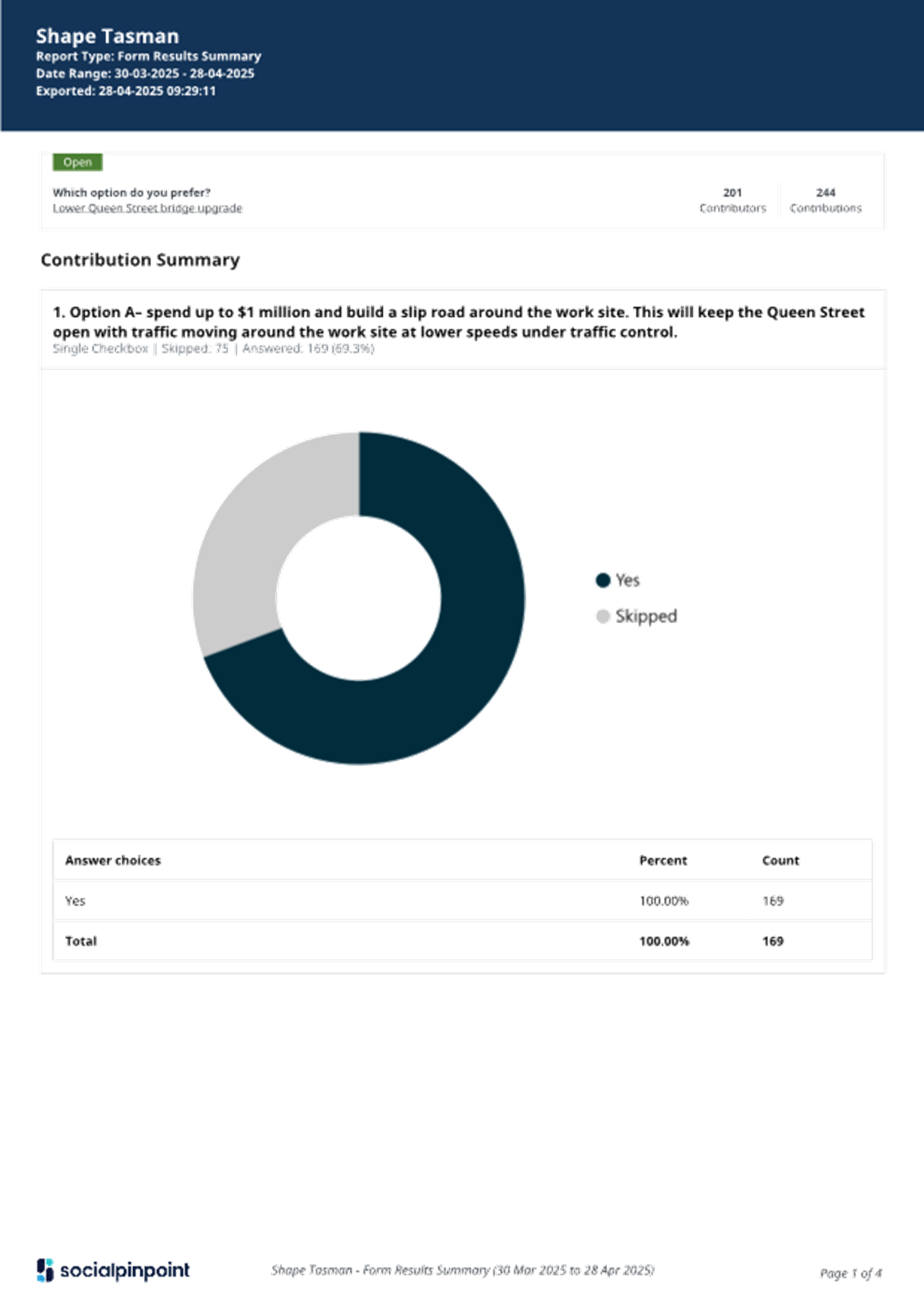

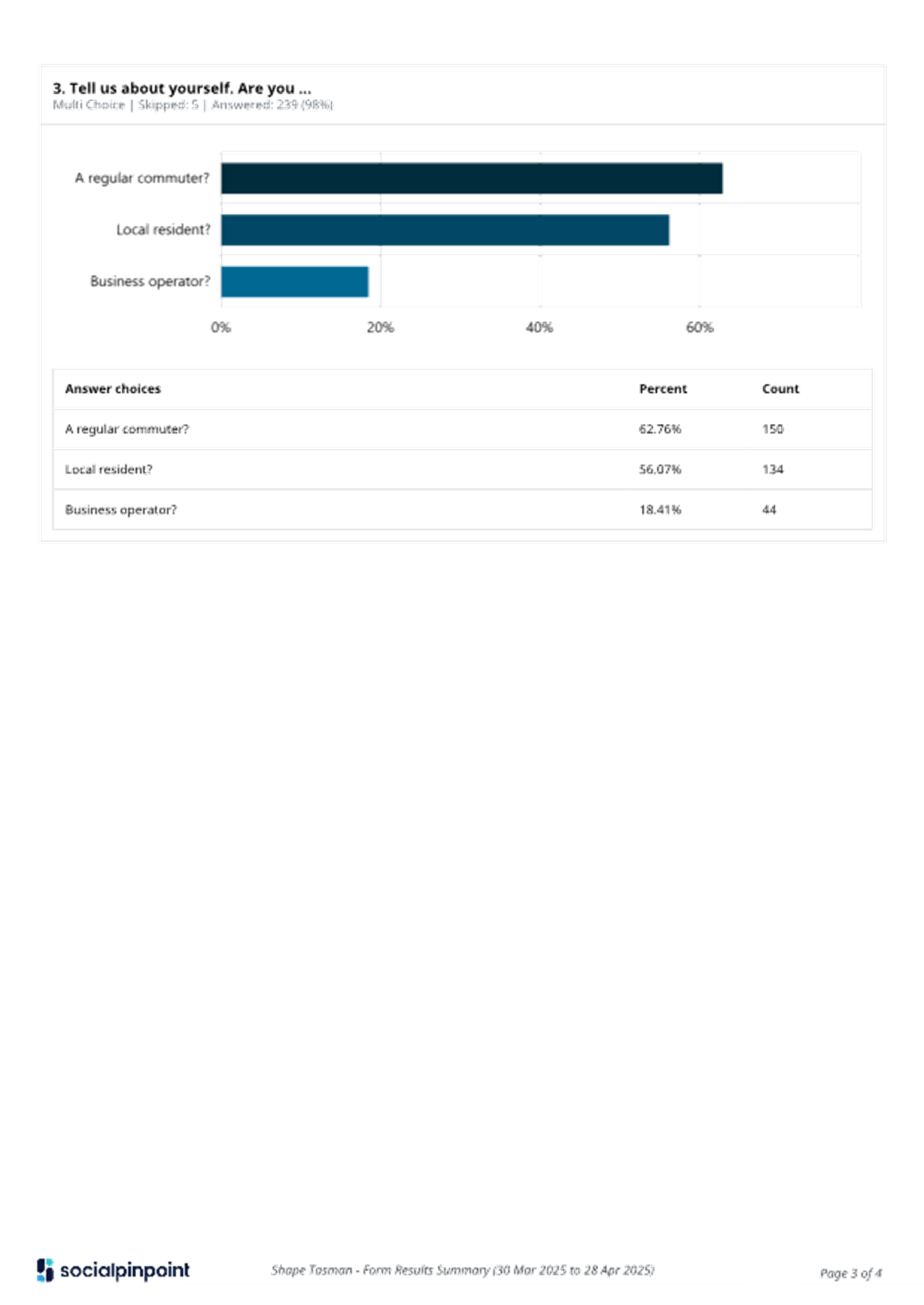

Tasman District Council Agenda – 08 May 2025
7.9 Amendments to Delegations Register
Decision Required
|
Report To:
|
Tasman District Council
|
|
Meeting Date:
|
8 May 2025
|
|
Report Author:
|
Lakan Beech, Legal Advisor; Leith Townshend, General
Counsel
|
|
Report Authorisers:
|
Steve Manners, Chief Operating Officer
|
|
Report Number:
|
RCN25-05-10
|
1. Purpose
of the Report / Te Take mō te Pūrongo
1.1 To amend and seek new statutory
delegations in the Tasman District Council Delegations Register identified as
part of the review of delegations in preparation for moving to LocoDelegations,
which is an all-digital delegations register designed specifically for local
government.
2. Summary
/ Te Tuhinga Whakarāpoto
2.1 The report requests approval of
amendments and new delegations under the following Acts, regulations and bylaws
that contain powers which are appended with tracked changes in Attachment 1.
2.2.1. Camping Grounds
Regulations 1985
2.2.2. Dog Control 1996
2.2.3. Food Act 2014
2.2.4. Freedom Camping Act 2011
2.2.5. Gambling Act 2003 and associated regulations
2.2.6. Health Act 1956
2.2.7. Health (Hairdressers) Regulations 1980
2.2.8. Health (Registration of Premises) Regulation 1966
2.2.9. Housing Improvement Regulations 1947
2.2.10. Impounding Act 1955
2.2.11. Local Government (Rating) Act 2002
2.2.12. Maritime Transport Act 1994
2.2.13. Navigation Safety Bylaw 2024
2.2.14. Public Water Supply Bylaw 2016
2.2.15. Reserves Act 1977
2.2.16. Sale and Supply of Alcohol Act 2012
2.2.17. Waste Minimisation Act 2008
2.2.18. Water Services Act 2021.
2.2 Certain legislation requires that only
the Council can delegate its powers and functions, and this applies to the
Local Government (Rating) Act 2002. Any changes, or additions, to delegations
under this statute must be made by the Council.
2.3 The Legal team has been undertaking a
review of the Council’s Delegations Register, with a particular focus on
the Council’s statutory delegations in Part Four, in preparation for
moving to LocoDelegations.
2.4 The Delegations Register will be updated
with any changes approved by the Council.
3. Recommendation/s
/ Ngā Tūtohunga
That the Tasman District Council:
1. receives the Amendments to Delegations Register Report, RCN25-05-10;
and
2. approves the proposed additions and changes to delegations as set
out in Attachment 1 to the agenda report, being an extract from the
Council’s Delegation Register with additions and changes to Part Four
– Statutory Delegations; and
3. notes that the Delegations Register will be updated to reflect
approved changes.
4.1 Delegations
are recorded against position titles, which necessitates review when
restructures occur to ensure that each role retains or gains the delegations
needed.
4.2 Certain legislation requires that only
the Council can delegate its powers and functions, and this applies to the
Local Government (Rating) Act 2002 (LGRA).
4.3 Restructure and changes to position
titles in the Water and Wastes and Regulatory teams team mean that there are
new roles and position titles within the resulting teams that require approval
for delegations from the Council.
4.4 In addition, a comprehensive review of
the Delegations Register has commenced in preparation for Tasman District
Council moving to a new online and searchable delegations register
(LocoDelegations).
5. Analysis
and Advice / Tātaritanga me ngā tohutohu
Reserves Act
1977
5.1 The Reserves Act 1977 provides that the
Council, as an administering body, may exercise certain powers over reserves
with the prior consent of the Minister of Conservation. In 2013, the Minister
of Conservation delegated certain Ministerial powers to the Council.
5.2 The administering body’s powers
are a decision-making function, whereby the merits of the proposal are
considered. The Minister’s consenting power is not a decision-making
power but a supervisory role in ensuring that the administering body’s
decision complies with Reserves Act 1977 requirements.
5.3 The current delegations register
delegates provisions that contain both delegated Ministerial powers and
administering body powers to the Chief Executive Officer and staff in the
Community Infrastructure Group without separating out the powers of the Minister
and administering body. As the Minister’s consenting power is a review
power, it is not appropriate that it is delegated to the same staff who
exercise the administering body’s powers.
5.4 The amended delegations propose to
remove delegations of Ministerial consenting powers to staff and delegate these
instead to either:
a. the Strategy and Policy
Committee for powers relating to reserve management planning and
classification; or
b. the Environment and
Regulatory Committee for operational reserve matters.
5.5 Staff will retain delegated
administering body powers unless there are public notice requirements that
require the decision to be made at the Council or Committee level. Some
existing delegations to committees will be removed where a full resolution of the
Council is required for decisions due to public notice requirements.
5.6 This report
seeks the following new delegations under the Reserves Act:
a. Section 23 –
this delegation will enable the Strategy and Policy Committee to prohibit
access to whole or any part of a reserve.
b. Section 26A – this delegation will
enable staff to apply for a record of title where the Minister of Conservation
has vested land in the Council as a reserve by gazette. Obtaining a record of
title is for evidentiary purposes only as the vesting takes place upon the
Minister declaring the land to be a reserve by Gazette notice, not upon the
issuing of a record of title.
c. Section 42(2) and (3) – this delegation
will enable Council staff to approve cutting and removing trees and undertake
other routine flora and fauna maintenance on reserves.
d. Section 45 –
this delegation will enable staff to erect or authorise erection of structures
described above on recreation or scenic reserves. The Strategy and Policy
Committee would have a supervisory role over staff’s decisions as the
delegate of the Minister’s consenting powers.
e. Section 54 (for purposes that require public
notification under the Reserves Act) - this delegation will enable the
Environment and Regulatory Committee to grant a lease or licence in reserve
land and structures on reserve land for purposes that require public
notification, which include baths, camping grounds, parking, mooring and sports
and recreation facilities.
f. Section
54 (for purposes that do not require public notification under the Reserves
Act) - this delegation will enable staff to grant a lease or licence in a
recreation reserve for purposes of a trade, business, or occupation. The
Environment and Regulatory Committee will have a supervisory role over staff
decisions as the delegate of the Minister’s consenting powers.
g. Section 61 – this delegation will enable the
Environment and Regulatory Committee to grant leases over local purposes
reserves for community buildings, playcentre, kindergartens, farming, grazing,
cultivation or other cropping purposes where the lease would require public
notification under the Local Government Act 2002 due to being of medium to high
significance. Staff will retain the delegation to grant leases and licences
over local purpose reserves under this section where those leases or licences
would be of low significance.
h. Section 72 – this delegation will enable
staff to enter an agreement or lease for farming or grazing of a local purpose
or recreational reserve. The Environment and Regulatory
Committee will have a supervisory role over staff decisions as the delegate of
the Minister’s consenting powers.
i. Section 95(5) - this delegation will
enable the Chief Executive Officer and Group Manager, Community Infrastructure
to authorise staff to dispose of structures erected on Council reserve land
without consent.
j. Section 113 - this delegation
will enable staff to develop and determine templates or forms for a licence and
any conditions of a licence granted by the Council.
k. Section 114 - this delegation will enable
staff to vary terms and conditions of a lease or licence over a reserve.
l. Section 115 – this delegation will enable
staff to consent to a transfer, sublease or mortgage of a lease or licence
granted by Council over a reserve
Camping-Grounds Regulations 1985, Dog
Control Act 1996, Food Act 2014, Freedom Camping Act 2011, Gambling Act 2003
and associated regulations, Health Act 1956, Health (Hairdressers) Regulations
1980, Health (Registration of Premises) Regulation 1966, Housing Improvement
Regulations 1947, Impounding Act 1955, Maritime Transport Act 1994, Sale and
Supply of Alcohol Act 2012
5.7 These Acts contain powers that are
exercised by staff in the Environmental Assurance group. The proposed changes
reflect changes to staff position titles and new delegations added as part of
the review of Statutory Delegations within the LocoDelegations project, to
ensure robustness of delegations to staff.
5.8 In late 2023, the Regulatory team was
restructured resulting in the Harbourmaster’s reporting line changing
from the Regulatory Manager to the Group Manager, Environmental Assurance. The
positions of Dog Ranger and Parking Warden were amalgamated and renamed
Regulatory Services Enforcement Officers.
5.9 The following are new delegations under
the Camping-Grounds Regulations 1985:
a. Regulation 15 – this
delegation will enable staff to enforce Camping-Ground Regulations and inspect
camping grounds and relocatable homes.
5.10 The following are new delegations under the Dog
Control Act 1996:
a. Section 33EB - this
delegation will enable staff to require neutering of a menacing dog.
b. Section 33ED - this
delegation will enable staff to classify a dog as dangerous or menacing.
c. Section 34 – this
delegation will enable staff to determine whether to include additional
information in the dog register.
d. Section 67 - this delegation
will enable staff to maintain and operate pound facilities and enter
agreements.
e. Section 70 -– this
delegation will enable staff to retain, return and dispose of a dog removed for
barking.
5.11 The following are new delegations under the Food
Act 2014:
a. Section 61A - this delegation
will enable staff to require an operator to amend a food control plan that is
not based on an official template if that plan cannot be readily understood by
the Council or an operator.
b. Section 338 - this delegation
will enable staff to give effect to a court order against a person who has
breached the Food Act 2014 and recover any costs and expenses incurred in
complying with that court order with the court’s consent.
5.12 The following are new delegations under the Health
Act 1956
a. Section 53C - this
delegation will enable staff to make advances to owners to undertake cleaning
or repairs to comply with a Health Act notice.
b. Section 81 - this
delegation will enable staff to authorise an environmental health officer to
cleanse and disinfect premises to limit, eradicate or prevent the spread of an
infectious disease.
c. Section 86 –
this delegation will enable staff to bury bodies where a person has died in
such a state as to be dangerous to health and recover the costs of that burial.
d. Section 128 –
this delegation will enable staff to authorise an officer of health, health
protection officer or other person to enter a building, land, ship or other
premises to carry out works required under the Health Act 1956.
5.13 The following are new delegations under the Health
(Hairdressers) Regulations 1980:
a. Regulation 3 –
this delegation will enable staff to issue certificates of registration for
hairdresser shops.
5.14 The following are new delegations under the Health
(Registration of Premises) Regulation 1966:
a. Regulation 4 – this
delegation will enable staff to require particular information to be included
in an application for registration.
5.15 The following are new delegations under the
Impounding Act 1955:
a. Section 10 - this delegation
will enable the Chief Executive Officer and Group Manager, Environmental
Assurance to remove or suspend a pound keeper or ranger.
b. Section 12 - this
delegation will enable the Chief Executive Officer and Group Manager,
Environmental Assurance to direct pounds to be kept clean and confine stock
infected with a contagious disease in separate enclosures.
c. Section 32 - this delegation
will enable the Chief Executive Officer and Group Manager, Environmental
Assurance to declare any fenced paddock to be a temporary pound with the
occupier’s consent and appoint a keeper.
d. Section 38 - this delegation
will enable the Chief Executive Officer and Group Manager, Environmental
Assurance to issue a public notice calling the owner of wild stock trespassing
on land to remove their stock. If not removed, those staff members may authorise
the sale of the stock by public auction.
e. Section 42 - this delegation
will enable the Chief Executive Officer and Group Manager, Environmental
Assurance to authorise pound keepers or rangers to destroy wild stock straying
on roads and dispose of carcasses of any destroyed stock.
f. Section 50 - this
delegation will enable the Chief Executive Officer and Group Manager,
Environmental Assurance to authorise a pound keeper or other person to act as
an auctioneer for an auction of impounded stock.
g. Section 52 - this delegation
will enable the Chief Executive Officer and Group Manager, Environmental
Assurance to arrange the destruction of an animal certified by a justice,
constable, inspector of stock or registered veterinarian to be worthless or suffering
due to sickness or injury.
h. Section 53 - this delegation
will enable the Chief Executive Officer and Group Manager, Environmental
Assurance to dispose of unsold stock that has been unsuccessfully offered for
sale.
5.16 The following are new delegations under the
Maritime Transport Act 1994:
a. Section
200A – this delegation will enable the Group Manager, Environmental
Assurance and Harbourmaster to apply to the Minister of Transport to declare a
major maritime event or occasion. This declaration enables enforcement officers
to exercise the powers of a Harbourmaster and other special enforcement powers
specified in section 200B to maintain order and safety in a major maritime
event or occasion.
b. Section 200B –
this delegation will enable the Chief Executive Officer and Group Manager,
Environmental Assurance to appoint enforcement officers for a major maritime
event or occasion.
Navigation Safety Bylaw 2024
5.17 One new delegation is sought under the Navigation
Safety Bylaw 2024:
a. Clause 49.3 –
this delegation will enable the Environment and Regulatory Committee, on the
recommendation of the Harbourmaster, to determine requests to be exempted from
requirements of the Navigation Safety Bylaw 2024. These requests are often for
technical reasons, such as an individual vessel being unable to meet the
requirement to use the automatic identification system (AIS) due to a lack of
AIS coverage in their area. This delegation will save the Council time and
increase efficiency in processing exemption requests.
Local Government (Rating) Act 2002
(LGRA)
5.18 Under the current delegations register, LGRA powers
are delegated to the Chief Executive Officer, Chief Financial Officer, Finance
Group managers and Water and Wastes staff to administer rate remission and
postponement policies, including the Policy on Remission of Excess Metered
Water Rates.
5.19 In practice, the Water and Wastes team apply water
rate remission policies to determine ratepayer applications to remit or
postpone water rates, but do not administer this policy. The Finance Group is
responsible for administering all rate remission and postponement policies. The
proposed changes seek to change the water rate remission delegations to better
reflect operational practices by:
a. removing delegations to staff
in the Water and Waste team to administer rate remission policies; and
b. delegating the power to
determine ratepayer applications made under the Policy on Remission of Excess
Metered Water Rates to the Community Infrastructure Group Manager and Water and
Wastes staff.
Public Water Supply Bylaw 2016
5.20 In the Council’s current delegations
register, Public Water Supply Bylaw 2016 delegations are broadly recorded in
the ‘Management’ part of the Delegations Register. However, these
delegations are statutory because they are contained in the Bylaw and should be
moved to the Statutory part of the delegations register.
5.21 Two new delegations are sought under the Public
Water Supply Bylaw 2016:
a. Clause 29(8) – this
delegation will enable a Standing Committee to issue a notice restricting or
prohibiting where a Standing Committee meeting falls before a Council meeting.
This will allow for efficiency and quicker processing of public water restriction
notices.
b. Clause 29(9) – this
delegation will enable the Group Manager, Community Infrastructure to issue a
notice restricting or prohibiting the use of public water supply for phases A
to D of the Water Restrictions Protocol in the Bylaw, and to amend or revoke
such notice.
Waste Minimisation Act 2008
5.22 The report requests two new delegations to the
Chief Executive Officer:
a. Section 76 – this will
enable the Chief Executive Officer to appoint enforcement officers.
b. Section 85 – this will
enable the Chief Executive Officer to authorise staff to dispose of property
seized and impounded under the Act has not been returned to its owner within
six months, to enable quicker processing and save Council meeting time.
Water Services Act 2021
5.23 The report requests the following new delegations
to staff under Water Services Act 2021:
a) Subpart 1 - ensure compliance with the duties of a
drinking water supplier.
b) Section 35 – this delegation will enable staff
to notify Taumata Arowai of a notifiable risk or hazard.
c) Section 35A – this delegation will enable staff
to respond to a notice of domestic self-supply about contamination, make
assessments and take any steps.
d) Section 43 – this delegation will enable staff
to prepare and implement a source water risk management plan (as a drinking
water supplier) and contribute to development of plan (as a local authority).
e) Section 56 – this delegation will enable staff
to apply for renewal as a drinking water supply and notify Taumata Arowai of
any changes to information provided at time of registration.
f) Section 89 – this delegation will enable
staff to apply to Taumata Arowai for an internal review of a decision.
g) Sections 93, 95 and 96 – these delegations will
enable staff to appeal through the courts against a Taumata Arowai decision on
compensation under section 64(5), an internal review under section 90 or a
compliance order under section 120.
h) Section 139 - this delegation will enable staff to
prepare and implement a risk management plan for the wastewater network and
provide the draft and final risk management plan to Taumata Arowai.
6.1 The options are outlined in the
following table:
|
Option
|
Advantage
|
Disadvantage
|
|
1.
|
Approve the proposed changes to the Delegations
Register
|
Enables efficiency in delivering
services. Ensures legislative compliance through committees and staff having
the correct delegations for their roles, thereby reducing risk for the
Council.
|
No disadvantages to the proposed changes
which are required by legislation.
|
|
2.
|
Do not approve the proposed changes to
the Delegations Register or only approve in part.
|
No advantages to not approving the
proposed changes which are required by legislation.
|
Impacts on efficiency in delivering
services. Reduces legislative compliance and creates risk for the Council.
|
6.2 Option 1 is recommended.
7.1 The LGRA restricts the sub-delegation of
powers. Delegated authority needs to come directly from the Council.
7.2 Councils operate under a plethora of
legislation daily. Many statutes, particularly older ones, give powers and
functions to the Council and do not provide for direct delegations to staff.
This means councils must work through each Act (and their bylaws, policies
etc.) and decide on levels of delegated authority.
7.3 The development of a sector specific
tool such as LocoDelegations (complete with legal review) is accordingly very
welcome and anticipated to improve the level of compliance and robustness of
delegations in councils. It will also assist the Council in remaining abreast
of legislative changes which could impact on delegations.
7.4 There are three consequential amendments
to the ‘Management’ part of the Delegations Register resulting from
the statutory delegation amendments. These are recorded in Attachment 1.
8. Iwi
Engagement / Whakawhitiwhiti ā-Hapori Māori
8.1 Due to delegations being operational by
nature, no engagement has been undertaken with iwi.
9. Significance
and Engagement / Hiranga me te Whakawhitiwhiti ā-Hapori Whānui
9.1 The proposed changes to the Delegations
Register are considered of low significance and no community engagement and
consultation has been required.
|
|
Issue
|
Level of
Significance
|
Explanation of
Assessment
|
|
1.
|
Is there a high level
of public interest, or is decision likely to be controversial?
|
Low
|
Generally,
delegations are a matter for the Council to ensure that the Council can
operate as efficiently as possible.
|
|
2.
|
Are there impacts on
the social, economic, environmental or cultural aspects of well-being of the
community in the present or future?
|
Low
|
Staff may be
appointed and/or authorised as enforcement officers who will interact with
members of the public on a daily basis in relation to many functions of the
Council so it is important that staff hold appropriate delegations to make
decisions which can have a positive or not so positive impact on those
customers.
|
|
3.
|
Is there a
significant impact arising from duration of the effects from the decision?
|
Low
|
Ensuring delegations
are in place helps to improve services for customers and at the same time,
reduce risk to the Council.
|
|
4.
|
Does the decision
relate to a strategic asset? (refer Significance and Engagement Policy for
list of strategic assets)
|
Low
|
Some delegations to
staff may relate to responsibilities for the management and maintenance of
the Council’s assets.
|
|
5.
|
Does the decision
create a substantial change in the level of service provided by Council?
|
NA
|
No substantial change
anticipated.
|
|
6.
|
Does the proposal,
activity or decision substantially affect debt, rates or Council finances in
any one year or more of the LTP?
|
NA
|
|
|
7.
|
Does the decision
involve the sale of a substantial proportion or controlling interest in a CCO
or CCTO?
|
NA
|
|
|
8.
|
Does the proposal or
decision involve entry into a private sector partnership or contract to carry
out the deliver on any Council group of activities?
|
NA
|
|
|
9.
|
Does the proposal or
decision involve Council exiting from or entering into a group of
activities?
|
NA
|
|
|
10.
|
Does the proposal
require particular consideration of the obligations of Te Mana O Te Wai
(TMOTW) relating to freshwater or particular consideration of current
legislation relating to water supply, wastewater and stormwater
infrastructure and services?
|
Low
|
Some delegations to
staff of Water Services Act 2021 responsibilities and powers.
|
10. Communication
/ Whakawhitiwhiti Kōrero
10.1 Managers have been involved in proposing changes to
the Delegations Register and to delegations to their staff and will be advised
if these are approved.
11. Financial
or Budgetary Implications / Ngā Ritenga ā-Pūtea
11.1 There are no financial implications for the Council
approving the proposed changes to the Delegations Register.
12.1 If the Council does not delegate to staff, every
decision would require a decision of the Council, which would be inefficient.
12.2 It is important for staff to hold delegated
authority from the Council or the Chief Executive Officer to enable them to
carry out their powers, duties, and functions, otherwise risk can be created
for the Council if unauthorised decisions are challenged.
13. Conclusion
/ Kupu Whakatepe
13.1 Ensuring correct delegations are in place for
decision making and other powers and functions is essential. It is recommended
that the proposed changes and amendments to the Delegations Register be
approved by the Council.
14. Next
Steps and Timeline / Ngā Mahi Whai Ake
14.1 The Delegations Register will be updated with the
proposed changes once approved by the Council.
14.2 Staff will continue to review the delegations
register in preparation for moving to LocoDelegations. Further changes to the
Delegations Register will be brought to the Council in the coming months as
staff work towards implementation of LocoDelegations.
|
1.⇩
|
Proposed
Amendments to Delegation Register
|
102
|
Tasman District
Council
Agenda – 08 May 2025




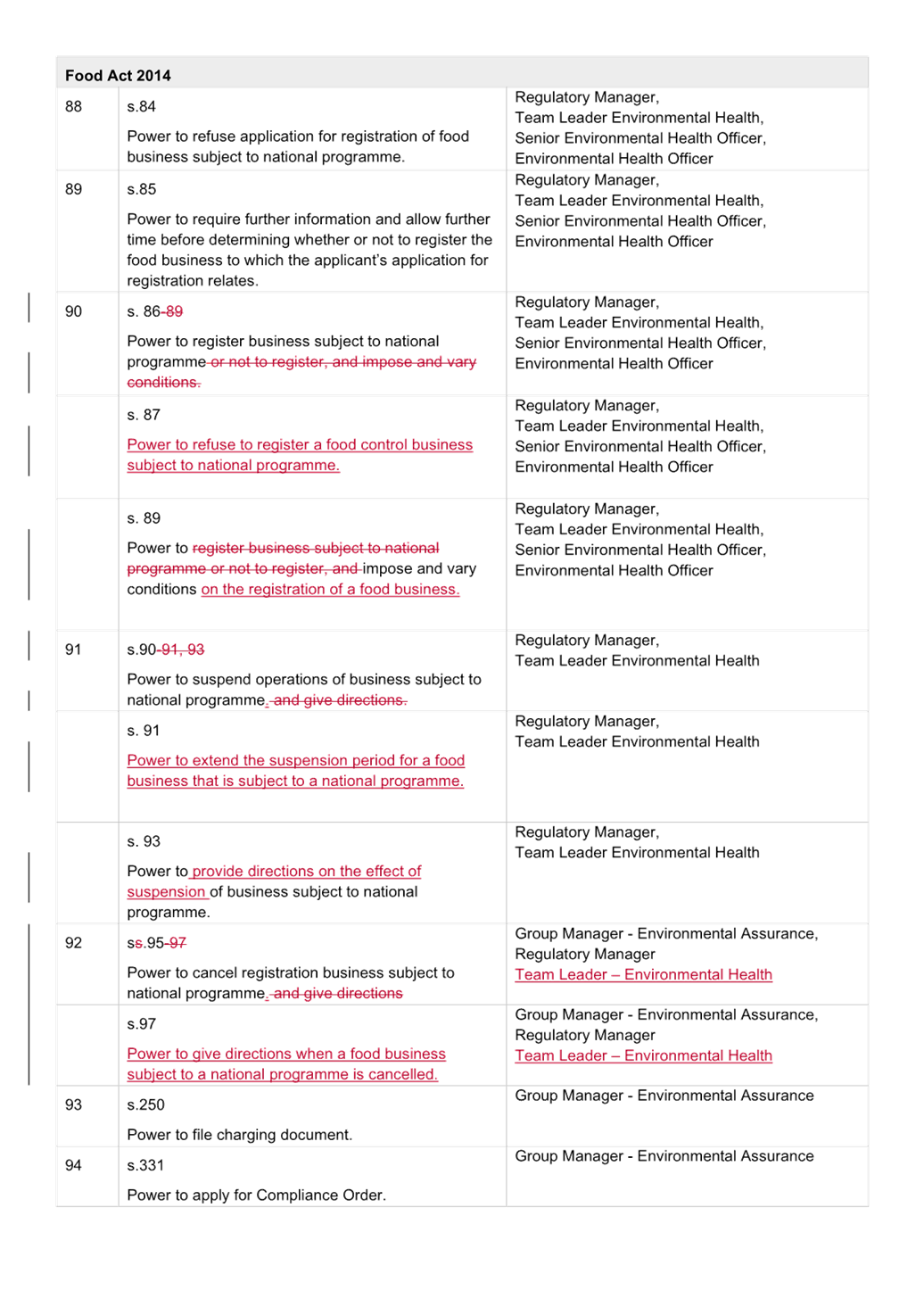
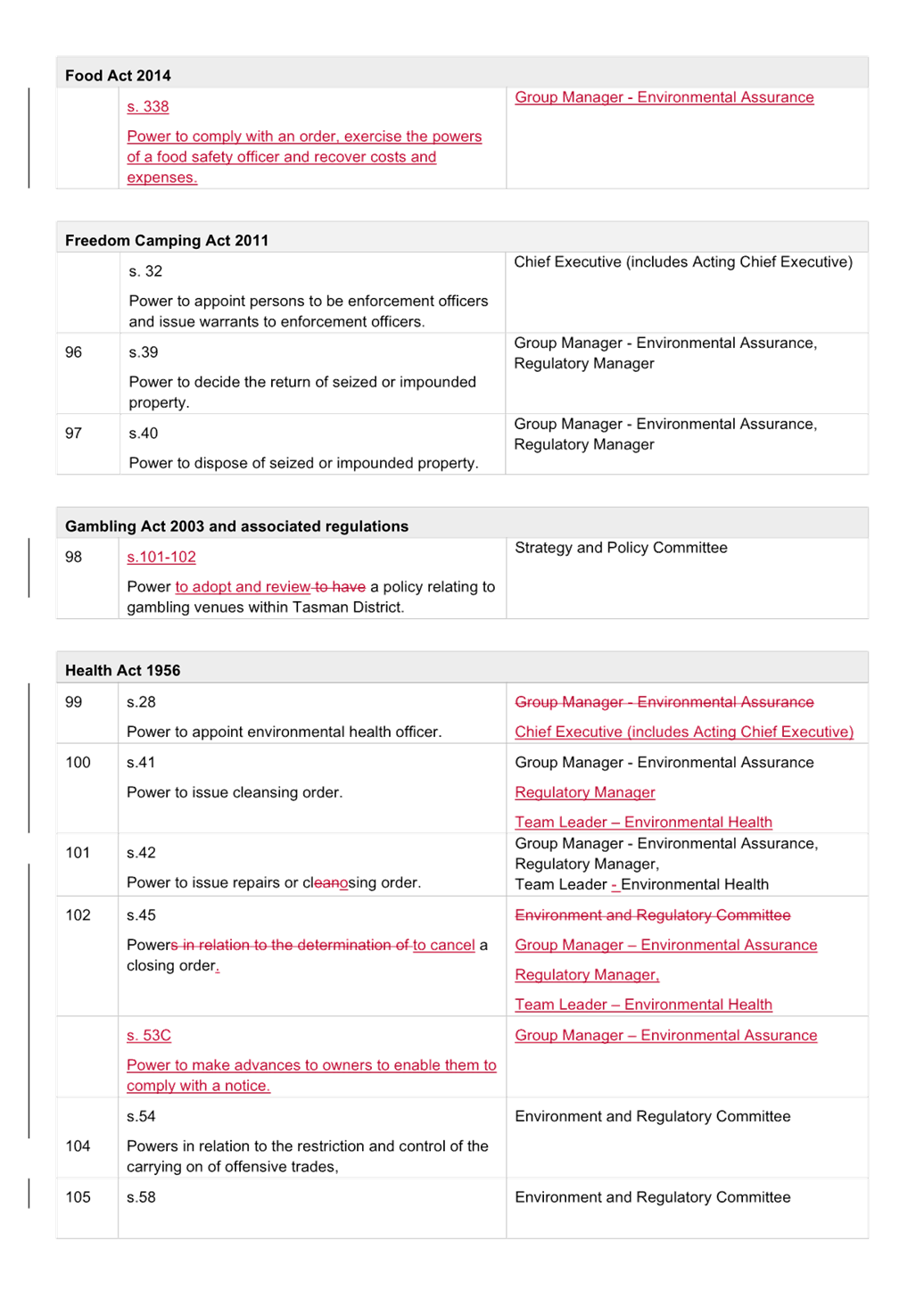
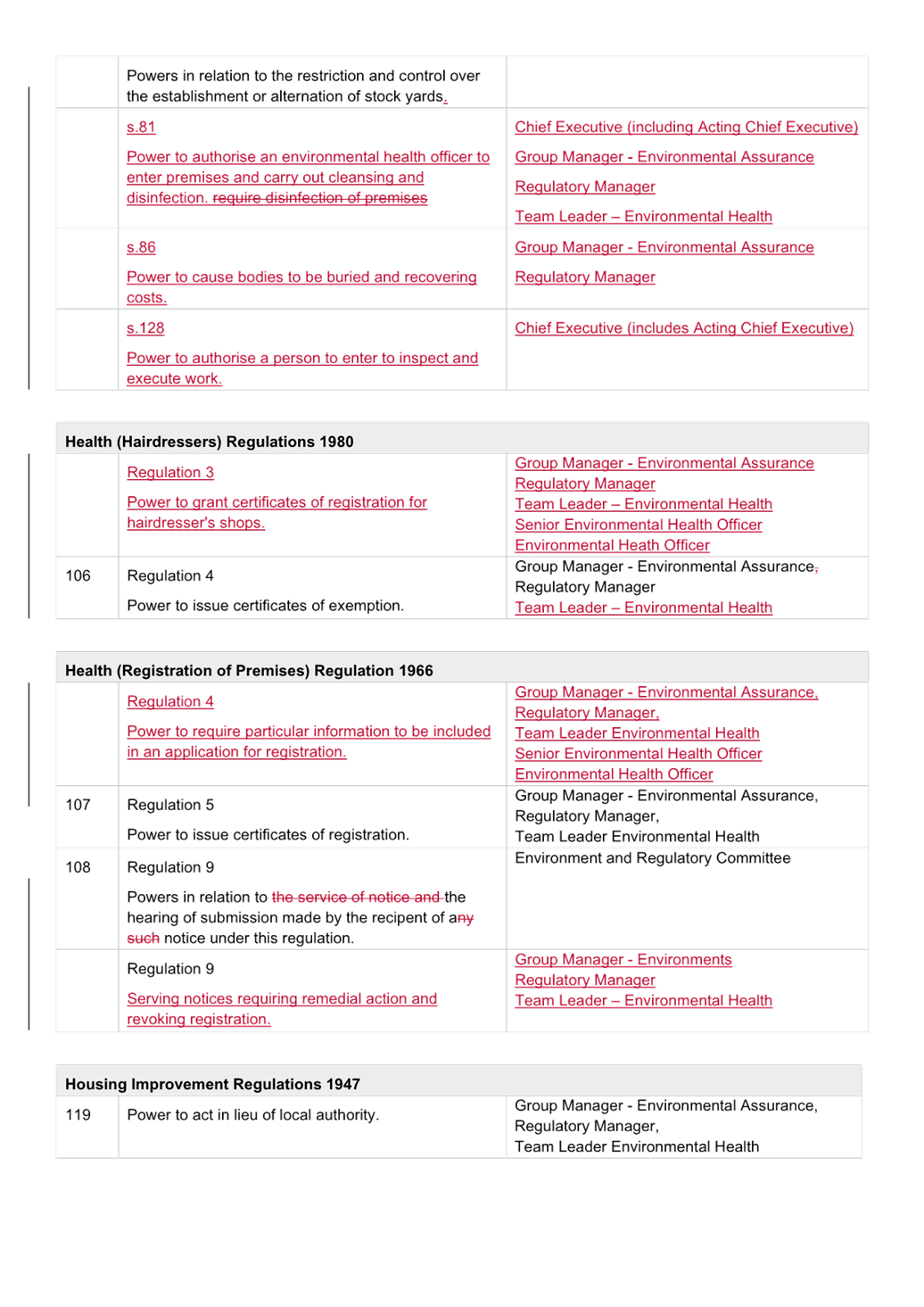

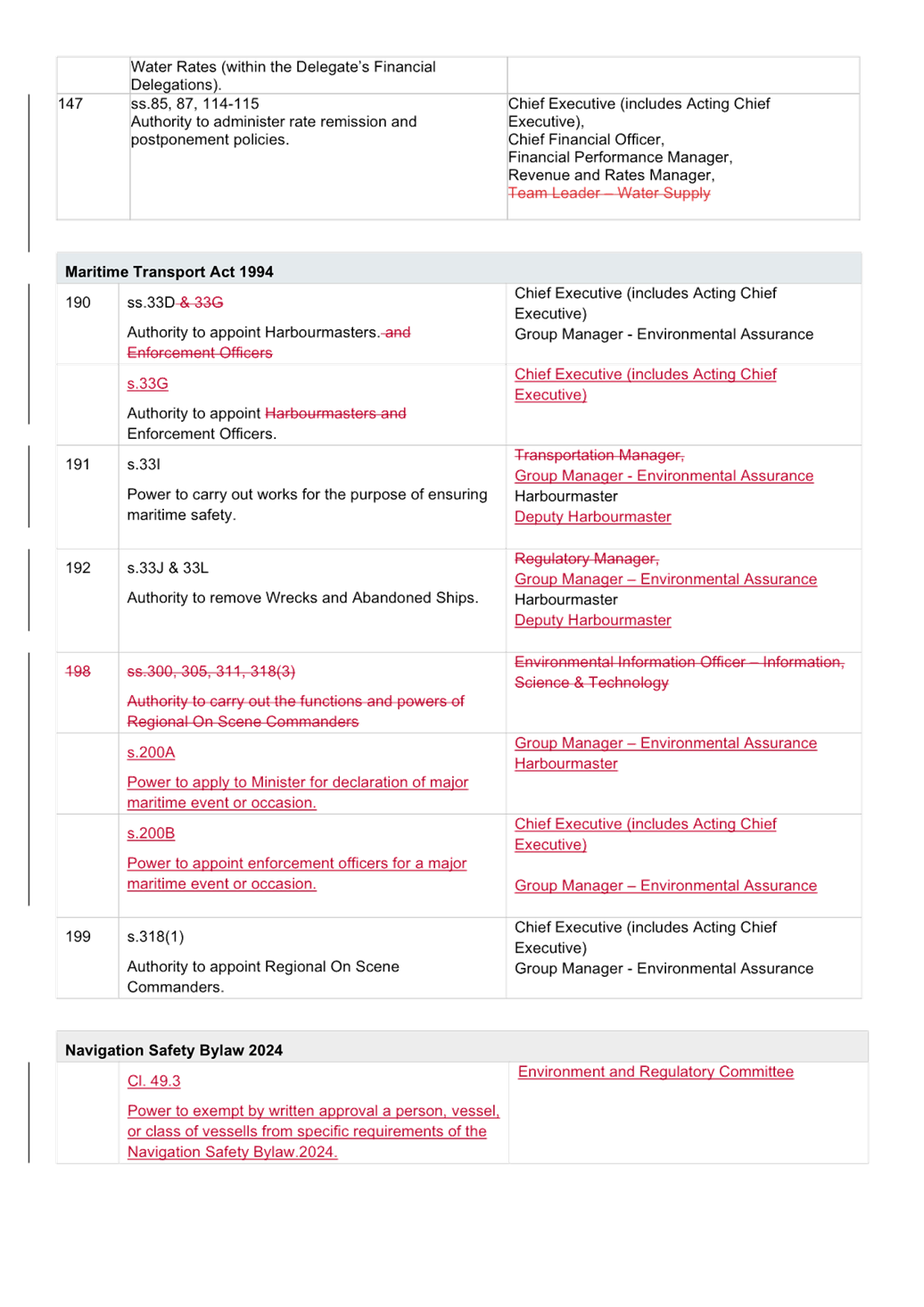
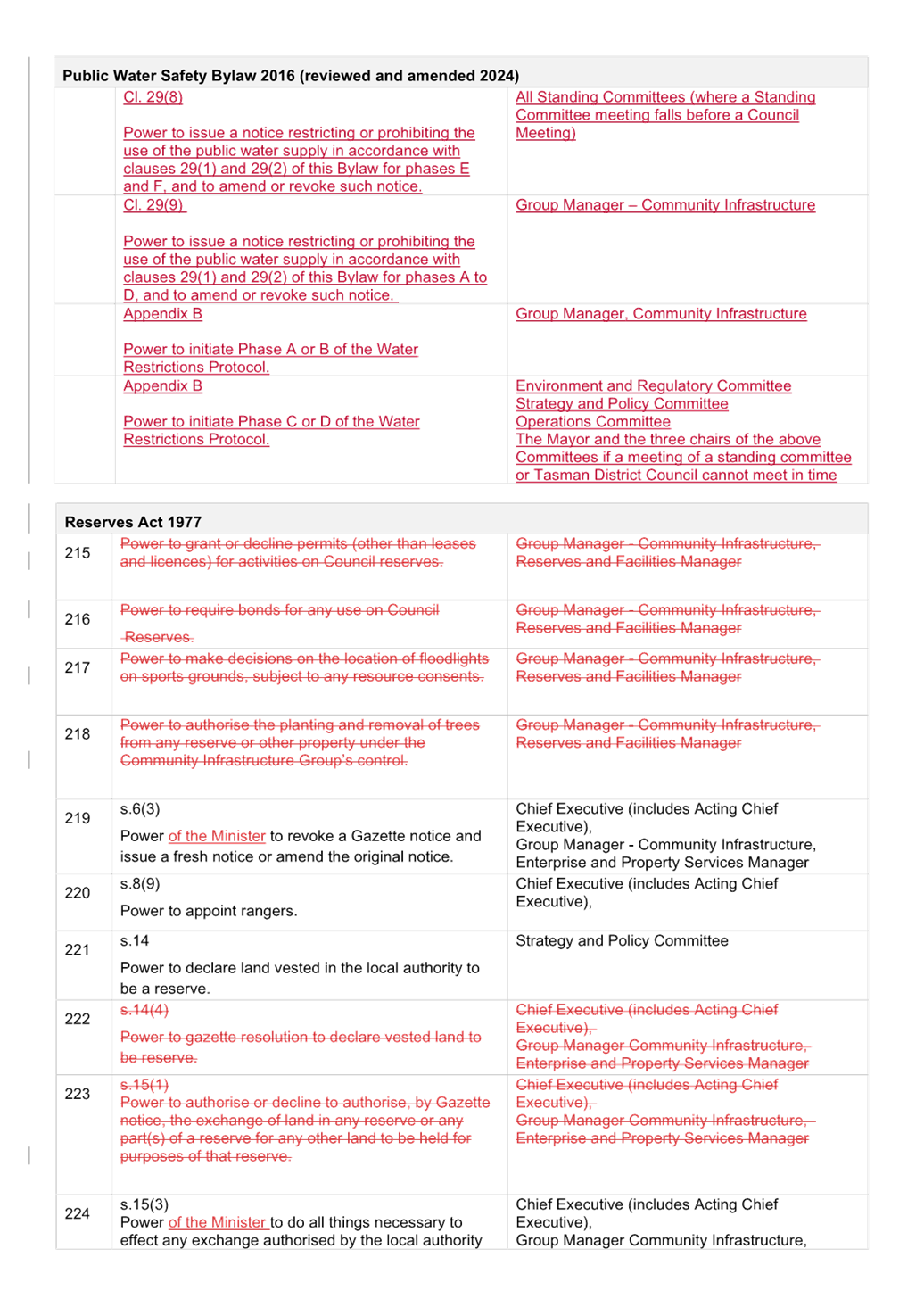
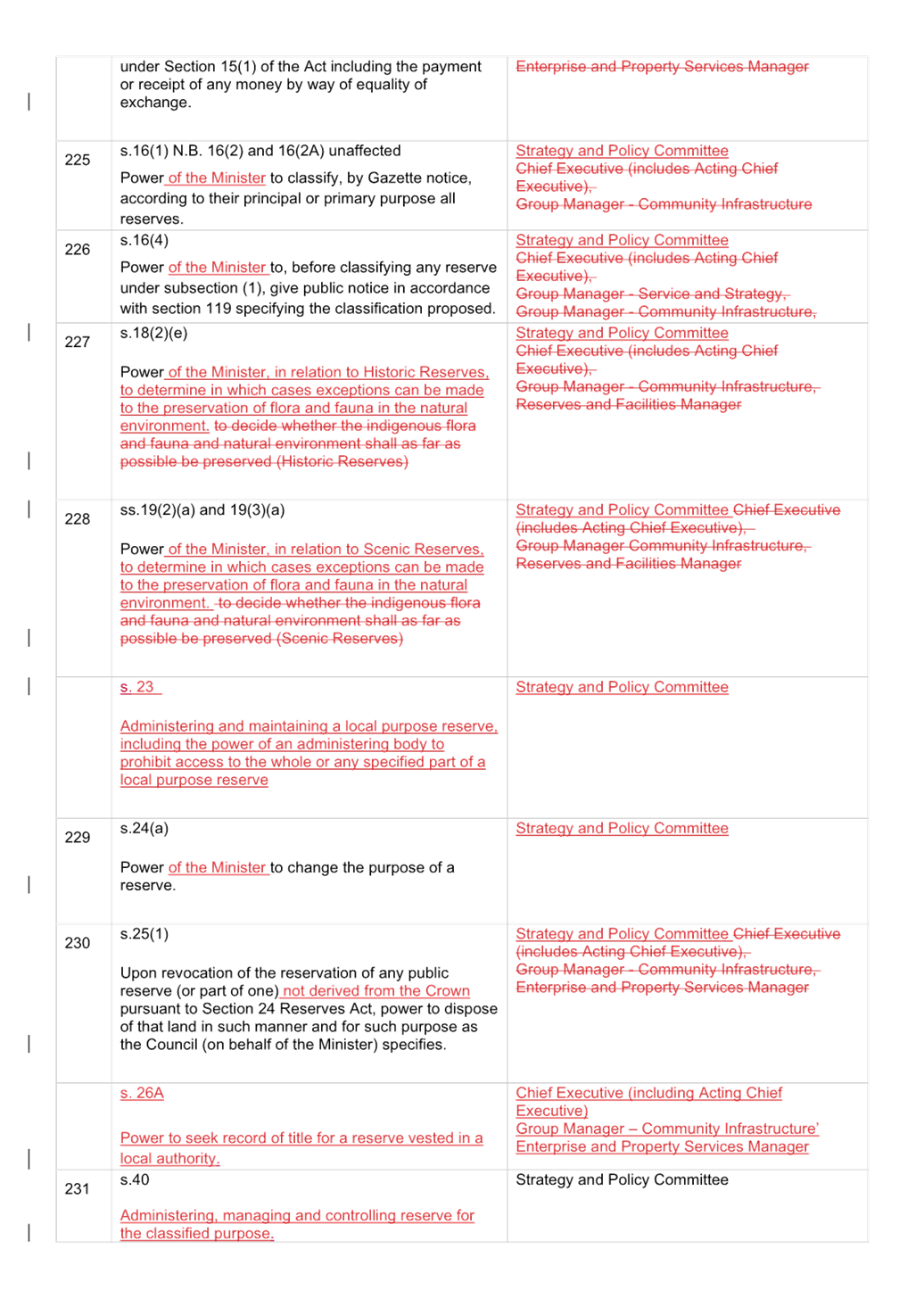
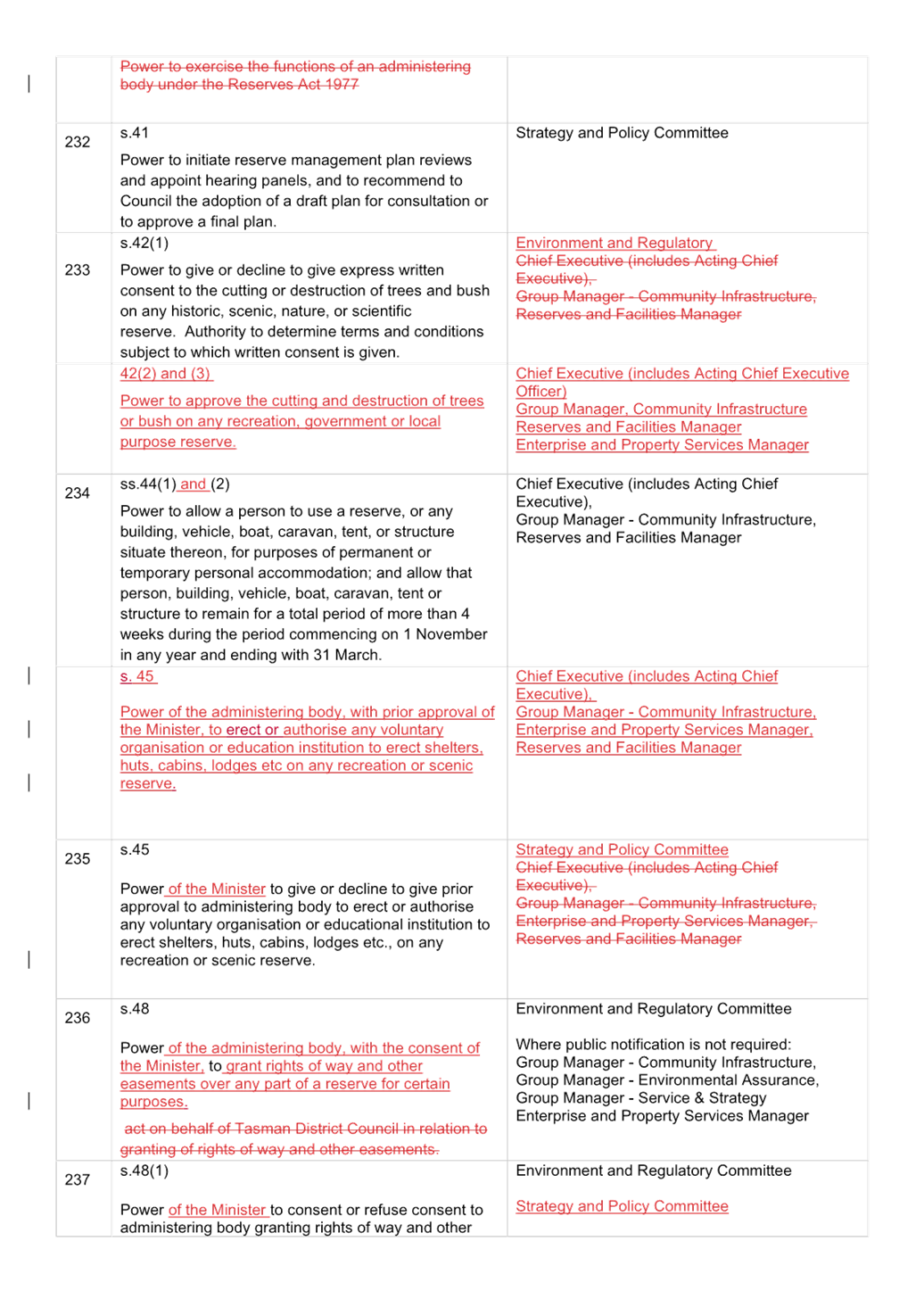
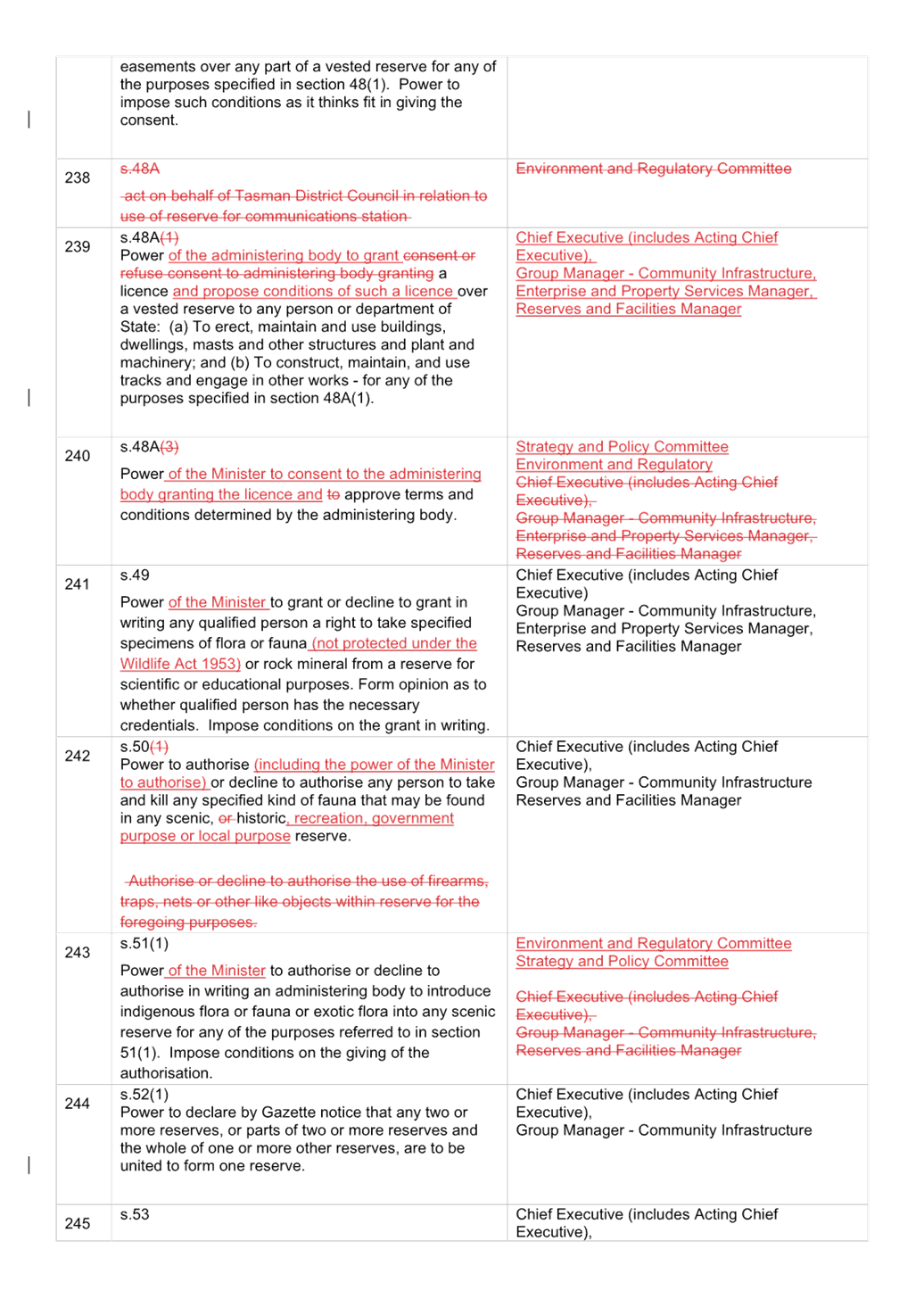
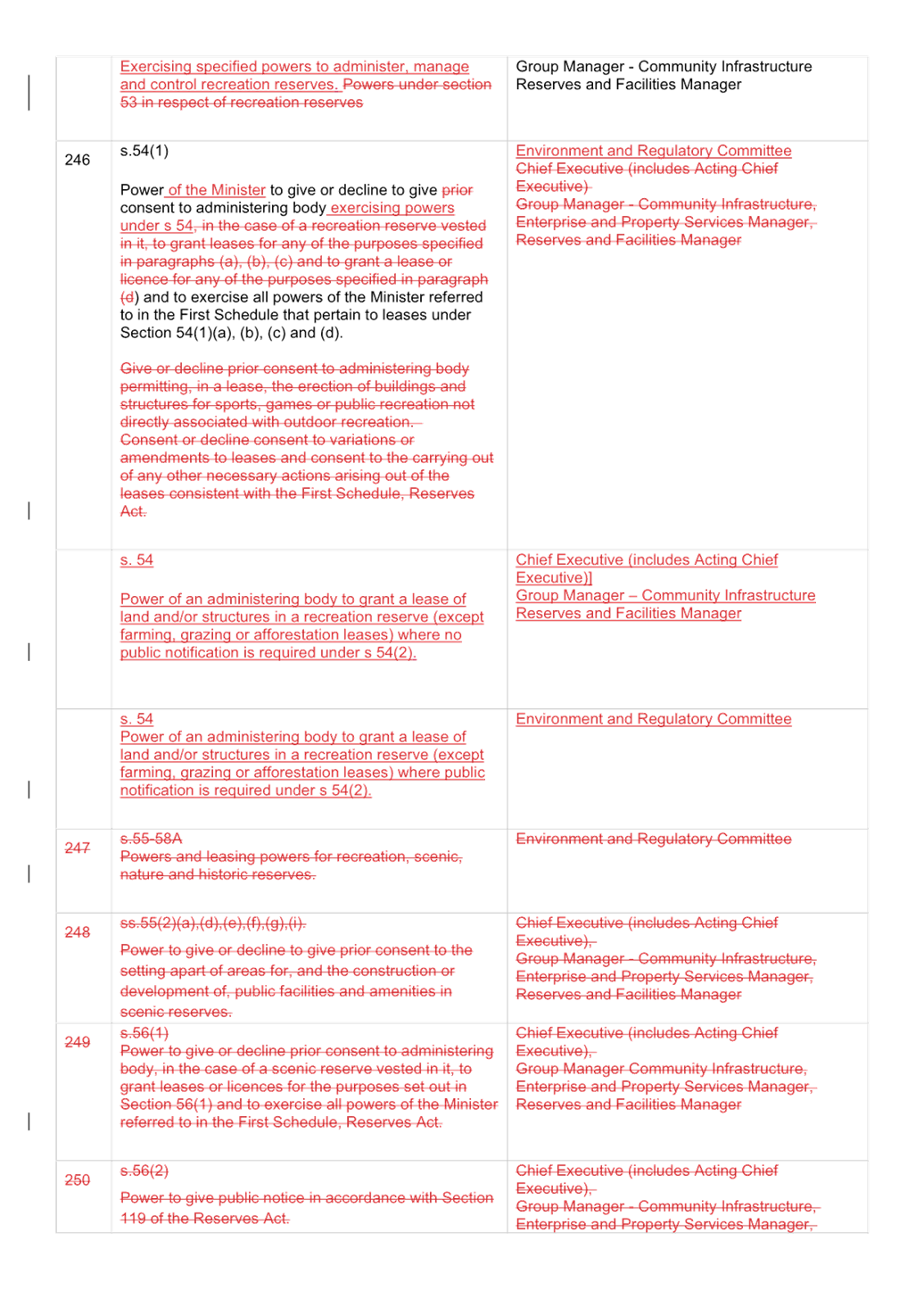
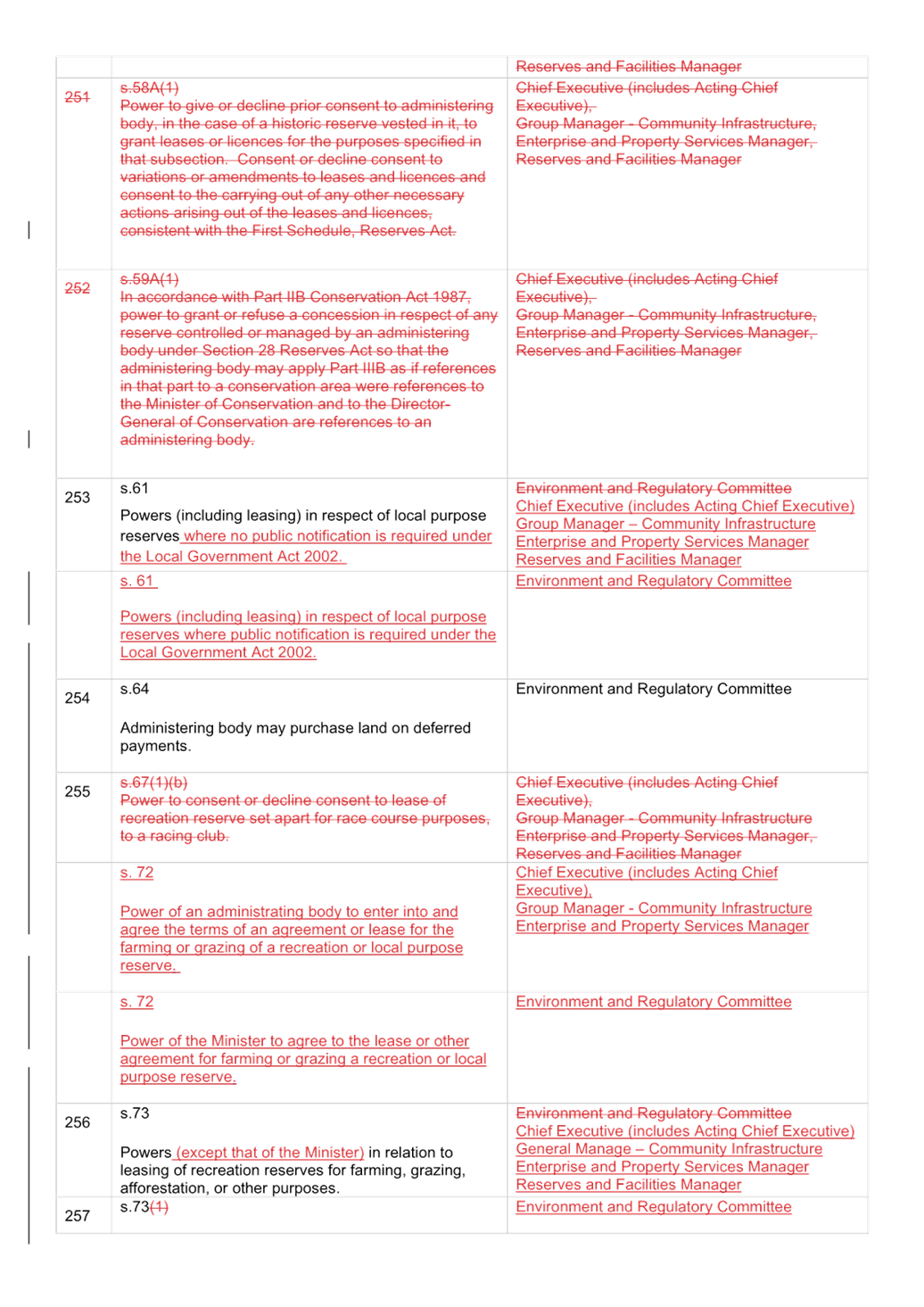
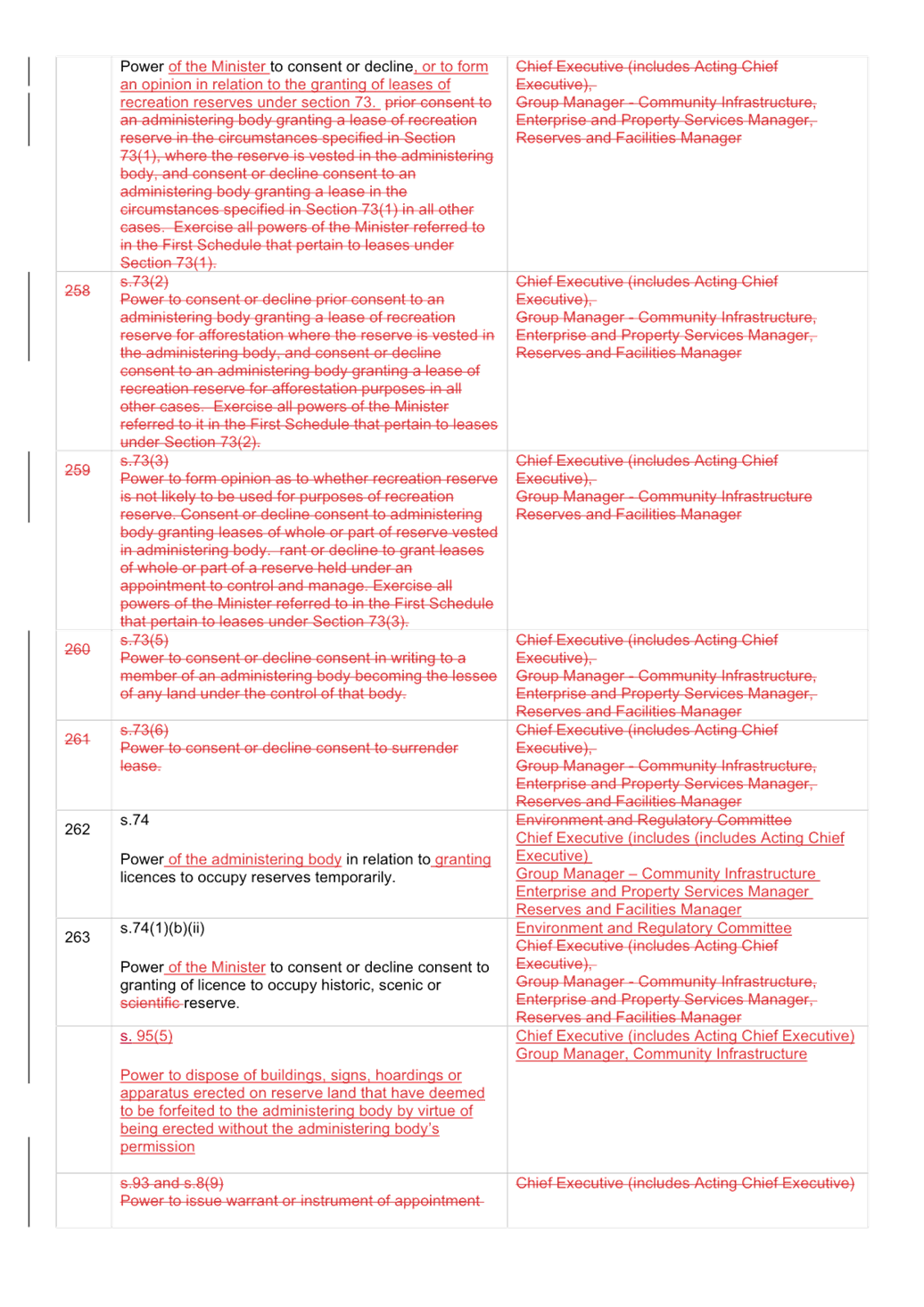
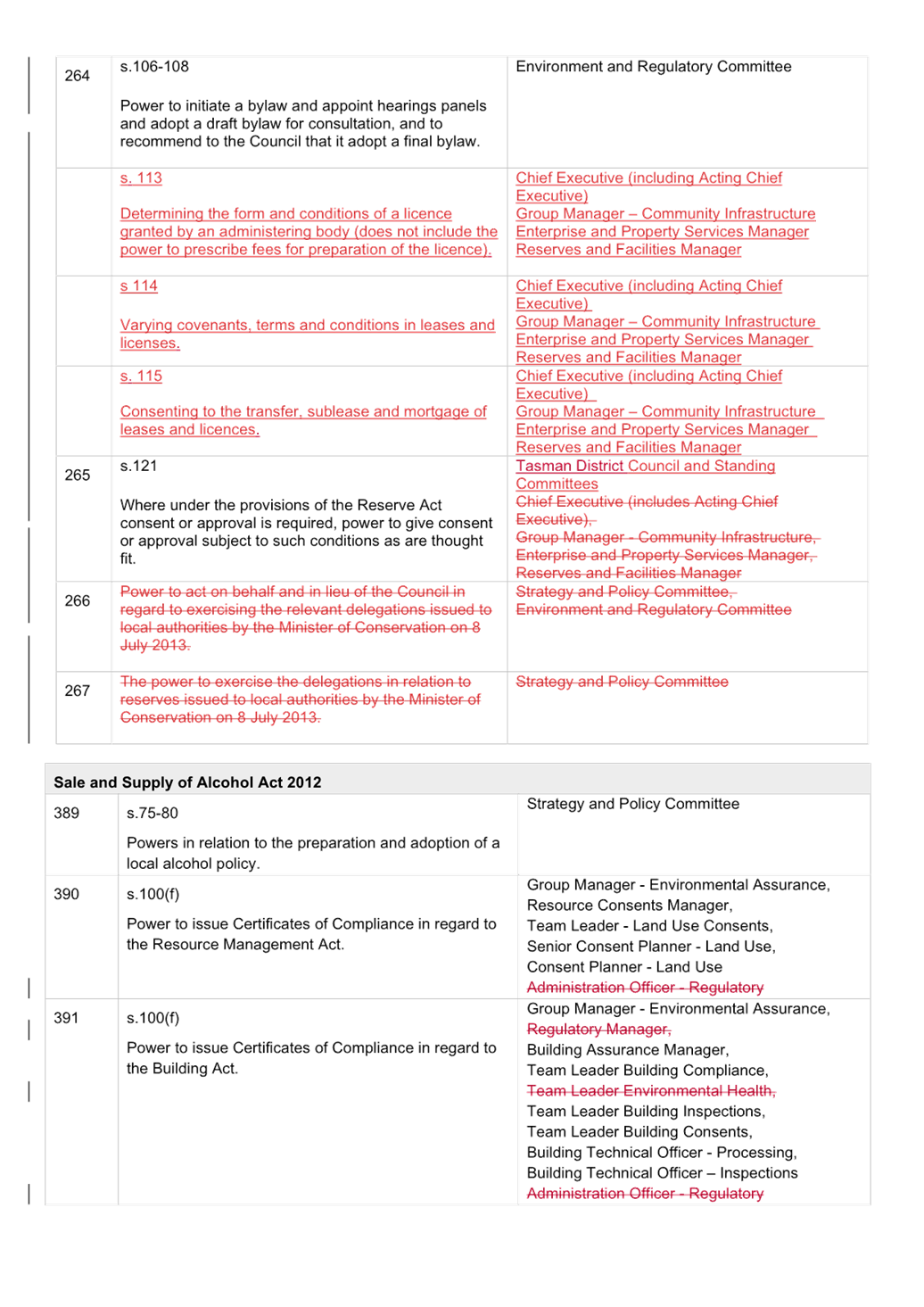
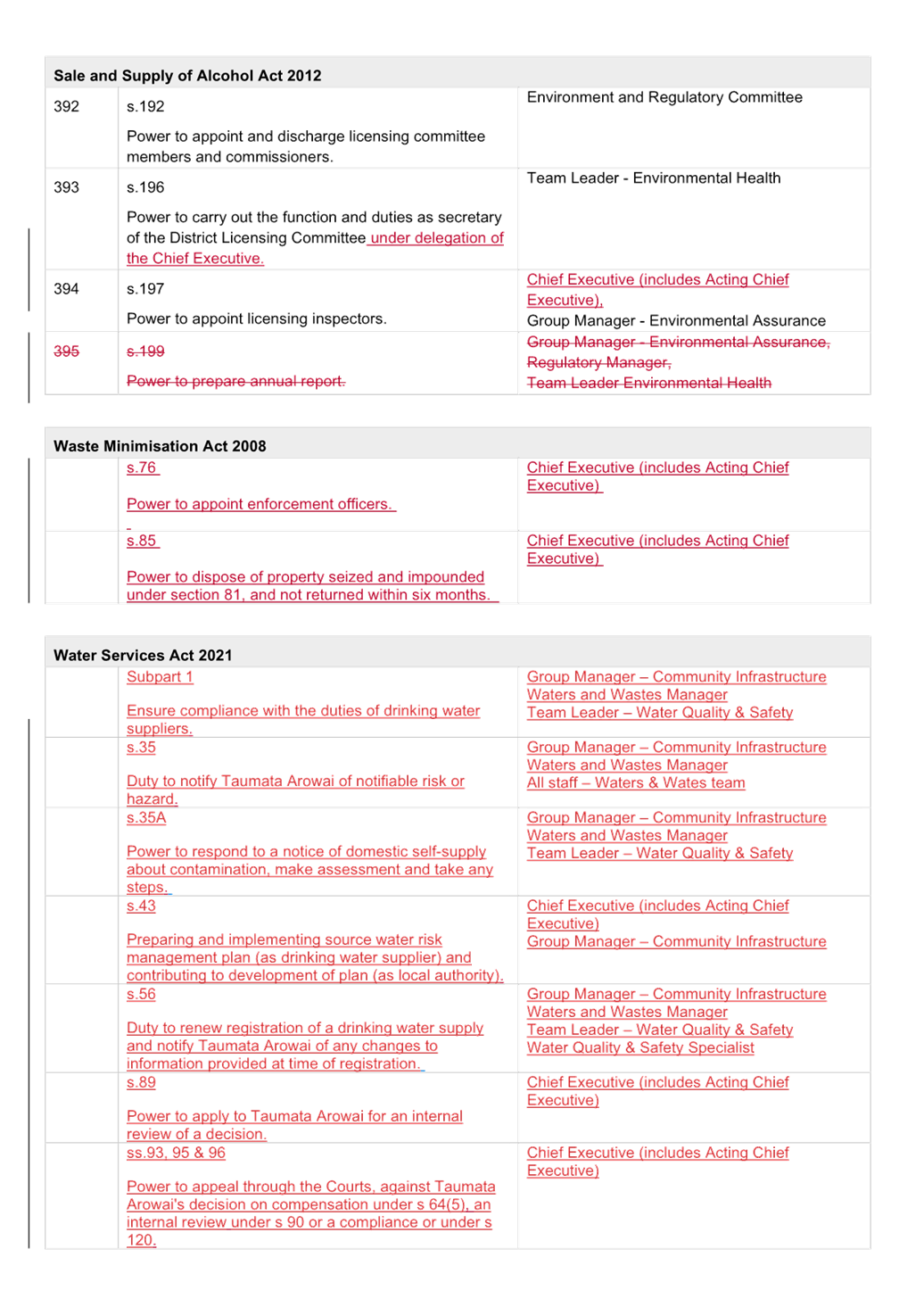
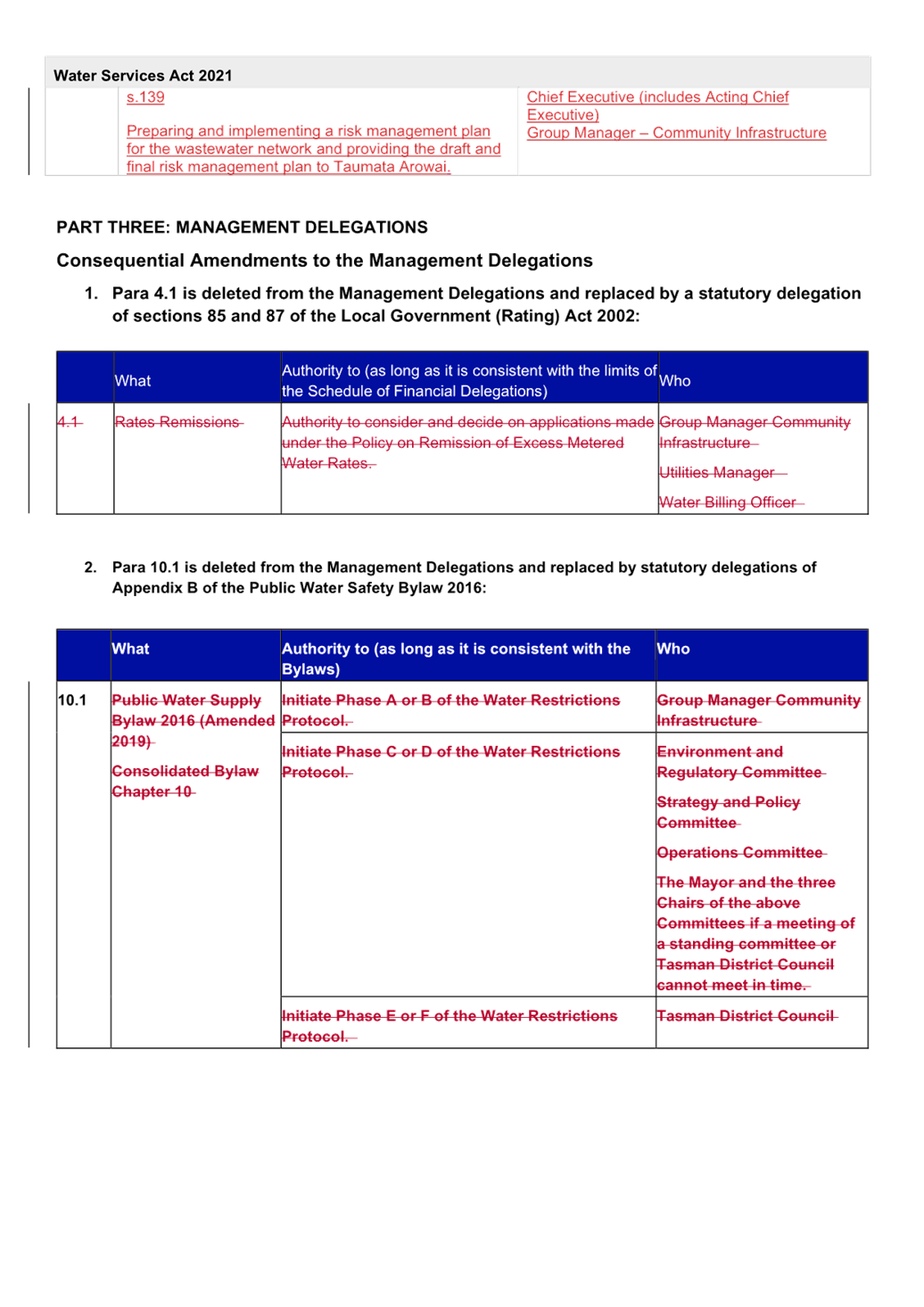

Tasman District Council Agenda – 08 May 2025
7.10 Section 17A Service Delivery Review - Community Facilities
Decision Required
|
Report
To:
|
Tasman
District Council
|
|
Meeting
Date:
|
8
May 2025
|
|
Report
Author:
|
Grant
Reburn, Reserves and Facilities Manager
|
|
Report
Authorisers:
|
Richard
Kirby, Group Manager - Community Infrastructure
|
|
Report
Number:
|
RCN25-05-11
|
1. Purpose
of the Report / Te Take mō te Pūrongo
1.1 This
report has been prepared to enable the Council to meet its obligations under
section 17A of the Local Government Act 2002 to review the
cost-effectiveness of current service delivery arrangements in meeting the
needs of communities within its district for Community Facilities.
1.2 The
categories of Community Facilities included in the review are:
1.2.1 Community
Centres
1.2.2 Halls
1.2.3 Miscellaneous
Community Buildings
1.2.4 Multi Use
Community Recreation Centres
1.2.5 Richmond
Aquatic Centre
2. Summary
/ Te Tuhinga Whakarāpoto
2.1 Under
section 17A of the Local Government Act 2002, the Council is required to carry
out service delivery reviews for the different activities it undertakes, this
report reviews Community Facilities including Community Centres, Halls,
Miscellaneous Buildings, Multi-Use Recreation Centres and the Richmond Aquatic
Centre.
2.2 Governance and funding of these facilities is currently provided by
the Council. Delivery is slightly different for each facility category; Halls
have triennially elected community representatives on a committee supported by
Council staff. The Miscellaneous Community Buildings are managed by Hall
Committees or staff. Most of the Multi-Use Community Recreation Centres are
managed and operated under management agreements with a Community Trust. The
Richmond Aquatic Centre is managed and operated under a contract with a private
entity. While there is variety of management and operating models, they match
the size, scale and location of the facility. Community involvement and
engagement is high, and facilities are considered cost effective.
2.3 Some
of the existing management contracts/agreements need to be improved with better
performance measures and accountability and alignment of expiry dates. The
contract for the Richmond Aquatic Centre expires this year. Existing
contracts/agreements expire in 2025, with the exception of the Golden Bay
Recreation Park which expires in 2026, this board has agreed to an early
termination to align the term of their agreement with the other centres.
2.4 The report recommends that the current approach for
governance, funding and delivery of the Community Facilities activity remains
unchanged. This approach is Council
governance and funding with delivery by a combination of community groups and
in the case of Richmond Aquatic Centre a contract with a private entity.
Management support by Council staff would continue at a similar level to that
currently provided.
3. Recommendation/s
/ Ngā Tūtohunga
That the Tasman
District Council
1. receives
the Section 17A Service Delivery Review - Community Facilities report
RCN25-05-10; and
2. approves that, following the section 17A review of
Community Facilities as contained in Attachment 1 to the agenda report, that
the governance, funding and delivery of the Community Facilities activity
remains unchanged; and
3. notes that the delivery of the Community Facilities
activity will continue to be reported to the Operations Committee.
4.1 Section 17A of the Local Government Act
2002 requires the Council to carry out service delivery reviews for the
different activities that it undertakes. Reviews are required when there is a
significant change to levels of service; a contract for delivery of the service
is due to expire within two years; no service delivery review under s17A has
been undertaken within six years.
4.2 Service delivery reviews are required
to, “review the cost-effectiveness of current arrangements for meeting
the needs of communities within its district or region for good-quality local
infrastructure, local public services, and performance of regulatory functions”,
consider options for the governance, funding, and delivery. In this review
various types of community facilities are considered. This includes options
where:
4.2.1 Responsibility for governance, funding and delivery is
exercised by the local authority.
4.2.2 Responsibility for governance and funding is exercised by the
local authority and delivery is by:
a) a
Council Controlled Organisation (CCO) of the local authority; or
b) a
CCO in which the local authority is one of several shareholders: or
c) another
local authority; or
d) another
person or agency.
4.2.3 Responsibility for governance and funding is delegated to a
joint committee or other shared governance arrangement and responsibility for
delivery is by an entity or person as listed in paragraphs 4.2.4 a) – d)
above.
4.3 A local authority is not required to
undertake a review:
4.3.1 to the extent that the delivery of
that infrastructure, service, or regulatory function is governed by
legislation, contract, or other binding agreement such that it cannot
reasonably be altered within the following two years.
4.3.2 if it is satisfied that the potential benefits of undertaking
a review do not justify the cost of undertaking the review.
4.4 The
Tasman 10-Year Plan 2024-2034 includes a group of activities in the Community
Development section. These are Parks & Reserves, Community Facilities and
Community Partnerships. This service delivery review encompasses the Community
Facilities Activity but excludes the Libraries, Housing for Older Adults,
Museums and Leased Community Buildings.
4.5 The
types of Community Facilities included in this review are:
4.5.1 Community
Centres
4.5.2 Halls
4.5.3 Miscellaneous
Community Buildings
4.5.4 Multi-Use
Community Recreation Centres
4.5.5 Richmond
Aquatic Centre
4.6 This
service delivery review was completed by a former manager for this activity
area, supported by the current manager, providing the knowledge and an
understanding of how these facilities are currently managed. The methodology
for the review is based on guidelines provided by the Society of Local
Government Managers (now Taituarā) and internal Council guidance for
service delivery reviews.
4.7 The
review is undertaken in several stages,
4.7.1 The first stage considers the rationale for service provision,
the present arrangements for governance, funding and delivery, previous
reviews, the performance of the activities and overall cost of each activity
both operational and capital.
4.7.2 The second stage evaluates and makes a recommendation as to
whether a review is required.
4.7.3 The third stage considers and analyses the options for
governance, funding and delivery for those activities recommended for review. A
final recommendation is then made for the future governance funding and
delivery.
4.8 The
Section 17A review for the Community Facilities outlined in Section 4.5 of this
report is included as Attachment 1.
5. Analysis
and Advice / Tātaritanga me ngā tohutohu
5.1 The Council currently provides a range
of community facilities across the District that provide places and spaces for
community recreation, social activities and the arts.
5.2 Governance and funding of these
facilities is currently provided by the Council and is supported by the Mayor
and Councillors, Community Board Members and in the case of Halls and Community
Centres triennially elected community representatives on facility management
committees.
5.3 The management committees activate the
places and provide operational support in management and co-ordination of
maintenance. Council staff support these groups in the management, building
maintenance and capital renewals.
5.4 The Miscellaneous Community Buildings
are managed by Hall Committees or staff.
5.5 Most of the Multi-Use Community
Recreation Centres are managed and operated under management agreements with a
Community Trust, a service level agreement is in place to ensure agreed
community outcomes are achieved.
5.6 The Richmond Aquatic Centre is managed
and operated under a contract with a private entity.
5.7 While there are a variety of management
and operating models in place, they have proved to be appropriate to the size,
scale and location of the facility. They have a high level of community
involvement and engagement so are considered cost effective, efficient and
community focussed.
5.8 The facilities are dispersed across the
District and particularly in the case of community halls which serve small or
rural communities, community led and operated amenities, for the community by
the community based on local needs are a great solution.
5.9 There is a need to modify the Richmond
Town Hall and the five Multi-Use Community Recreation Centre agreements to
improve the performance measures and accountabilities, but the governance and
service delivery models are considered appropriate and fit for purpose.
5.10 A third stage review of options for the Richmond
Aquatic Centre was undertaken to enable consideration of the full range of
options for governance, funding and delivery
(Attachment 1). This showed that the current model of governance and
funding by the Council, with delivery by a private entity was the most
appropriate. This option is also the status quo and has been in place since the
facility opened around 2007. The current contract expires on 30 November 2025
so there is a need to get a procurement process underway as soon as possible
and a programme is in place to achieve this.
6. Financial
or Budgetary Implications / Ngā Ritenga ā-Pūtea
6.1 The total operating and capital costs
for the Community Facilities included in the review are included in the review
document in Attachment 1.
6.2 They include the actual costs for the
past three years and the inflation adjusted budgeted costs for the next
10-years as included in the Tasman 10-Year Plan 2024-2034. Similar tables of
operating and capital costs have also been provided for each of the five key
facility groups.
6.3 The operating costs (Opex)
include wages and related expenses, maintenance, general operating costs,
professional fees, overheads, loan interest and depreciation. Some of the
overhead costs are held at an activity level so these have been apportioned to each
of the key facility groups.
6.4 In the case of Community
Recreation Centres and the Richmond Aquatic Centre the cost included is the
direct cost to the Council as the revenue is retained by the contractor and is
used to offset their costs with a subsidy paid by the Council.
6.5 The review proposes a continuance
of the status quo with similar levels of service so no significant changes in
cost are anticipated.
7.1 The options are outlined in the
following table:
|
Option
|
Advantage
|
Disadvantage
|
|
1.
|
Governance and funding of Community
Facilities by the Council. Delivery by community organisations or in the case
of Richmond Aquatic Centre, a private entity. Management support by Council
staff (status quo).
|
Mix of Council, community and private
entities provides high level of community involvement in delivery.
Works well in a large geographic area
with several dispersed settlements.
Mixed funding by users and from rates.
|
Relies on high level of community
involvement & engagement.
|
|
2.
|
Governance and funding by the Council.
Full in-house delivery.
|
No real advantage
|
Requires increased Council staffing.
Less efficient delivery across the large
District.
Less involvement and engagement with
community.
Cost likely to be higher.
|
|
3.
|
Governance and funding by the Council.
Delivery by a CCO or another council
|
No real advantage
|
Not within or in similar area of interest
to an existing CCO and other councils unlikely to be interested in delivery.
|
7.2 Option 1 is recommended.
8.1 The legislative requirements relating to
service delivery reviews are outlined in Section 17A of the Local Government
Act 2002. Key aspects of these requirements have been included in the
background section of this report. This review follows external guidance for
service delivery reviews and is also consistent with the approach taken in
earlier reviews.
9. Iwi
Engagement / Whakawhitiwhiti ā-Hapori Māori
9.1 No specific iwi engagement in relation
to the section 17A reviews has been undertaken.
10. Significance
and Engagement / Hiranga me te Whakawhitiwhiti ā-Hapori Whānui
10.1 The overall performance of Community Facilities is
of high significance to the community, However the subject of the service
delivery review which is focused on who exercises the responsibility for
governance, funding and delivery is probably of medium significance to the
wider community.
|
|
Issue
|
Level of
Significance
|
Explanation of
Assessment
|
|
1.
|
Is there a high level
of public interest, or is decision likely to be controversial?
|
Low-Medium
|
The recommended
approach is continuance with the status quo for governance, funding and
delivery which is consistent with the approach outlined in the Tasman 10-year
plan 2024-2034.
|
|
2.
|
Are there impacts on
the social, economic, environmental or cultural aspects of well-being of the
community in the present or future?
|
Low
|
Any wellbeing impacts
are unlikely to be changed by adopting the recommended approach.
|
|
3.
|
Is there a
significant impact arising from duration of the effects from the decision?
|
Low
|
|
|
4.
|
Does the decision
relate to a strategic asset? (refer Significance and Engagement Policy for
list of strategic assets)
|
Low
|
The facilities
included in this review do not fit within the criteria of a strategic asset
in Schedule 1 of the Significance and Engagement Policy.
|
|
5.
|
Does the decision
create a substantial change in the level of service provided by Council?
|
Low
|
Existing levels of
service will continue unchanged.
|
|
6.
|
Does the proposal,
activity or decision substantially affect debt, rates or Council finances in
any one year or more of the LTP?
|
Low
|
There are no
significant increases/decreases in cost likely as service levels are
unchanged.
|
|
7.
|
Does the decision
involve the sale of a substantial proportion or controlling interest in a CCO
or CCTO?
|
N/a
|
|
|
8.
|
Does the
proposal or decision involve entry into a private sector partnership or
contract to carry out the delivery on any Council group of activities?
|
Medium
|
A private sector
contract is proposed for the management and operation of the Richmond Aquatic
Centre, this reflects the status quo as a contract for this facility has been
in place since 2007.
|
|
9.
|
Does the proposal or
decision involve Council exiting from or entering into a group of
activities?
|
N/a
|
|
|
10.
|
Does the proposal
require particular consideration of the obligations of Te Mana O Te Wai
(TMOTW) relating to freshwater or particular consideration of current
legislation relating to water supply, wastewater and stormwater
infrastructure and services?
|
N/a
|
|
11. Communication
/ Whakawhitiwhiti Kōrero
11.1 No communication plan is proposed in relation to
this decision as the recommended approach is consistent with that outlined in
the Tasman 10-year plan 2024-2034.
12.1 In essence, this proposal reflects the status quo
so the risks associated with this proposal are low.
12.2 There is a low risk associated with a new contract
for the management and operation of the Richmond Aquatic Centre. Several other
councils contract the management of their aquatic facilities. There are 2-3
larger companies nationwide who offer services in facility management and the
market is competitive.
13. Climate
Change Considerations / Whakaaro
Whakaaweawe Āhuarangi
13.1 This
report is of an administrative nature therefore climate change has not been
considered.
14. Alignment
with Policy and Strategic Plans / Te Hangai ki ngā aupapa Here me ngā
Mahere Rautaki Tūraru
14.1 A policy for Section 17A reviews is currently being
developed and is scheduled to be presented for consideration by the Council at
its meeting on 8 May 2025.
14.2 Currently there are no delegations for service delivery
reviews and the responsibility for their consideration sits with the Council.
15. Conclusion
/ Kupu Whakatepe
15.1 A section 17A review has been completed for most of the Community
Facilities. The recommended approach is to continue the existing approach of
Council governance and funding with delivery by a combination of community
groups and in the case of Richmond Aquatic Centre a contract with a private
entity. Management support would continue at a similar level to that currently
provided.
16. Next
Steps and Timeline / Ngā Mahi Whai Ake
16.1 On adoption of this report staff will prepare modified agreements
and contracts with the various delivery entities. The programme for this is:
16.1.1 Updated agreements in place for the Multi-Use Community Recreation
Centres by 30 June 2025.
16.1.2 Procurement process for the Richmond Aquatic Centre completed with
new contract commencing 1 December 2025.
16.1.3 Electoral
processes for community board and council representatives on hall committees by
31 January 2026 and for election of hall committees completed by 31 March 2026.
|
1.⇩
|
s17A Review
Tasman District Council Community Facilities
|
130
|
Tasman District
Council
Agenda – 08 May 2025
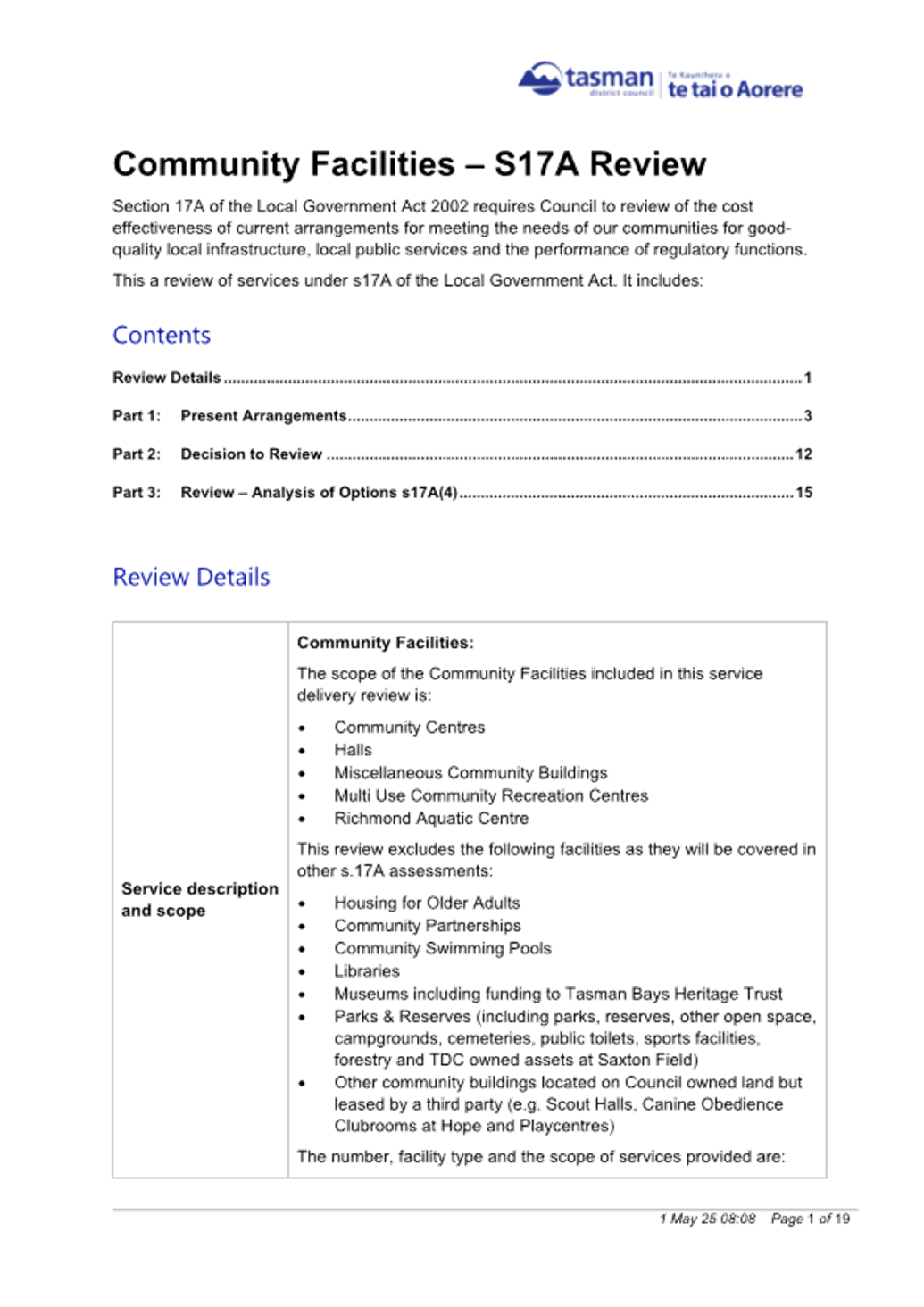
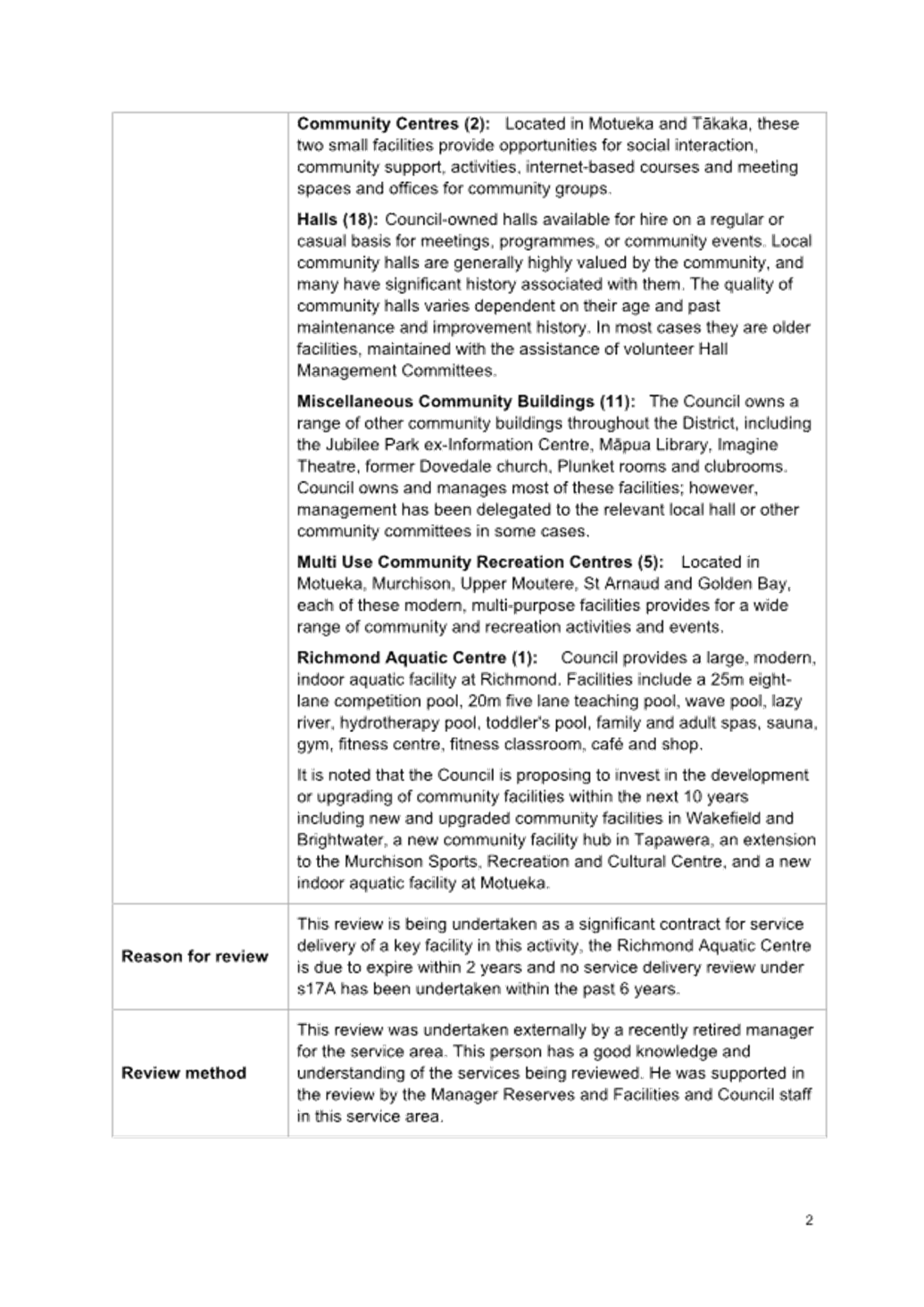
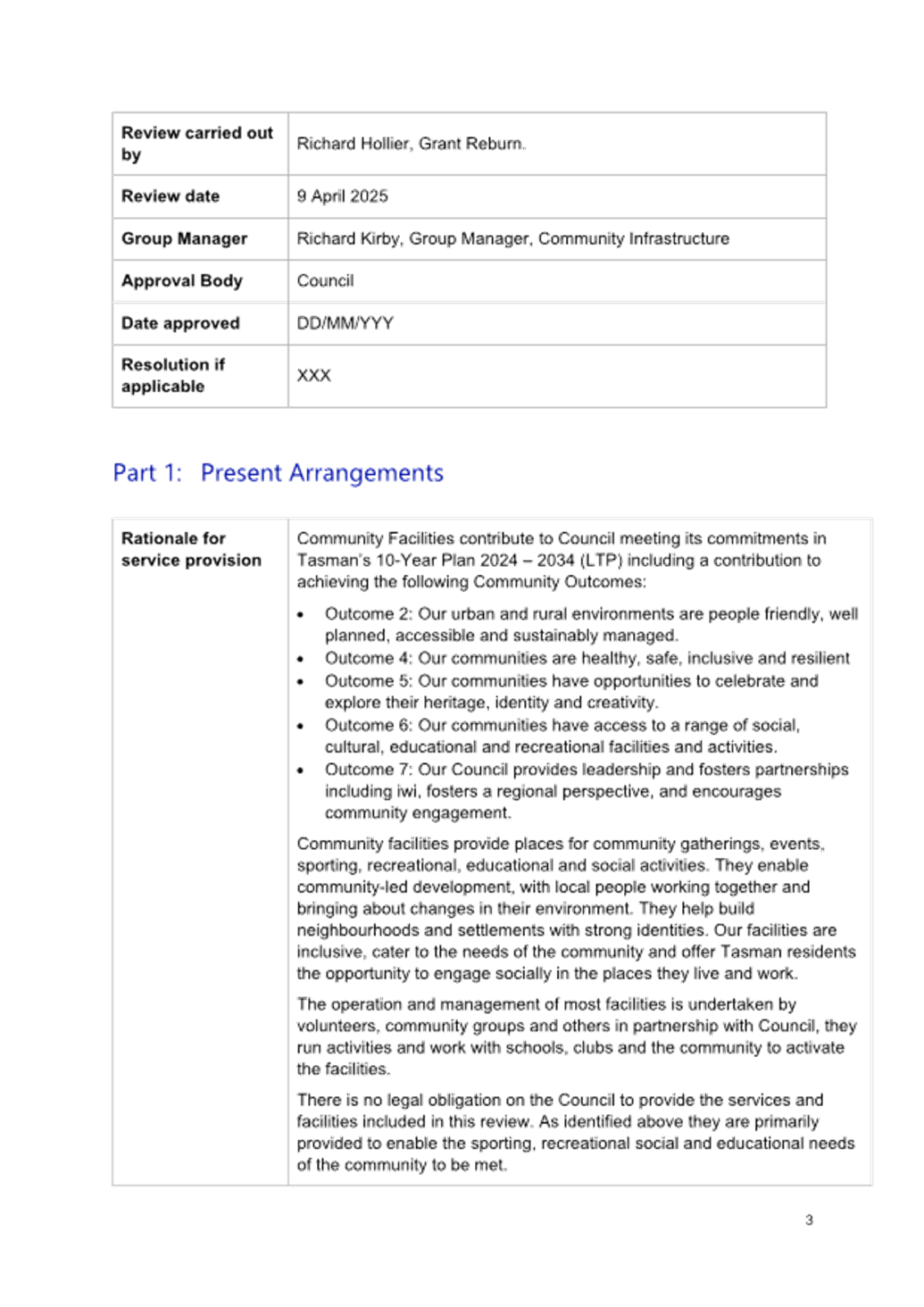
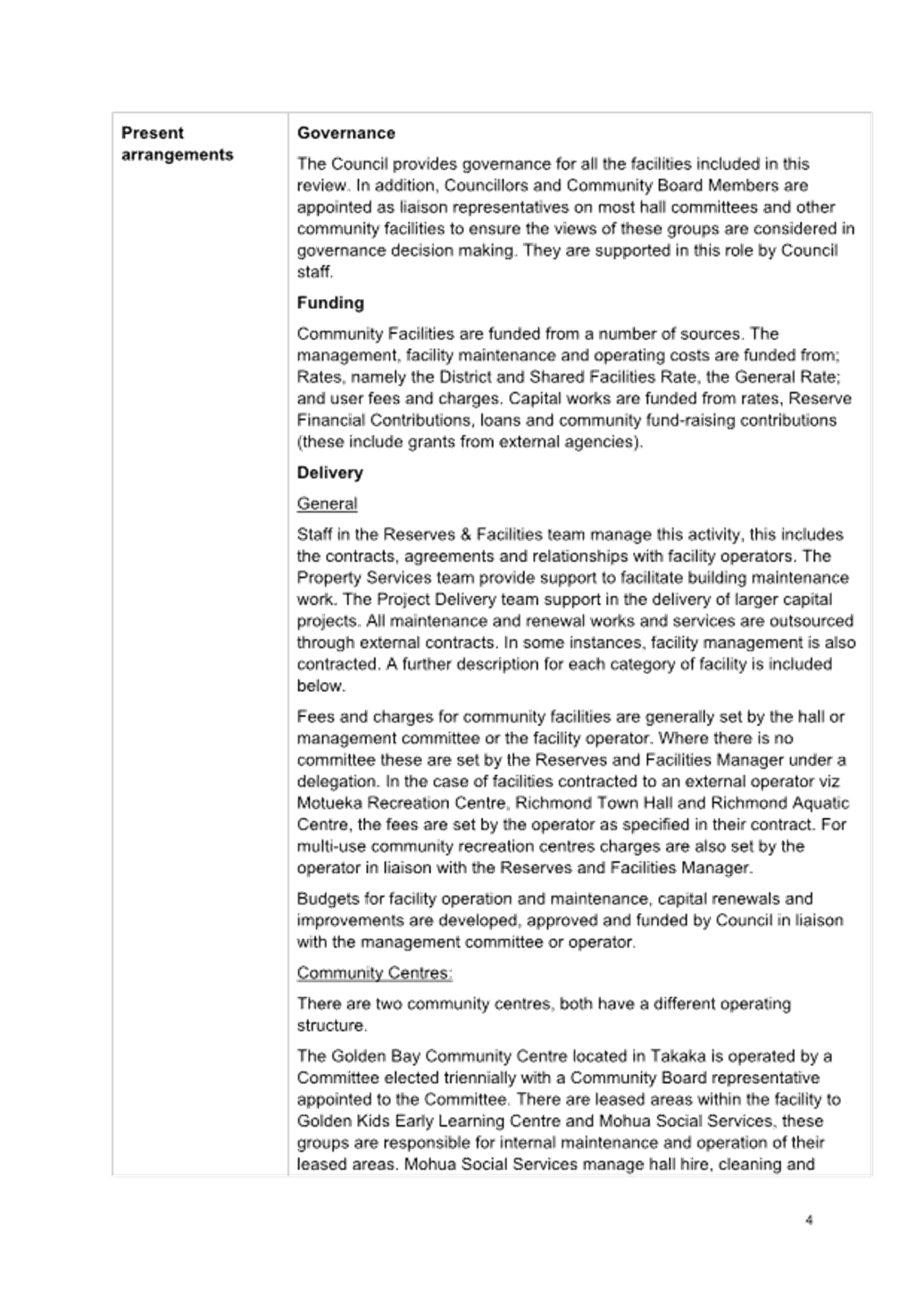
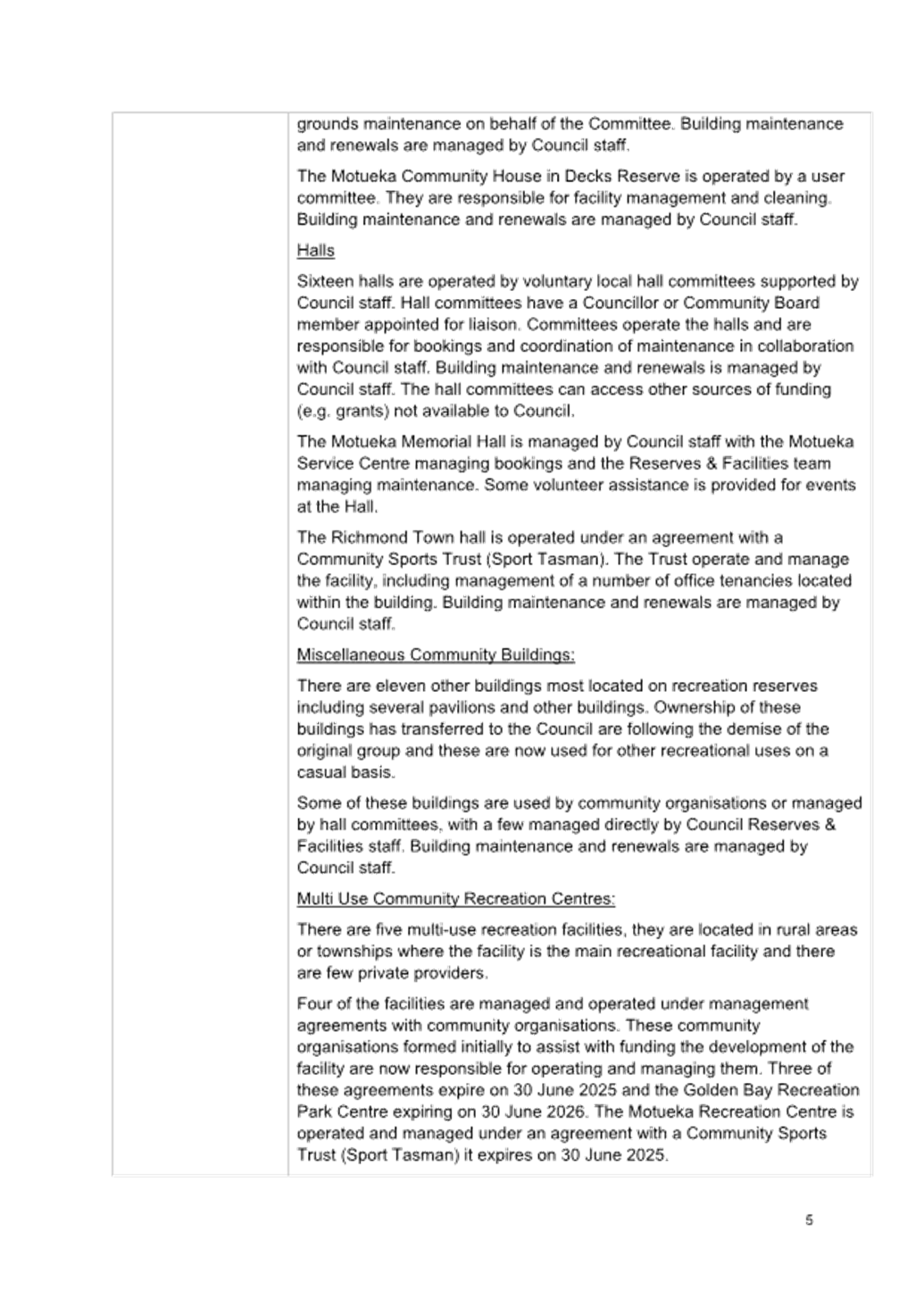
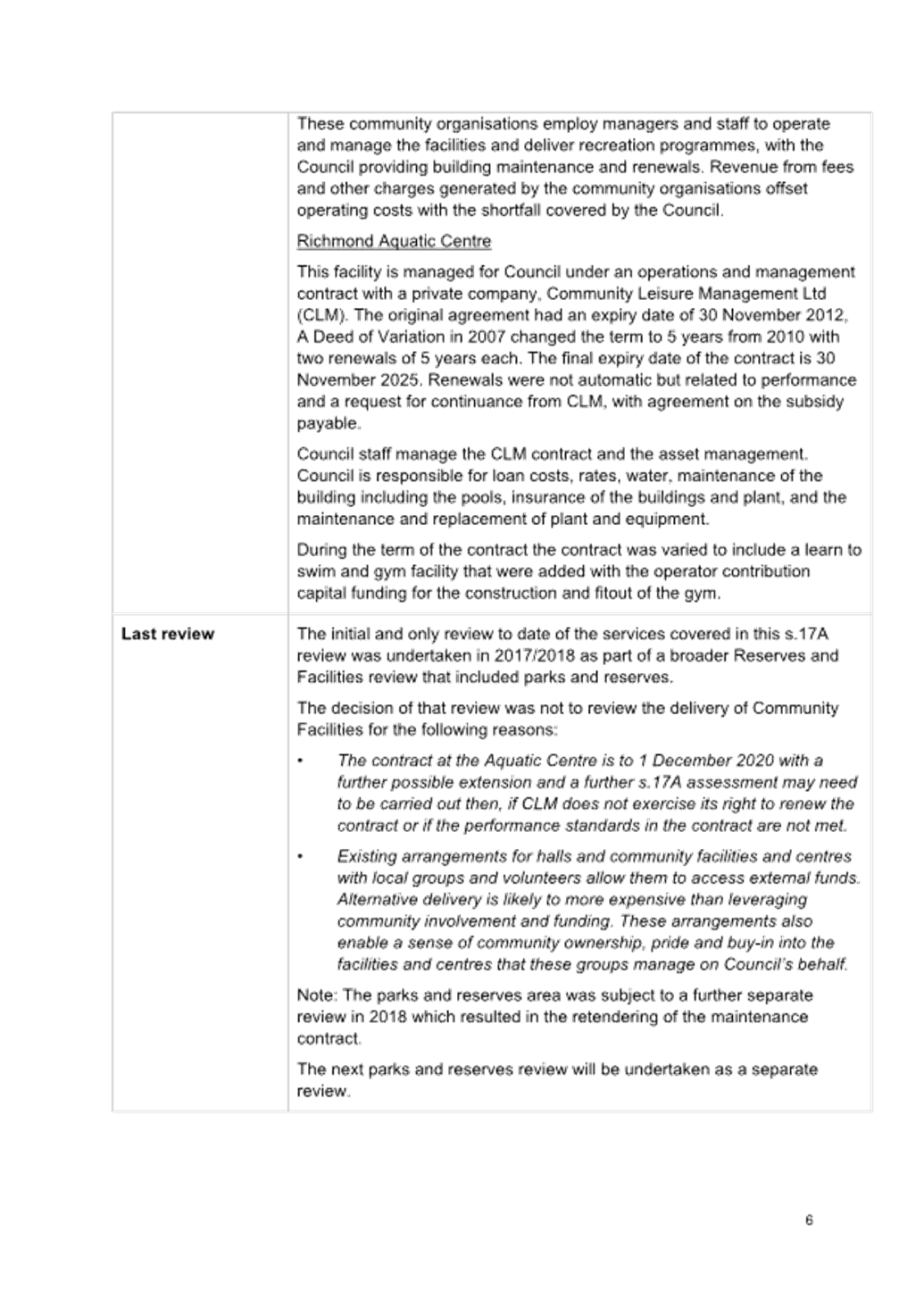
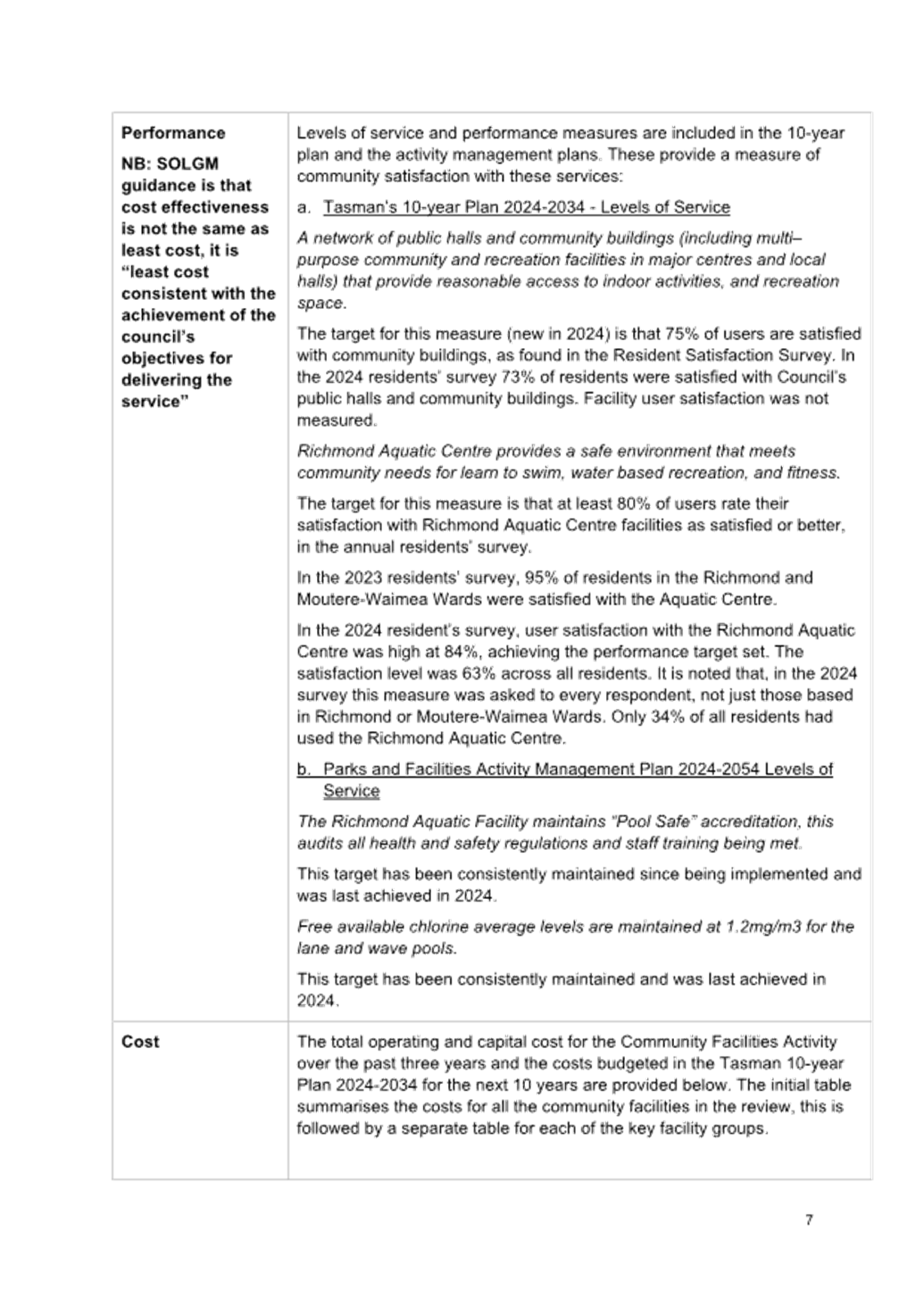
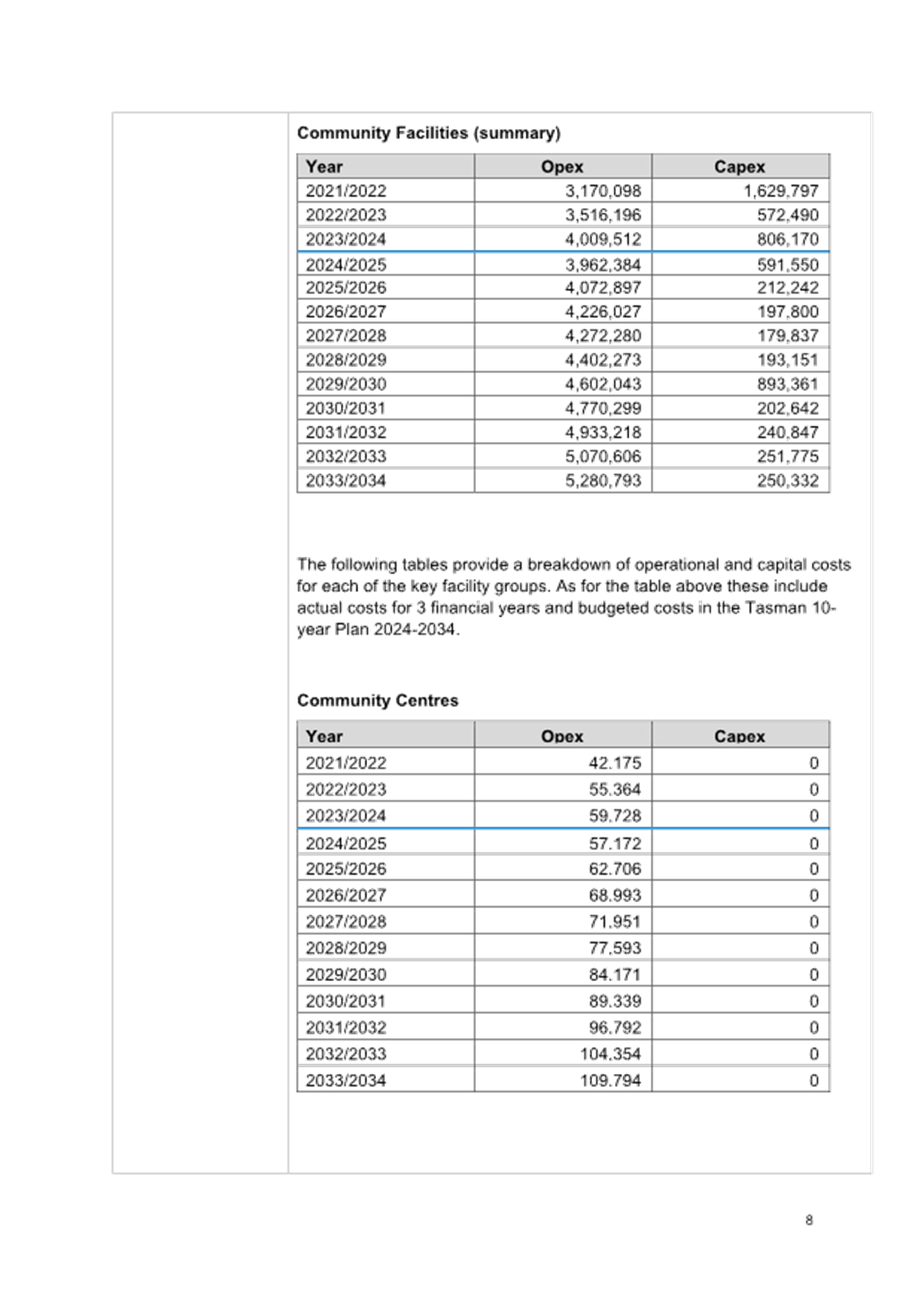
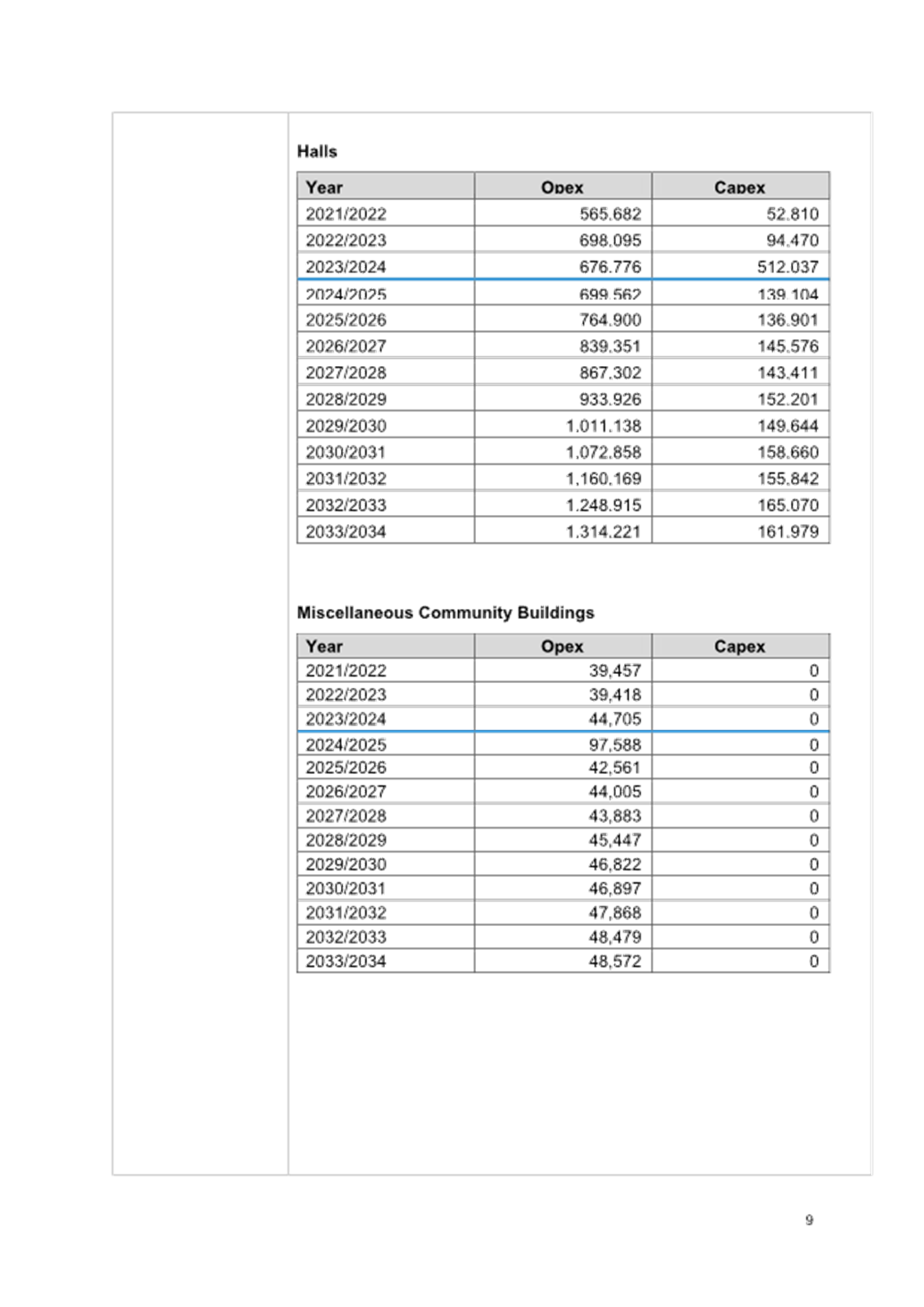
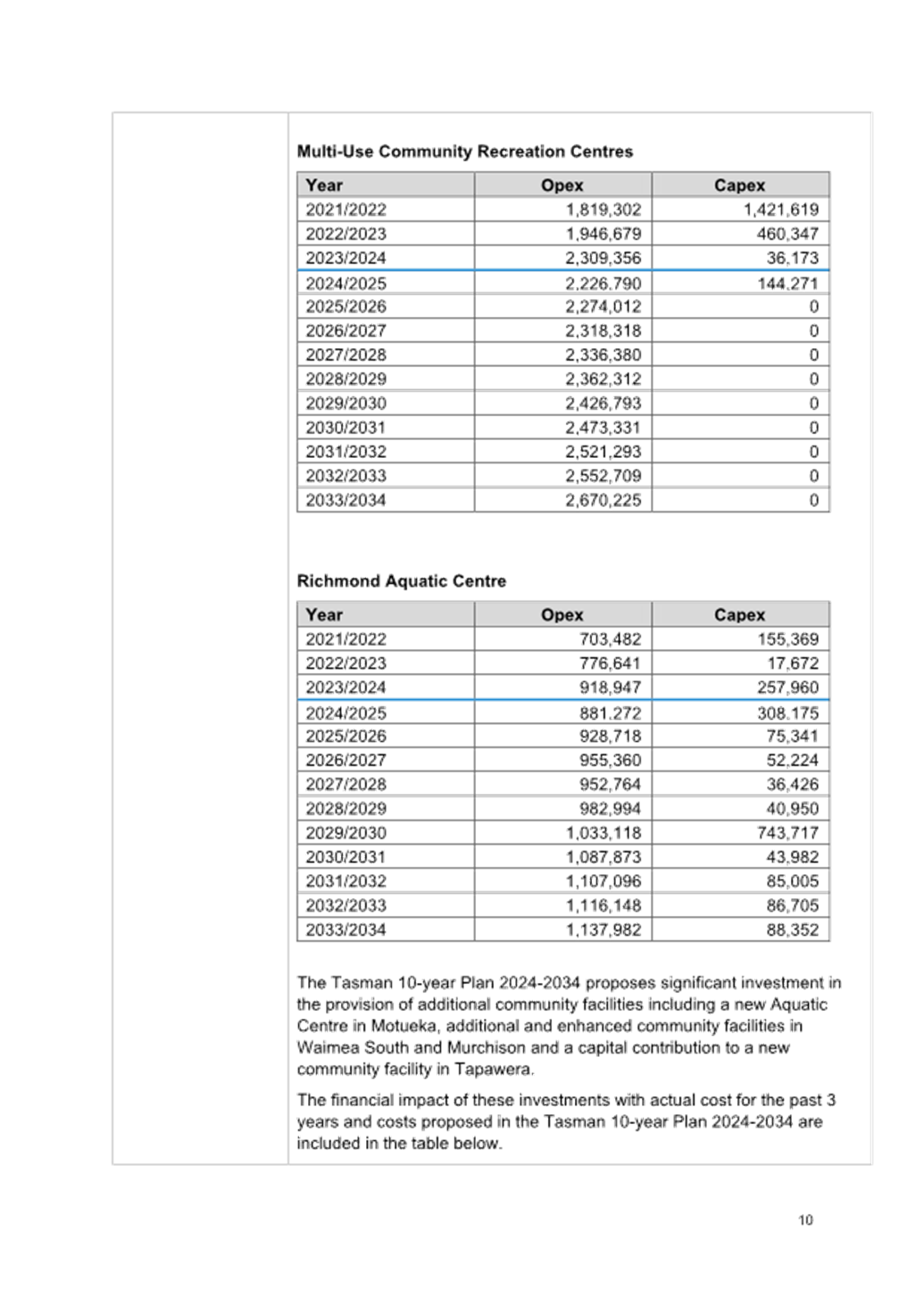

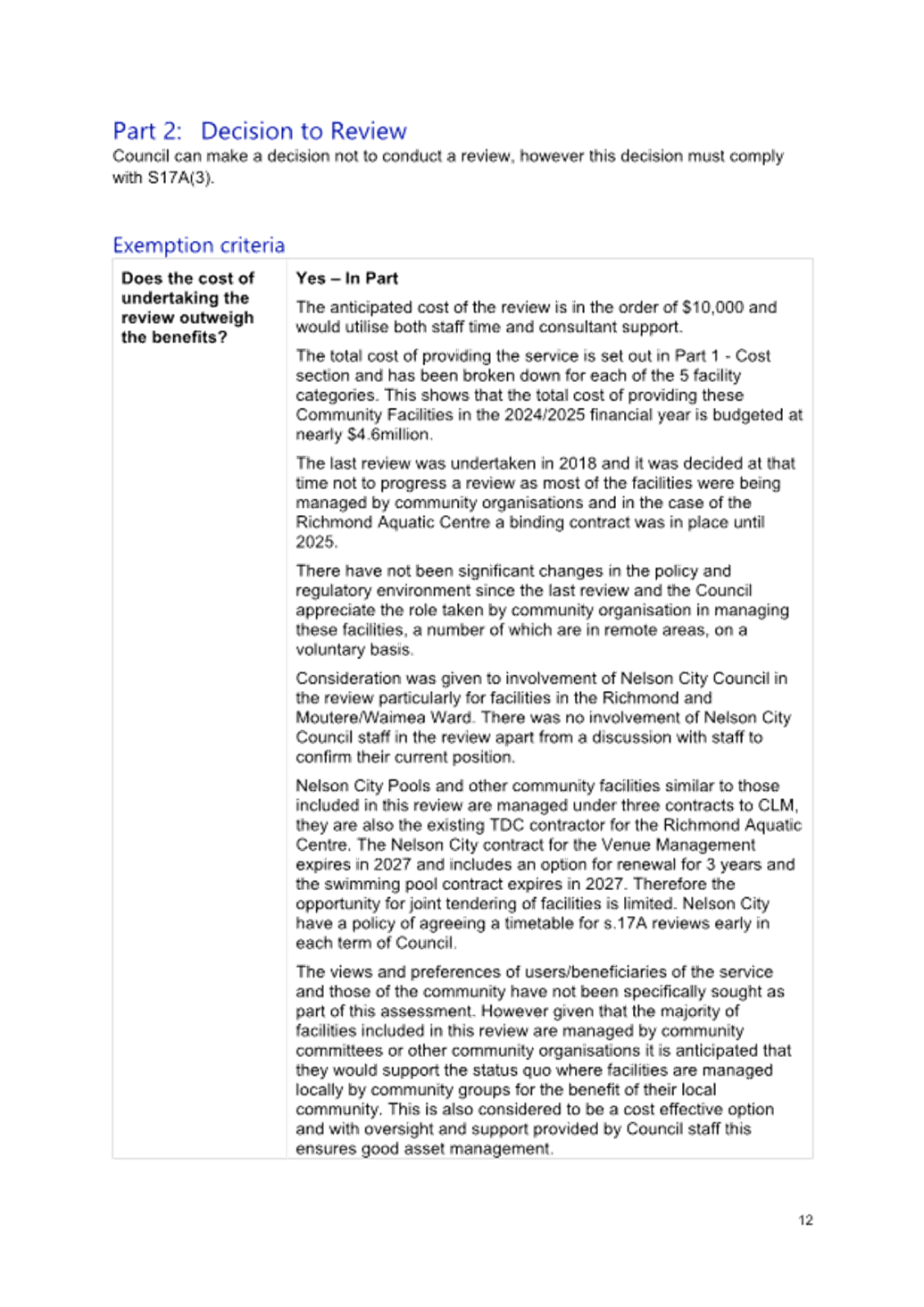
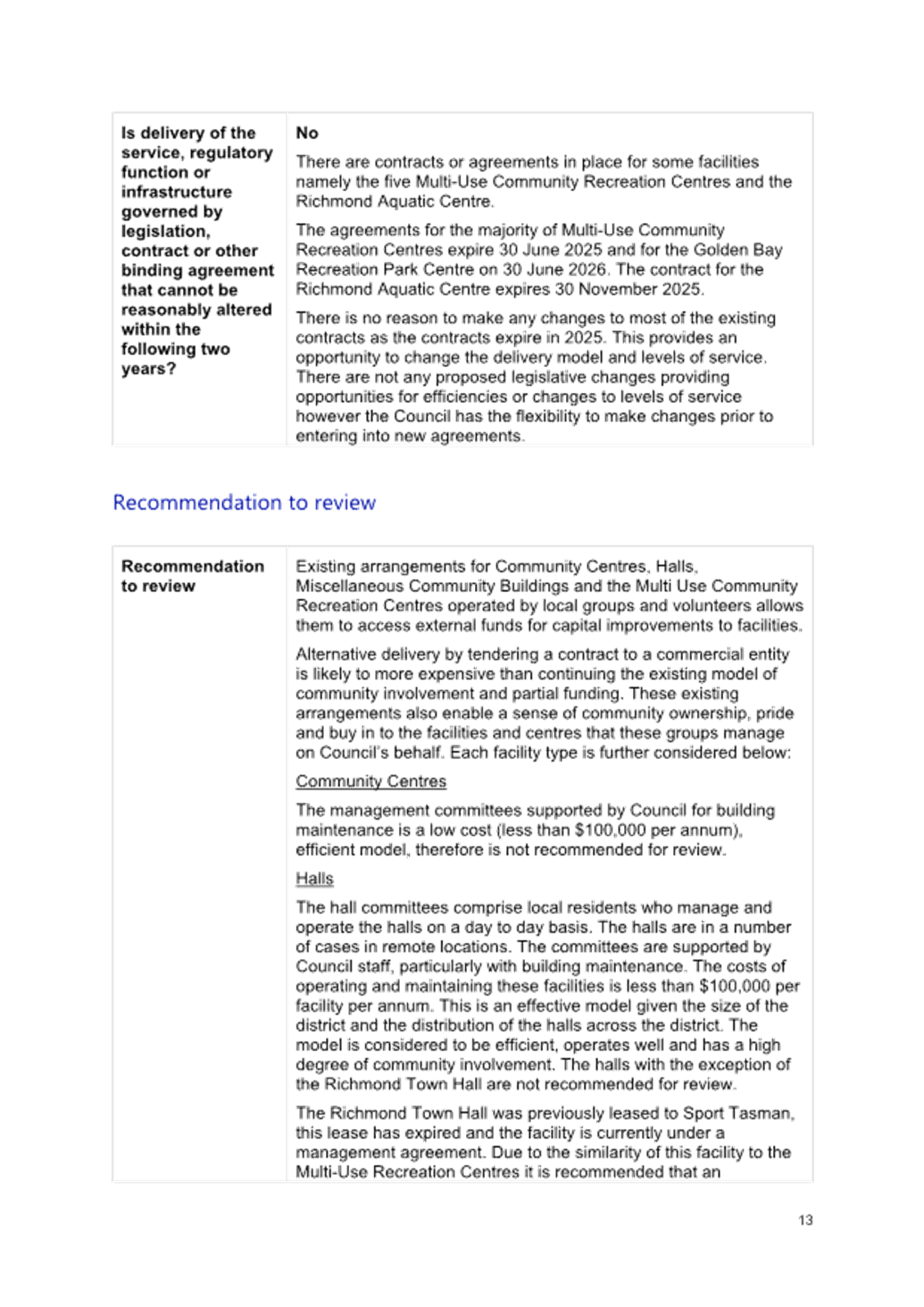
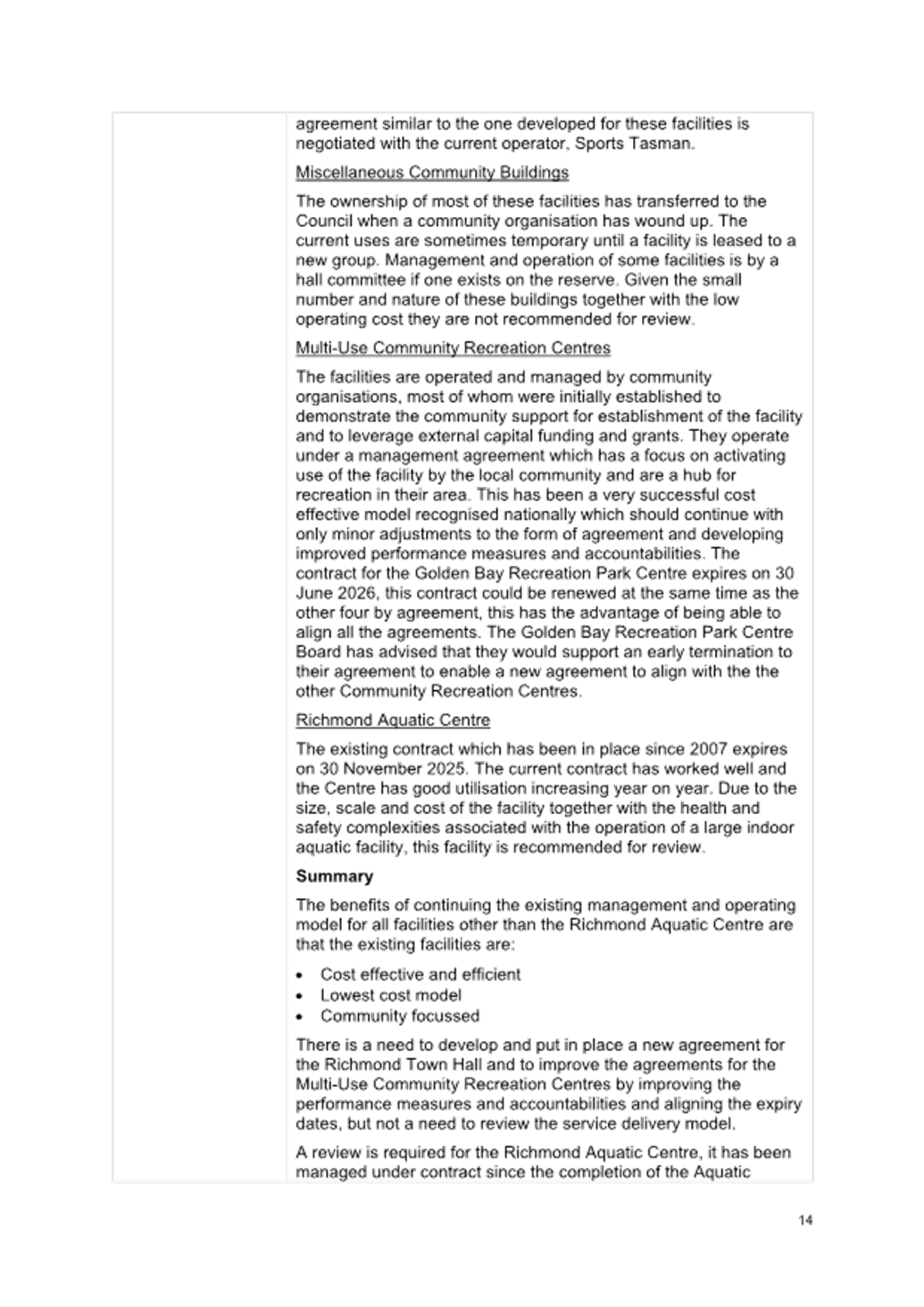
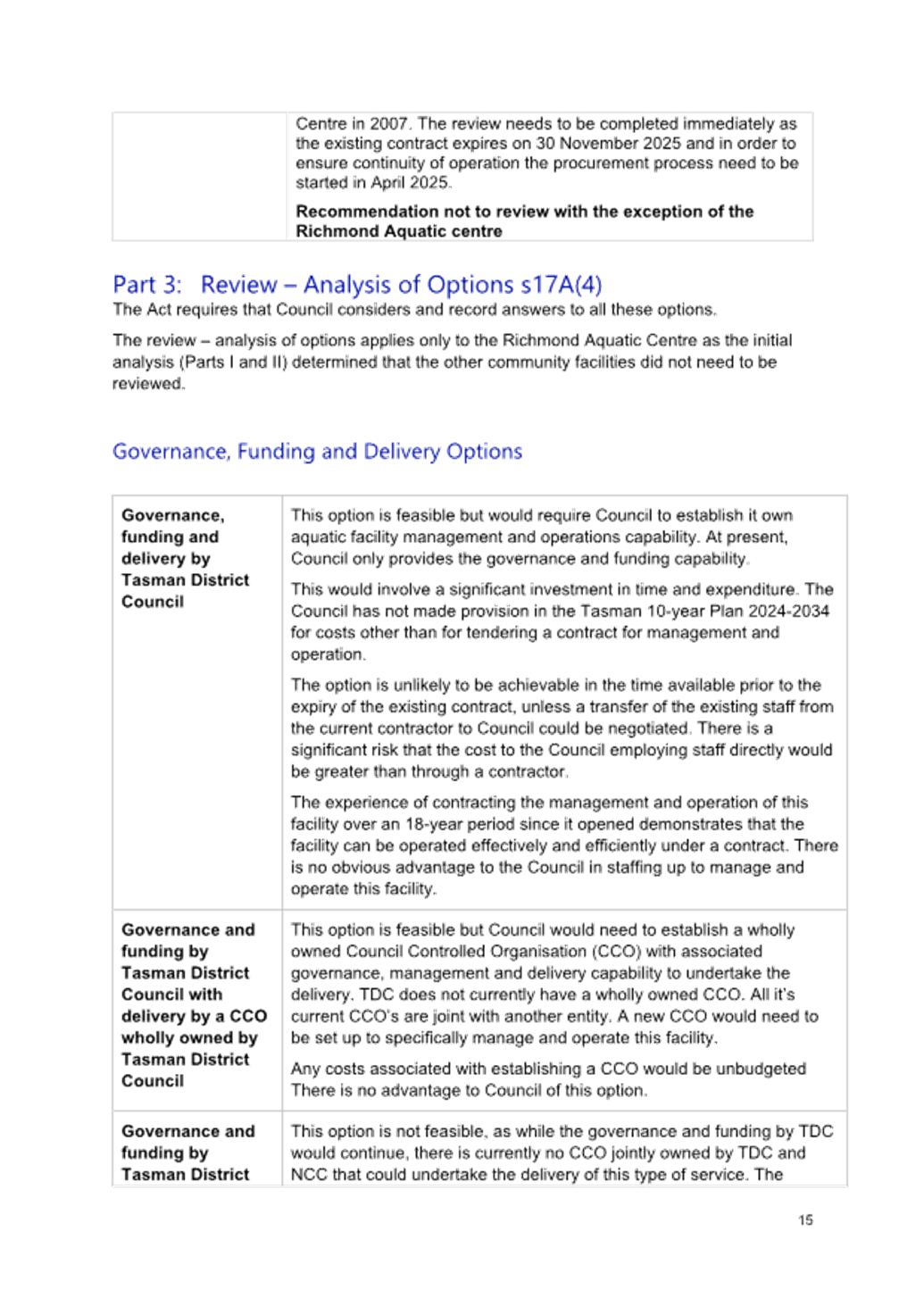
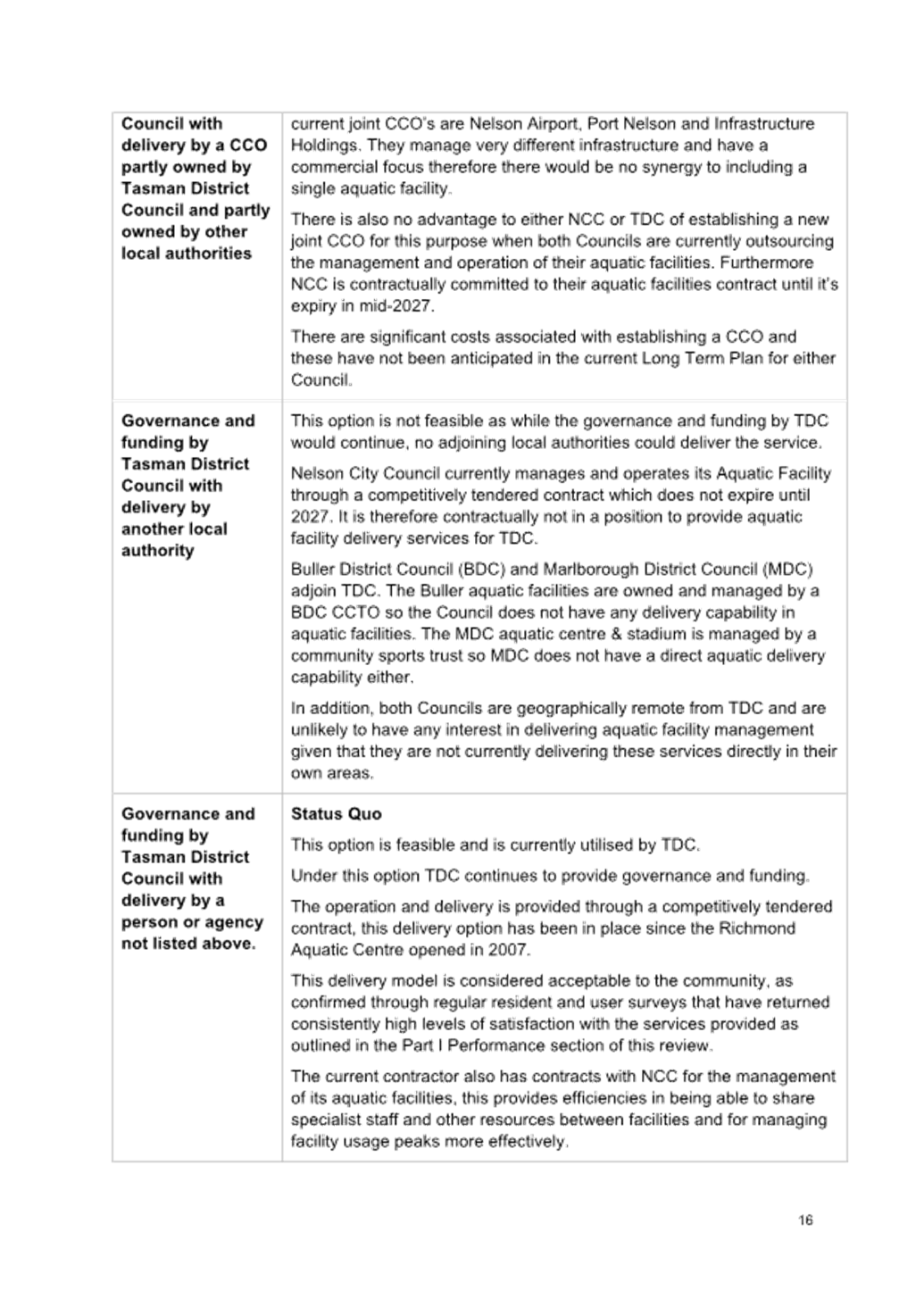
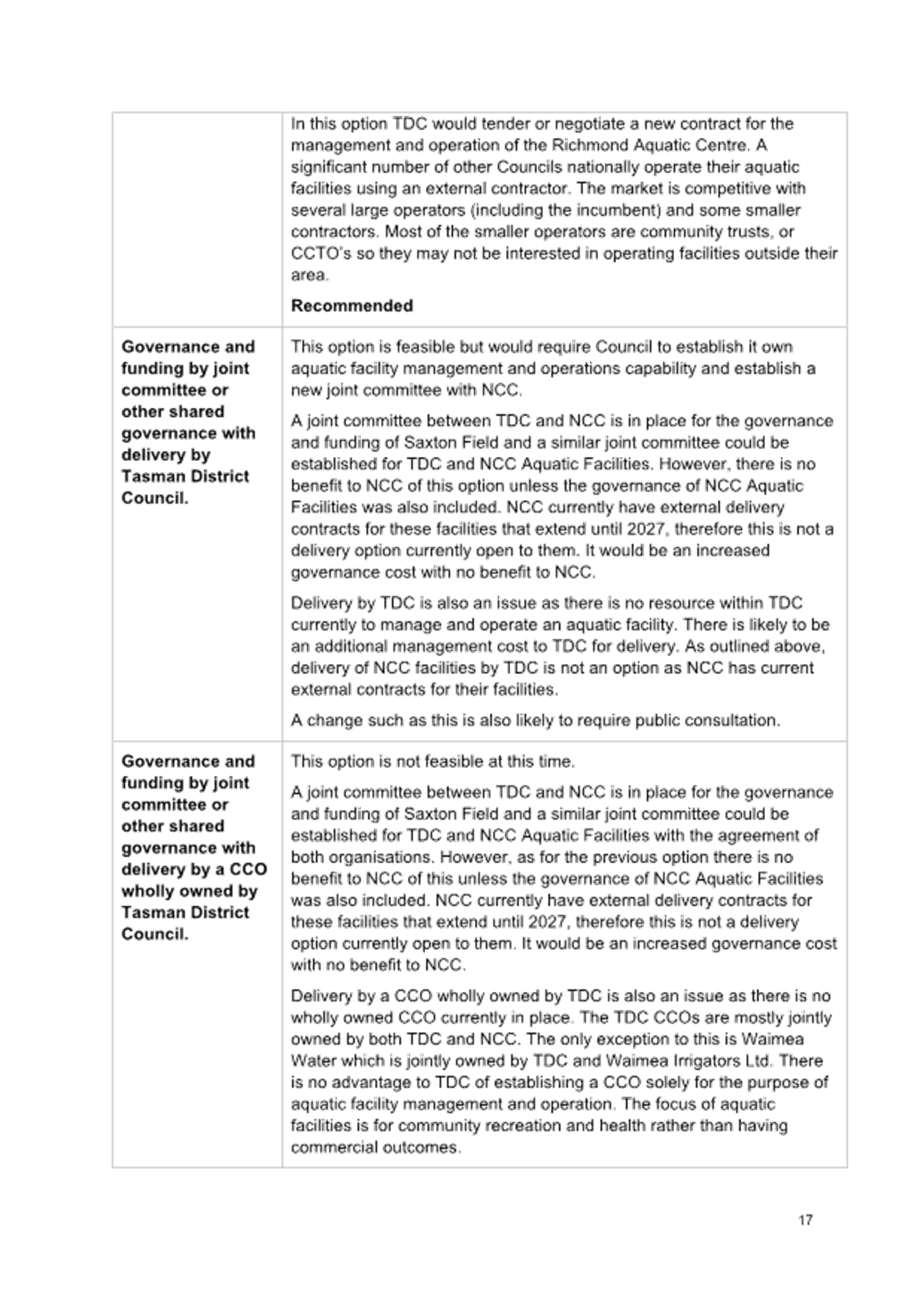

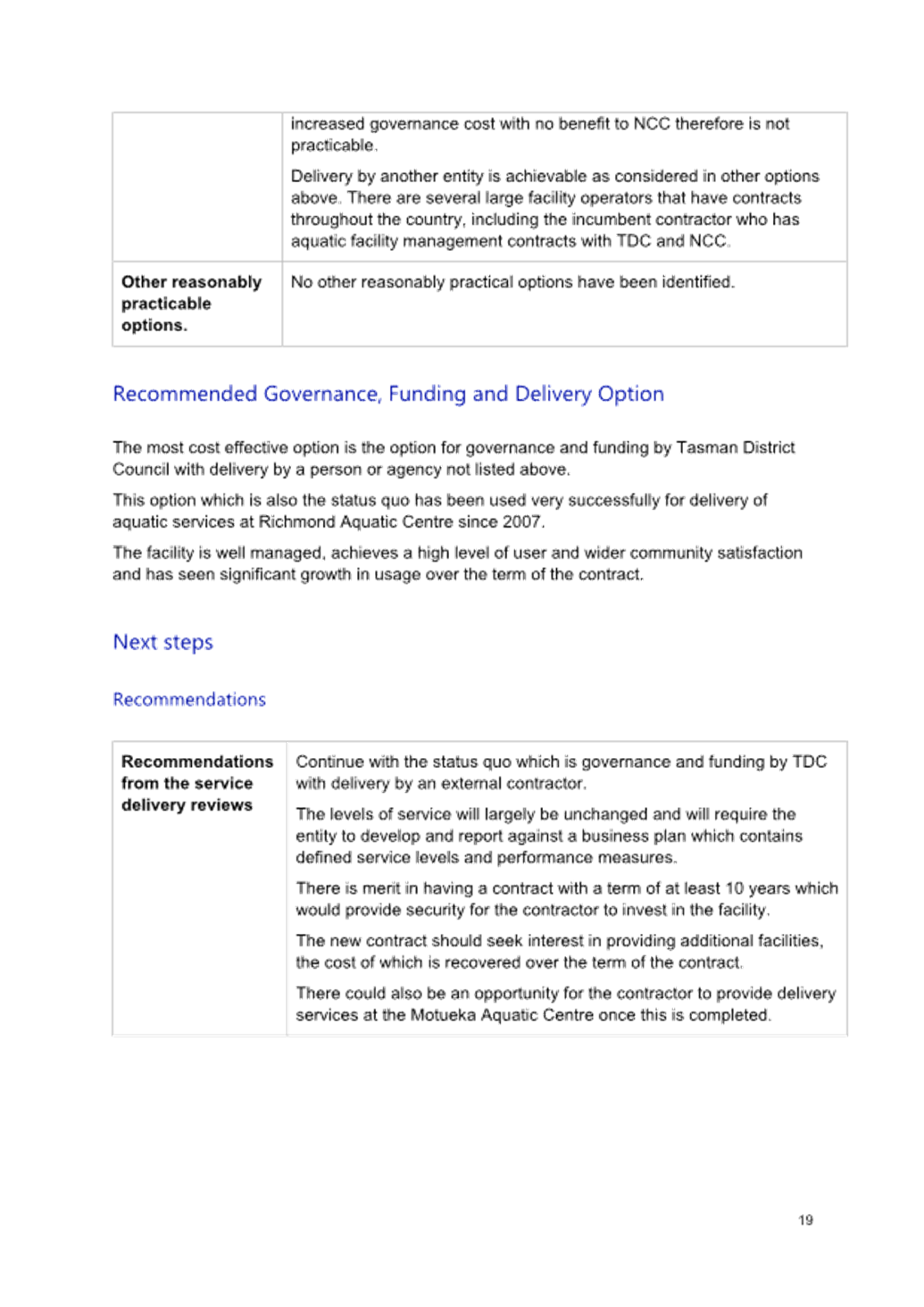
Tasman District Council Agenda – 08 May 2025
7.11 2025 Tasman District Council Election - Order of Candidate Names on
Voting Documents and Electoral System for 2028 Election
Decision Required
|
Report
To:
|
Tasman
District Council
|
|
Meeting
Date:
|
8
May 2025
|
|
Report
Author:
|
Elaine
Stephenson, Governance Manager
|
|
Report
Authorisers:
|
Steve
Manners, Chief Operating Officer
|
|
Report
Number:
|
RCN25-05-12
|
1. Purpose
of the Report / Te Take mō te Pūrongo
1.1 To
decide on the order of candidate surnames on voting documents for the Tasman
District Council Local Government triennial election 2025.
1.2 To
recommend that the decision on whether to change the electoral system for the
2028 triennial election be made by the incoming Council for the 2025 –
2028 triennium.
2. Summary
/ Te Tuhinga Whakarāpoto
2.1 The
2025 Local Government triennial elections take place this year, with Election
Day on Saturday, 11 October 2025.
Order of Candidate Names on Voting
Documents
2.2 Regulation
31 of the Local Electoral Regulations 2001 allows for councils to determine the
order of names on voting documents.
2.3 For
the 2022 Tasman District Council triennial election, the Tasman District
Council agreed on pseudo-random order for candidate surnames on voting
documents (resolution CN22-04-4).
2.4 The
Council can decide upon one of the following three options for the 2025
triennial election:
2.4.1 Alphabetical order of candidate
surname; or
2.4.2 Pseudo-random order – i.e., the
order of the surnames of the candidates is determined randomly and all voting
documents use that order; or
2.4.3 Random Order – i.e., the order
of the surnames of the candidates is determined randomly and shown in a
different order on voting documents.
2.5 If
there is no applicable Council resolution approving another arrangement prior
to 1 August 2025, the candidates’ names must be arranged in alphabetical
order of surname.
Electoral System
2.6 The
2025 Tasman District Council triennial election will be conducted
using the First-Past-the-Post (FPP)
electoral system, where the candidate with the most votes wins.
2.7 The other electoral system option is the Single Transferable Vote (STV)
system, where, rather than simply pick their preferred candidate, voters are
able to rank candidates in order of preference.
2.8 Section 27 of the Local Electoral Act 2001 states that a decision to
change electoral systems must be made not later than 12 September in the year
that is two years before (2026) the year in which the next triennial election
is to be held (2028).
2.9 Staff recommend that the decision regarding the electoral system for
the 2028 triennial election be made by the incoming Council for the 2025
– 2028 triennium.
3. Recommendation/s
/ Ngā Tūtohunga
That the Tasman
District Council
1. receives
the 2025 Tasman District Council Election - Order of Candidate Names on Voting
Documents and Electoral System for 2028 Election report RCN25-05-12; and
2. agrees that pursuant to Regulation 31 of the Local Electoral
Regulations 2001, the names of candidates on the voting documents in the Tasman
District Council 2025 triennial elections, and for any subsequent by-elections,
for Mayor, Councillors and Community Board members of the Tasman District
Council are arranged in:
The Council to resolve one of the following, either:
(a) alphabetical order of surname; or
(b) pseudo-random order of surname; or
(c) random order of surname; and
3. agrees that a decision on the electoral system for the
2028 Tasman District Council triennial election should be made by the incoming
Council for the 2025 – 2028 triennium.
4.1 The 2025 Tasman District Council
triennial election will be conducted this year, with Election
Day being Saturday, 11 October 2025.
Decision on Order of Surnames on Voting Document
4.2 Regulation
31 of the Local Electoral Regulations 2001 allows the Council to determine
whether the names on voting documents are to be arranged in:
1. alphabetical order of candidate
surname
2. pseudo-random order – one
randomised order for all voting documents
3. random order – all voting
documents have a different random order.
4.3 It should be noted that:
4.3.1 candidate names will appear in alphabetical order in the
candidate profile book, no matter what order the candidates are listed in
voting documents
4.3.2 in the absence of a Council resolution prior to 1 August 2025,
approving another option, the candidates’ names will be shown on voting
documents in alphabetical order of surname by default
4.3.3 there should be no additional cost to voting documents and
vote processing for any of the options
4.3.4 pseudo-random order was used for the 2022 Tasman District
Council election voting documents, but prior to that, alphabetical order was
used.
Decision
on Electoral System
4.4 The
2025 Tasman District Council triennial election will be conducted
using the First-Past-the-Post (FPP)
electoral system, where the candidate with the most votes wins.
4.5 The other electoral system option is the Single Transferable Vote (STV)
system, where, rather than simply pick their preferred candidate, voters are
able to rank candidates in order of preference.
4.6 Section 27 of the Local Electoral Act 2001 states that a decision to
change electoral systems must be made not later than 12 September in the year
that is two years before (2026) the year in which the next triennial election
is to be held (2028).
4.7 Staff recommend that a decision on the
2028 triennial electoral system be made by the incoming Council for the 2025
– 2028 triennium.
5.1 The options are outlined in the
following table:
|
Option
|
Advantage
|
Disadvantage
|
|
1.
|
Alphabetical order of candidate surnames
|
This is the simplest method for the
elector.
|
Over past years it has been argued that
alphabetical order of candidate names tends to favour those candidates with
surnames earlier in the alphabet (ballot-order effect). There could be a
possible perception of bias.
|
|
2.
|
Pseudo-random order of candidate surnames
|
Reduces the chance of ballot-order
effect, order of names would be the same on all documents.
|
Slight potential for voter confusion as
specific candidate names are less easily found.
|
|
3.
|
Random order of candidate surnames
|
Fairest to all candidates as it removes
any chance of ballot-order effect.
|
Increased potential for voter confusion,
particularly when comparing voting documents.
|
5.2 Staff are not recommending a preferred
option; the decision sits with Council.
6.1 The Council has decision-making powers
on these matters in accordance with Local Electoral Regulations 2001 and the
Local Electoral Act 2001.
7. Iwi
Engagement / Whakawhitiwhiti ā-Hapori Māori
7.1 No engagement has taken place, this is a
decision for the Council and engagement is not required.
8. Significance
and Engagement / Hiranga me te Whakawhitiwhiti ā-Hapori Whānui
8.1 The decision is of low significance to
most residents but is of moderate significance to potential candidates. This is
a decision for the Council to make and public consultation or engagement is not
required.
|
|
Issue
|
Level of
Significance
|
Explanation of
Assessment
|
|
1.
|
Is there a high level
of public interest, or is decision likely to be controversial?
|
Low
|
The order of surname
on voting documents may be of significance to candidates, but not to the
public in general
|
|
2.
|
Are there impacts on
the social, economic, environmental or cultural aspects of well-being of the
community in the present or future?
|
Low
|
The opportunity to
decide on the order of candidates’ surnames on voting documents will be
provided again prior to the 2028 triennial elections.
|
|
3.
|
Is there a
significant impact arising from duration of the effects from the decision?
|
n/a
|
|
|
4.
|
Does the decision
relate to a strategic asset? (refer Significance and Engagement Policy for
list of strategic assets)
|
n/a
|
|
|
5.
|
Does the decision
create a substantial change in the level of service provided by Council?
|
n/a
|
|
|
6.
|
Does the proposal,
activity or decision substantially affect debt, rates or Council finances in
any one year or more of the LTP?
|
n/a
|
|
|
7.
|
Does the decision
involve the sale of a substantial proportion or controlling interest in a CCO
or CCTO?
|
n/a
|
|
|
8.
|
Does the
proposal or decision involve entry into a private sector partnership or
contract to carry out the deliver on any Council group of activities?
|
n/a
|
|
|
9.
|
Does the proposal or
decision involve Council exiting from or entering into a group of
activities?
|
n/a
|
|
|
10.
|
Does the proposal
require particular consideration of the obligations of Te Mana O Te Wai
(TMOTW) relating to freshwater or particular consideration of current
legislation relating to water supply, wastewater and stormwater
infrastructure and services?
|
n/a
|
|
9. Communication
/ Whakawhitiwhiti Kōrero
9.1 The candidate information booklet will
advise of the agreed order of candidates’ names on voting documents.
9.2 Council’s electoral services
provider, Election Services will be informed of this decision for the Tasman
District Council voting papers.
10. Financial
or Budgetary Implications / Ngā Ritenga ā-Pūtea
10.1 There should be no additional voting document costs
relating to the order of candidate names.
11.1 This is considered a low-risk decision, all options
are valid and provided for in legislation.
12. Climate
Change Considerations / Whakaaro
Whakaaweawe Āhuarangi
12.1 Not applicable.
13. Next
Steps and Timeline / Ngā Mahi Whai Ake
13.1 The Council’s decision regarding the order of candidate names
on 2025 voting documents will be forwarded to the Council’s external
election services provider, Election Services.
Nil
Tasman District
Council
Agenda – 08 May 2025
7.12 Local Government Act 2002 - Section 17A Review Policy
Decision Required
|
Report
To:
|
Tasman
District Council
|
|
Meeting
Date:
|
8
May 2025
|
|
Report
Author:
|
Amy
Clarke, Risk & Assurance Advisor
|
|
Report
Authorisers:
|
Deidre
Hemera, Assurance and Improvement Manager; Steve Manners, Chief Operating
Officer
|
|
Report
Number:
|
RCN25-05-13
|
1. Purpose
of the Report / Te Take mō te Pūrongo
1.1 To
seek approval for an s17A Review Policy to ensure that LGA s17A reviews are
undertaken in an efficient manner where mandated, and are adequately monitored
and are in accordance with the legislation.
2. Summary
/ Te Tuhinga Whakarāpoto
2.1 The
Local Government Act 2002 Section 17A reviews assess the cost-effectiveness of
service delivery arrangements and are a statutory requirement under the Act.
2.2 These
reviews provide a formal, structured mechanism with a defined scope. However,
they do not replace the ongoing responsibility of managers to ensure services
are well-managed, efficient, and effective at all times.
2.3 The
proposed policy will establish a consistent, Council-wide approach to
conducting the required Section 17A reviews. It will strengthen reporting,
confirm legislative compliance, and ensure that reviews are carried out in a
cost-effective and efficient manner.
2.4 Delegations
are sought to implement the policy, enabling Group Managers and the Chief
Executive Officer to approve reviews and exemptions within their respective
financial delegations.
3. Recommendation/s
/ Ngā Tūtohunga
That the Tasman
District Council
1. receives
the Local Government Act 2002 - Section 17A Review Policy Report,
RCN25-05-13; and
2. approves the Section 17A Policy (Attachment 1 to the
agenda report); and
3. delegates to the Chief Executive Officer and the
Council’s Group Managers the authority to approve section 17A reviews and
exemptions when the whole-of-life contract value or the total
annual cost of the service or function (whichever is greater) is less than their financial delegation; and
4. delegates to the Council’s Standing Committees
authority to approve section 17A reviews and exemptions where the whole-of-life
contract value or the total annual cost of the service or function (whichever
is greater) exceeds the Chief Executive Officer or Group Manager’s
financial delegations.
4.1 Under Section 17A of the Local
Government Act 2002 (LGA), councils are required to regularly review the
cost-effectiveness of their service delivery arrangements. These reviews help
ensure that governance, funding, and service delivery methods deliver value for
money while meeting the needs of the community.
4.2 Section 17A reviews must be carried out:
· At least every six years for significant activities;
· When a significant change to service delivery is proposed; or
· When a contract or funding agreement is due to expire within two years.
4.3 While Section 17A mandates these
reviews, there is no legislative requirement for councils to have a formal
policy setting out how and when they should be undertaken. Without a structured
framework, reviews may be approached inconsistently, leading to inefficiencies,
gaps in compliance, and unnecessary costs.
4.4 Introducing a Section 17A Review Policy
will provide a clear, structured approach to meeting legislative requirements
while ensuring that reviews are proportionate, strategically focused, and
transparent.
4.5 It is important to note that the
requirement to undertake Section 17A reviews does not remove or replace the
ongoing responsibility of managers to ensure that services are well-managed,
efficient, and effective at all times.
4.6 Managers remain fully accountable for
continuous improvement, financial stewardship, and operational effectiveness
across their areas of responsibility, regardless of whether a formal Section
17A review has been triggered. Good management, regular monitoring, and
proactive service improvement are expected as part of normal business
operations.
4.7 Section 17A reviews are an additional
formal mechanism for evaluating service delivery at key intervals or decision
points. They complement, but do not substitute for, the day-to-day
responsibilities of managers to oversee service performance in line with best
practice, Council expectations, and community needs.
5. Analysis
and Advice / Tātaritanga me ngā tohutohu
5.1 The
policy addresses several current issues, including:
· Lack of understanding about when a Section 17A review is required
and for which functions and activities;
· No consistent, Council-wide approach to conducting reviews;
· Limited tracking and reporting of compliance with legislative requirements;
and
· Unclear decision-making processes for approving reviews and
exemptions.
5.2 To
address these issues, the policy:
· Defines key terms, including local infrastructure, public services,
and regulatory functions;
· Provides high-level guidance on when and how reviews should be
undertaken;
· Establishes reporting requirements to improve tracking and
transparency; and
· Introduces an approval framework to ensure clear and consistent
decision-making across the organisation.
5.3 Currently,
there are no specific delegations for Section 17A reviews. As a result, all
reviews and exemptions, even where an exemption could be justified on the basis
that the cost of a review would outweigh the benefits, must be approved by
Council.
5.4 The
proposed policy introduces a framework for approving reviews and exemptions,
aligned with the Council’s existing financial delegations:
· Chief Executive Officer: May approve
reviews or exemptions where the whole-of-life contract value or the total
annual cost of the service or function (whichever is greater) exceeds the
financial delegation of the relevant group manager and is within the Chief
Executive Officer’s delegated authority.
· Group Managers: May approve reviews or
exemptions where the whole-of-life contract value or the total annual cost of
the service or function (whichever is greater) is within their delegated
authority.
· Council or Standing Committees: will
approve reviews or exemptions from review where the financial delegation is
exceeded or where the review is considered for high significance in accordance
with the Significance and Engagement Policy.
5.5 This
framework ensures that significant service delivery decisions remain
appropriately governed by the Council while improving efficiency for
lower-risk, lower-cost services.
5.6 The
policy supports the Council’s broader strategic objectives of promoting
financial prudence, continuous improvement, and effective governance.
5.7 The
policy will also support better use of the Council's time and resources by
focusing Council decision-making on services and reviews that are strategic or
significant.
5.8 The
table below provides examples of recent Section 17A reviews and how they would
be treated under the proposed policy:
|
Service/Function
|
Last Review
|
Review or Exemption
|
Approx Annual Budget
|
Approved by
|
Under Proposed Policy
|
|
Community Facilities
|
May
2025
|
Review
|
$4.5m
|
Council
(TBC)
|
No
change (Council approval)
|
|
Regulatory Services
|
March
2025
|
Review
|
$0.8m
|
Council
|
CEO
may approve
|
|
River Management
|
October
2024
|
Exemption
|
$7.2m
|
Council
|
No
change (Council approval)
|
|
Waste Management Services
|
May
2024
|
Review
|
$10.5m
|
Council
|
No
change (Council approval)
|
|
Transportation
|
May
2024
|
Review
|
$13.4m
|
Council
|
No
change (Council approval)
|
|
Legal Function
|
Feb
2024
|
Review
|
$1.2m
|
CEO
after delegation by Council
|
No
review required under policy
|
5.9 There
is expected to be little change for the Council’s major infrastructure,
services, or functions (such as Waste, Transportation, and Water), where
reviews and exemptions will continue to be considered and approved by the Council.
However, these activities will benefit from improved tracking, reporting, and
monitoring processes to strengthen compliance and visibility.
5.10 The
key benefits of the new policy will be realised for internal support services
(such as Communications, Finance, and Information Services), where formal
Section 17A reviews are not mandated and would no longer be required unless
warranted. Smaller-scale services (such as aerodromes and community
partnerships) will also benefit, with approval for reviews and exemptions
delegated to the relevant Group Manager or the Chief Executive Officer,
streamlining decision-making and reducing unnecessary reporting to the Council.
5.11 Any
significant changes to service delivery identified through a Section 17A review
will still be referred to the Council for decision-making, in line with the
Significance and Engagement Policy and the Local Government Act 2002.
5.12 The
Section 17A Review Policy itself will be reviewed as required due to
legislative changes, operational needs, or best practice updates.
6. Financial
or Budgetary Implications / Ngā Ritenga ā-Pūtea
6.1 Section
17A reviews are a legislative requirement unless specific exemption criteria
apply. While these reviews have the potential to support long-term cost savings
by informing more cost-effective service delivery, they also involve short-term
financial impacts. External reviews incur direct costs to the Council, while
internal reviews require staff time and resources.
6.2 Implementing
a Section 17A Review Policy will help manage and mitigate unnecessary
expenditure by:
· Avoiding reviews where the cost of undertaking the review would
outweigh the likely benefits;
· Providing clear guidance on when reviews should be conducted
internally versus externally, ensuring cost-effective use of resources; and
· Aligning decision-making with financial delegation limits, ensuring
that review approvals are consistent with financial accountability and
responsibility.
7.1 The options are outlined in the
following table:
|
Option
|
Advantage
|
Disadvantage
|
|
1.
|
Approve the policy and the delegations
|
Provides clarity on review requirements;
improves reporting, tracking, and decision-making; ensures consistent
compliance with Section 17A obligations; allows smaller-scale decisions to be
made efficiently by managers and the Chief Executive Officer.
|
The Council will not directly approve
every review and exemption, with some decisions delegated to management.
|
|
2.
|
Do not approve the policy and the
delegations
|
The Council will retain direct oversight
of all reviews and exemptions.
|
Staff will lack clear guidance on how to
apply Section 17A requirements; potential for inconsistent decision-making,
inefficiencies, increased administrative burden, and higher costs.
|
7.2 Option 1 is recommended.
8.1 The policy aligns with statutory
requirements under Section 17A of the LGA.
8.2 It will ensure the Council meets its
legal obligations and will reduce the risk of non-compliance.
9. Iwi
Engagement / Whakawhitiwhiti ā-Hapori Māori
9.1 Iwi engagement has not been undertaken
in the development of this policy, as it addresses internal operational
processes to meet existing legislative requirements under the Local Government
Act 2002. Engagement with iwi may, however, be appropriate at the individual
review level, particularly where a Section 17A review identifies or results in
a significant change to the delivery or nature of a service.
10. Significance
and Engagement / Hiranga me te Whakawhitiwhiti ā-Hapori Whānui
10.1 The proposed Section 17A Review Policy has been
assessed as low significance in accordance with the Council’s
Significance and Engagement Policy. The policy relates to internal operational
processes for meeting existing legislative requirements under the Local
Government Act 2002. It does not result in changes to service levels, community
outcomes, or the delivery of services. Therefore, public consultation is not
required prior to adoption.
|
|
Issue
|
Level of
Significance
|
Explanation of
Assessment
|
|
1.
|
Is there a high level
of public interest, or is decision likely to be controversial?
|
Low
|
No, as it relates to
internal operational processes for meeting external legislative requirements.
|
|
2.
|
Are there impacts on
the social, economic, environmental or cultural aspects of well-being of the
community in the present or future?
|
Low
|
No, as above.
|
|
3.
|
Is there a
significant impact arising from duration of the effects from the decision?
|
Low
|
No, as above.
|
|
4.
|
Does the decision
relate to a strategic asset? (refer Significance and Engagement Policy for
list of strategic assets)
|
Low
|
No, as above.
|
|
5.
|
Does the decision
create a substantial change in the level of service provided by Council?
|
Low
|
No, as above.
|
|
6.
|
Does the proposal,
activity or decision substantially affect debt, rates or Council finances in
any one year or more of the LTP?
|
Low
|
No, as above.
|
|
7.
|
Does the decision
involve the sale of a substantial proportion or controlling interest in a CCO
or CCTO?
|
Low
|
No, as above.
|
|
8.
|
Does the
proposal or decision involve entry into a private sector partnership or
contract to carry out the deliver on any Council group of activities?
|
Low
|
No, as above.
|
|
9.
|
Does the proposal or
decision involve Council exiting from or entering into a group of
activities?
|
Low
|
No, as above.
|
|
10.
|
Does the proposal
require particular consideration of the obligations of Te Mana O Te Wai
(TMOTW) relating to freshwater or particular consideration of current
legislation relating to water supply, wastewater and stormwater
infrastructure and services?
|
Low
|
No, as above.
|
11. Communication
/ Whakawhitiwhiti Kōrero
11.1 A Section 17A Review Policy will require internal
and external communication strategies:
11.1.1 Internal:
Ensuring council staff and elected members understand review processes and
approval requirements.
11.1.2 External:
Informing the public about the outcomes of reviews.
11.2 Public consultation is not required for this policy
but may be required if significant changes to service delivery arise from a
review.
12.1 The risks associated with not adopting a Section
17A Review Policy include:
12.1.1 Legal Risk:
Potential non-compliance with the LGA.
12.1.2 Financial Risk:
Unnecessary spending on reviews with limited value.
12.1.3 Reputational Risk:
Public perception of ineffective service delivery or lack of transparency.
12.1.4 Operational Risk:
Lack of consistency in decision-making on reviews.
12.2 A formal policy mitigates these risks by providing
structured guidance, clear approval processes, and transparency in
decision-making.
13. Alignment
with Policy and Strategic Plans / Te Hangai ki ngā aupapa Here me ngā
Mahere Rautaki Tūraru
13.1 At present there are no delegations in relation to
s17A reviews, so all exemptions from review and reviews must come to the
Council for decision.
14. Conclusion
/ Kupu Whakatepe
14.1 A Section 17A Review Policy will ensure Tasman
District Council meets legislative requirements efficiently, cost-effectively,
and transparently. It will provide a structured framework for identifying,
approving, and reporting on service delivery reviews while ensuring public
accountability.
15. Next
Steps and Timeline / Ngā Mahi Whai Ake
15.1 Communication of the policy to staff.
15.2 Creation of procedures and systems to document and
report on s17A reviews.
15.3 Implementation and monitoring of the policy.
Tasman District
Council
Agenda – 08 May 2025
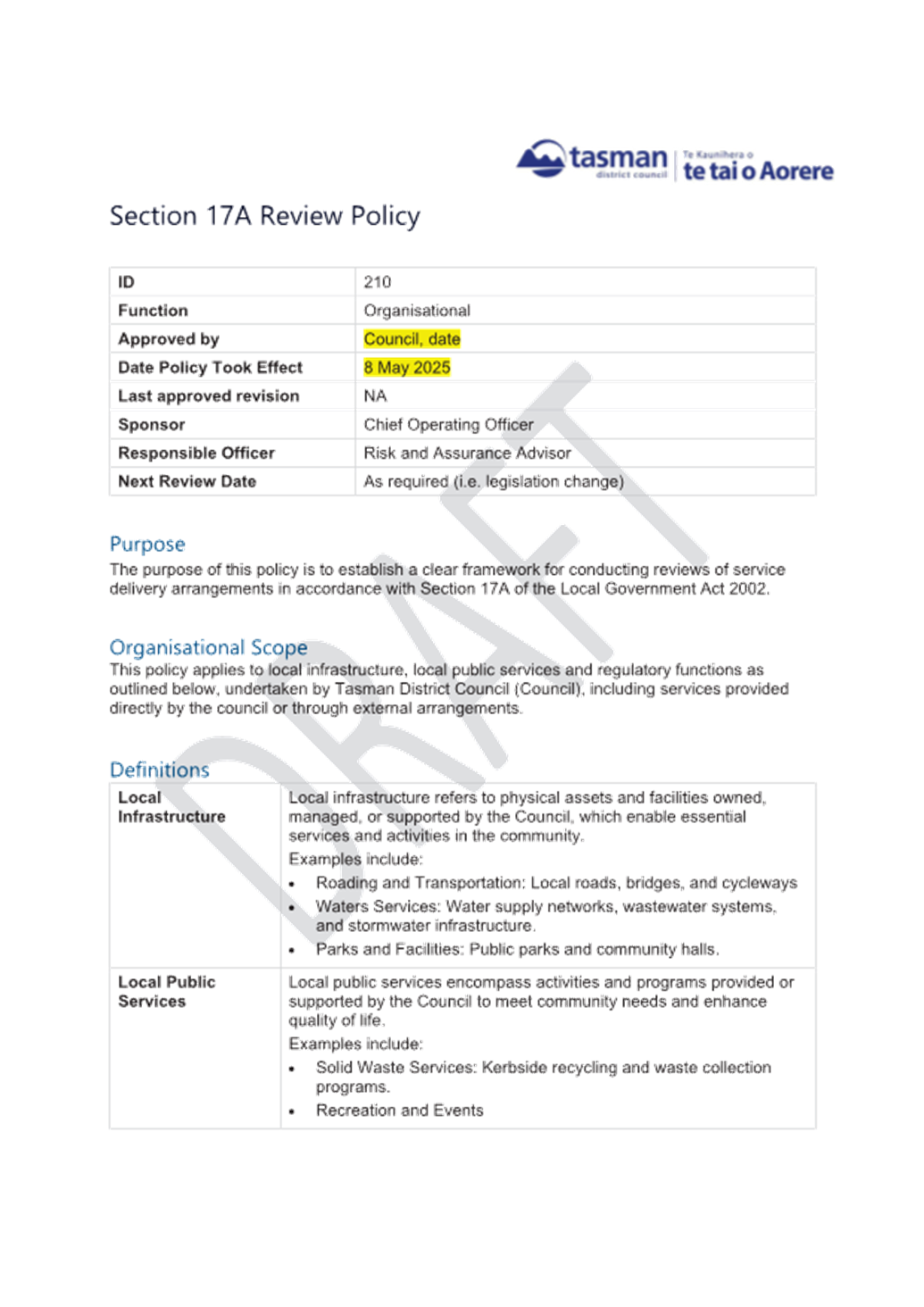
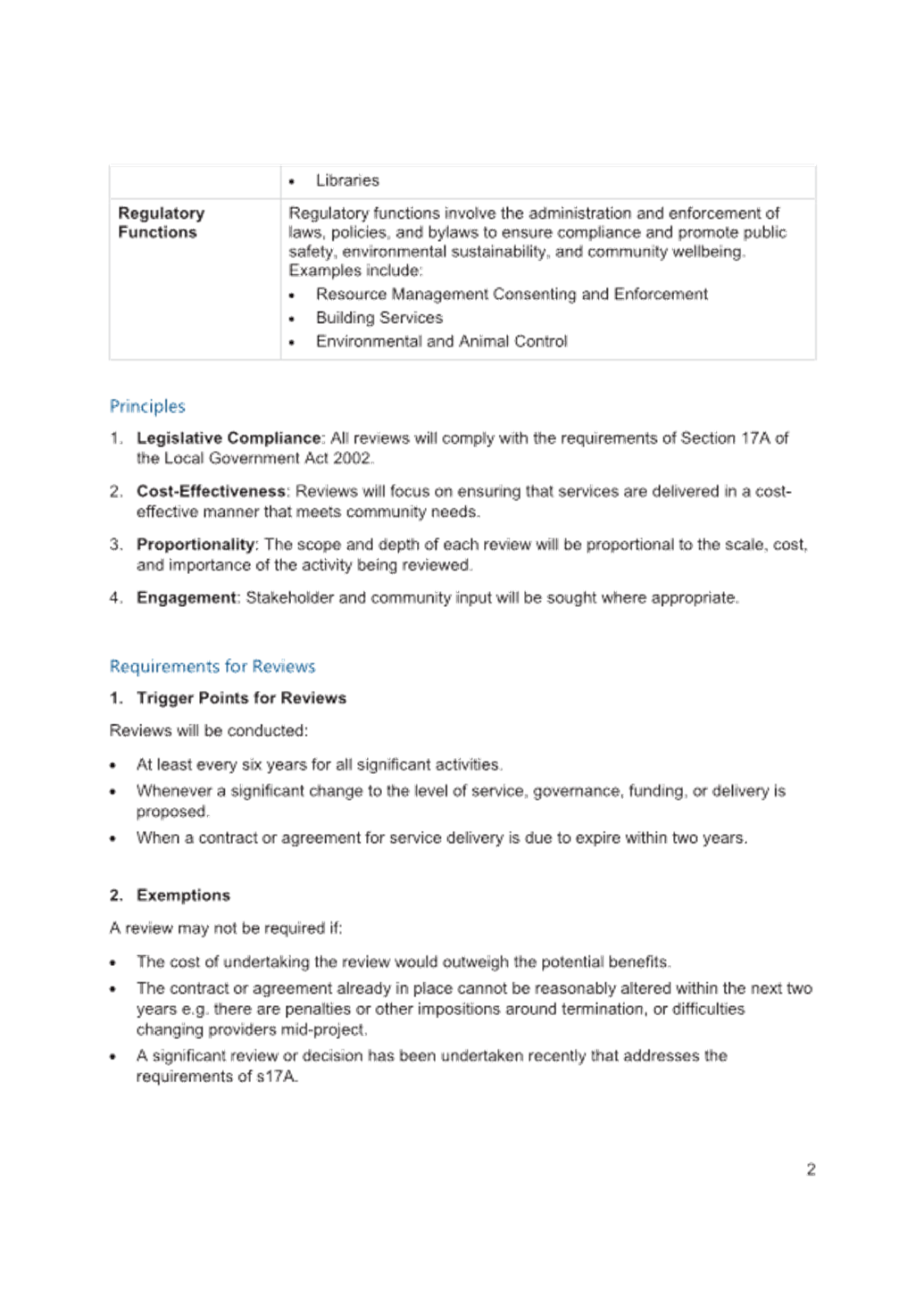
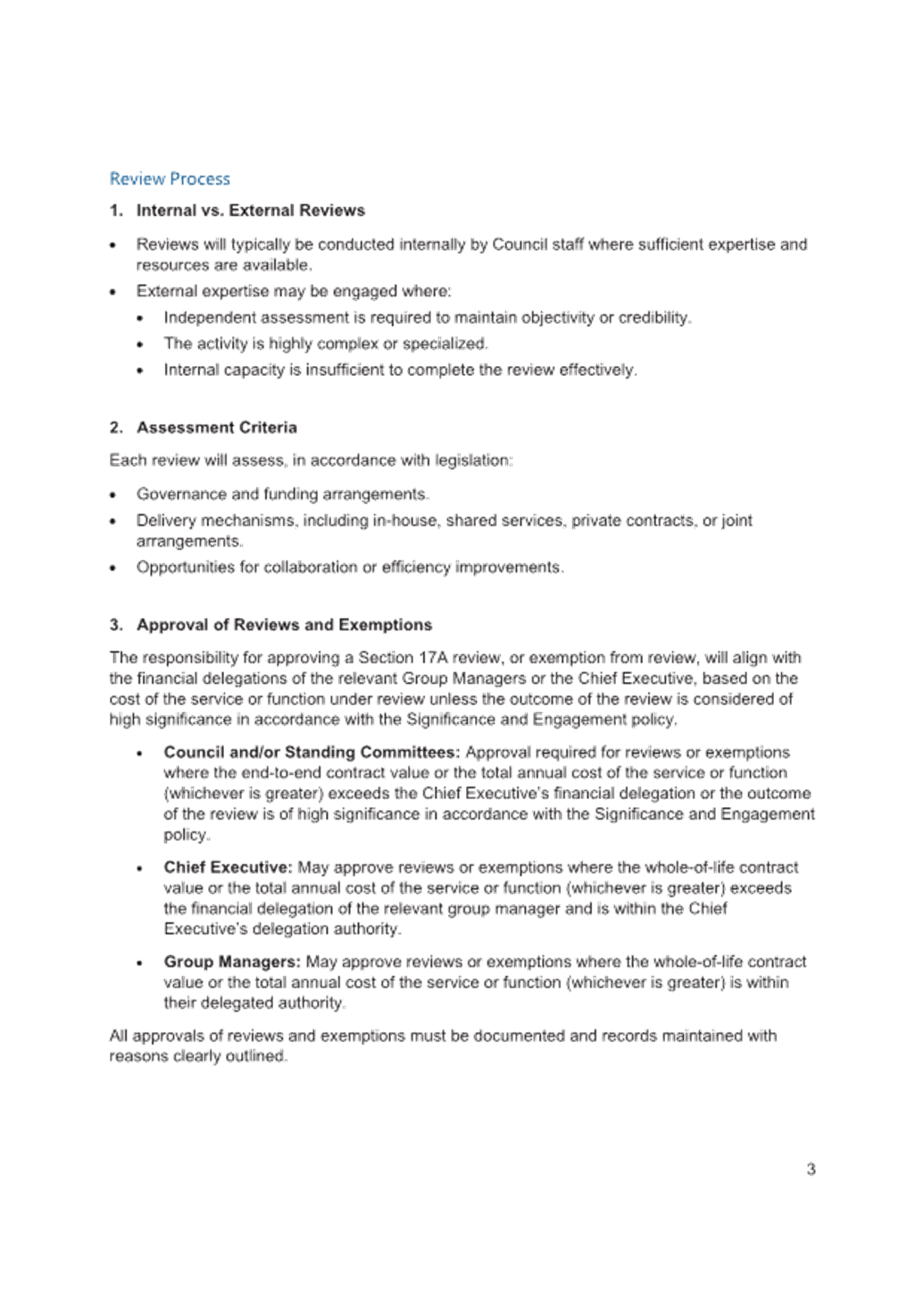
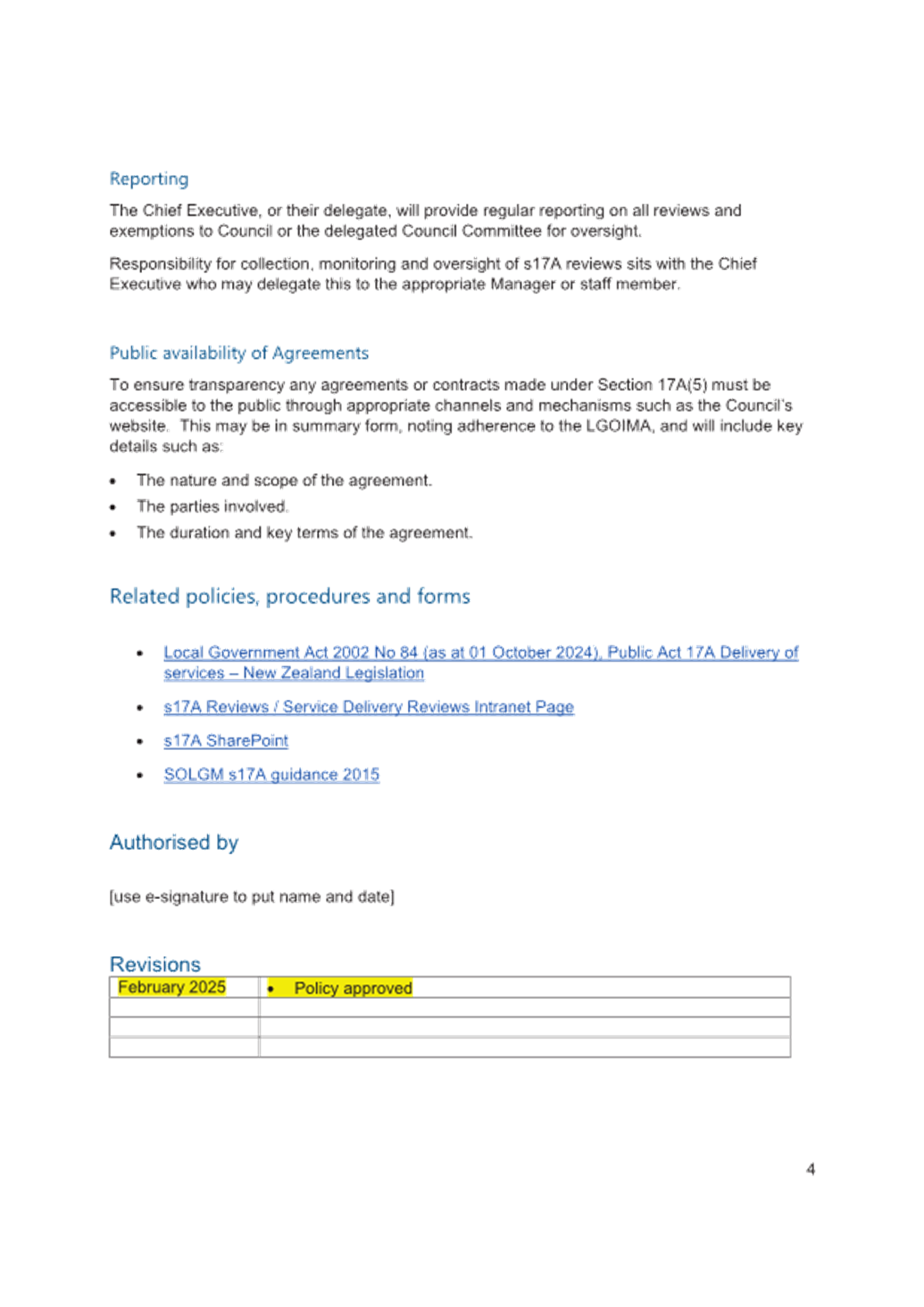
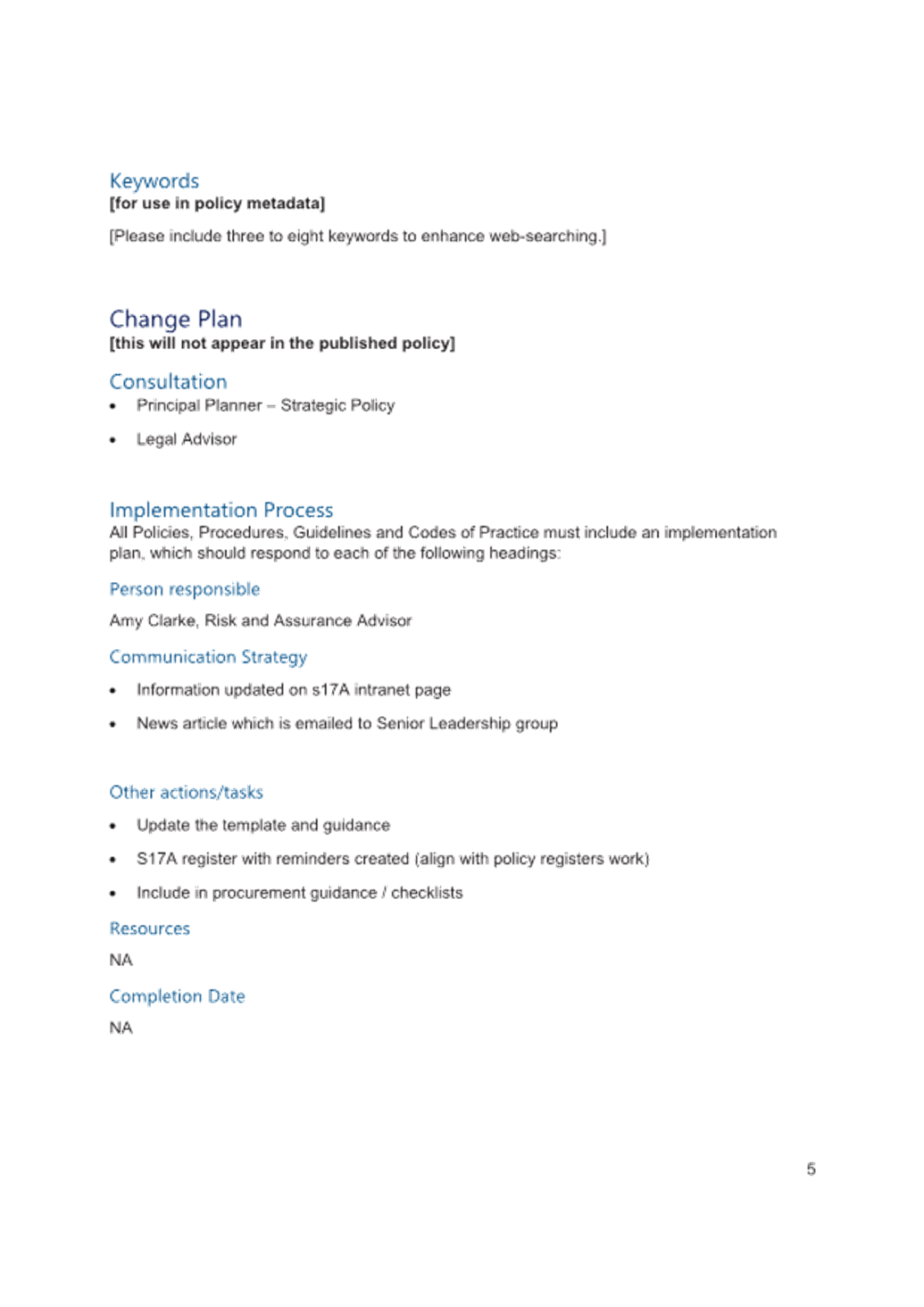
Tasman District Council Agenda – 08 May 2025
7.13 Local Government Funding Agency Nominating Councils
Decision Required
|
Report
To:
|
Tasman
District Council
|
|
Meeting
Date:
|
8
May 2025
|
|
Report
Author:
|
Mike
Drummond, Chief Financial Officer
|
|
Report
Authorisers:
|
Leonie
Rae, Chief Executive Officer
|
|
Report
Number:
|
RCN25-05-14
|
1. Purpose
of the Report / Te Take mō te Pūrongo
1.1 To gain direction on the Council
remaining a Nominating Local Authority (NLA) to the LGFA Shareholders’
Council.
2. Summary
/ Te Tuhinga Whakarāpoto
2.1 The
2025 Annual General Meeting of the Local Government Funding Agency Ltd (LGFA)
is scheduled for 18 November 2025 in Wellington. The agenda items will include
the election of Nominating Local Authorities (NLA’s) to the
Shareholders’ Council.
2.2 Under
the Shareholders’ Agreement, the two NLA members who have been in office
the longest since their election must retire by rotation. They can also offer
themselves for re-election. This year Tasman District Council will retire and
either Christchurch City Council and/or New Plymouth District Council will
retire. Both Christchurch City Council and New Plymouth District
Council who were appointed at the same time, advise that they are seeking
re-election.
2.3 The
Council has been a member of the Shareholders’ Council since the forming
of the LGFA in 2012. There are no elected member appointees to the
Shareholders’ Council. The Council is currently represented on the
Shareholders’ Council by the Chief Financial Officer.
2.4 As
the Chief Financial Officer, I am an active member of the LGFA Shareholders
Council and see clear benefits for the Council in our continued involvement.
The LGFA covers the travel and other costs associated with being a member of
the Shareholders Council.
2.5 The
recommendation is that the Council advises the LGFA that it wishes to remain a
Nominating Local Authority and is standing for re-election at the November 2025
LGFA AGM.
3. Recommendation/s
/ Ngā Tūtohunga
That the Tasman
District Council
1. receives
the Local Government Funding Agency Nominating Councils report, RCN25-05-14;
and
2. confirms that Tasman District Council will offer
itself as a Nominating Local Authority for re-election to the
Shareholders’ Council at the 2025 Local Government Funding Agency Limited
Annual General Meeting.
LGFA Shareholders’ Council Positions
4.1 The
Shareholders’ Council is comprised of between five and ten members with
the current members being the Crown and nine council members. Each NLA can
appoint a member to the Shareholders’ Council and the nine NLAs are
currently Western Bay of Plenty Regional Council, Auckland Council, Tasman
District Council, Wellington City Council, Christchurch City Council, Bay of
Plenty Regional Council, Hamilton City Council, Tauranga City Council and New
Plymouth District Council.
4.2 Under
Section 4.4 of the Shareholders’ Agreement, the two NLA members who have
been in office the longest since their election must retire by rotation. They
can also offer themselves for re-election. Accordingly, this year Tasman
District Council and Christchurch City Council, New Plymouth District Council
will retire and seek re-election.
4.3 If
other Shareholders wish to nominate any candidates as NLAs on the
Shareholders’ Council, then the nomination must be received by the LGFA
by the close off for resolutions going to the AGM (September/ October 2025).
5. Analysis
and Advice / Tātaritanga me ngā tohutohu
5.1 This is a routine decision. The
Council’s involvement on the LGFA Shareholders’ Council has been
ongoing since the Council worked with eight other councils and the Crown to
form the LGFA in 2012.
5.2 The role of the
Shareholders' Council is to advise Shareholders on certain matters (with
Shareholders, and not the Shareholders' Council, to make decisions with respect
to those matters). The Shareholders' Council shall:
5.2.1 review the performance of the Company and the Board, and
report to Shareholders on these matters on a periodic basis, being no less
frequently than every six months; and
5.2.2 make recommendations to Shareholders as to the appointment,
removal, re-election, replacement and remuneration of Directors. For this
purpose, the Shareholders' Council may request information from, and meet with,
Directors (or persons nominated for election as Directors); and
5.2.3 make recommendations to Shareholders
as to any matters which require the approval of Shareholders pursuant to clause
5.1; and (d) endeavour to ensure that Shareholders are fully informed on
matters concerning the Company, and endeavour to co-ordinate Shareholders on
decisions required of Shareholders with respect to governance of the Company.
5.3 Participation
in the Shareholders' Council allows for insights and involvement in the
decision-making processes for the LGFA.
6. Financial
or Budgetary Implications / Ngā Ritenga ā-Pūtea
6.1 This decision has no direct
financial or budgetary implications. If the Council is re-elected as a
nominating Local Authority, the costs of the Chief Financial Officer’s
travel to the Shareholders’ Council meetings will continue to be met by the
LGFA.
7.1 The options are outlined in the
following table:
|
Option
|
Advantage
|
Disadvantage
|
|
1.
|
That the Council confirms its previous
position and remains a Nominating Local Authority.
|
This option maintains the existing status
quo. It allows the Council to continue to participate in the decision making
and recommendations that occur through the LGFA Shareholders’ Council.
The Council incurs cost for staff time for this involvement (travel costs are
met by the LGFA). The time involved is considered moderate as the
Shareholders’ Council meets around four times a year.
|
|
|
2.
|
That the Council advises that it no
longer wishes to be a Nominating Local Authority.
|
This would open the way for another
shareholding council to participate in the Shareholders’ Council.
|
This approach is not recommended as
participation in the Shareholders' Council allows for insights and
involvement in the decision-making processes.
|
7.2 Option 1 is recommended.
8.1 The
Mayor has delegated authority to vote the Council shares. This authority is
only used when it’s not practical to have matters considered by the
Council due to time constraints.
8.2 The
LGFA Shareholders Agreement covers the Shareholders Council (Attachment 1)
Clauses 4.4 to 4.8 (reproduced below) cover the Nominating
Local Authority and shareholders council provisions.
8.3 4.3 Appointment of Nominating
Local Authority by Shareholders: A Principal Shareholder may be appointed
or removed as a nominator to the Shareholders' Council ("Nominating Local
Authority") at any time by an Ordinary Resolution, provided that no more
than nine Nominating Local Authorities may be so appointed.
8.4 4.4 Appointment of members of
the Shareholders' Council: Each Nominating Local Authority may appoint one
member of the Shareholders' Council, and remove and replace any member so
appointed by it, in each case, by notice to the Company. Each member appointed
by a Nominated Local Authority must be an employee or councillor of that
Nominating Local Authority. In addition, the New Zealand Government (for so
long as it is a Shareholder) may appoint one other member of the Shareholders'
Council, and remove and replace such other member so appointed by it, in each
case, by notice to the Company.
8.5 4.5 Notification and consent:
Each member of the Shareholders' Council appointed by a Nominating Local
Authority must give consent in writing to the appointment (which consent shall
confirm that the person shall comply with the terms of this agreement as they
apply to members of the Shareholders' Council). Notice by a Nominating Local
Authority of the appointment of a member and consent from that person to the
appointment must be received by the Company before any member may attend a
meeting of the Shareholders' Council.
8.6 4.6 Rotation of Nominating
Local Authorities: Beginning at, and including, the annual meeting for
2013, the Shareholders shall ensure that two Nominating Local Authorities shall
retire from office at the annual meeting of the Company in each year. The
Nominating Local Authorities to retire shall be those who have been longest in
office since their last election. If two or more of those Nominating Local
Authorities were last elected on the same day, the Nominating Local Authority
to retire shall (unless they otherwise agree among themselves) be determined by
lot. A retiring Nominating Local Authority shall be eligible for re-election.
8.7 4.7 Re-election of retiring
Nominating Local Authority: A Nominating Local Authority retiring by
rotation at a meeting shall, if standing for re-election, be deemed to have
been re-elected unless:
(a) some other Principal Shareholder is elected
to fill the vacated office; or
(b) it is resolved not to fill the vacated
office; or
(c) a resolution for the re-election of that
Nominating Local Authority is put to the meeting and lost.
8.8 4.8 Nomination of Nominating Local Authority: No Principal Shareholder may be elected as a Nominating Local
Authority at a meeting (other than a member retiring at the meeting) unless,
not less than one week prior to the notice of that meeting being sent to
Shareholders, that Principal Shareholder has notified the Company in writing
that it wishes to seek that election. The Company shall give notice that the
Principal Shareholder is seeking that election to all persons entitled to
attend the meeting together with, or as part of, the notice of meeting.
9. Iwi
Engagement / Whakawhitiwhiti ā-Hapori Māori
9.1 This is a routine matter and no specific
engagement with Iwi has occurred.
10. Significance
and Engagement / Hiranga me te Whakawhitiwhiti ā-Hapori Whānui
1.2 This is considered a routine decision of
low significance and no engagement with the community is required.
|
|
Issue
|
Level of Significance
|
Explanation of
Assessment
|
|
1.
|
Is there a high level
of public interest, or is decision likely to be controversial?
|
Low
|
Routine matter with
no public interest.
|
|
2.
|
Are there impacts on
the social, economic, environmental or cultural aspects of well-being of the
community in the present or future?
|
No
|
|
|
3.
|
Is there a
significant impact arising from duration of the effects from the decision?
|
Low
|
No.
|
|
4.
|
Does the decision
relate to a strategic asset? (refer Significance and Engagement Policy for
list of strategic assets)
|
Yes
|
This is of a routine
nature.
|
|
5.
|
Does the decision
create a substantial change in the level of service provided by Council?
|
No
|
|
|
6.
|
Does the proposal,
activity or decision substantially affect debt, rates or Council finances in
any one year or more of the LTP?
|
No
|
|
|
7.
|
Does the decision
involve the sale of a substantial proportion or controlling interest in a CCO
or CCTO?
|
No
|
|
|
8.
|
Does the
proposal or decision involve entry into a private sector partnership or
contract to carry out the deliver on any Council group of activities?
|
No
|
|
|
9.
|
Does the proposal or
decision involve Council exiting from or entering into a group of
activities?
|
No
|
|
|
10.
|
Does the proposal
require particular consideration of the obligations of Te Mana O Te Wai
(TMOTW) relating to freshwater or particular consideration of current
legislation relating to water supply, wastewater and stormwater
infrastructure and services?
|
No
|
|
11. Communication
/ Whakawhitiwhiti Kōrero
11.1 The LGFA Shareholders’ Council and the LGFA
will be advised of the decision.
12.1 The
recommended decision continues the status quo position.
12.2 The
Council’s participation as a Nominating Local Authority is important
given our debt levels and our reliance on the LGFA for funding. Participation
in the Shareholders’ Council is not onerous and allows us to continue to
participate in the overall decision-making processes.
13. Climate
Change Considerations / Whakaaro
Whakaaweawe Āhuarangi
13.1 Climate Change considerations are not
relevant to this report.
14. Alignment
with Policy and Strategic Plans / Te Hangai ki ngā aupapa Here me ngā
Mahere Rautaki Tūraru
14.1 There are no other policy decisions or plans
relevant to this decision.
15. Conclusion
/ Kupu Whakatepe
15.1 This decision is a relatively routine
matter. The recommendation is for the Council to continue its role as a
Nominating Local Authority and therefore remain on the LGFA Shareholders’
Council.
16. Next
Steps and Timeline / Ngā Mahi Whai Ake
1.3 The Council will advise the Local
Government Funding Agency and the Shareholders’ Council of its decision.
If nominations exceed the vacancies available, then there will be a shareholder
vote on the matter at the LGFA Annual General Meeting in November 2025.
|
1.⇩
|
Local
Government Funding Agency Shareholders Agreement
|
172
|
Tasman District
Council
Agenda – 08 May 2025
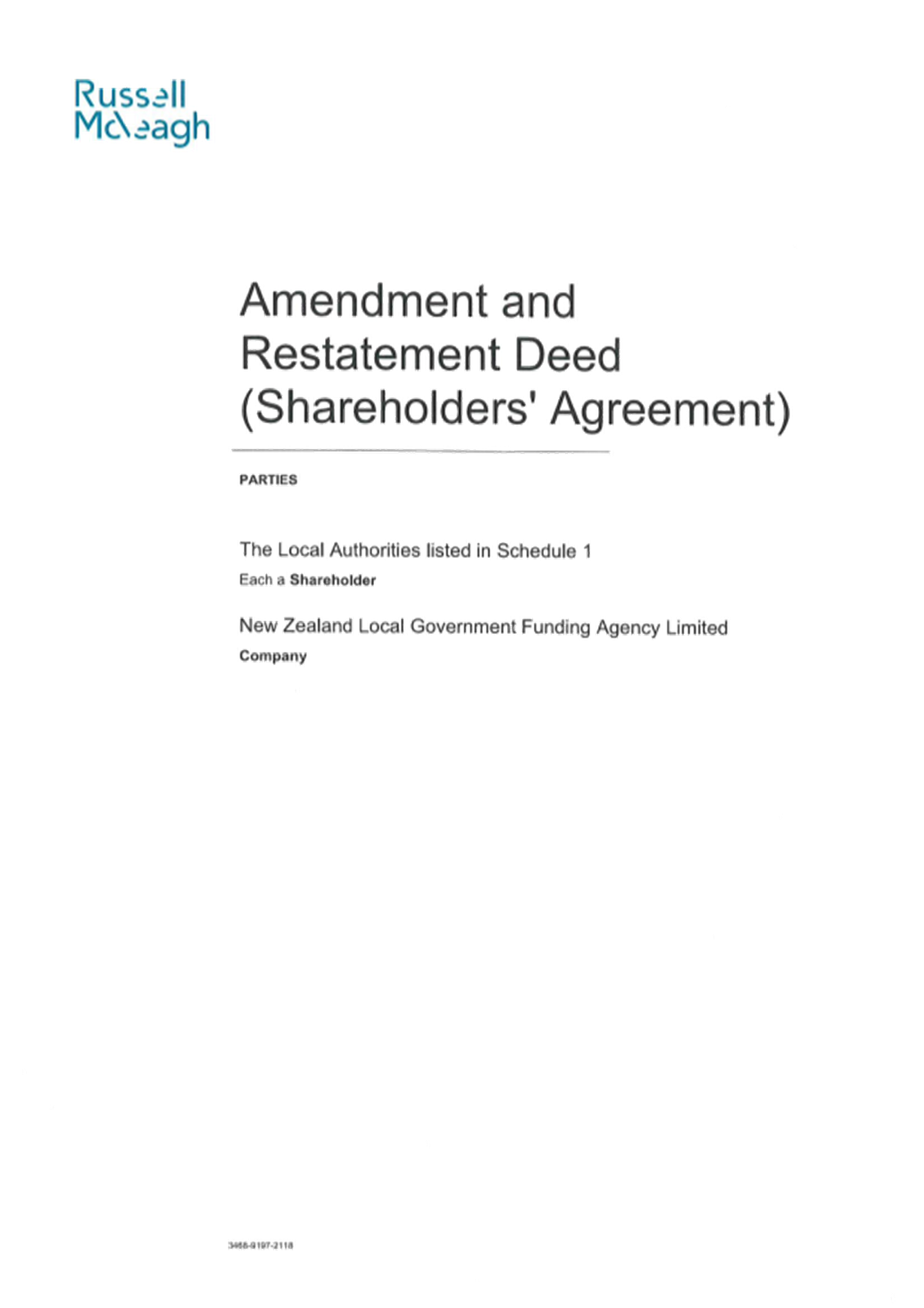
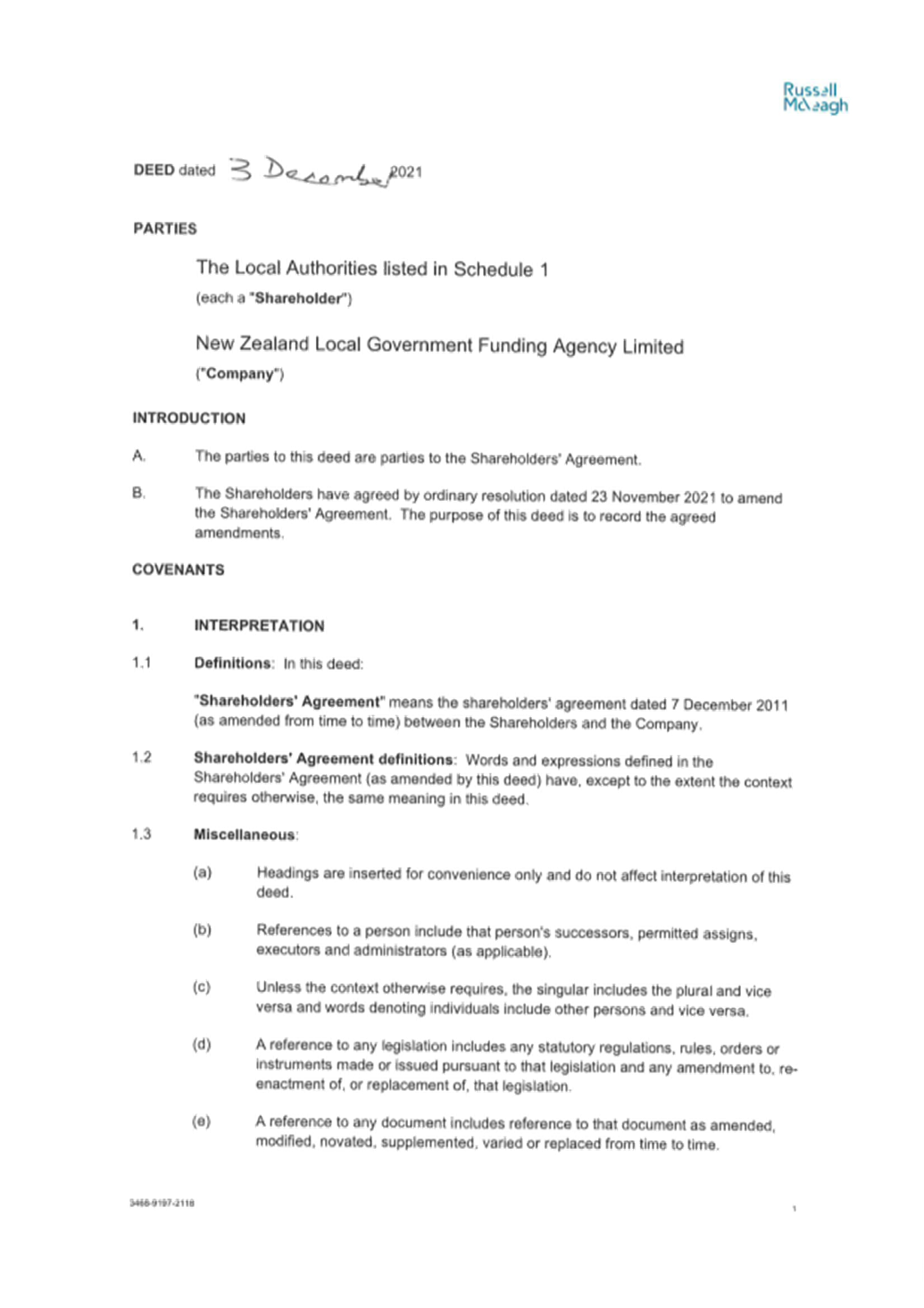
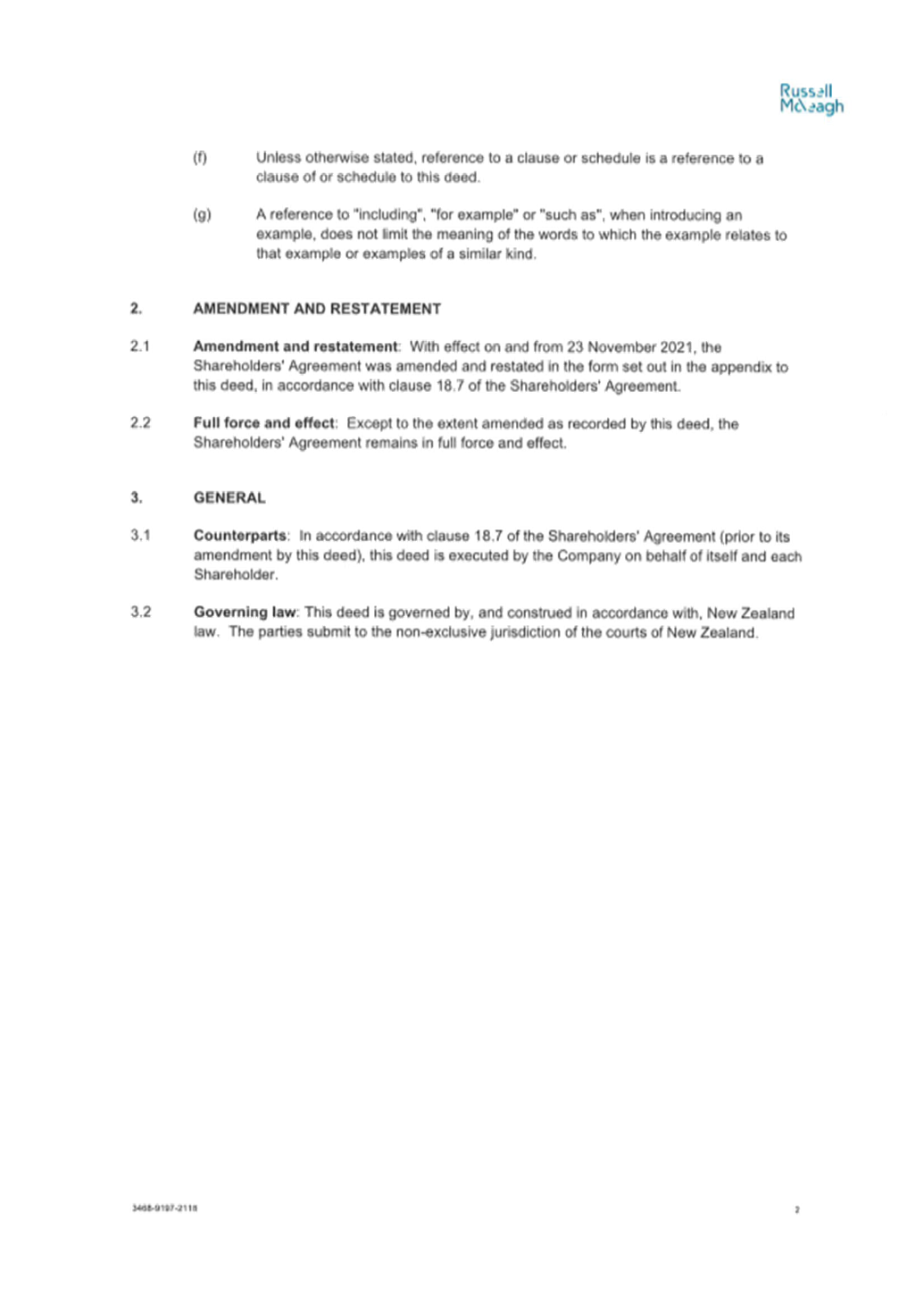




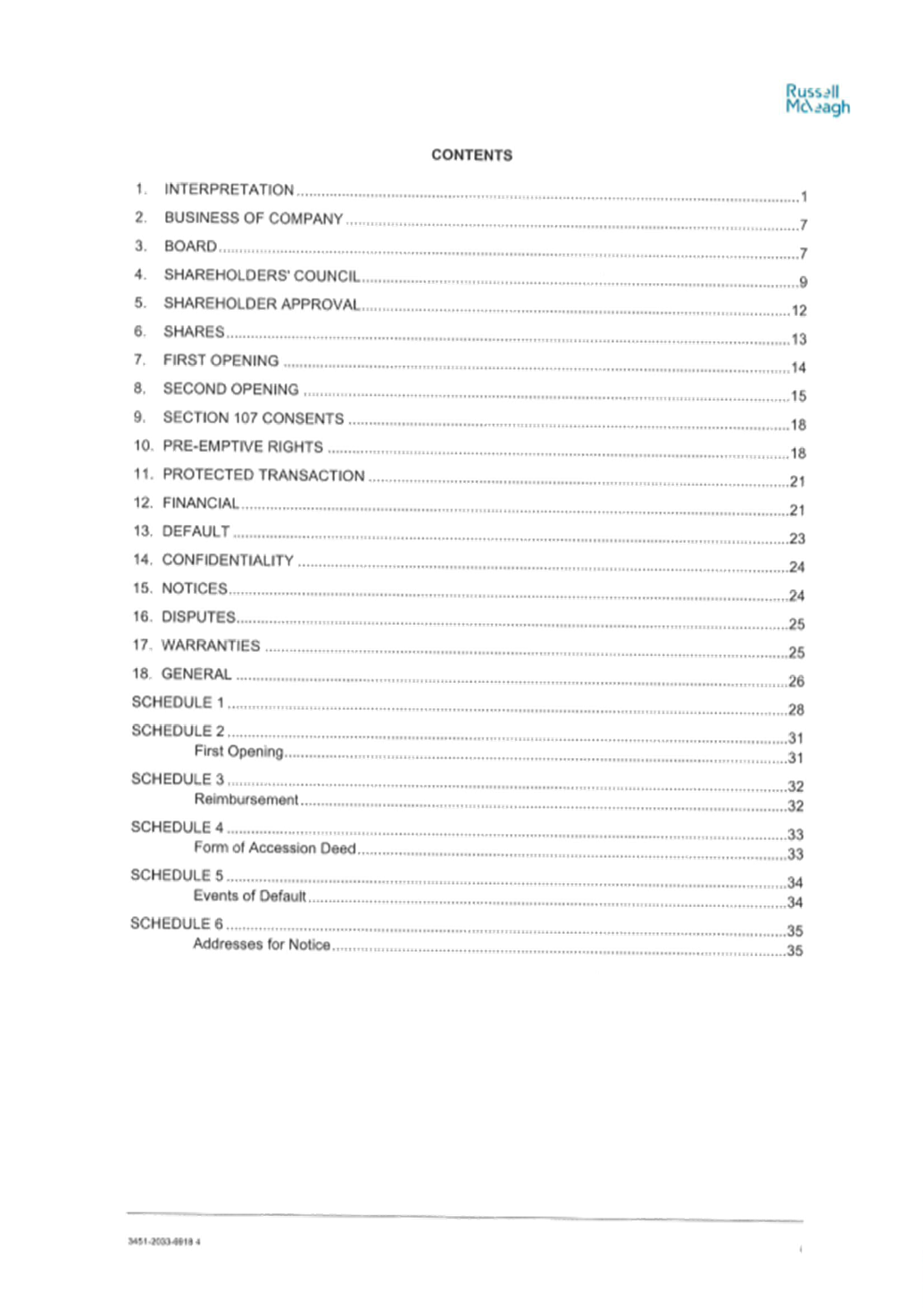
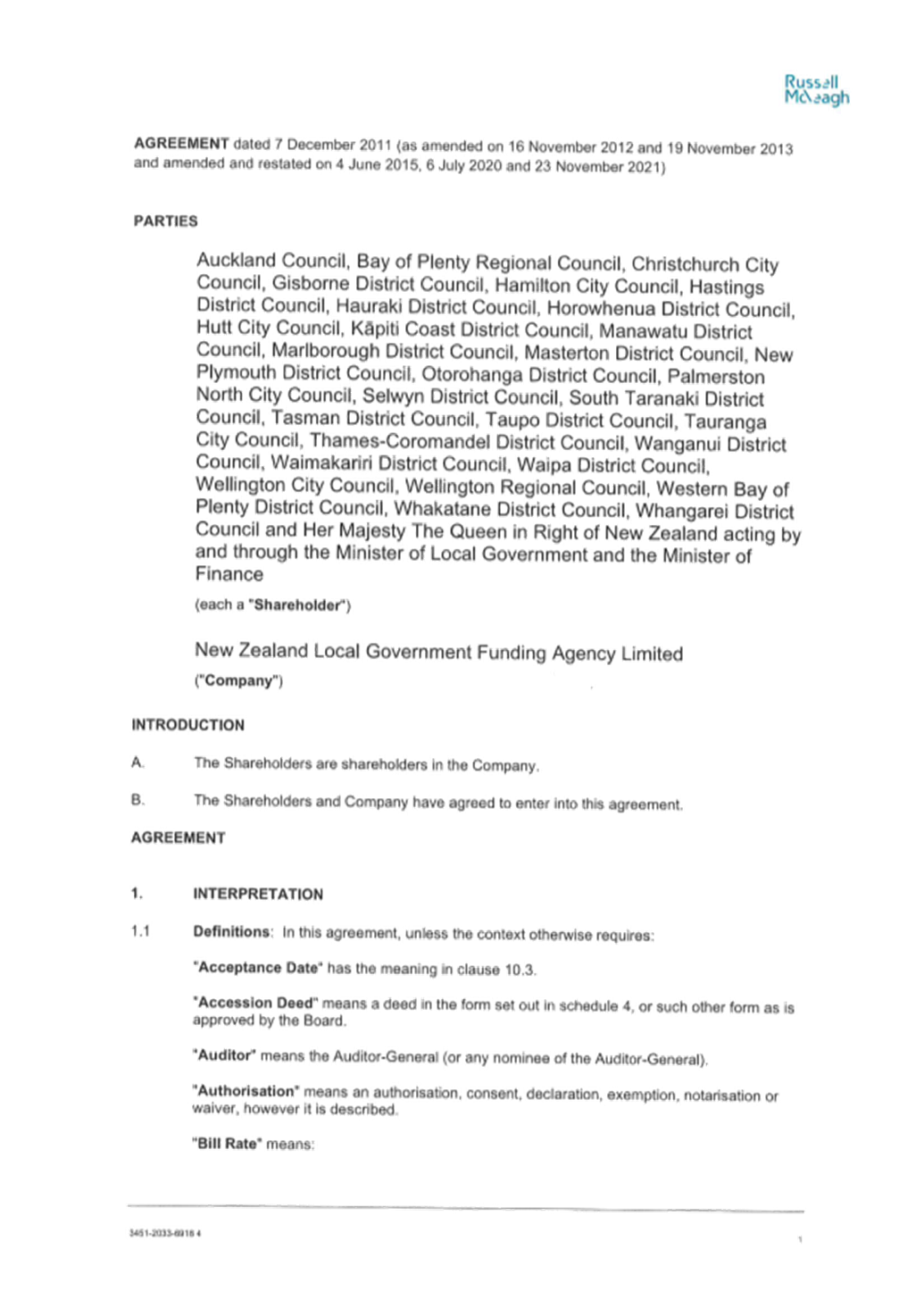
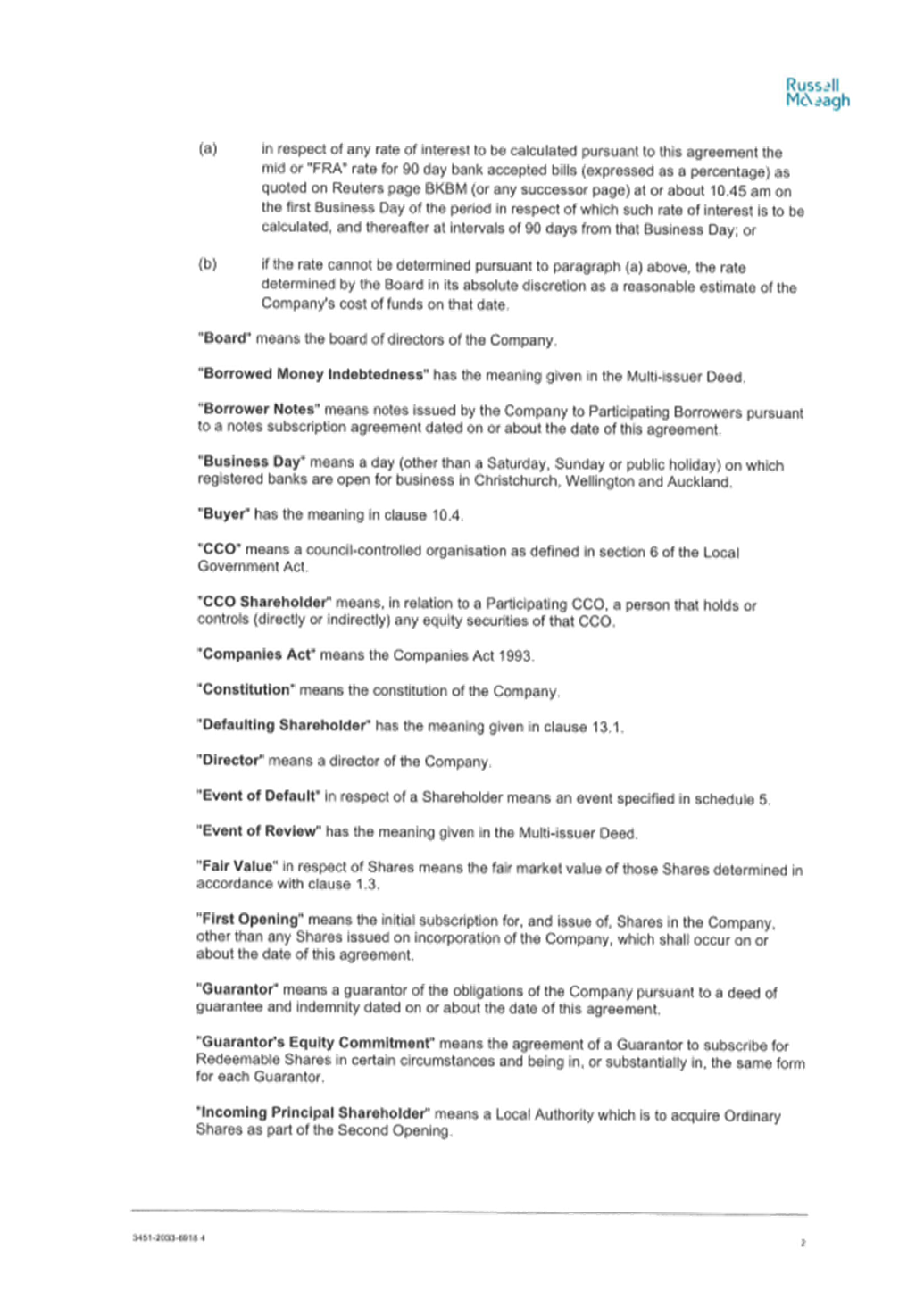
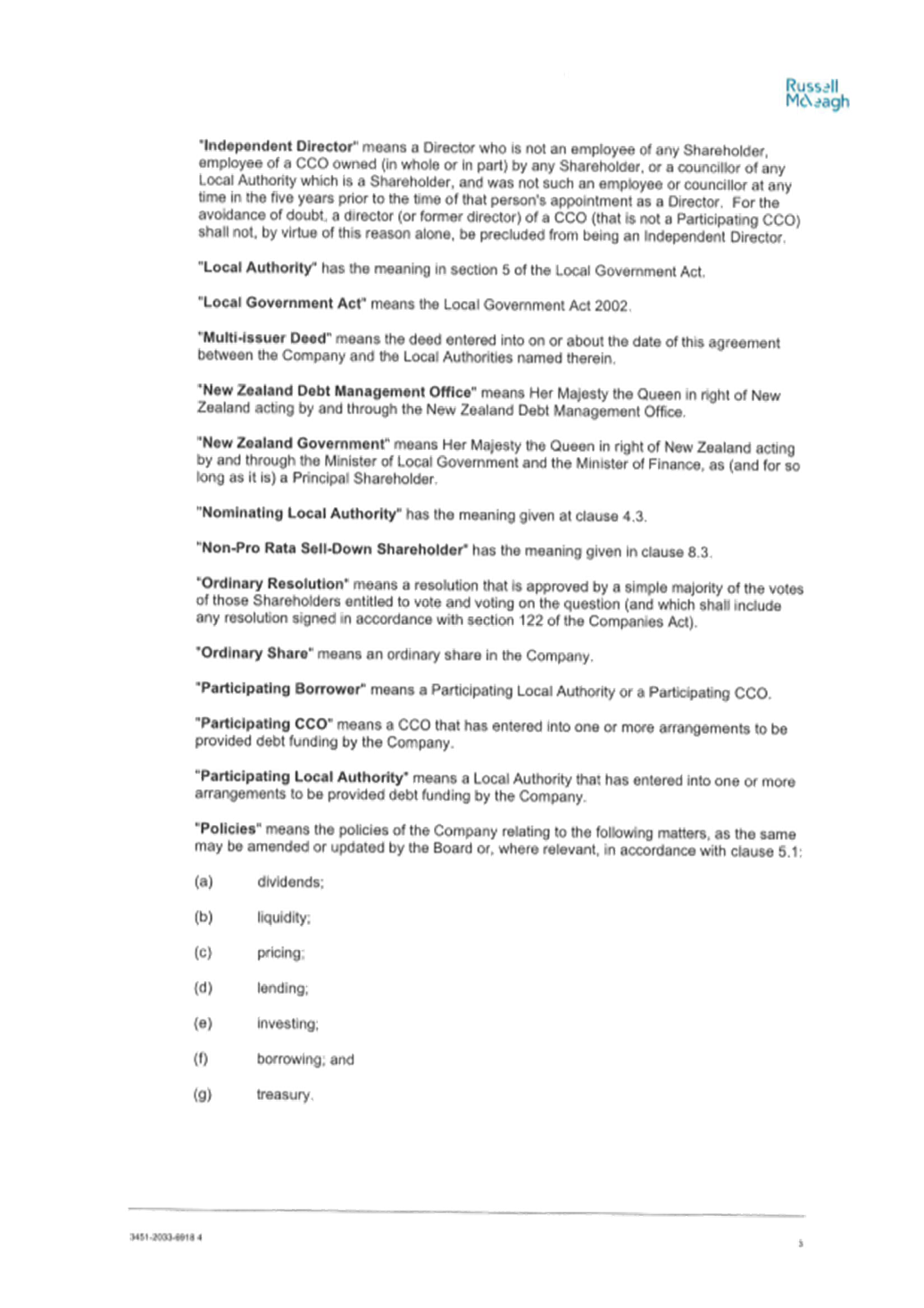
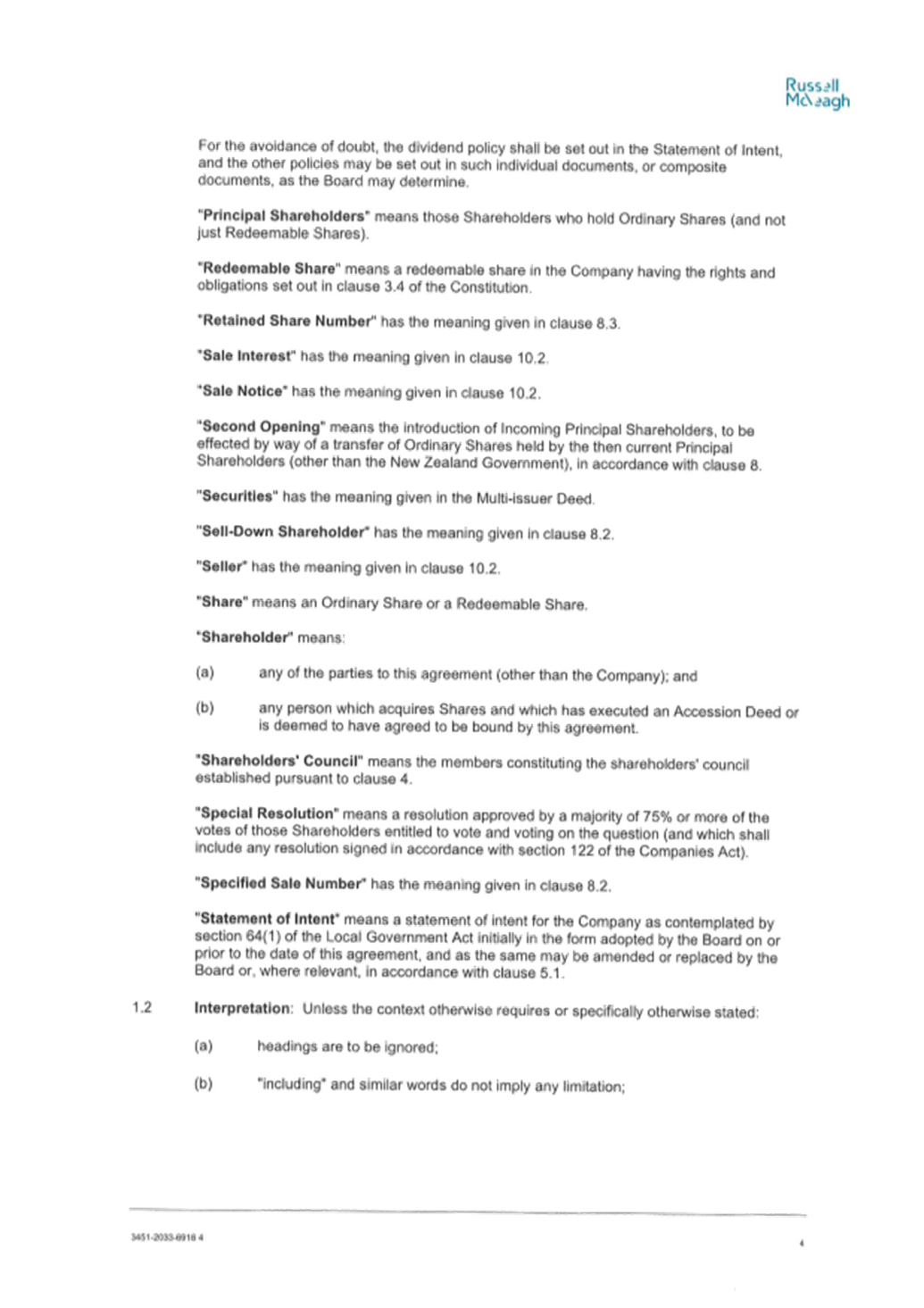
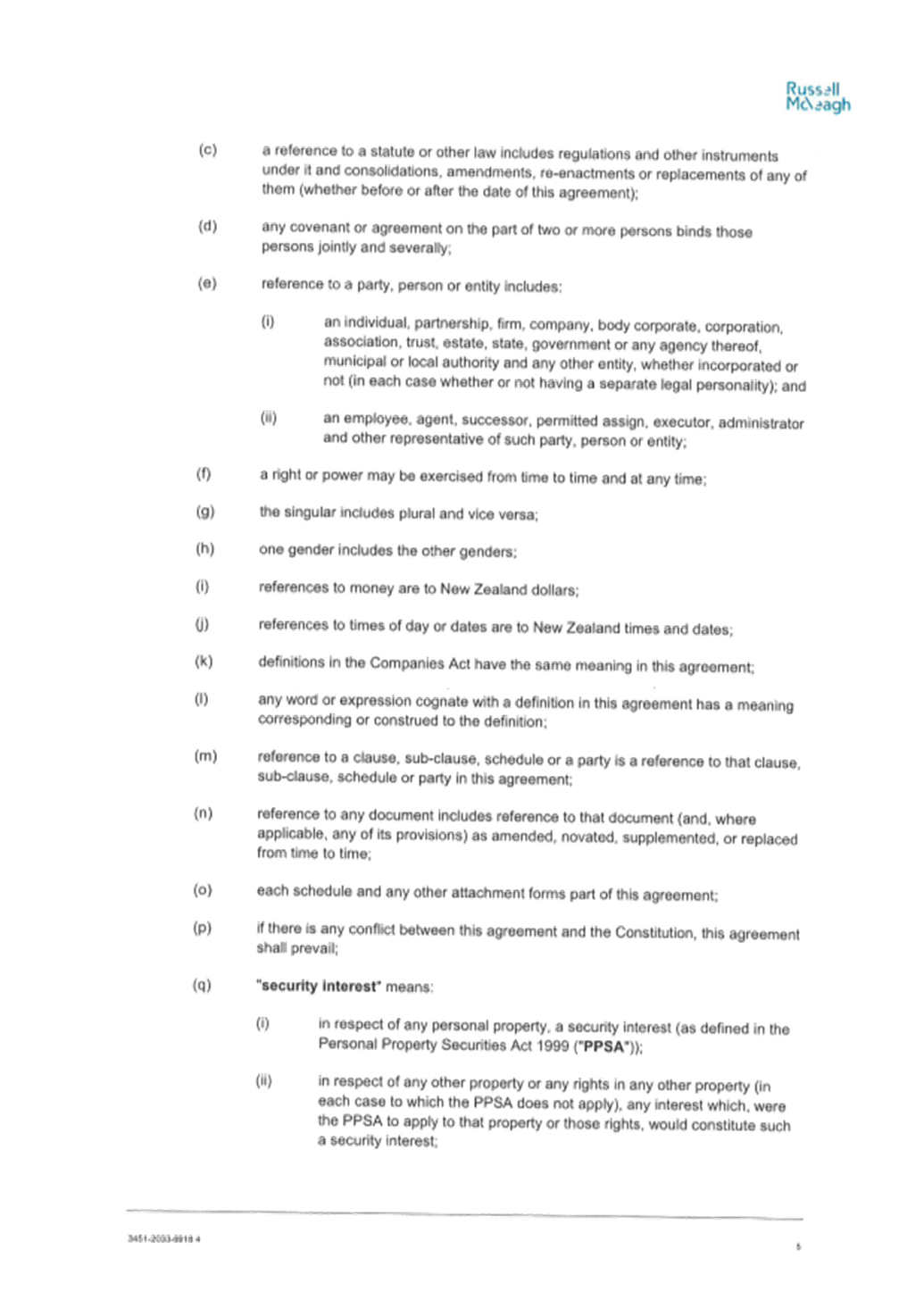

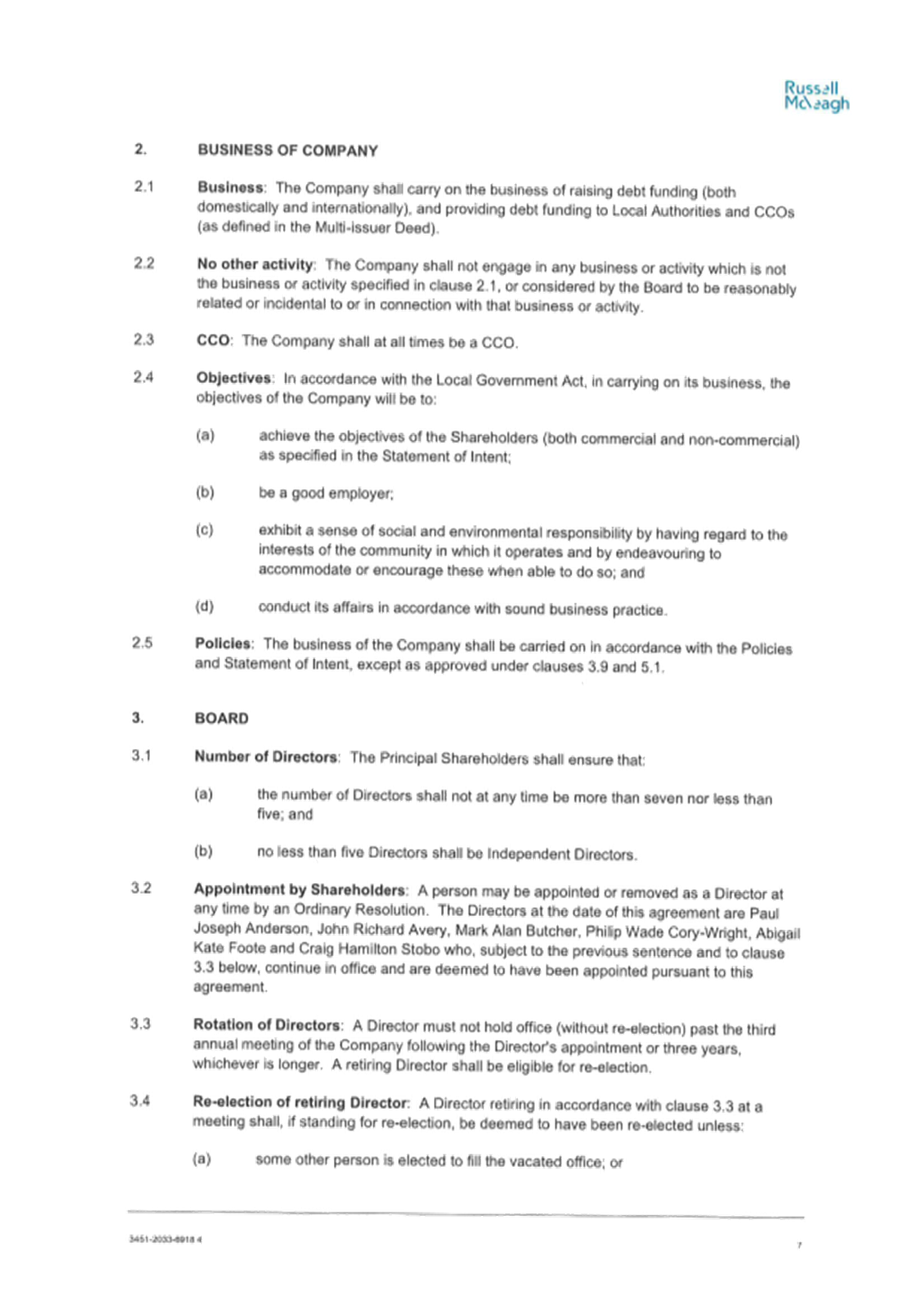
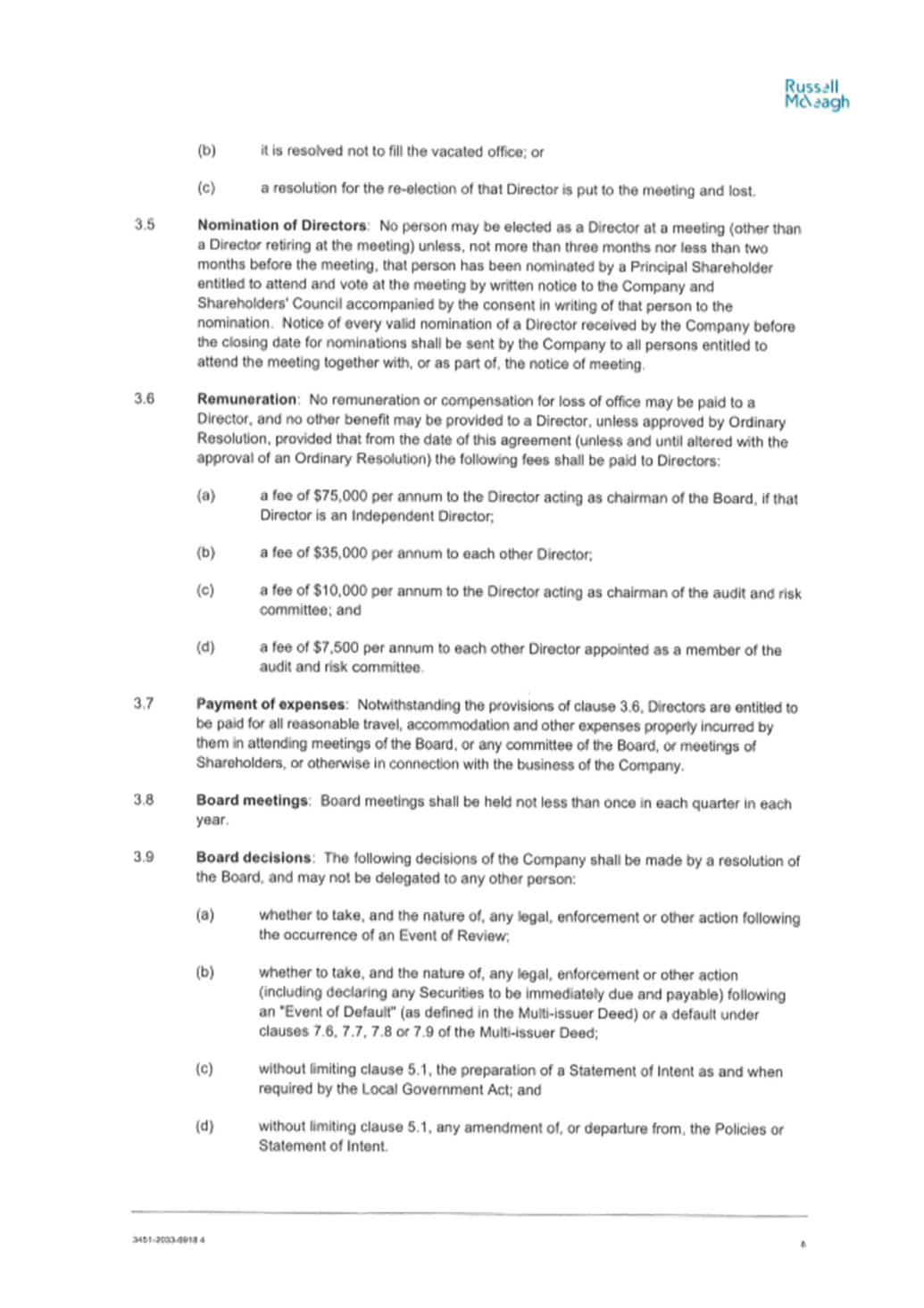
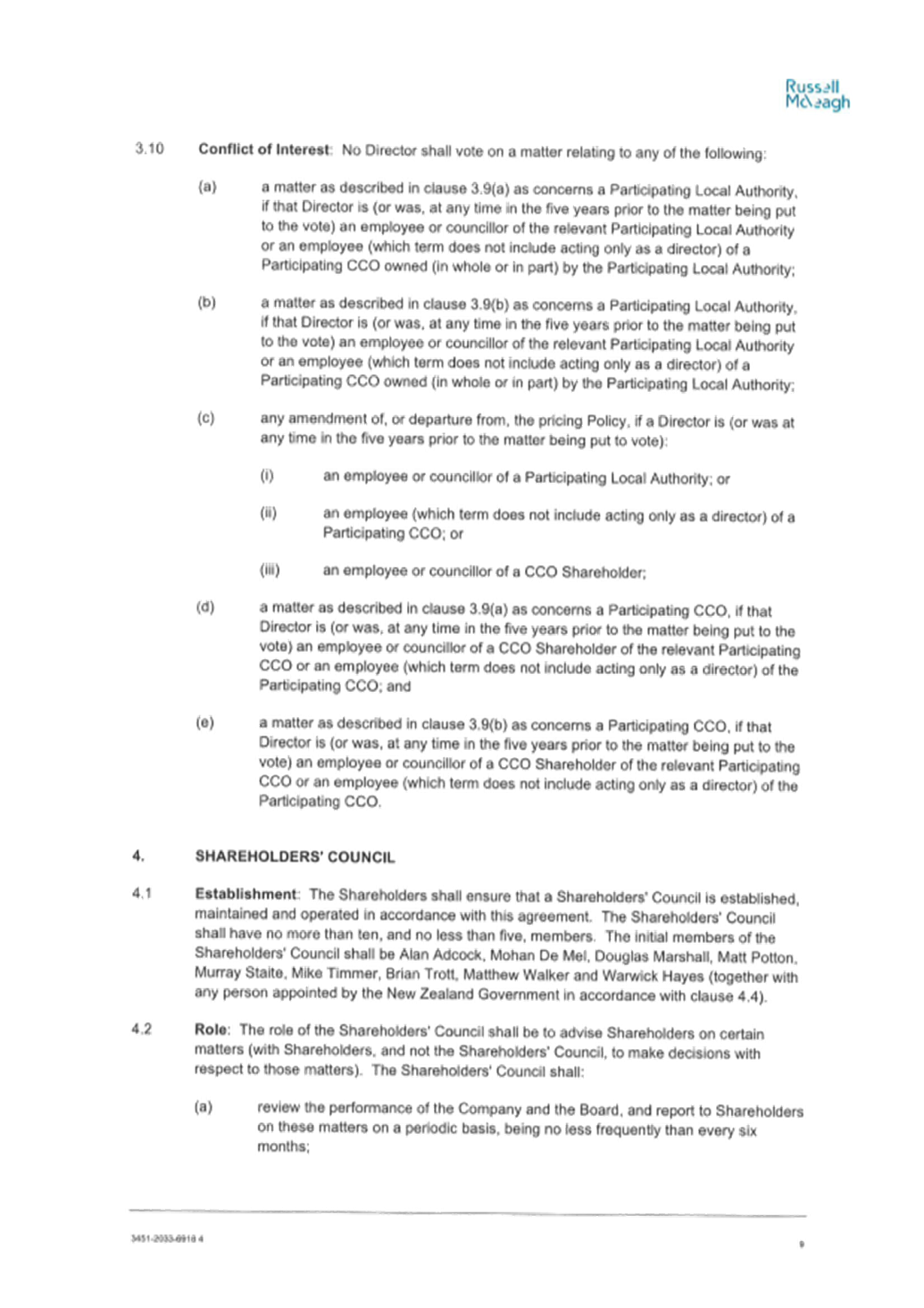

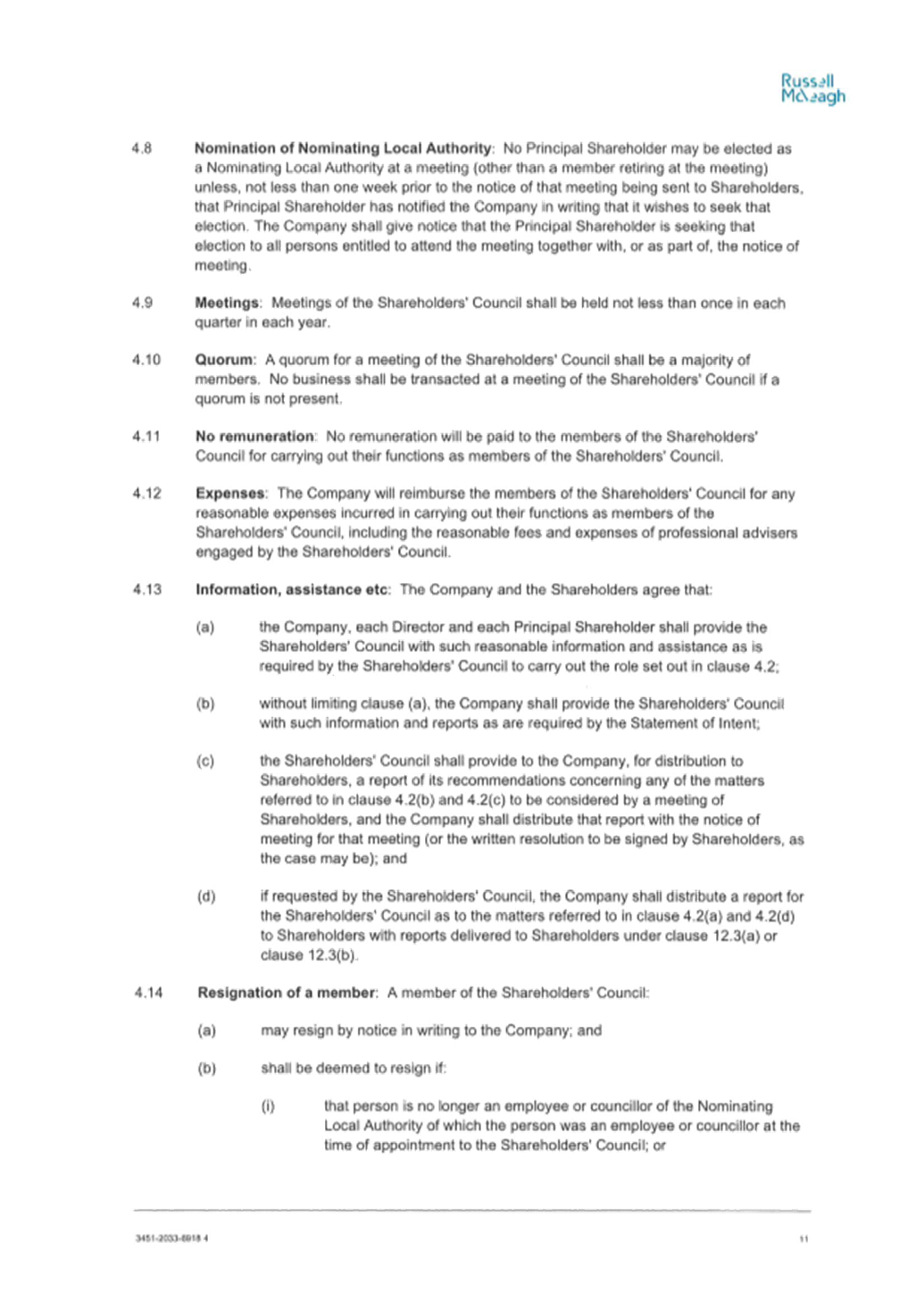
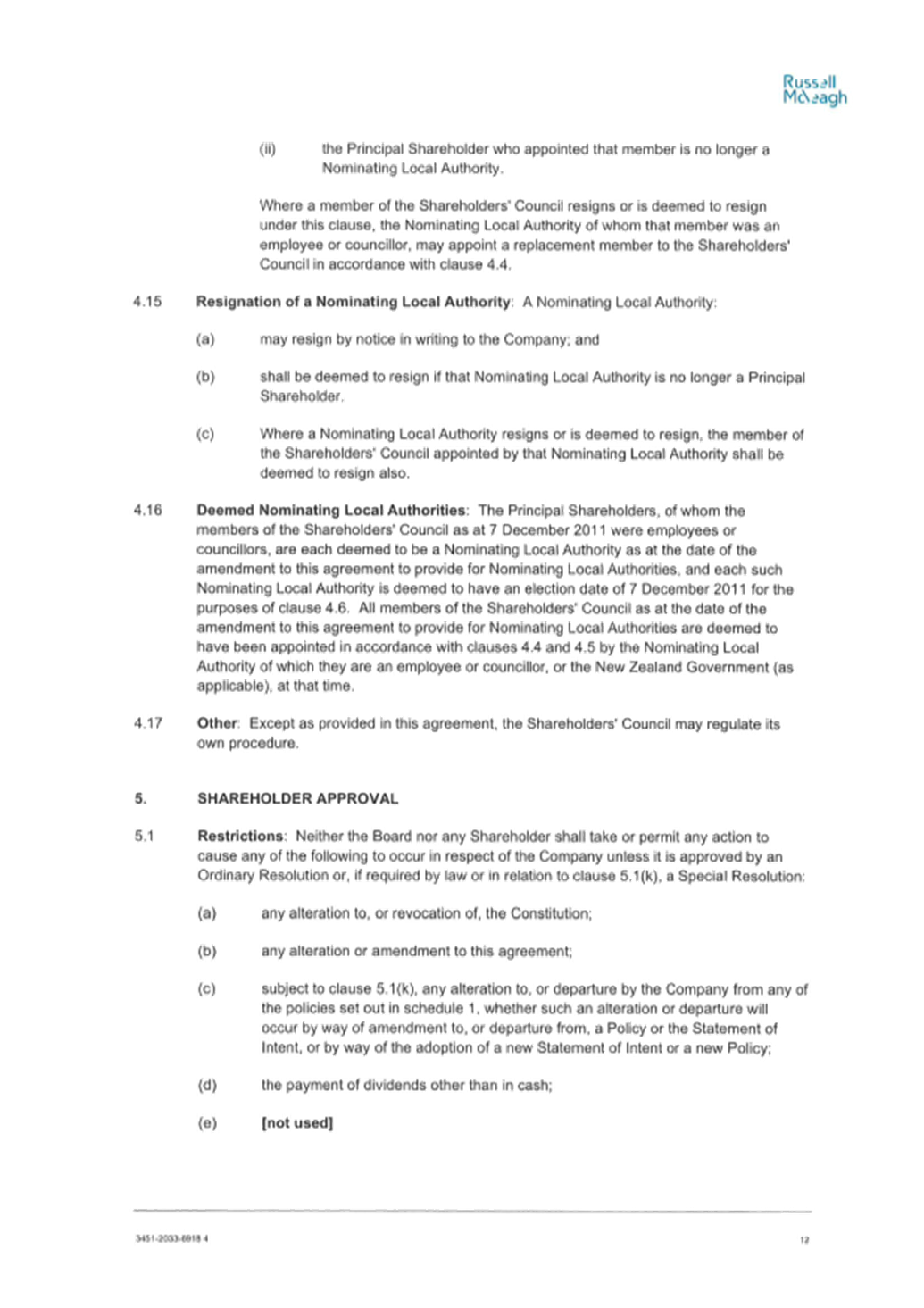

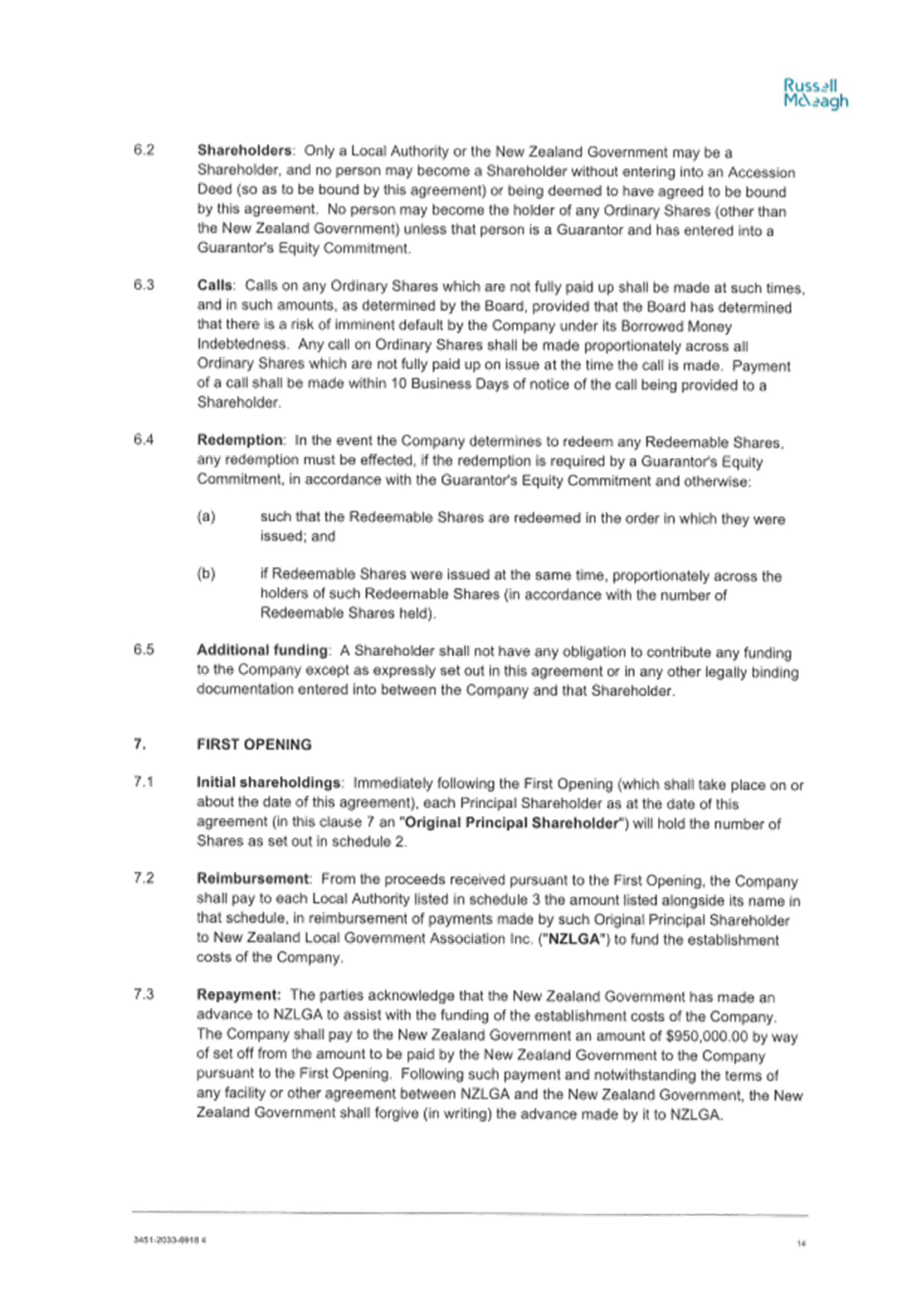
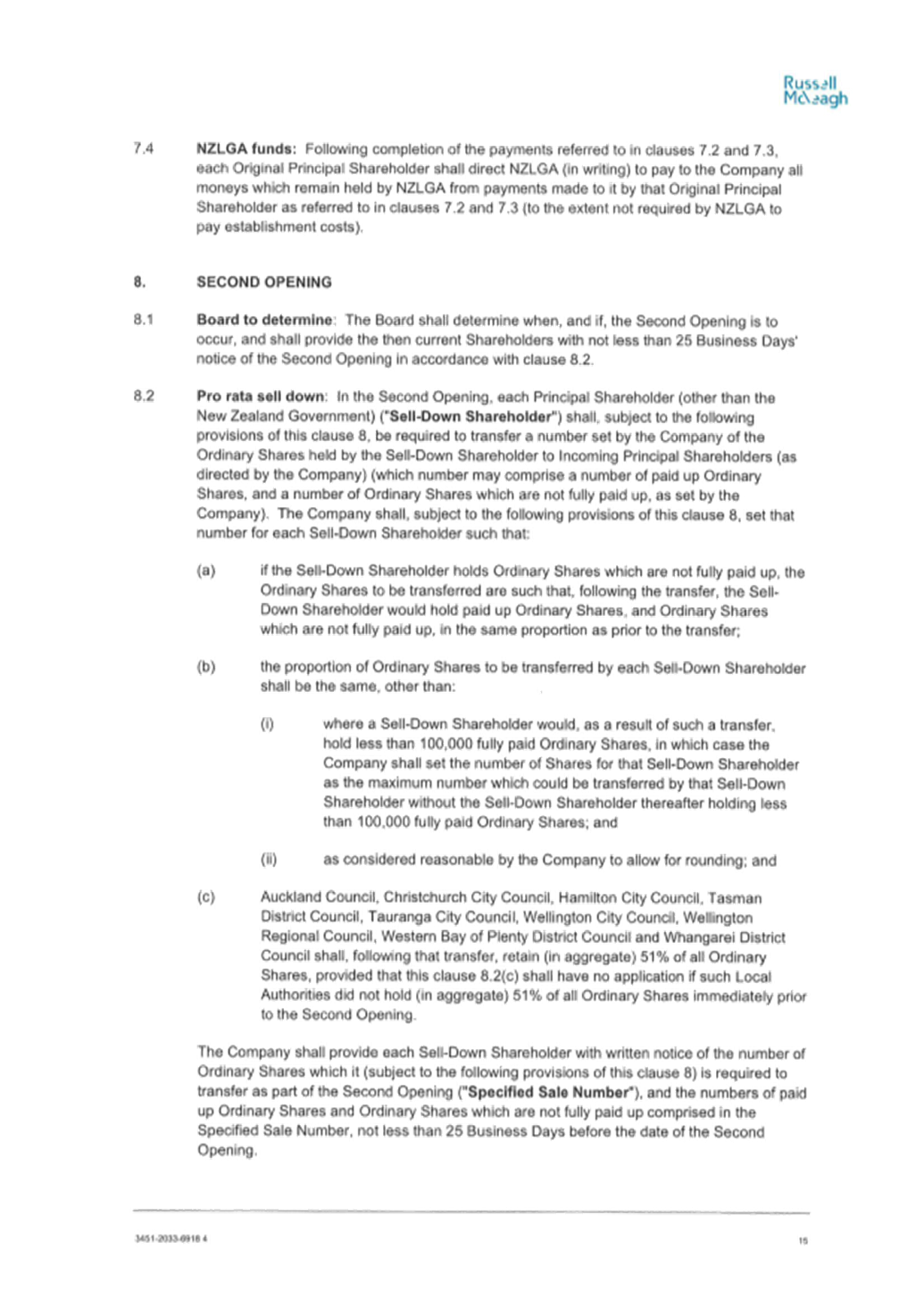
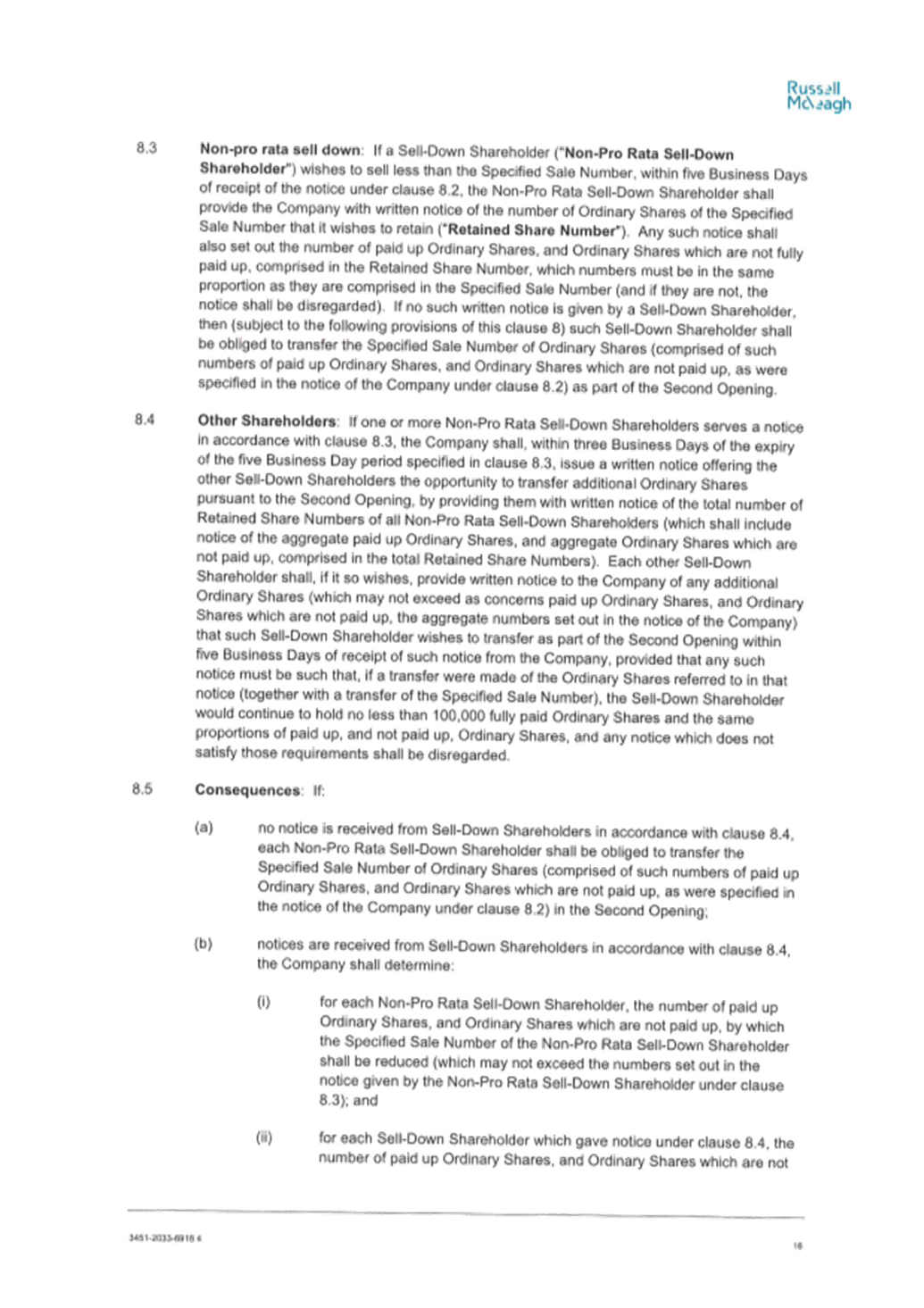
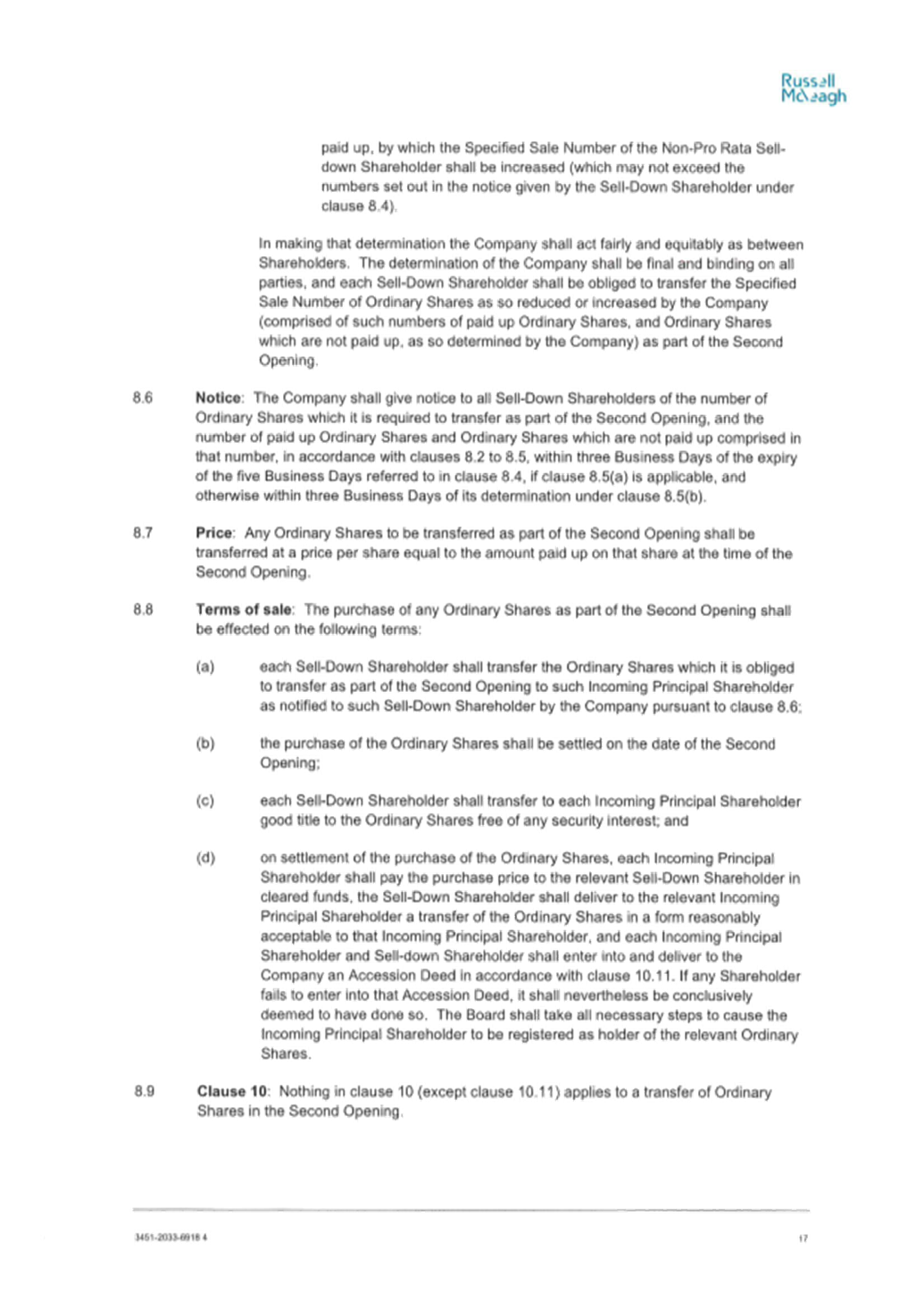
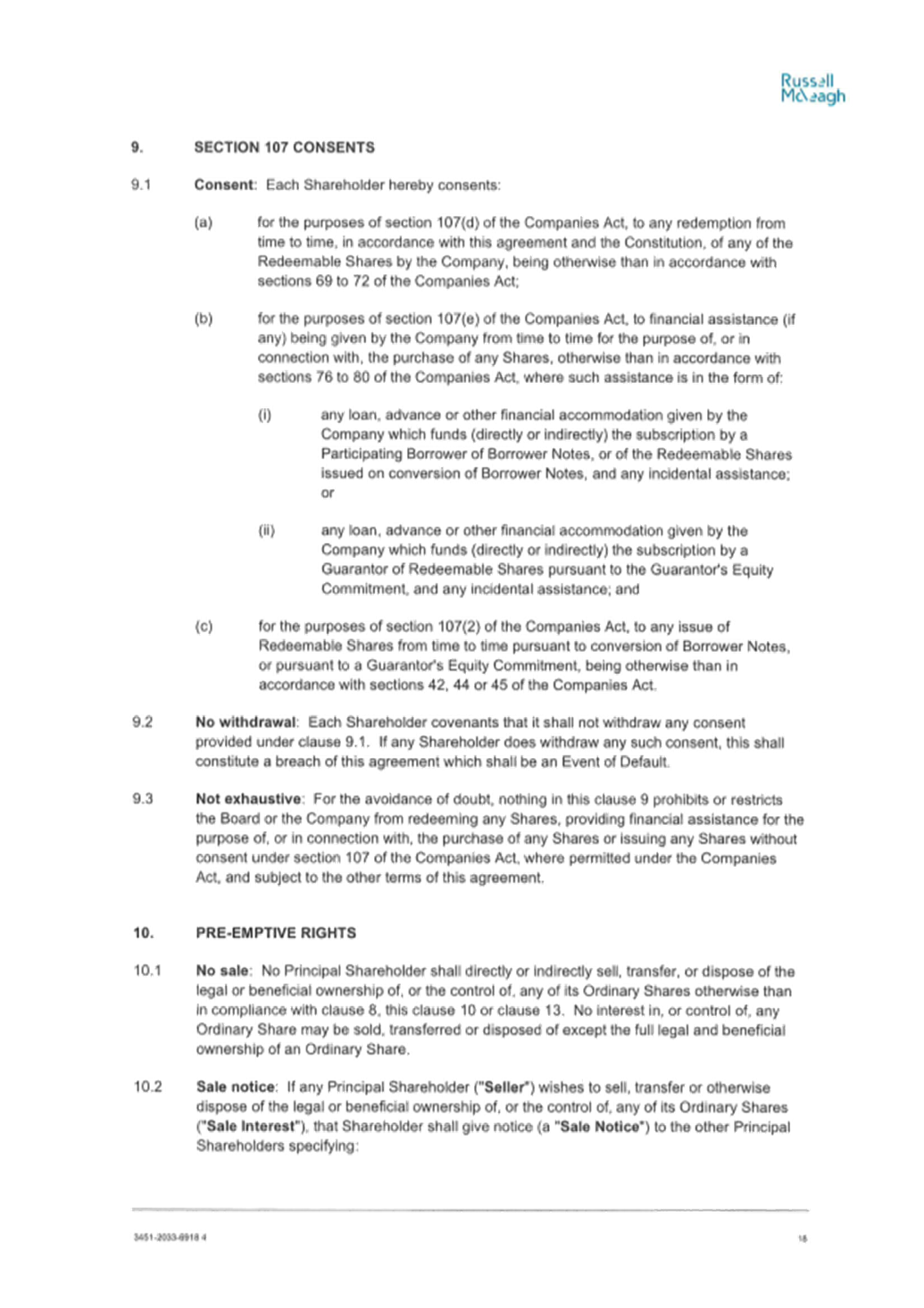
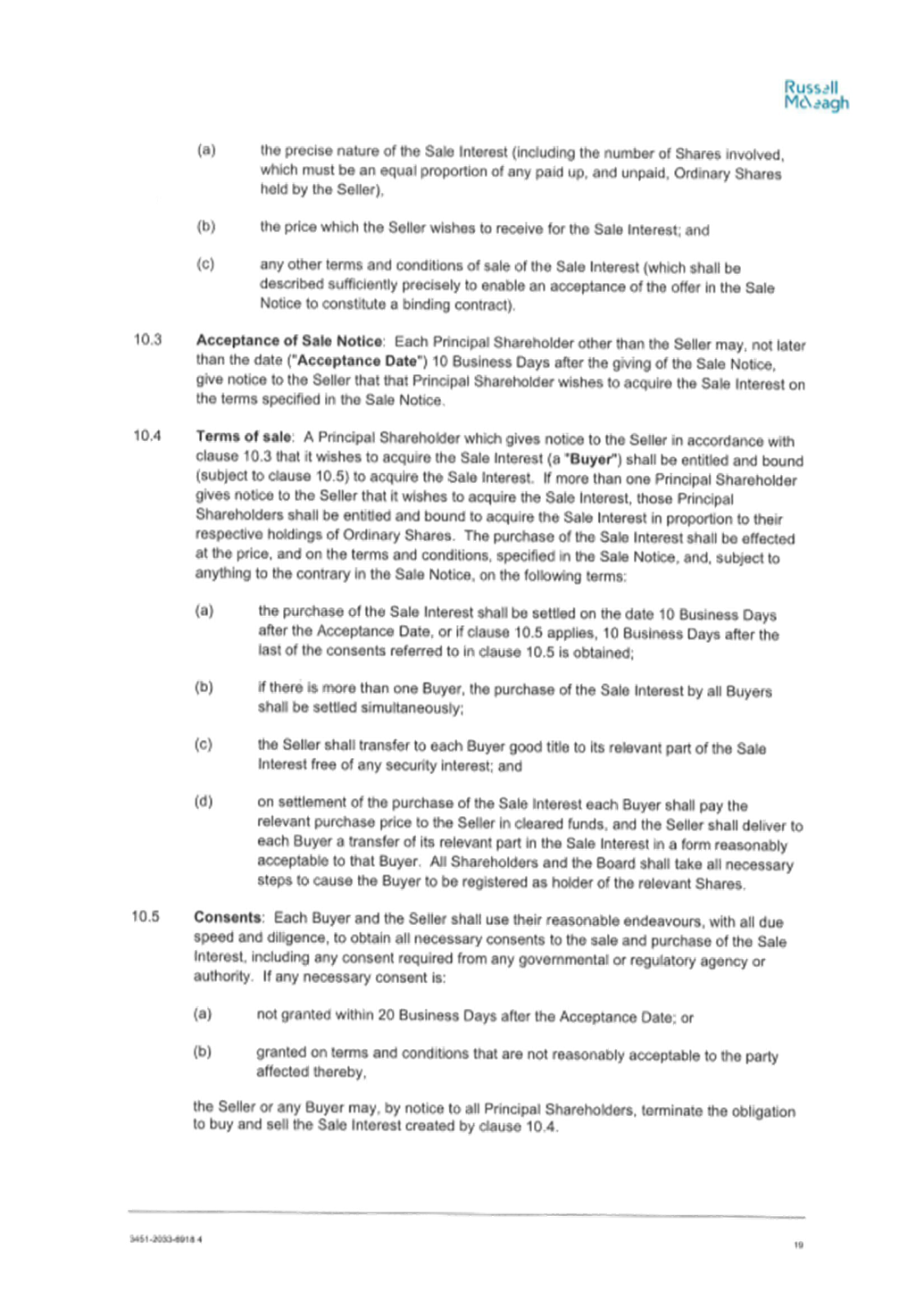
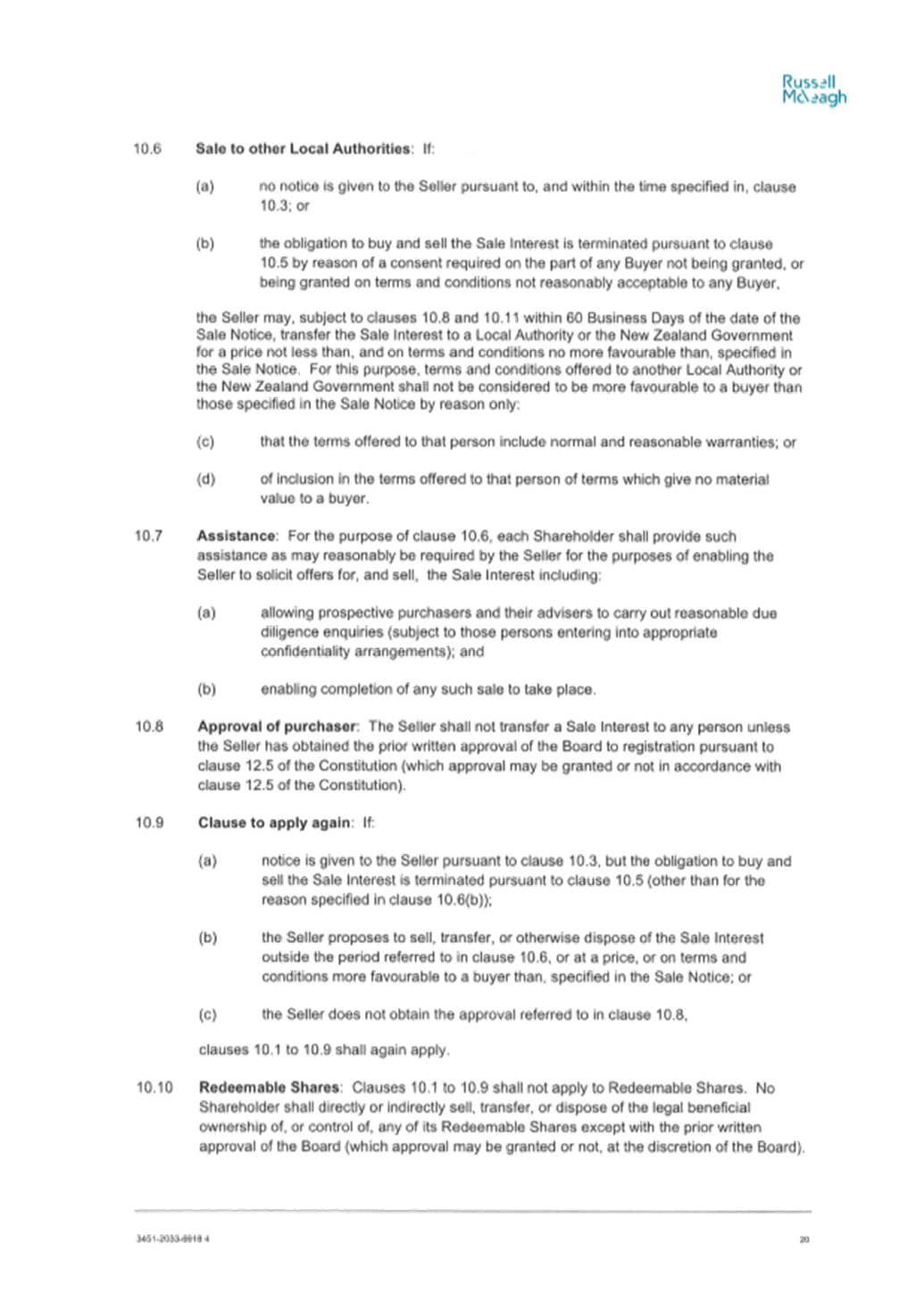

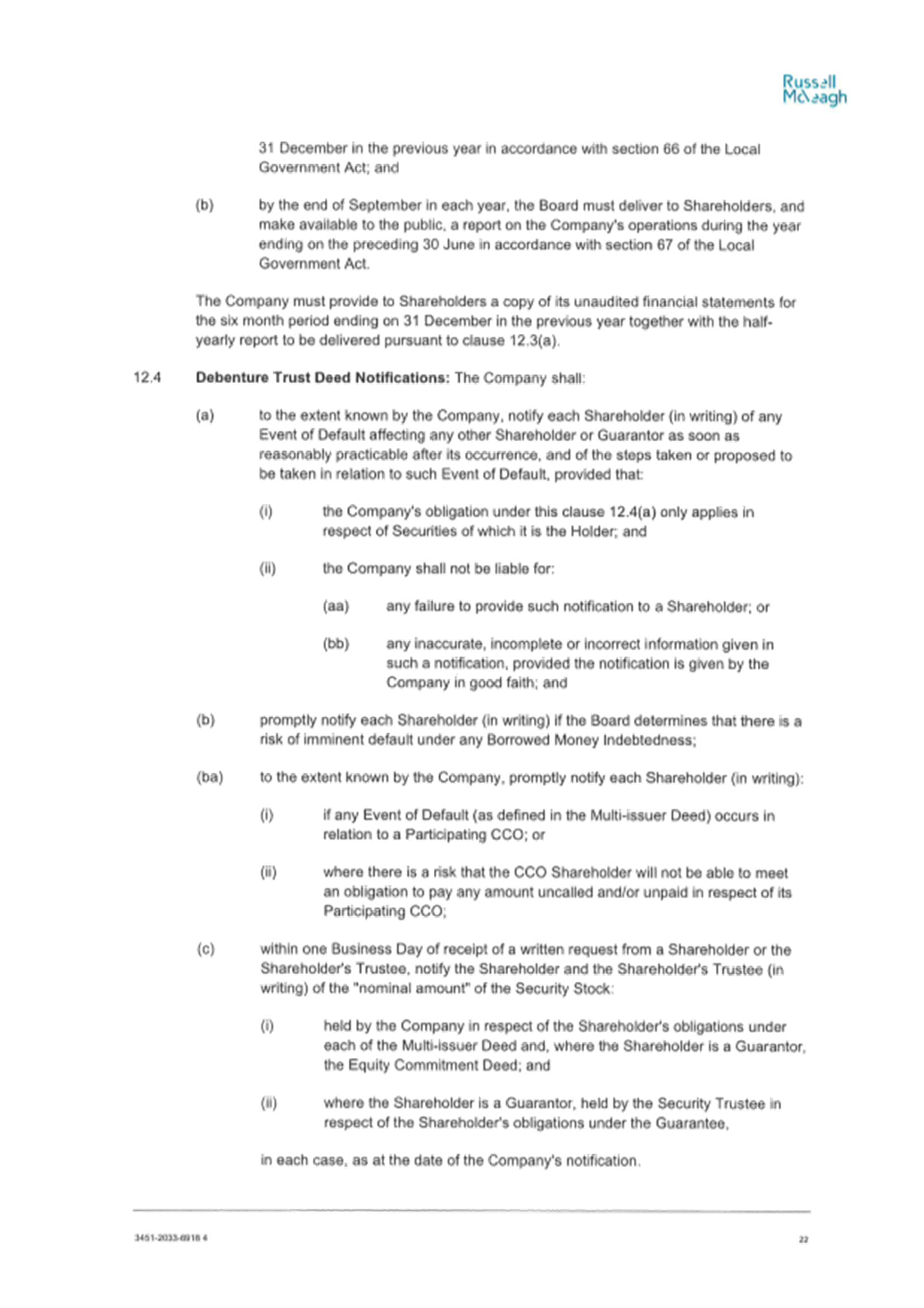
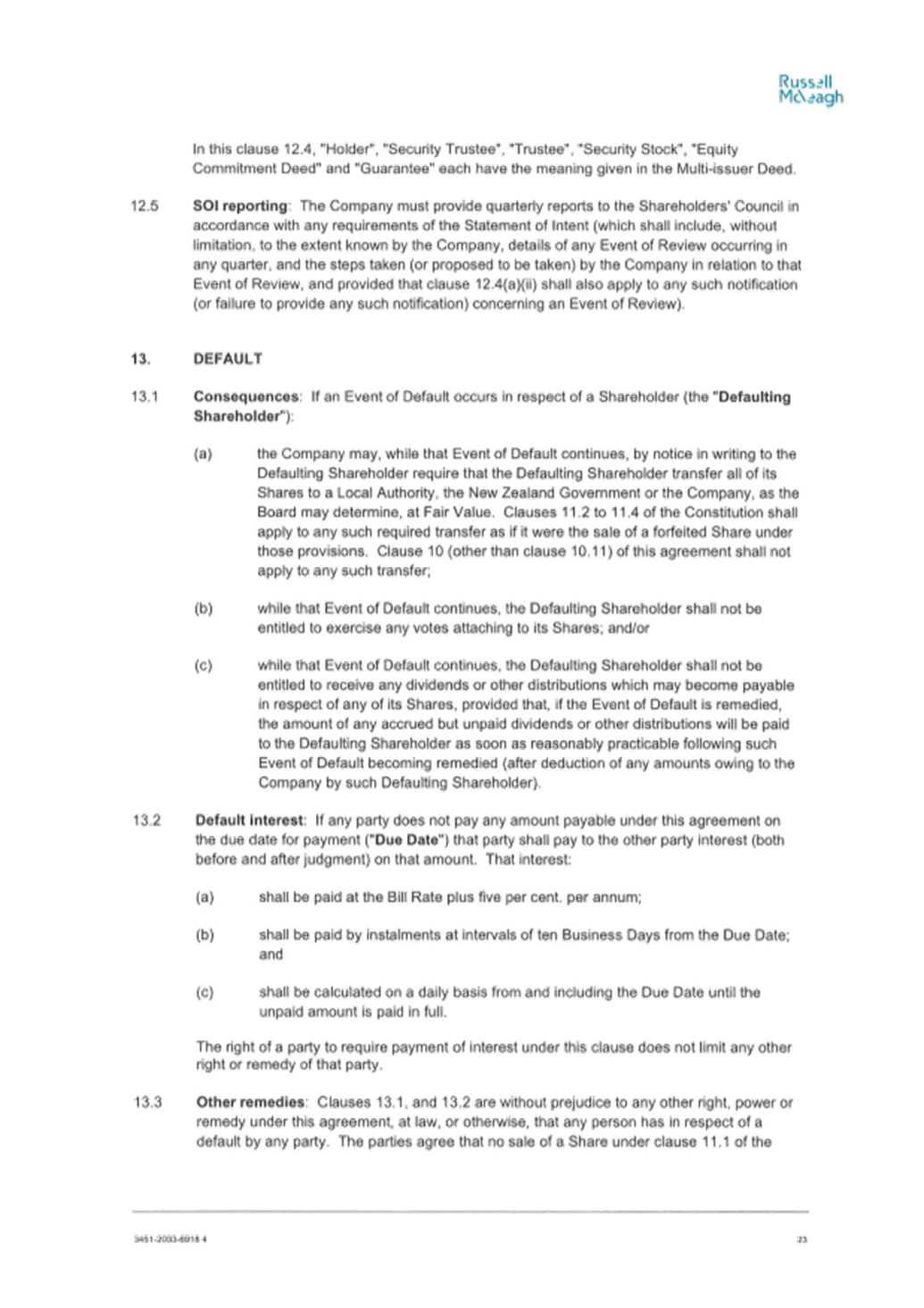
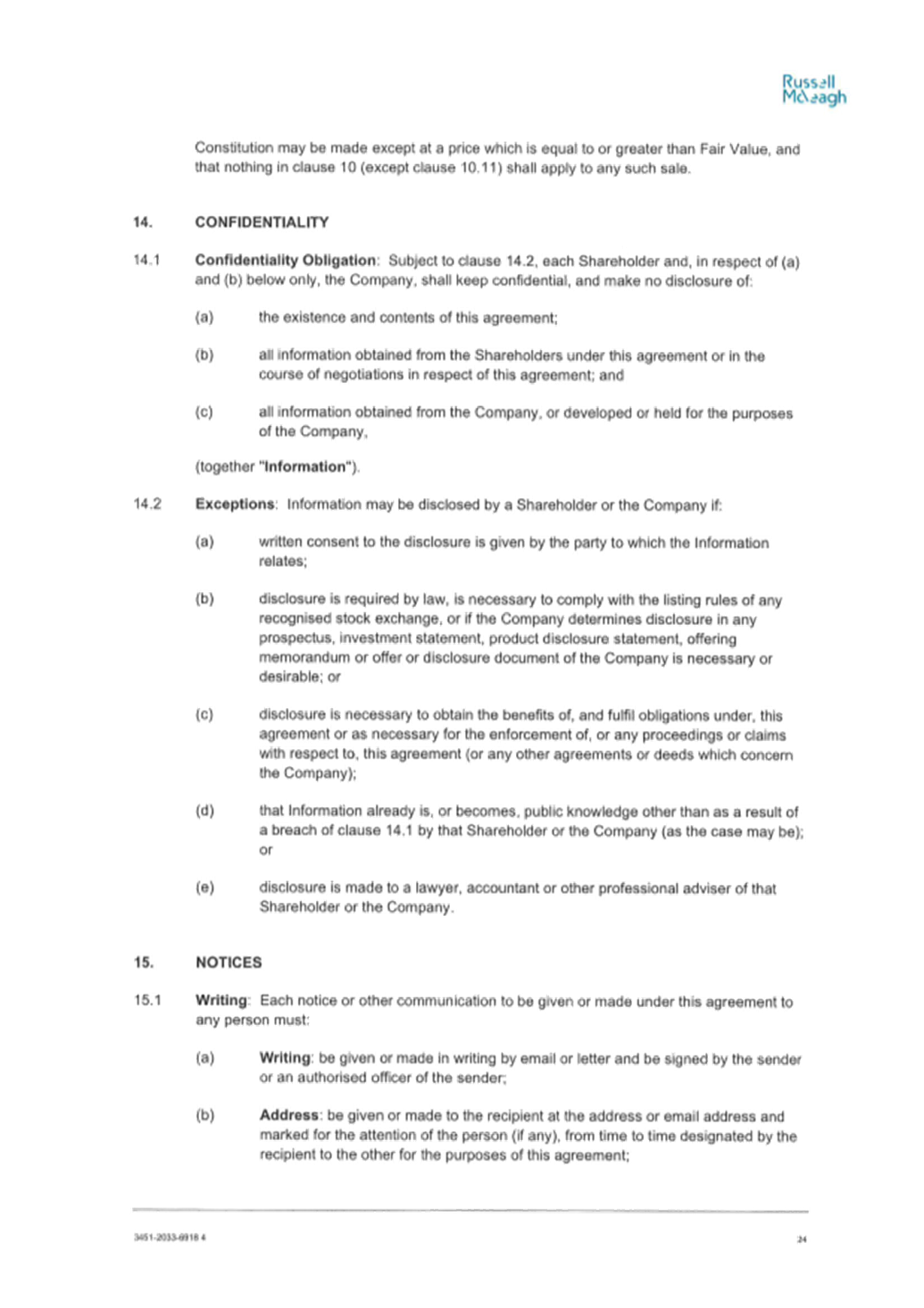
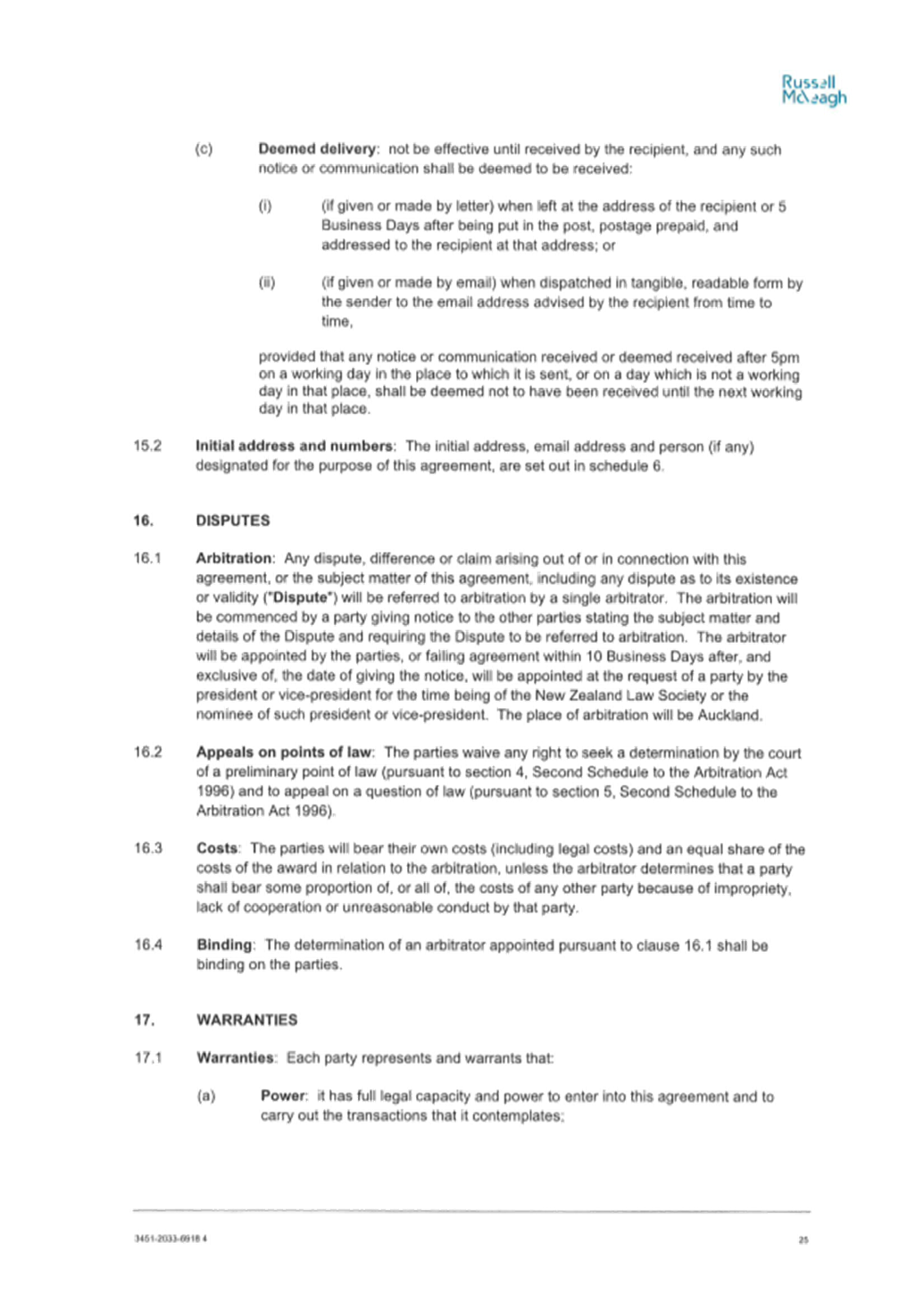

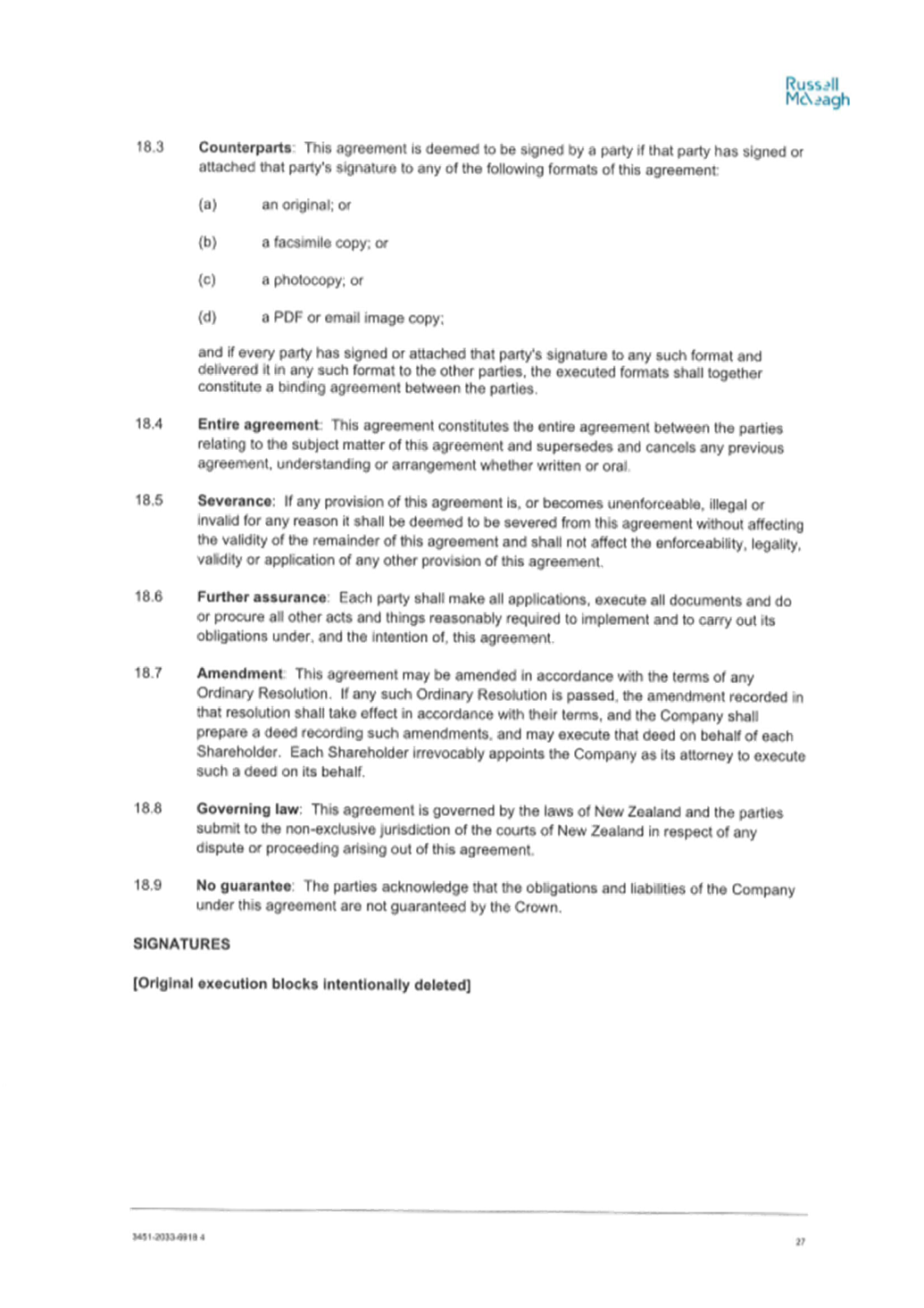
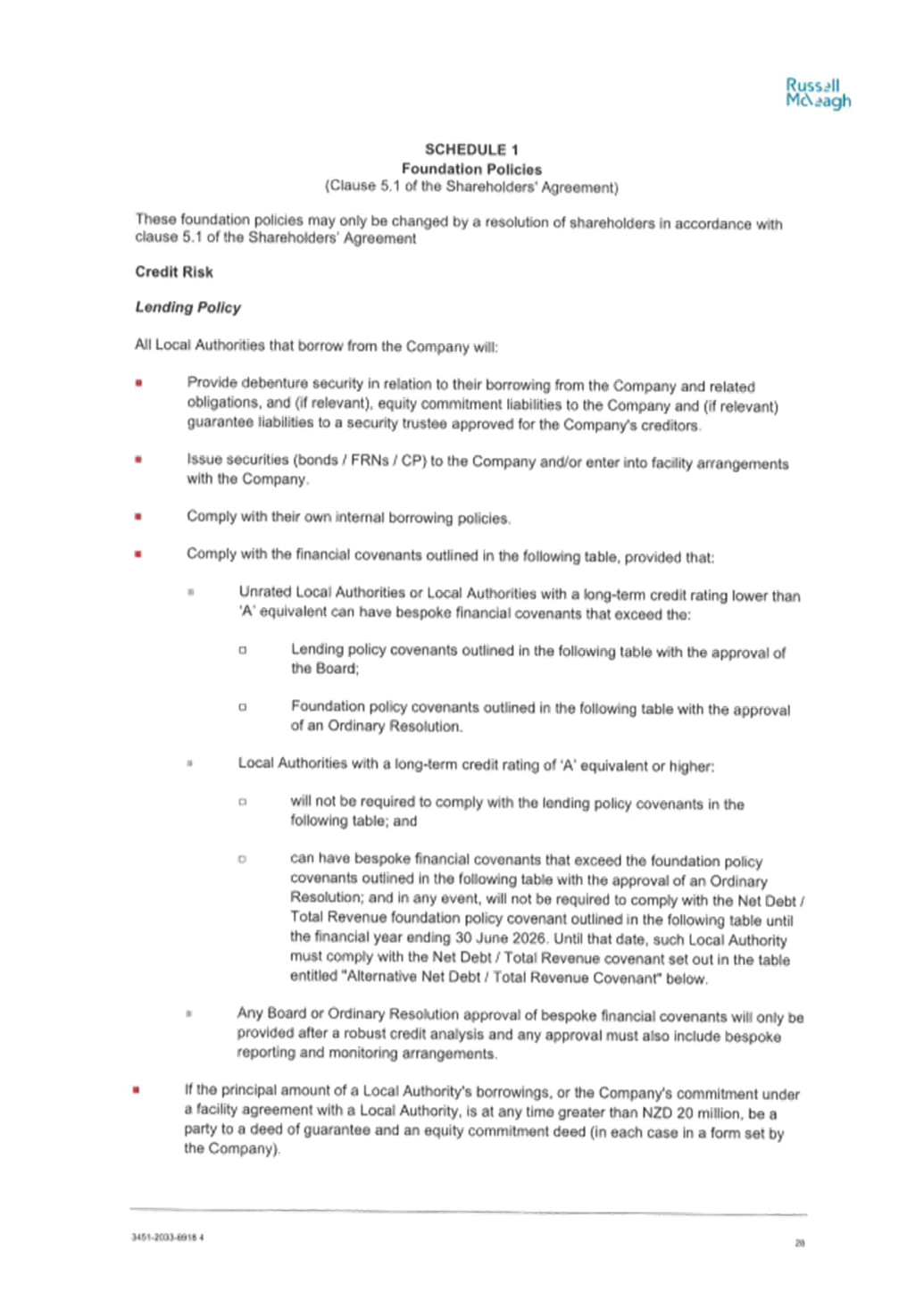
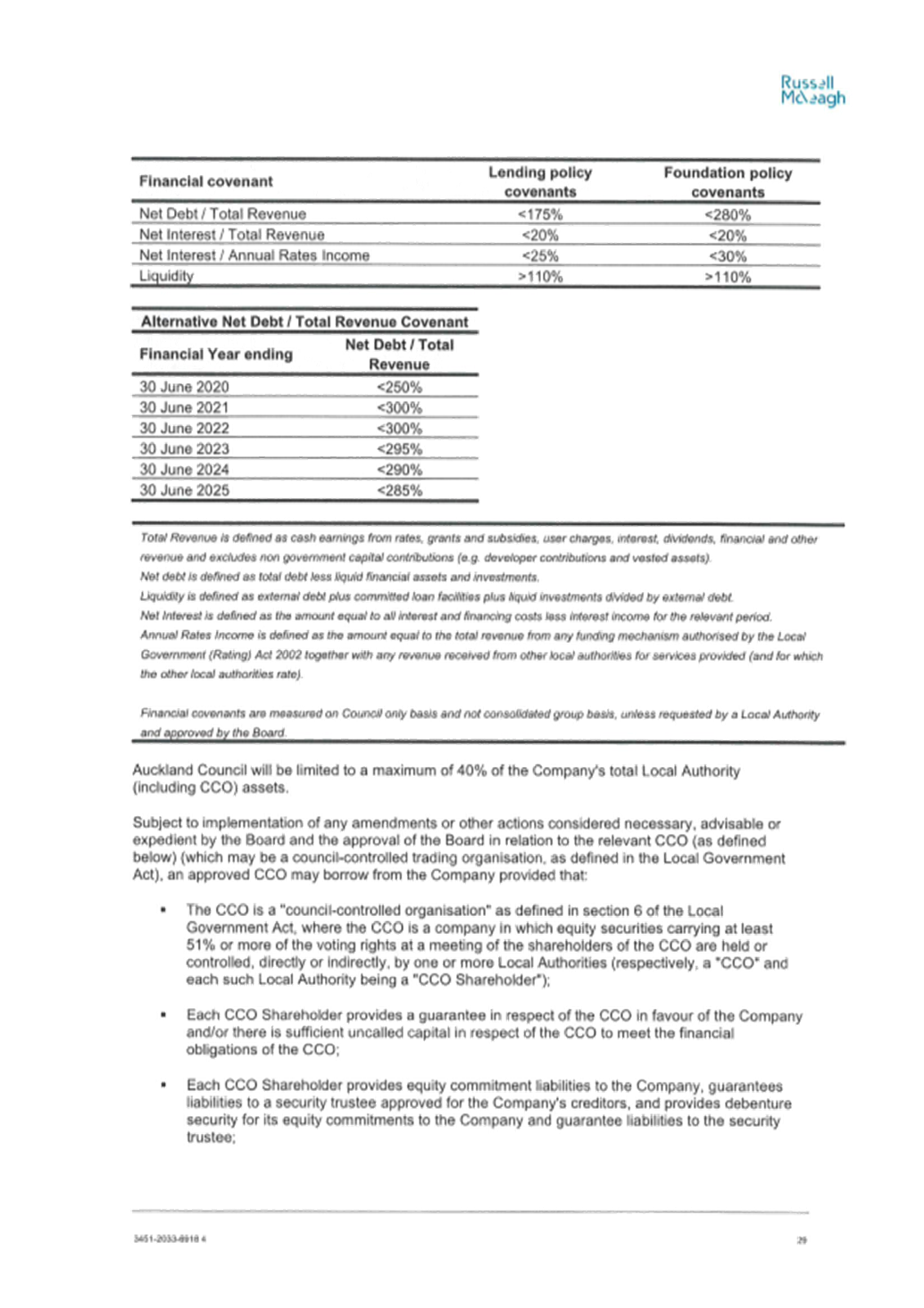
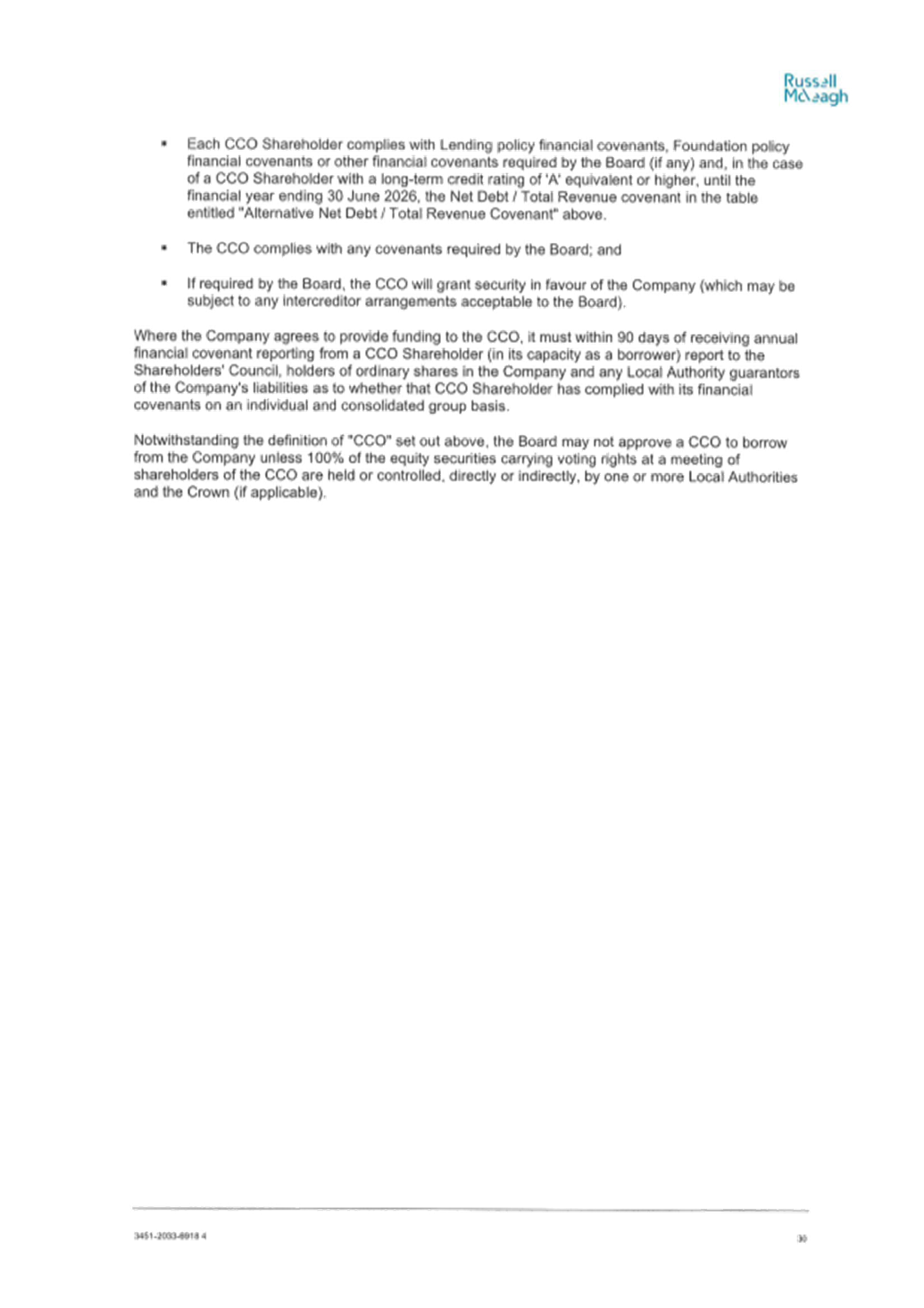
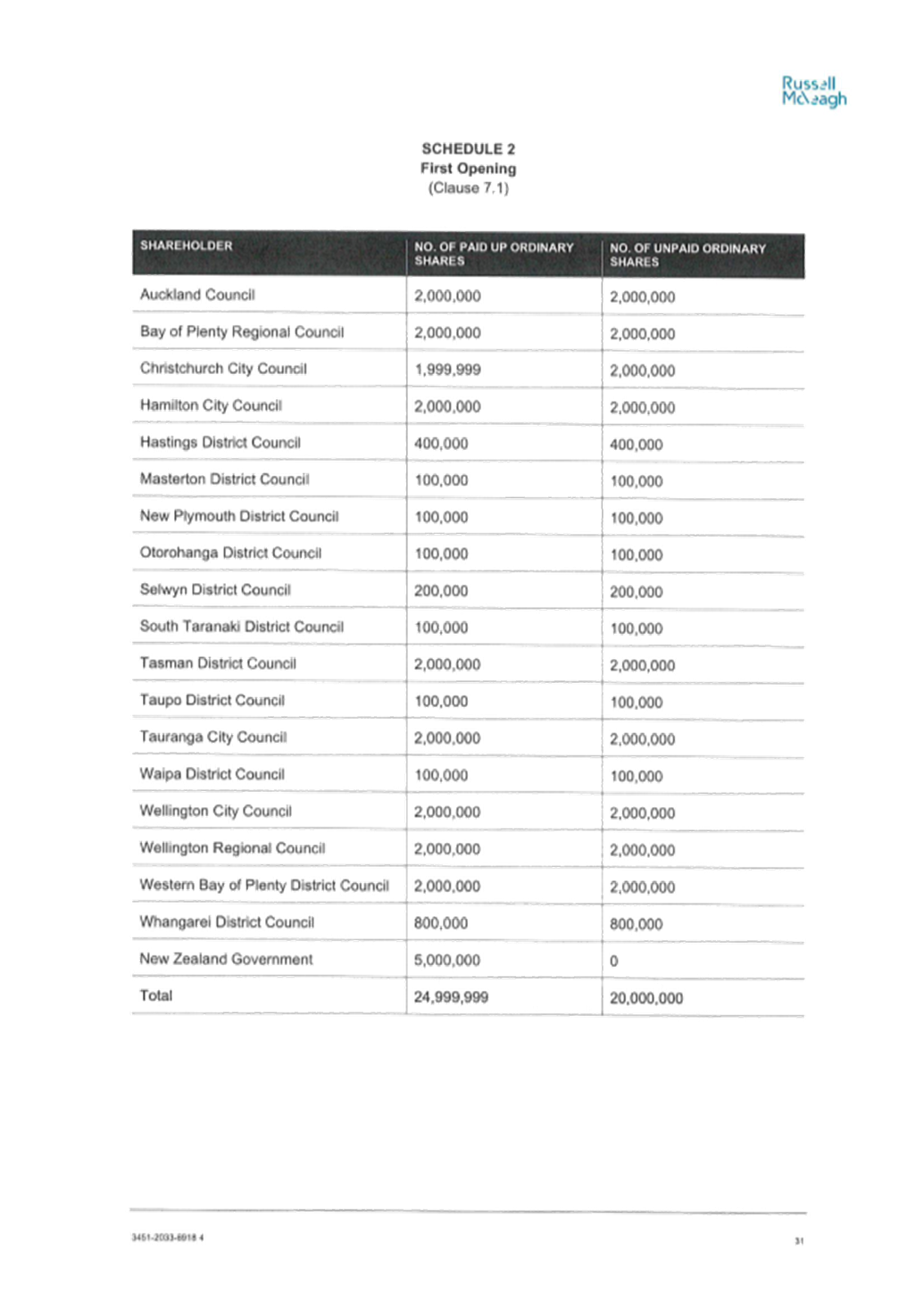
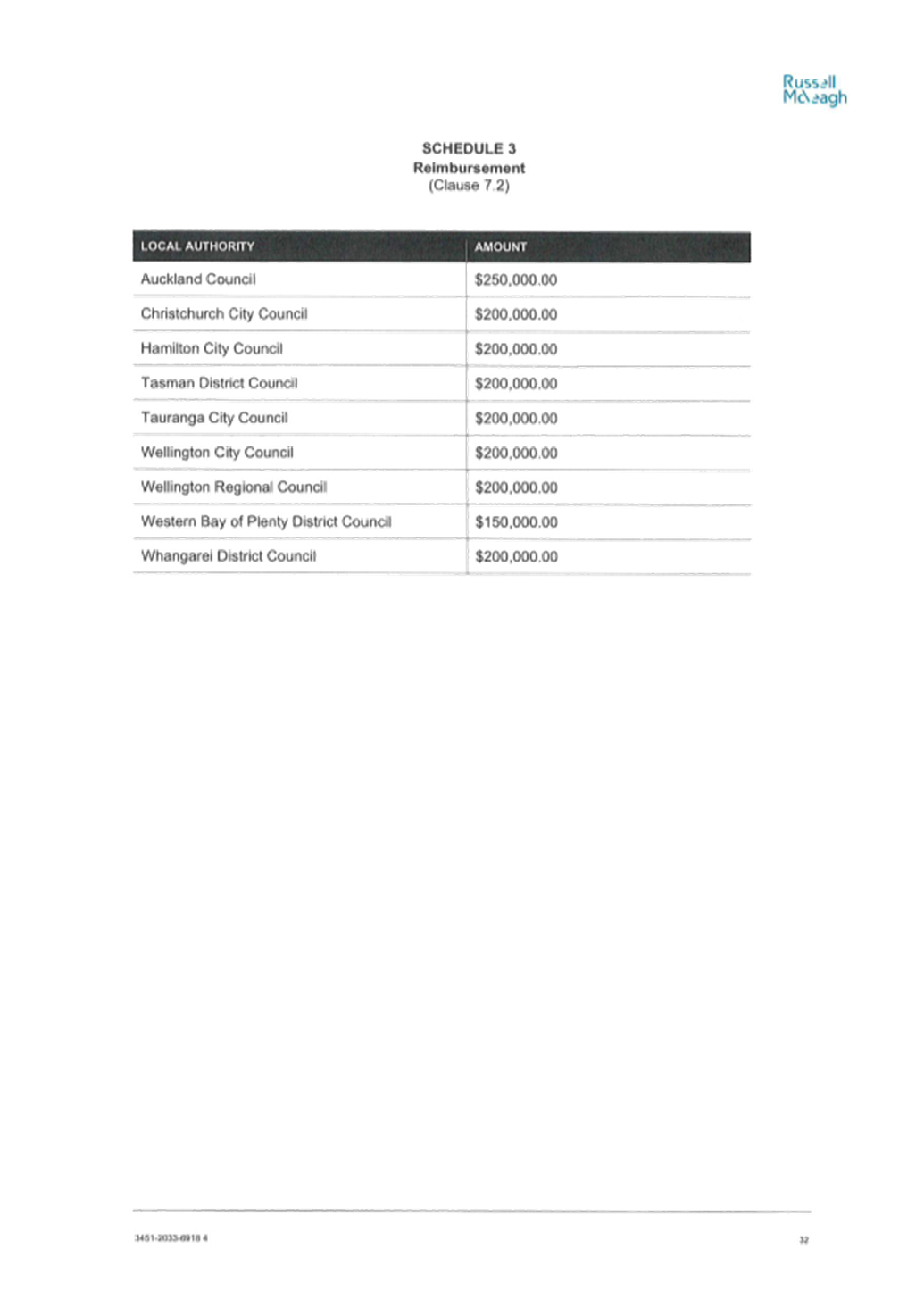
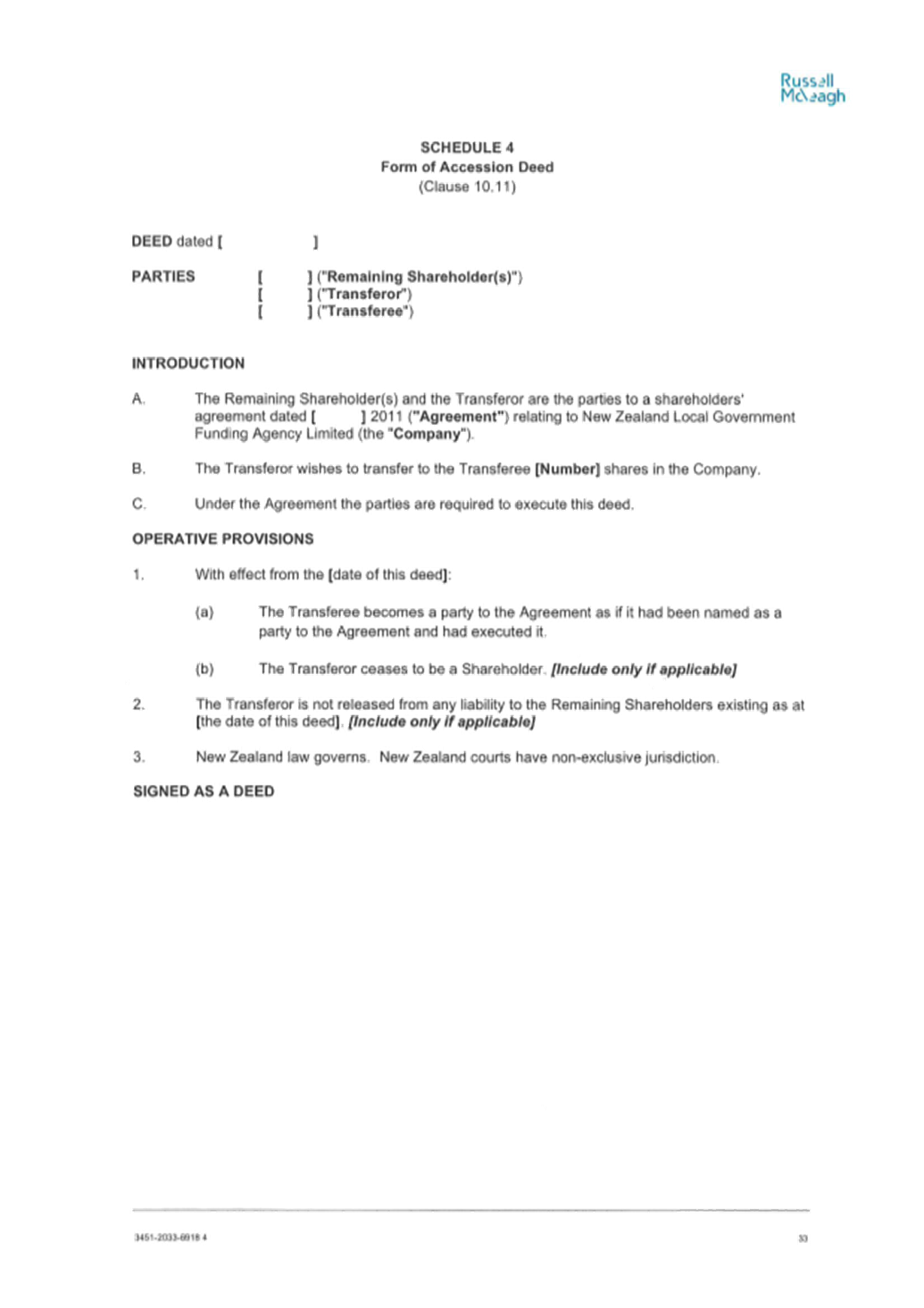
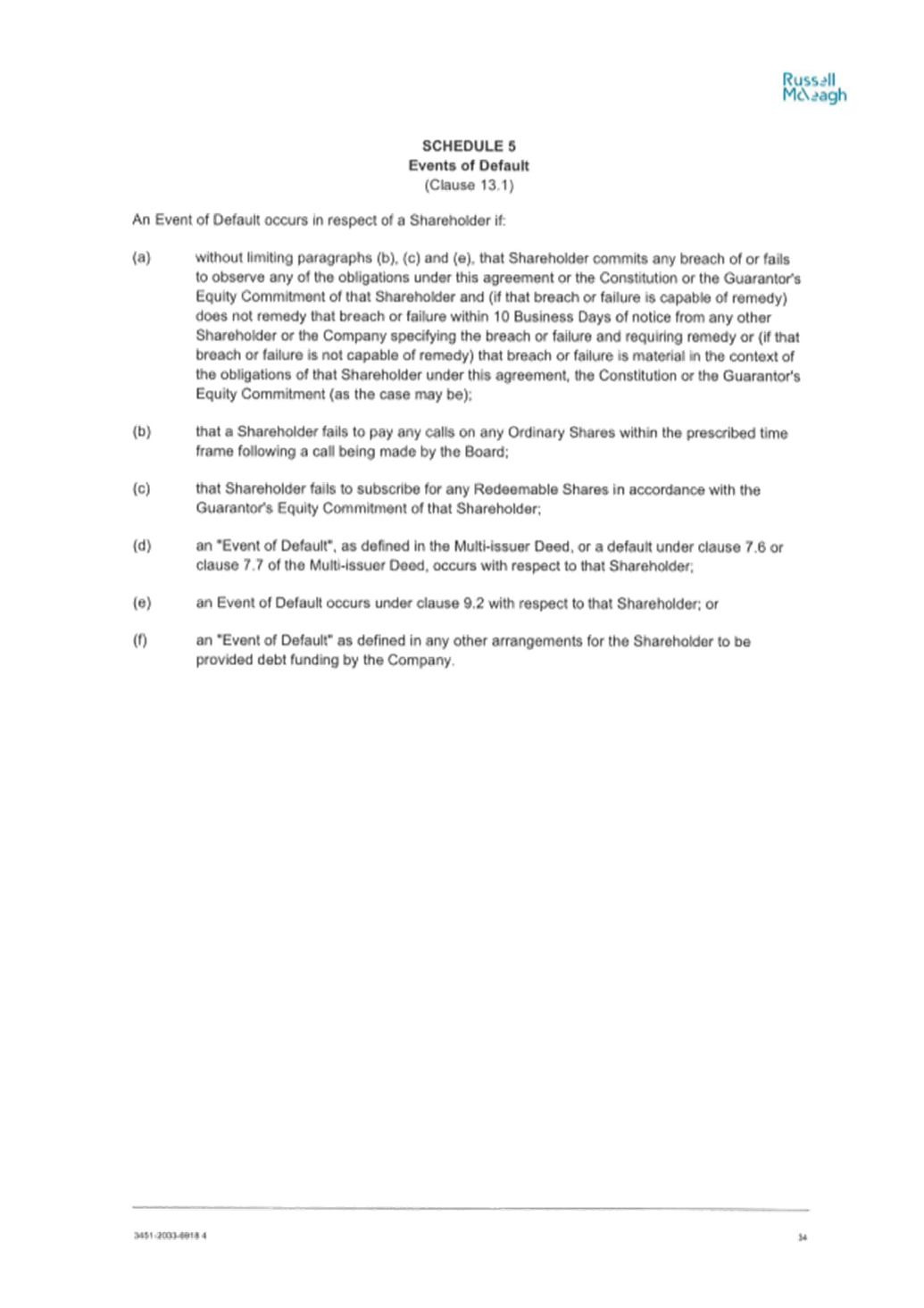
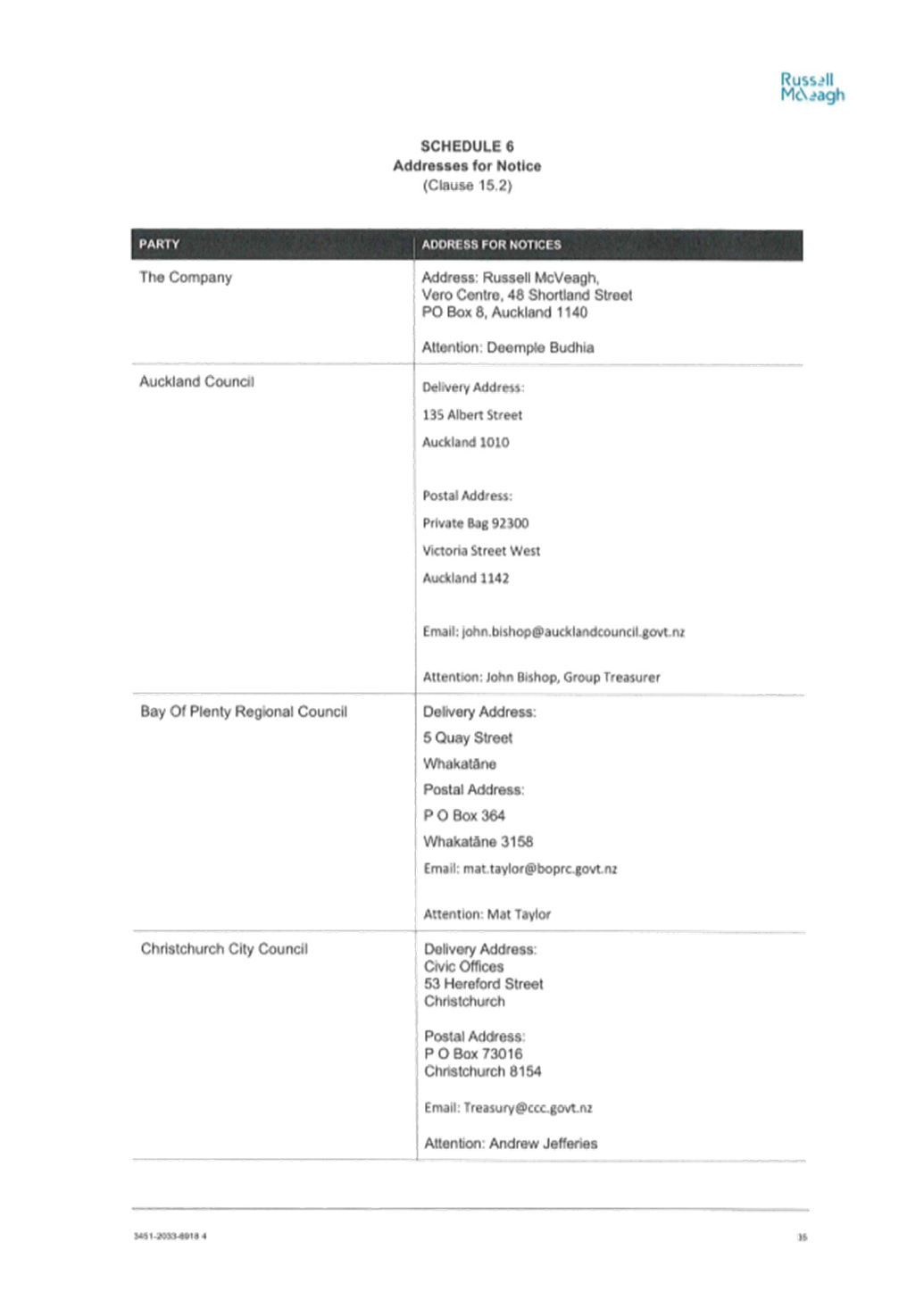
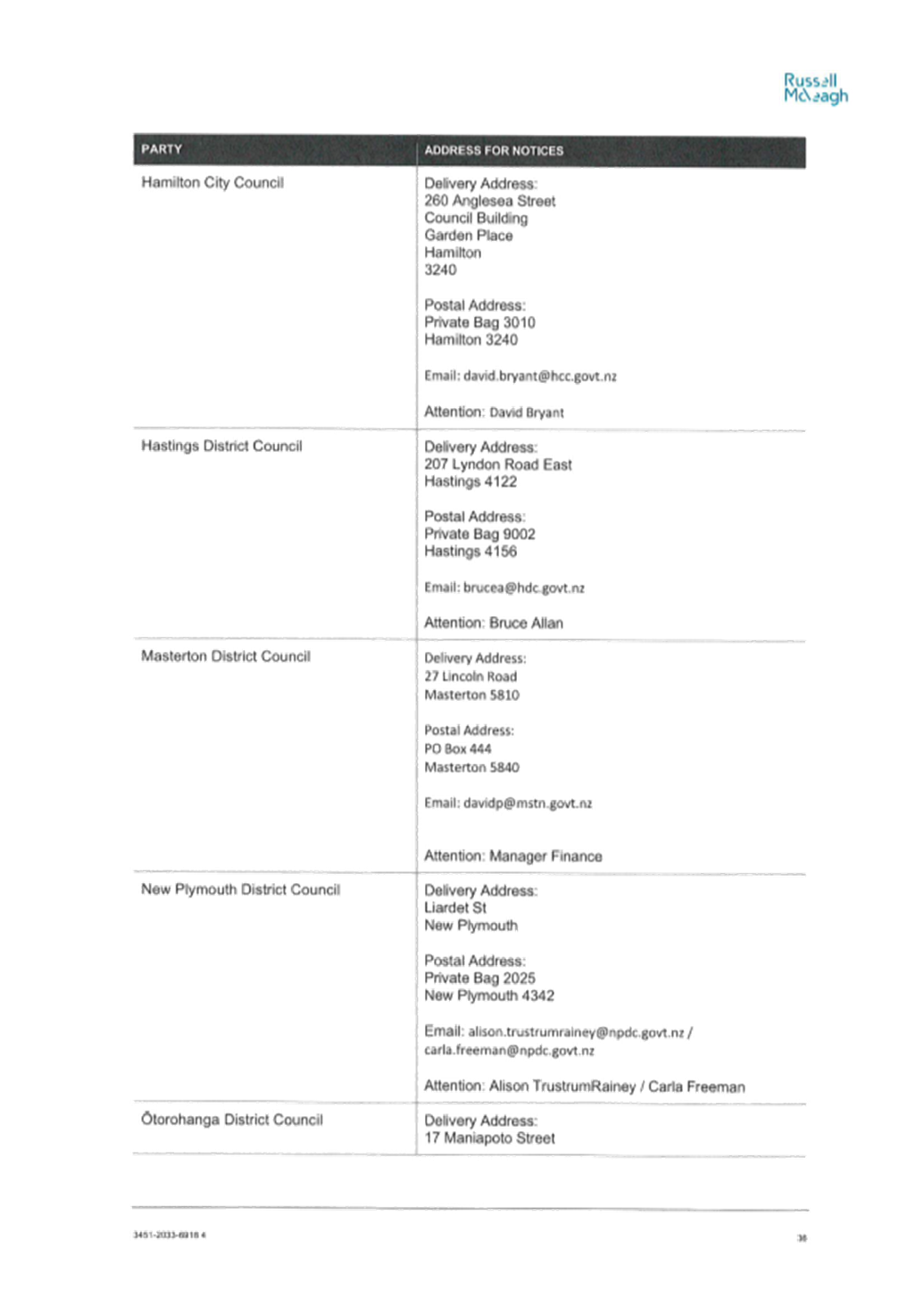
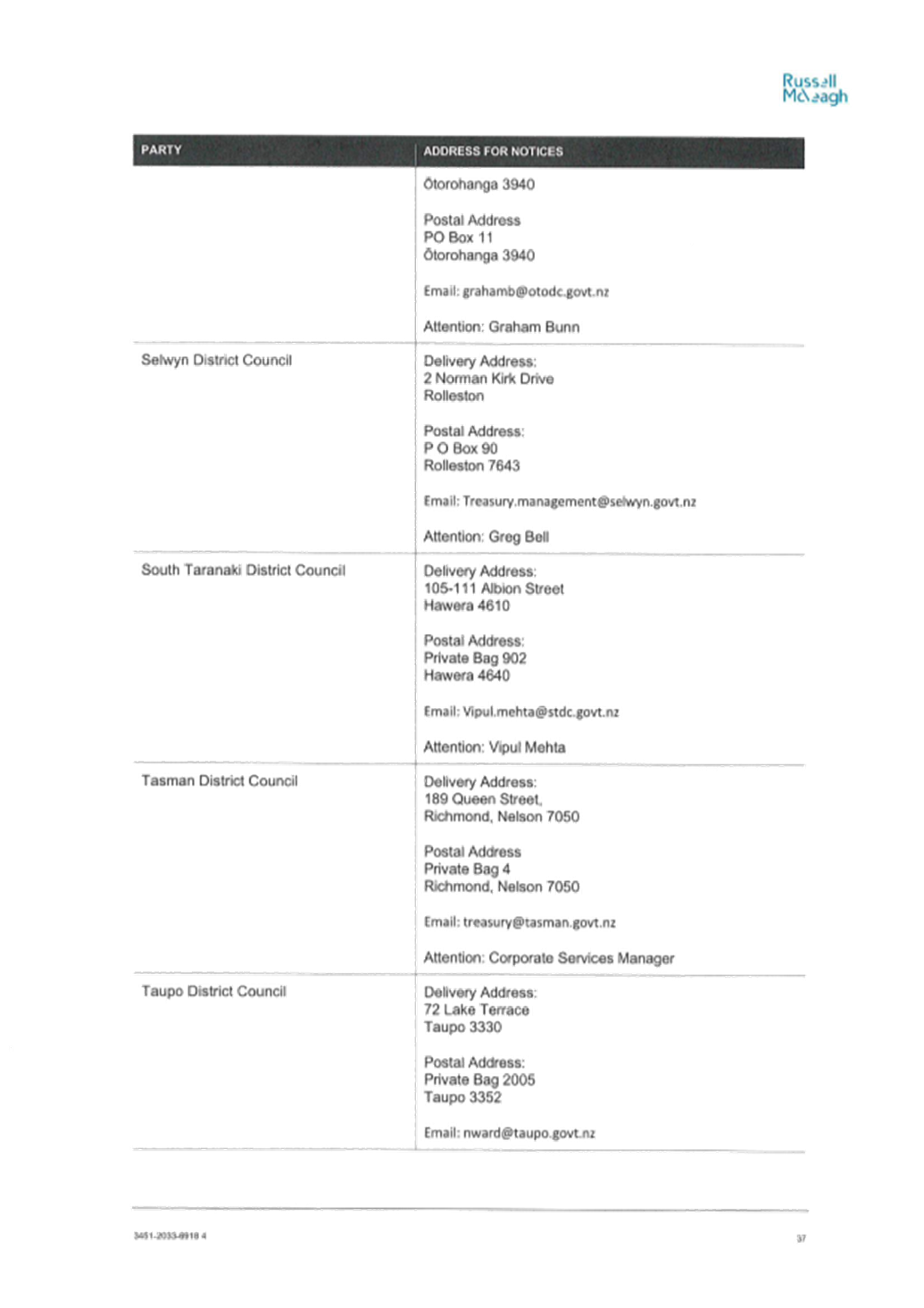
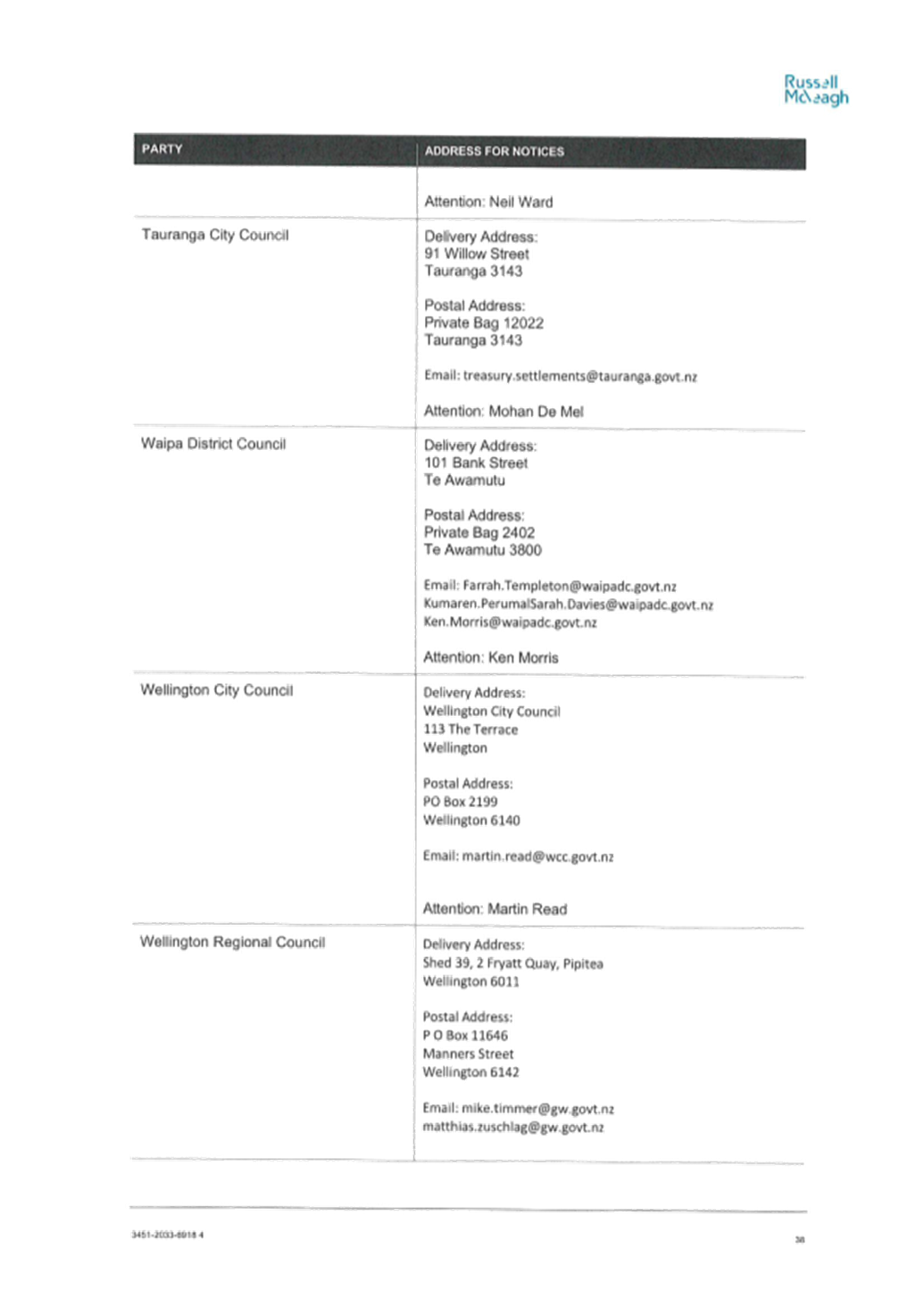
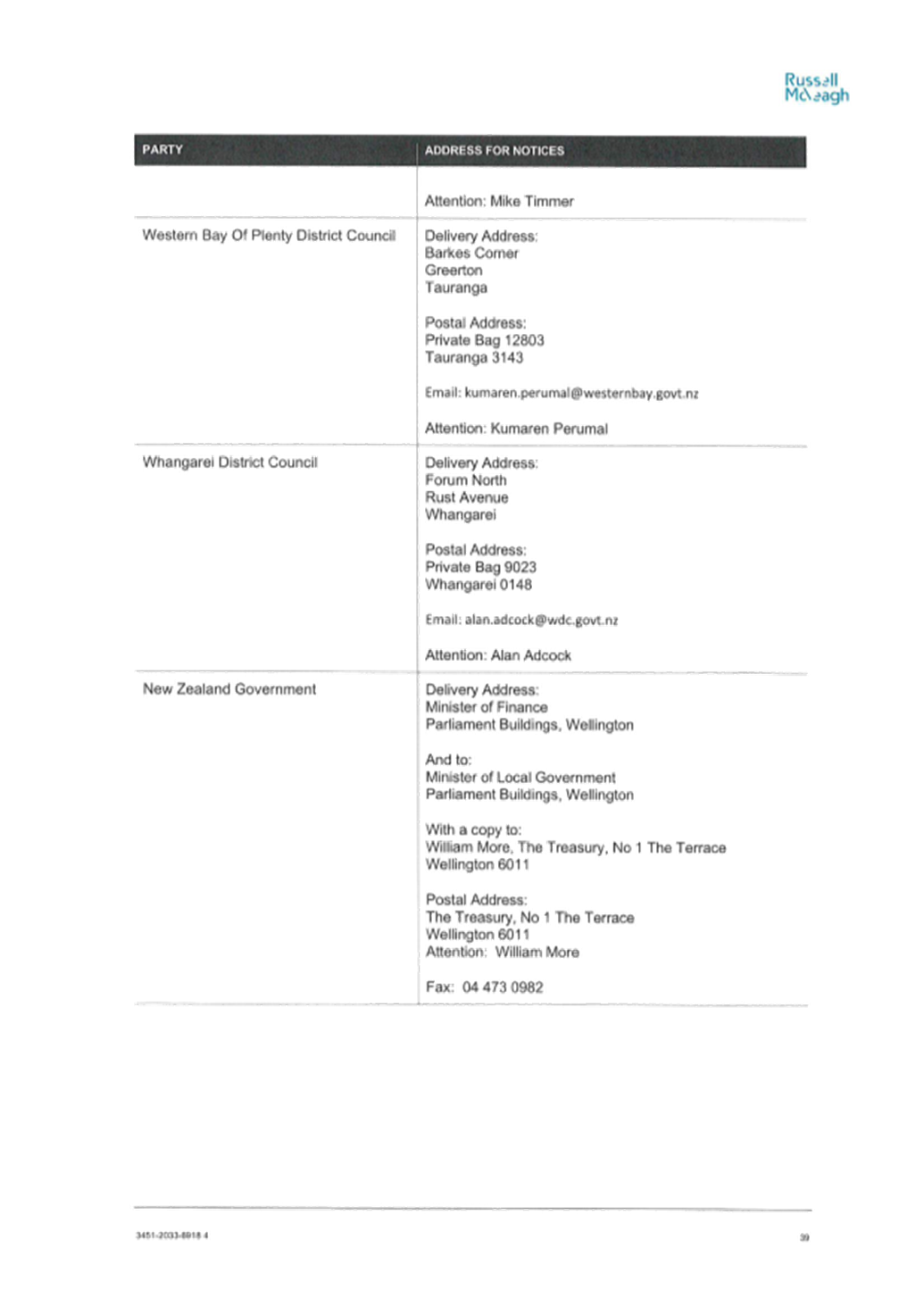
Tasman District Council Agenda – 08 May 2025
7.14 Chief Executive's Update
Information Only - No Decision
Required
|
Report
To:
|
Tasman
District Council
|
|
Meeting
Date:
|
8
May 2025
|
|
Report
Author:
|
Leonie
Rae, Chief Executive Officer
|
|
Report
Number:
|
RCN25-05-15
|
1. Summary
/ Te Tuhinga Whakarāpoto
1.1 The purpose of
this report is to provide an update on some key activity since the Chief
Executive’s last report on 27 March 2025.
2. Recommendation/s
/ Ngā Tūtohunga
That the Tasman District Council
1. receives the Chief Executive's Update report, RCN25-05-15;
3. Local
Government Commission – Representation Review
3.1 On 19 February
2025 the Local Government Commission (the Commission) held a hearing to
consider two appeals in relation to the Council’s proposed representation
arrangements following a review undertaken in 2024.
3.2 The decision of
the Commission was received on 24 March 2025. Overall, the Commission confirmed
the Council’s proposed representation arrangements however a minor
boundary change was made between the Moutere-Waimea and
Lakes-Murchison wards.
3.3 On 23 April 2025
one of the appellants has appealed to the High Court. The appeal is in relation
to the Commission’s decision making and it is required to respond.
Council’s legal team will monitor this appeal as it progresses.
LGOIMA Update
4.1 The monthly
numbers and Council’s proactive releases are published on the
Council’s website - LGOIMAs and information of public interest | Tasman District Council.
4.2 More than 80 LGOIMAs of public
interest have now been published on our website.
5. People & Wellbeing – Human
Resources Statistics
5.1 Included in this
report is a Human Resources Statistics Update (Attachment 1). This is in
response to a recent request from elected members to receive this information
more regularly.
5.2 The human
resources statistics for the quarter ending March 2025 show that we have 416
FTE and a headcount of 446. This is an increase from 408 FTE (headcount of 443)
as at December 2024. Turnover for the March quarter was 2.69% and the 12-month
rolling period is 6.76%. Again, it is good to be able to report that our
rolling turnover is continuing to show a decrease on previous years. The total
headcount increase is offset by several fixed term roles that have finished
during the March quarter.
5.3 In the latter part of last year,
we transitioned regulatory control services back in-house, resulting in an
increase in our FTE numbers. These services were previously managed through an
external contract, which was not renewed upon its expiration.
5.4 We are intentionally slowing down
recruitment for vacant roles, which aligns with the current lower turnover
rate.
6.1 The Annual Plan
process has been a large focus for the leadership team, several staff members
and for the elected members over the past 4-5 months.
6.2 I take this
opportunity to thank the elected members for their time and commitment working
through the Annual Plan process.
6.3 The Annual Plan
2025/2026 changes from the Long Term Plan was presented to the Council on 30
April 2025. The consultation document will go out to the community within the
next few days.
7.1 On 10 and 11
April 2025, I attended the Local Government New Zealand Zone 5&6 Conference
in Christchurch. This was a great opportunity to connect with Mayors and other Chief
Executives.
7.2 There were a
variety of guest speakers and presenters some of which included Phil Mauger
– Mayor of Christchurch City Council, Rt Hon Christopher Luxon, Justin
Watson – Chief Executive Officer of Christchurch International Airport,
Hon Simon Watts – Minister for Local Government and Brad Olsen –
Chief Executive and Principal Economist, Infometrics.
7.3 Several topics
were covered including updates from various organisations and also on focus
areas specifically relating to the government changes that are occurring.
8.1 On 23 April 2005, I attended the
Te Waka a Māui Iwi Chairs Forum along with Te Tauihu Mayors and Chairs.
The event was held at Waikawa Marae in Waikawa.
8.2 On 25 April 2025, I represented the Council and attended the ANZAC
remembrance event at Lake Rotoiti. This event was attended by a large
contingent of the local community and visitors to the area.
|
1.⇩
|
FTE
Quarterly Update
|
222
|
Tasman District
Council
Agenda – 08 May 2025
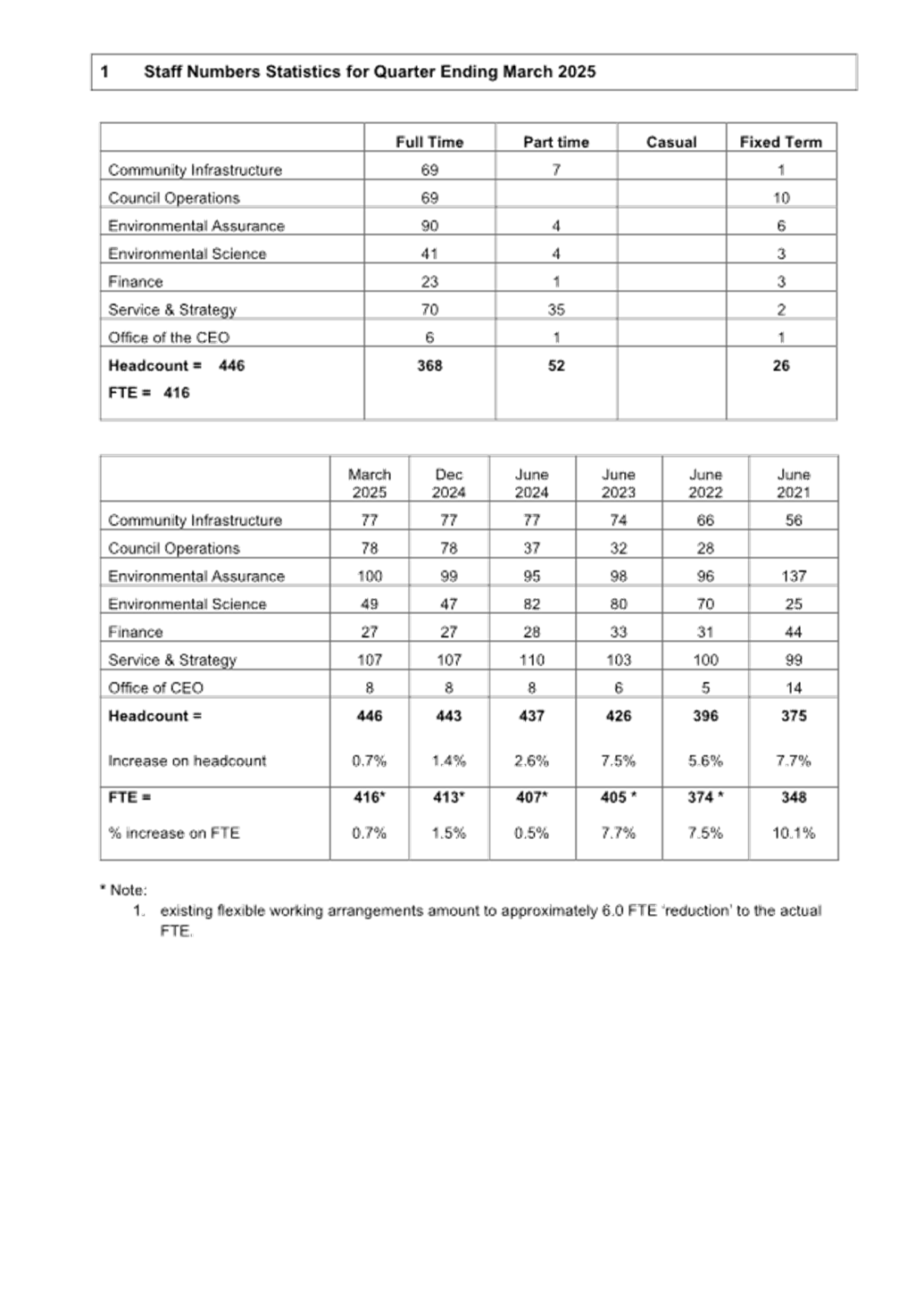

Tasman District Council Agenda – 08 May 2025
7.15 Mayoral Update Report
Information Only - No Decision
Required
|
Report
To:
|
Tasman
District Council
|
|
Meeting
Date:
|
8
May 2025
|
|
Report
Author:
|
Tim
King, Mayor
|
|
Report
Number:
|
RCN25-05-16
|
1. Summary
/ Te Tuhinga Whakarāpoto
1.1 Annual Plan
budgeting has been the focus for both elected members and Council staff during
this first quarter of 2025. Balancing the challenges of providing Council
services alongside rates increases has been challenging. I appreciate the huge
amount of mahi that has been provided by staff and our elected members.
1.2 Council staff
and elected members have continued to work on the Council’s preferred
option for the Local Water Done Well programme with public consultation now
open. There is still more work to be done before we can adopt the Water Service
Delivery Plan and submit it to Taumata Arowai by 3 September 2025.
1.3 Nelson City Council Mayor, Nick Smith
and I have had discussions with Ministry of Education staff recently regarding
the Ministry’s school bus services. For our District, the current service
provided for high school students in Māpua requires them to cross the busy
state highway to meet the bus. And yet, the same bus is parked overnight in the
Māpua Primary School grounds! A ridiculous situation that provides a
safety risk for the students.
A similar safety risk for school students in Hira, Nelson has been resolved.
1.4 Thank you to
those Councillors, our Chief Executive, Leonie Rae and Golden Bay Community
Board member, Robert Hewison for representing the Council at the ANZAC Day
events held throughout the District. It was great to see the increasing number
of younger people attending these services.
2. Recommendation/s
/ Ngā Tūtohunga
That the Tasman District Council
1. receives the Mayoral Update Report, RCN25-05-16.
3.1 On behalf of
Local Government New Zealand, I presented their submission on the proposed
Resource Management Act Bill to the Select Committee on 13 March 2025.
3.2 Our
second citizenship ceremony for 2025 was held on 19 March 2025 with another
forty-eight new citizens.
3.3 Ms
Rae and I had our regular catch up with Nelson-Tasman Regional Development
Agency Chair, Sarah-Jane Weir and Chief Executive, Fiona Wilson on 20 March
2025.
3.4 The
Motueka Grey Power AGM was held on 21 March 2025.
3.5 The
Council hosted a delegation from our Japanese friendly town, Fujimi Machi
during March. Fifteen students and 4 adults attended a pōwhiri at Te
Āwhina Marae on 21 March 2025. While they were here, the students attended
regular classes at Waimea College.

3.6 Mayor
Nick Smith and I met with the governance team at Nelson Hospital for an update
on the proposed hospital redevelopment on 25 March 2025.
3.7 Nelson-Tasman
Hospice Chief Executive, Tony Gray and I met on 26 March 2025.
3.8 The
new Richmond Football Club changing rooms were officially opened on 28 March
2025.
3.9 The
CDEM Group meeting was held on 2 April 2025.
3.10 The
quarterly catch-up meeting with Chamber of Commerce, Chief Executive, Ali
Boswijk was held on 3 April 2025.
3.11 A
multi-agency briefing was held on 3 April 2025 prior to the forecasted weather
event. While it is always good to be prepared for these events, I’m
pleased that although we had a lot of rain, there was very little damage.
3.12 The
Local Government reference group met on 4 April 2025.
3.13 The
Appleby Fire Brigade farewelled Ted and Clare Ford on 5 April 2025. Ted was a
long-standing member of the brigade.
3.14 The
first meeting of the new Kaiteriteri Recreation Reserve Board was held on 8
April 2025.
3.15 The
Joint Shareholders Committee met on 8 April 2025.
3.16 Leonie
Rae and I met with the group who are looking at a proposed development near
Motueka.
3.17 The
official opening of Trinder Engineering’s new complex off McShane Road
was held on 10 April 2022.
3.18 The
Local Government New Zealand Zone 5&6 conference was held in Christchurch
on 10 and 11 April 2025.
3.19 Our
third citizenship ceremony was held on 16 April 2025. We have increased the
number of ceremonies this year in an attempt to catch up with the backlog of
new citizens.
3.20 I
attended the ANZAC Day Services in Motueka, Riwaka and Ngātimoti.


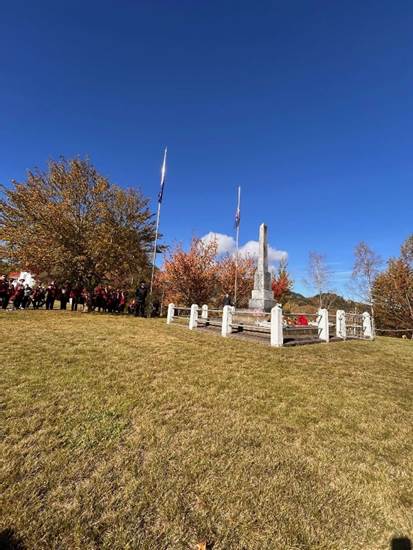
3.21 Mayor
Nick Smith, Leonie Rae and I met with the Trustees of the Tasman Bays Heritage
Trust on 29 April 2025.
3.22 Mayor
Nick Smith, Infrastructure Holdings Limited Chair, Sue Sheldon and I met on 29
April 2025 to recommend an appointment for the current vacancy on the Port
Nelson Limited Board following the resignation of former Chairperson, Paul
Zealand.
3.23 Rachel
Boyack and I met on 30 April 2025.
Nil
Tasman District
Council
Agenda – 08 May 2025
7.16 Annual Plan 2025/2026 Consultation Document Report
Decision Required
|
Report
To:
|
Tasman
District Council
|
|
Meeting
Date:
|
8
May 2025
|
|
Report
Author:
|
Chris
Choat, Communications & Change Manager
|
|
Report
Authorisers:
|
John
Ridd, Group Manager - Service and Strategy
|
|
Report
Number:
|
RCN25-05-17
|
1. Purpose
of the Report / Te Take mō te Pūrongo
1.1 The
purpose of this report is to adopt the Annual Plan 2025/2026 consultation
document.
1.2 The
report is in response to the Council’s decisions made at the 30 April
2025 meeting regarding the Annual Plan 2025/2026 with specific reference to the
Consultation Document
1.3 This
report also seeks the Council’s agreement to delegate the approval of
minor editorial changes to the Mayor and the Chief Executive.
1.4 It
is also seeking approval to manage public consultation regarding the proposed
limited paid parking initiative within the Richmond CBD as a separate
consultative process to run concurrently.
2. Summary
/ Te Tuhinga Whakarāpoto
2.1 There
are a range of pressures that are increasing the Councill’s costs for
2025/2026 compared with those in the LTP 2024-2034 as detailed at the Council
meeting on 30 April 2025 (RCN25-04-3).
2.2 These
costs were recognised as having a material impact on the required rate revenue
forecast in Year 2 of the 2024-2034 LTP. As a result, the Council is required
to consult with its community.
2.3 The
Council is a complex business with several avenues of expenditure and revenue
and a corresponding number of opportunities for efficiencies and/or savings to
be identified. The identification began in earnest from late last year when
cost increases and related expenditure issues became apparent.
2.4 This
process has been managed through several workshops with the Council with
interrelated solutions that support each other to reach the desired savings.
2.5 The
solutions identified within the related decisions do not stand alone from each
other and form an overall package of savings. Each of the solutions are not
significant on their own but come together to deliver a consolidated amount of
savings.
2.6 At
the 30 April 2025 meeting the Council agreed to produce a consultation document
supporting a shortened consultation period opening 12 May until 25 May 2025.
2.7 This
situation leads to a consultation process that does not enable line by line
examination of each efficiency or saving. This process has been managed by
elected members and staff since October 2024 and subsequently affirmed as a
total package at the 30 April 2025 Council meeting.
2.8 There
will be no submissions hearing for the Annual Plan consultation. The Council
will deliberate, after considering all submissions on 4 June 2025.
2.9 The
purpose of the consultation process is to identify and highlight the proposed
changes to operational programmes and budgets, to services and to the capital
programme. It is seeking submissions either in support of the changes to
deliver a rate revenue increase of 1.8% above the forecast level of 7% or to
provide solutions that enable further savings whilst maintaining the quality of
life in Tasman.
3. Recommendation/s
/ Ngā Tūtohunga
That the Tasman
District Council
1. receives
the Annual Plan 2025/2026 Consultation Document Report RCN25-05-17; and
2. adopts
the following supporting information for the Annual Plan 2025/2026 consultation
document as required by section 95A(4) of the Local Government Act 2002:
· prospective
financial information (financial accounts, funding impact statement, financial
regulations benchmarks and reserve funds (Attachment 1 to the agenda report);
· prospective
funding impact statement (rates) (Attachment 2 of the agenda report); and
3. agrees
that the consultation document in Attachment 3 to the agenda report provides a
fair representation of the changes from Year 2 of the Long Term Plan 2024-2034
and as proposed in the Annual Plan 2025/2026; and
4. adopts
the consultation document in Attachment 3 to the agenda report incorporating
any minor amendments at the meeting for release as the basis for community
consultation during the period 12 May to 25 May 2025 in accordance with
sections 82, 82A, 95 and 95A of the Local Government Act 2002; and
5. delegates
to the Mayor and the Chief Executive Officer approval of any minor edits to the
supporting information and consultation document prior to them being published
and made available for public consultation; and
6. approves
a concurrent consultation exercise on the introduction of limited paid parking
within the Richmond CBD.
4.1 The LTP 2024-2034 planned for a rates
revenue increase of 7% (excluding growth) and for net debt at $290 million for
Year 2 2025/2026.
4.2 The Council adopted an LTP 2024-2034
that contained a higher level of financial risk than in the past. This was done
to keep rates increases in the first three years (in particular) at a
manageable level for Tasman ratepayers at a time of general cost increases and
cost of living pressures.
4.3 Since the adoption of the LTP 2024-2034 there have been some
substantial upward cost pressures. Some of these are driven externally and are
largely outside the Council’s control.
4.4 Without intervention, the forecasted
rate revenue rise was 15%, a number deemed unacceptable. Since the impact of
the upwards cost pressures and the forecast increase in rate revenue became
apparent late last year, elected members and staff have worked to identify
solutions to manage and lessen the impact of the cost increases on ratepayers.
4.5 The last six months have seen a number of opportunities identified
across the organisation to provide a series of cost savings, not significant on
their own, but when meshed together enable significant savings.
4.6 The identified savings have enabled the Council to propose an 8.8%
rate revenue rise against the forecast 7% rise in the LTP 2024-2034.
4.7 As the solutions, if viewed in
isolation, do not make a significant impact it is difficult to consult on each
and every one as such it is proposed to consult on the approach and the total
package.
4.8 As
part of the Annual Plan consultation, it is proposed to seek community feedback
on paid all day parking within the Richmond CBD. This initiative will help to
reduce the impact of rates increases and was identified within the 2016 Parking
Strategy. The consultation enables public feedback on the details of this
initiative such as the specific car parks, days and level of parking
charges.
4.9 The paid parking would be limited to a
cost on 68 all day parking spaces within three areas in the outer ring of
parking available in existing areas adjacent to Queen Street. It is proposed to
introduce a system of the first hour free with a maximum cost of $4 a day for
all day parking.
4.10 The Council is required to adopt the
information that it relied upon in developing the content of the consultation
document, before adopting the consultation document. The following documents
are attached for adoption:
· prospective financial information (financial accounts, funding
impact statement, financial regulations benchmarks and reserve funds (Attachment
1); and
· prospective funding impact statement (rates) (Attachment 2).
5.1 The options are outlined in the
following table:
|
Option
|
Advantage
|
Disadvantage
|
|
1.
|
Adopt the draft Consultation Document
(Attachment 3) for release
|
Enables the consultation process to
proceed albeit within a compressed timeframe.
|
There is no disadvantage.
|
|
2.
|
Not accept the draft Consultation
Document for publication
|
No advantage.
|
May compromise Annual Plan timeline,
risking striking the rates by 1 July 2025. This would have a very significant
impact on the Council’s Finances for 2025/2026 as our system would
require expensive and difficult changes to enable retrospective application
of rates increases. This process would likely impact the Council’s
reputation.
|
5.2 Option 1 is recommended. The
Council has undertaken a thorough business review process to get to
today’s decisions, and we have no scope in our timeline to make further
significant changes. Further changes are also likely to more seriously impact
levels of service and/or core Council functions.
6.1 Under section 95 of the LGA the Council
must prepare an Annual Plan for each financial year and consult in a way that
meets the requirements of section 82 before adopting the Annual Plan.
6.2 Section 95A(5) of the LGA states that a
difference, variation or departure is material if it could, itself or in
conjunction with other differences, influence the decisions or assessments of
those reading or responding to the consultation document.
6.3 Section 82 (1) contains several
principles for consultation that the Council is required to meet summarised
below:
6.3.1 Interested or affected persons
should be provided with reasonable access to relevant information in a form
that is appropriate for their preferences.
6.3.2 Interested or affected persons
should be encouraged to present their views.
6.3.3 Interested or affected persons
should be given clear information about the purpose of the consultation and
scope of decisions.
6.3.4 Persons invited or encouraged to
present their views should be given a reasonable opportunity to do so in a
manner and format that meets their preferences and needs.
6.3.5 The views presented should be
received by the Council with an open mind and should be given due
consideration.
6.4 Section
82(3) provides discretion to the Council about how it observes these
principles.
6.5 In this case several of the proposed
changes will have an impact on services but don’t affect levels of
service that are formally stated in the LTP 2024-2034. At least some of
these will be in significant activities but staff do not consider them to be
significant changes and therefore do not trigger the need to amend the
LTP.
7. Iwi
Engagement / Whakawhitiwhiti ā-Hapori Māori
7.1 Staff will approach Iwi directly
to discuss the changes in the Annual Plan and will provide any feedback they
have to Council at its deliberations meeting.
8. Significance
and Engagement / Hiranga me te Whakawhitiwhiti ā-Hapori Whānui
8.1 At the Council meeting on 30 April 2025
the significance and engagement of the proposed Annual Plan was considered.
8.2 It was agreed because of the extended
time period required to carry out the business review and discuss cost
reduction/revenue increasing activities to achieve an 8.8% rates revenue
increase, the time available for consultation is compressed.
8.3 It was also agreed that compressed
consultation is worth doing to gain some feedback from the community to inform
elected members’ decision making and to help reduce the legal risks.
8.4 To
meet the principles in section 82 in the LGA in the compressed timeframe, staff
recommend publishing a consultation document online and in hardcopy versions.
Hardcopy versions will be made available in Council’s offices and
libraries. A Shape Tasman page will be developed where people can access the
consultation document and other related information.
8.5 Staff
recommend that the Council carries out an online consultation session at which
the context and key changes can be explained and verbal feedback from attendees
received. Given the limited time available staff do not recommend
undertaking a formal hearing.
8.6 The Annual Plan consultation will be
publicised in Newsline, newspaper advertising and through social media.
8.7 Targeted consultation will be undertaken
with Nelson City Council and the industrial water users affected by the charge
for water in Nelson Industrial Water Supply Area.
|
|
Issue
|
Level of
Significance
|
Explanation of
Assessment
|
|
1.
|
Is there a high level
of public interest, or is decision likely to be controversial?
|
High
|
There are multiple
changes proposed in the Annual Plan and the number of different topics means
that one or more of them will be of higher public interest to a reasonable
proportion of the community. The rates revenue increase level is also
likely to be of high public interest.
|
|
2.
|
Are there impacts on
the social, economic, environmental or cultural aspects of well-being of the
community in the present or future?
|
Medium
|
There are multiple
changes proposed in the Annual Plan that could have a range of wellbeing
impacts. In general, the scale of the changes are not considered likely
to have a high impact on well-being.
|
|
3.
|
Is there a
significant impact arising from duration of the effects from the decision?
|
Medium
|
For most of the
changes proposed in the Annual Plan the Council could choose to reverse them
at any point. There are a minority of changes that once implemented,
reversing them would be very difficult e.g. selling property or ETS credits.
|
|
4.
|
Does the decision
relate to a strategic asset? (refer Significance and Engagement Policy for
list of strategic assets)
|
Low
|
Several of the
proposed changes impact strategic assets but there is no proposal to change
the control or ownership of these assets.
|
|
5.
|
Does the decision
create a substantial change in the level of service provided by Council?
|
Medium
|
Many of the changes
have minor to moderate impacts on levels of service
|
|
6.
|
Does the proposal,
activity or decision substantially affect debt, rates or Council finances in
any one year or more of the LTP?
|
High
|
The proposed changes
are designed to reduce the rates revenue requirement by several percent for
the 2025/2026 year.
|
|
7.
|
Does the decision
involve the sale of a substantial proportion or controlling interest in a CCO
or CCTO?
|
NA
|
|
|
8.
|
Does the
proposal or decision involve entry into a private sector partnership or
contract to carry out the deliver on any Council group of activities?
|
NA
|
|
|
9.
|
Does the proposal or
decision involve Council exiting from or entering into a group of
activities?
|
NA
|
|
|
10.
|
Does the proposal
require particular consideration of the obligations of Te Mana O Te Wai
(TMOTW) relating to freshwater or particular consideration of current
legislation relating to water supply, wastewater and stormwater
infrastructure and services?
|
NA
|
|
9. Communication
/ Whakawhitiwhiti Kōrero
9.1 The Annual Plan consultation will be
publicised in Newsline, newspaper advertising and through social media.
10.1 The recommendation to carry out consultation,
albeit compressed, helps to moderate the legal risk that the Council’s
decision will be challenged through a judicial review. With the compressed
nature of the consultation being a compromise, there is residual risk of legal
challenge.
10.2 The limited opportunity for the public to
participate in the compressed consultation proposed may exacerbate the views of
some parts of the community that the Council is not listening and considering
the feedback received in consultation adequately. There is a risk of negative
media articles and public comment about the compromised consultation process,
but the risk is lower than if no consultation is undertaken.
11. Climate
Change Considerations / Whakaaro
Whakaaweawe Āhuarangi
11.1 The
overall impact on climate resilience and adaptation of this consultation
process will be minimal if registered at all.
12. Alignment
with Policy and Strategic Plans / Te Hangai ki ngā aupapa Here me ngā
Mahere Rautaki Tūraru
12.1 The Council is attempting to deliver on its vision
Thriving and Resilient Tasman Communities and the strategic priorities in the
LTP 2024-2034, whilst avoiding the cost of rates being unaffordable.
12.2 The consultation process enables the
decision-making process and the decisions themselves to be made in line with
the strategic priorities to be discussed.
13. Conclusion
/ Kupu Whakatepe
13.1 The Council has had to confront major cost
increases in the development of the Annual Plan 2025/2026. This has led to a
substantial business review process that has tried to minimise cost and
maximise revenue across the entire organisation. This process has tried to save
costs while preserving the services that the community highly values and/or are
legal functions for Council to perform. This process has generated significant
savings, but these have not been enough to offset the cost increases. As a result,
the rate revenue requirement and debt for 2025/2026 will increase by more than
planned in the LTP.
13.2 To keep the Annual Plan process progressing in time
to strike rates by 30 June 2025, Council is asked to adopt the attached draft
consultation document.
14. Next
Steps and Timeline / Ngā Mahi Whai Ake
14.1 Staff will engage with parties they know to be
interested or affected by the proposed changes resolved to give them early
notice of these changes and the upcoming consultation.
14.2 Submissions will be accepted between 12 and 25 May
2025, and the Council will meet to deliberate on the consultation feedback on 4
June 2025. The final Annual Plan 2025/2026 is due to be adopted on 25
June 2025
|
1.⇩
|
Financial
Information
|
235
|
|
2.⇩
|
Funding
Impact Statement
|
242
|
|
3.⇨
|
Annual
Plan 2025/2026 Consultation Document (Under Separate Cover)
|
|
Tasman District
Council
Agenda – 08 May 2025

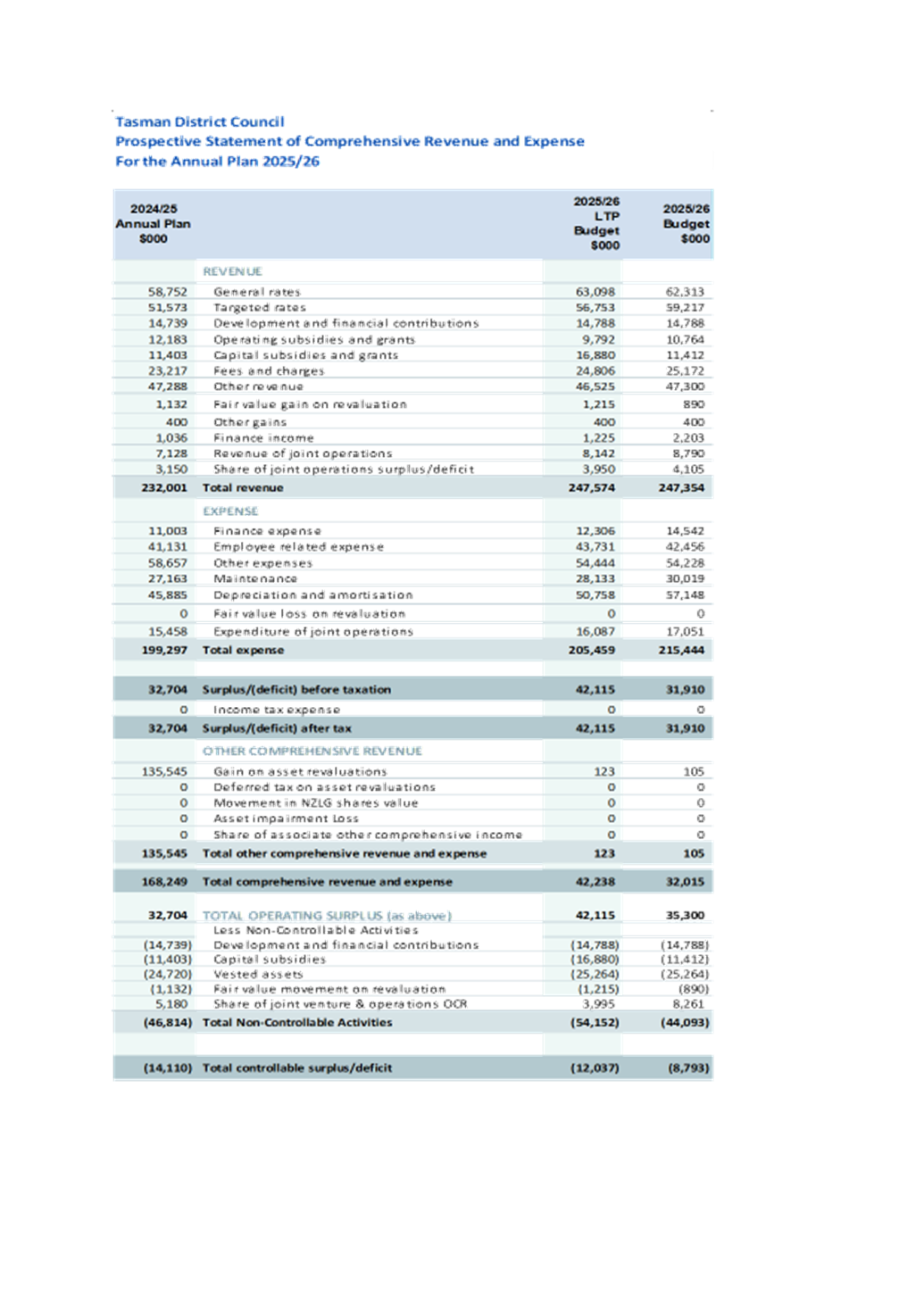
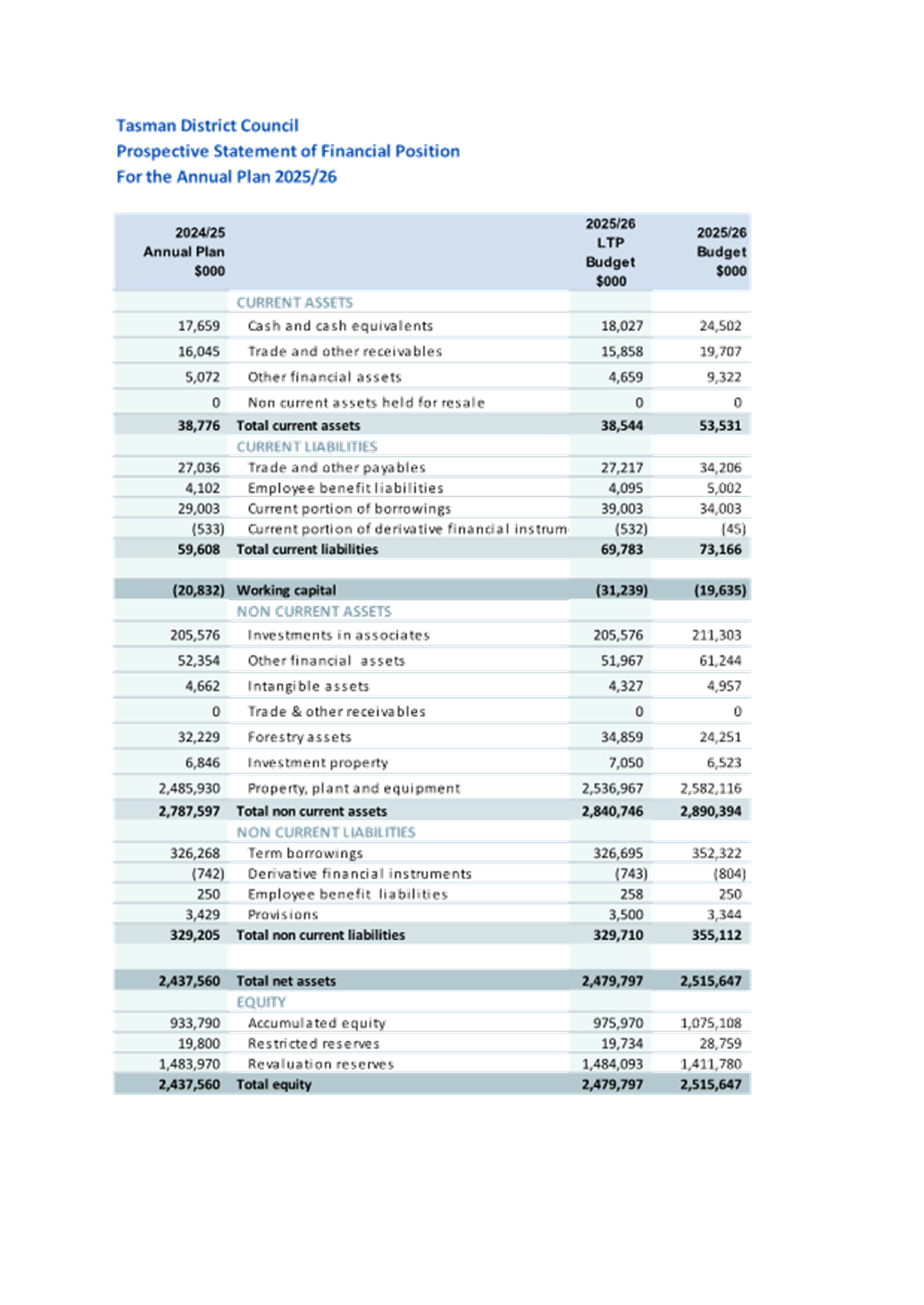

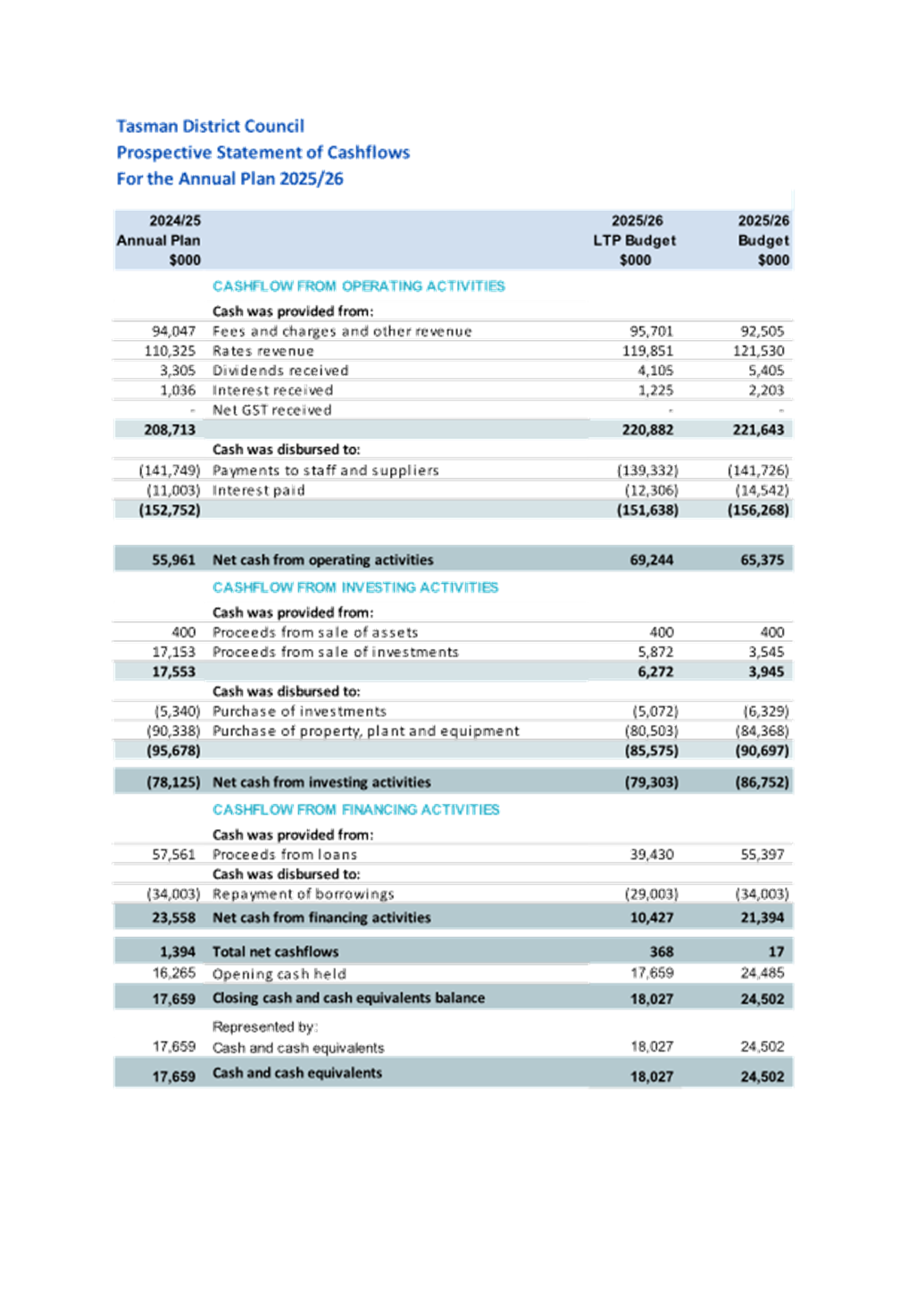
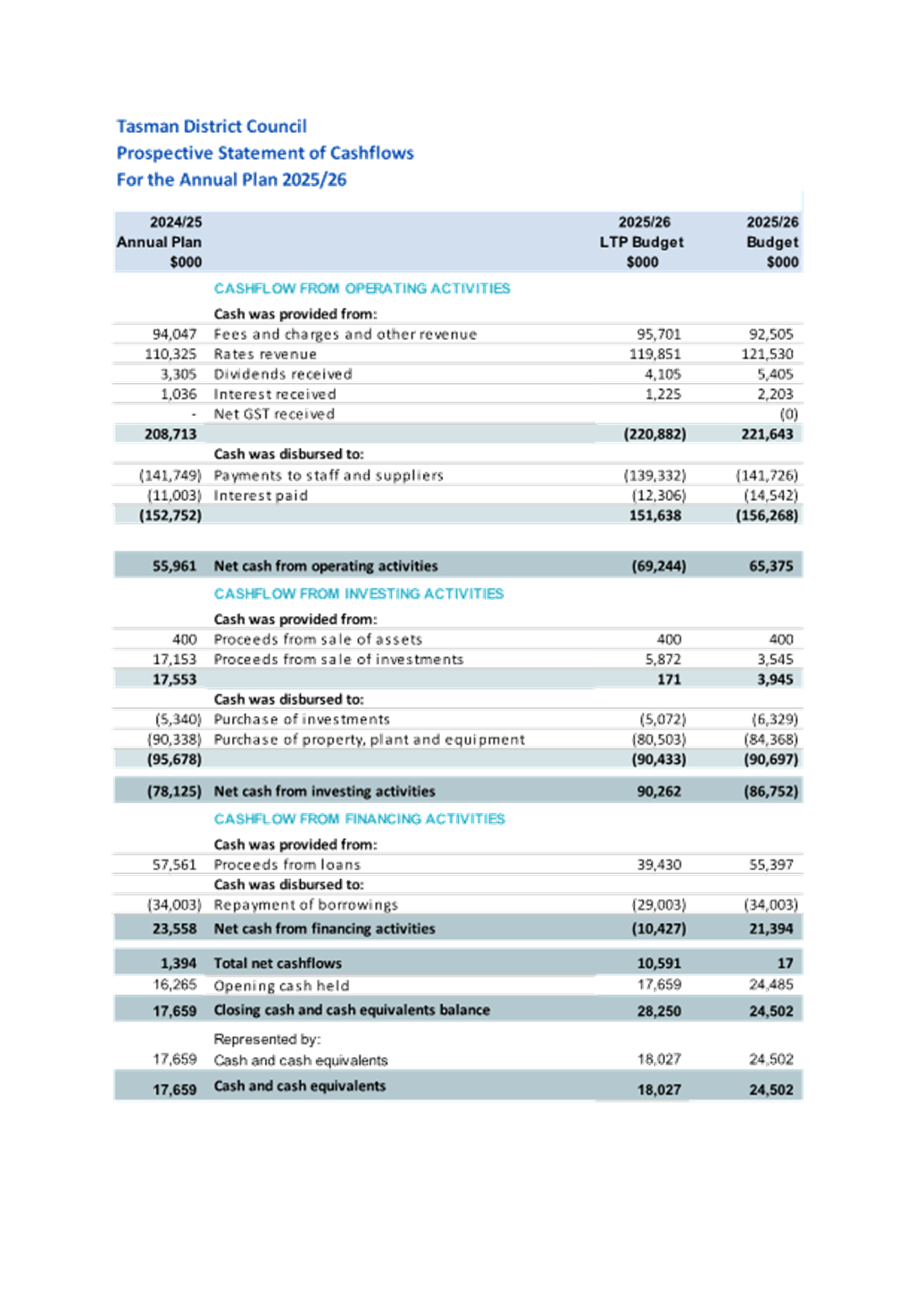
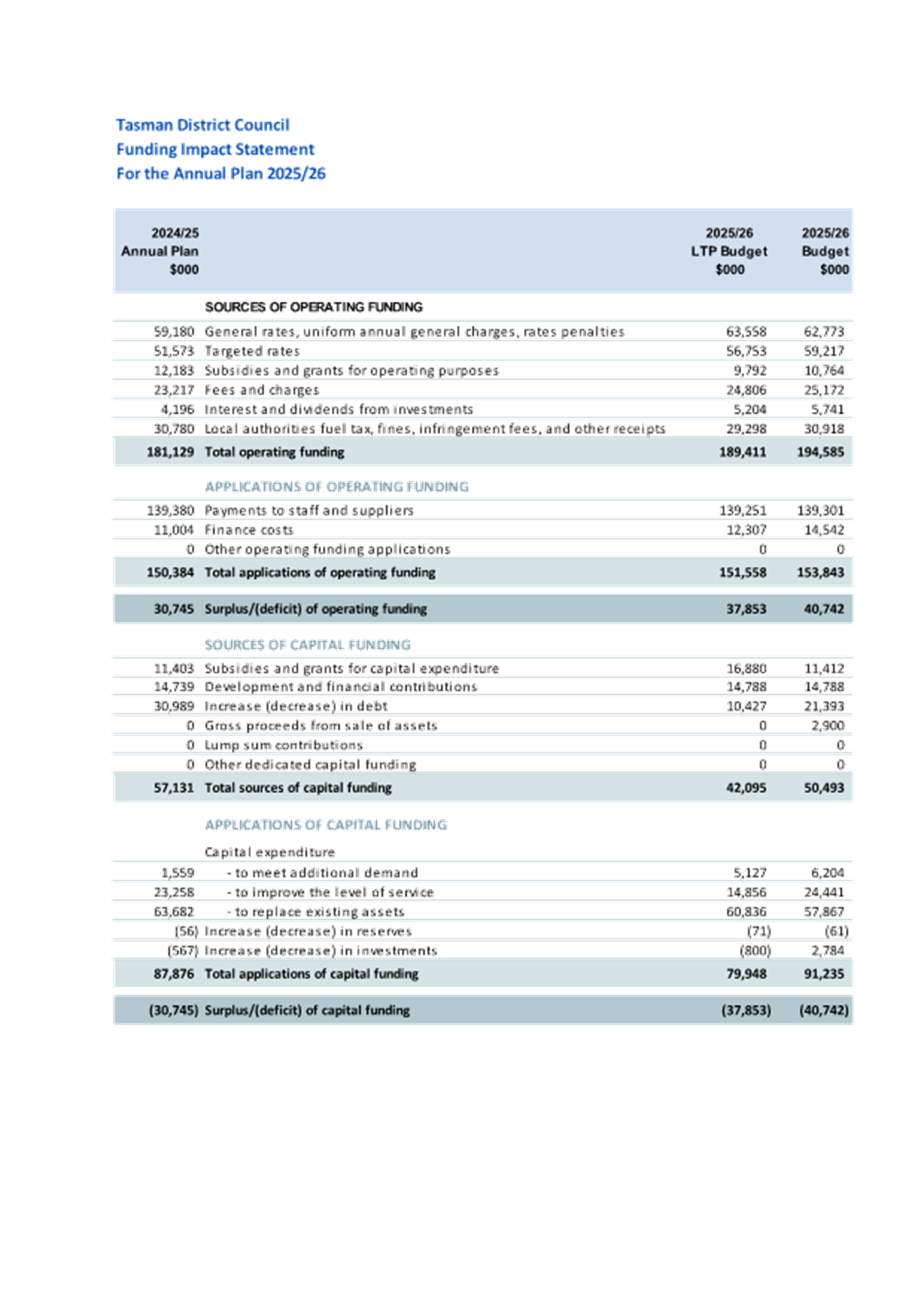
Tasman District Council Agenda – 08 May 2025

